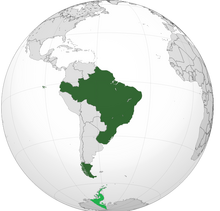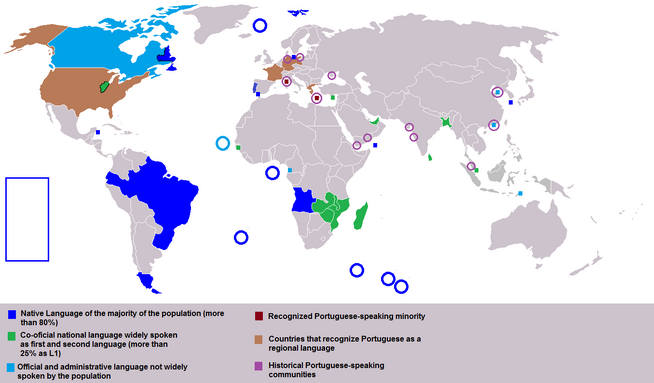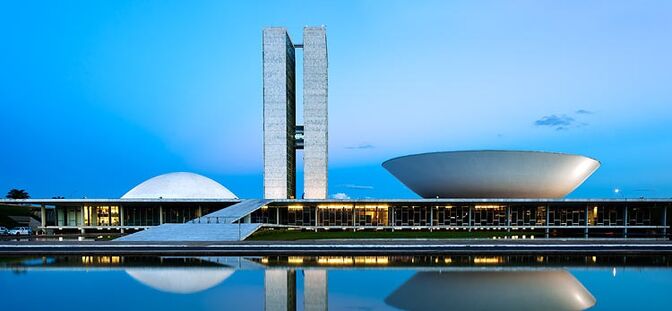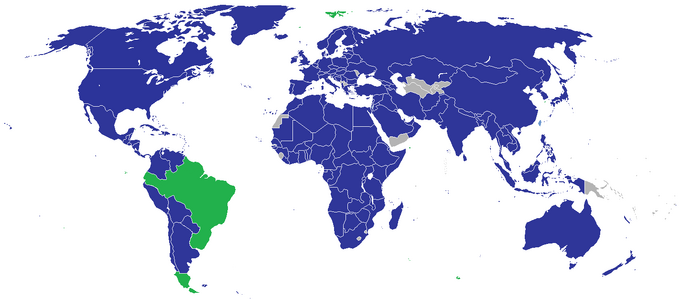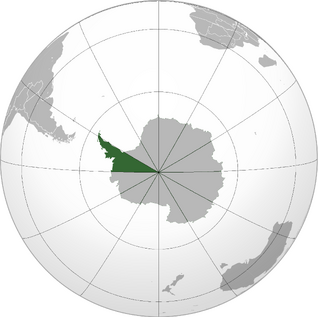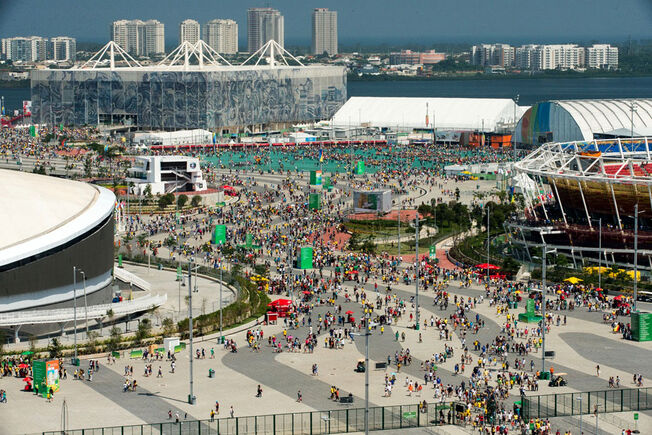Motto: Genti Pluris Originis | |||||||
| Anthem | "Pátria Amada" (Portuguese: Beloved Homeland)
| ||||||
| Capital | Brasilia | ||||||
| Largest city | São Paulo | ||||||
| Other cities | Rio de Janeiro, Salvador, Quito, New Florence, Natal, Recife, Saint Louis, New Florence, Starling, Arcanis, Zenith, Cádiz, Vehina, Josanso, etc | ||||||
| Language - Official: |
Portuguese | ||||||
| - Other languages | Tupi, Guarani, Mannuwa, Quechua, Mangarevan, Tahitian, Marquesan, Rapa Nui, Soqotri, etc. | ||||||
| Ethnic group | 52.71% - White 29.10% - Mixed 12.17% - Black 4.09% - Asian 1.43% - Amerindian 0.50% - Polynesian | ||||||
| Type of government | Federal parliamentary constitutional monarchy | ||||||
| Government | National Congress
| ||||||
| King: | Marco II | ||||||
| Royal House: | House of Braganza | ||||||
| Chancellor: | Maia Grimaldi de Castro | ||||||
| Area | 10,597,699 km² (2nd) (4,091,791 sq. mi) | ||||||
| Population | - | ||||||
| - 2023 estimate | 229,546,116 (6th) | ||||||
| - 2020 census | 223,254,796 | ||||||
| - Density | 21.66/km² (155th) (56.10/sq. mi) | ||||||
| Established | 1815 | ||||||
| Independence | from the United Kingdom of Portugal, Brazil and Algarves | ||||||
| Autonomy | 1548 (as Viceroyalty of Brazil) 1815 (as Kingdom of Brazil) | ||||||
| Declared | September 7th, 1821 | ||||||
| Recognized | August 29, 1823 | ||||||
| Currency | Brazilian cruzeiro (₢) (BRC) | ||||||
| GDP (PPP) | 2023 | ||||||
| - Total | $20.319 trillion (3rd) | ||||||
| - Per capita | $88,517 (6th) | ||||||
| GDP (nominal) | 2023 | ||||||
| - Total | $18.990 trillion (3rd) | ||||||
| - Per capita | $82,726 (7th) | ||||||
| Gini | ▲ 30.1 medium | ||||||
| HDI | ▲ 0.958 (4th) very high | ||||||
| Time zone | UTC
| ||||||
| Drives on the | Right | ||||||
| Date formats | dd/mm/yyyy | ||||||
| Internet TLD | .br | ||||||
| Calling code | +55 | ||||||
Brazil (Portuguese: Brasil), officially the Kingdom of the United Provinces of Brazil (Portuguese: Reino das Províncias Unidas do Brasil), also known as just Kingdom of Brazil, is a transcontinental sovereign nation, the largest country in the Americas in land area and second largest in the world as well as sixth most populous. Brazil is the world's biggest monarchy by population and the only majority Portuguese-speaking country in the Americas (though Canada is partially Lusophone as well), as well as one of the world's most ethnically diverse nations. That ethnic diversity and greater equality between the different ethnic groups is remarkable. According to most statistical data, Brazil is the most ethnically egalitarian among the developed countries in economic, social, and political terms.
Geographically, Brazil is bounded by the Atlantic Ocean to the east and through the exclave of Cadiz, the Pacific to the west, as well as to the Baltic Sea through the exclave of Zenith, the Indian Ocean through Socotra, and the East China Sea through Jeju. It is bordered to the north by Venezuela and Colombia; west by Peru and Bolivia; south and north of Patagonia by Argentina; southwest by Paraguay; north of New Scandinavia by Chile; south of Zenith by Germany; and by Spain through Cadiz.
Several archipelagos form its territory, such as the Rocas Atoll, the archipelagos of São Pedro and São Paulo, Fernando de Noronha, Trindade and Martim Vaz, Galapagos, Marquesas, Mangareva, the eastern portion of the Tuamotus Archipelago, Svalbard, and Socotra.
Its constitution, formulated in 1824 and the fourth oldest still in use, makes Brazil a federal parliamentary constitutional monarchy. The Brazilian monarchy is different from other monarchies for its institutions of republican and federalist influence. It consists of 49 sub-national federated entities known as Federative units or Provinces (forty-two conventional Provinces, two Insular Provinces, two Autonomous Cities, two Insular Territories, and one Federal District), as well as several overseas dependencies. It provides a bicameral legislature, the National Congress of Brazil, formed by the Senate (upper house) and the Magisterium (lower house).
The territory that forms Continental Brazil, for the most part, was found by Europeans in 1500, during the Portuguese expedition led by Pedro Alvares Cabral. The region, which until then was inhabited by Amerindians divided into thousands of languages and ethnic groups, became a colony of the Portuguese Empire. Though Brazil had a higher level of autonomy than other American colonies, and was more of a vassal state than an typical colony, the colonial bond was de facto broken only in 1808 due to the transfer of the Portuguese royal family to Rio de Janeiro in the aftermath of the Napoleonic Invasion of Portugal. In 1815, Brazil was elevated to the condition of a kingdom united to Portugal under Queen Maria I of Bragança, effectively becoming its own nation for the first time. Formal independence from Portugal, proclaimed by prince and general Pedro de Alcantara (the soon to be third Brazilian monarch) and the Magisterium, took place in 1821. After independence, Brazil has expanded in South America through military conflicts against its Hispanic neighbors. Some of its current provinces and territory were once independent countries and territories, such as the provinces of Uruguay and Ecuador, and the provinces of Patagonia and New Scandinavia (territory formerly controlled by the Free Cities). Brazilian expansion also extended to other continents, continuing the colonial expansion started already in the 1570s by the Overseas Trading Company (Portuguese: Companhia de Comércio do Ultramar, or just COU), allowing Brazil to build a remarkable colonial empire. In a period of about 30 years after independence, Brazil was gradually accepted by the international community as one of the great powers. The Cisplatine War (1823-25) and the Great Latin-American War (1829-35) confirmed Brazil as a military power and the hegemonic nation in the Americas until the rise of the United States in the early 20th century. The latter War of the Portuguese Succession (1842-44) and Anglo-Brazilian War (1848-53) reasserted Brazil as a great power of global reach and one of the most influential nations in the 19th and 20th centuries.
Currently, Brazil maintains great economic and diplomatic influence. This can be seen on most continents in the language and culture of its former colonies. At its height, in the early 20th century, the Brazilian Empire was the fourth largest empire in history by land area with about 15.9 million square kilometers, 10.69% of the world's landmass. Most of the old Brazilian colonies have become independent during the 20th century, with its last recognizably colonial holding, Weihai, being transferred to the People's Republic of China in 2000.
Brazil is a developed nation, with the third-largest economy by nominal GDP and the fifth-highest nominal GDP per capita. It accounts for 14.07% of global gross domestic product (GDP). Although Brazil's population is only 2.72% of the world's total, Brazilians own 18.35% (almost one-fifth) of the total wealth in the world, the second largest share held by any country, only after the United States.
Brazil is the only member of the G7 and only major world power with a majority of its territory in the Southern Hemisphere. The nation has a modern and extensive military force, used for self-defense and peacekeeping roles, though Brazil has not participated in a major conflict since the Gulf War. Brazil has very high standards of living (the world's third-highest Human Development Index), with the 16th-highest life expectancy (according to estimates by the UN and WHO) and the eighth-lowest infant mortality rate. Technologically advanced and industrialized, Brazil is a prosperous multiracial country and has excellent results in many international comparisons of national performance such as transparency of government, economic competitiveness, quality of public services, human development, healthcare, life expectancy, quality of life, public education, economic freedom, and the protection of civil and political rights. Brazilian cities routinely rank among the highest in the world in terms of livability, public transportation, cultural offerings, and quality of life.
Brazil was one of the earliest nations to start its Industrial Revolution. It remains a world power with great influence in the political, economic, military, cultural, and technological fields. It is considered to be nuclear-weapon state under the terms of the Treaty on the Non-Proliferation of Nuclear Weapons (NPT), being the third nation to achieve nuclear capability in 1951, and has the second-highest military spending in the world.
Despite transfer of sovereignty of Weihai, the last Western-controlled land in Chinese territory, to the People's Republic of China in 2000 being said to have ended to the Brazilian colonial empire (the fourth longest-lived colonial empire in history), some say that the empire still exists, even if smaller, in the form of the Brazilian Overseas Sovereign Bases, such as Akrotiri and Dhekelia in Cyprus, and Overseas Dependencies, such as Svalbard.
Brazil is considered a great example of "green nation" among the great economies, responsible for much of the development and deployment of new clean technologies, with unparalleled levels of sustainability. Over the last four decades, Brazil has developed and implemented revolutionary technology in many fields, such as aerospace, environmental, and energy production.
The Brazilian people can boast of a long tradition of excellence in the arts, as well as a known spirit of technological innovation, having significant achievements such as the first airplane and the first war submarine. Brazil's standard of education, one of the best in the world, is considered one of the causes of its high technological production. Brazil has one of the most advanced aerospace and military sectors in the world, being rival to Russia and the United States in innovation.
Brazil is a founding member of the United Nations (UN) and is one of six permanent members of the UN Security Council, a member of G7, G8, G20, the Mercosur, the Asia-Pacific Economic Co-operation (APEC), the Union of Nations from Latin America and the Caribbean (UNALAC), the Organization of American States (OAS), the Council of Europe[1], the Organization for Security and Co-operation in Europe (OSCE), the Eurocontrol, the Organization for Economic Co-operation and Development (OECD), the Union of Luso-Brasilic Nations (ULBRAN), the World Trade Organization (WTO), the Baltic Marine Environment Protection Commission (HELCOM), the Council of the Baltic Sea States (CBSS), and others. Brazil also has observer or associate status with the Pacific Islands Forum.
Through bilateral agreements between Brazil and the European Union, two of Brazil's provinces, Cadiz and Zenith, have a high level of integration with the European Single Market since 2005. Since 1980, Brazil is a member of the European Space Agency (ESA) and has allowed the ESA and many European national space programs to use the Kourou Space Centre, in Eastern Guyana, strengthening the ties between Radea and the ESA, as well as between Brazil and Europe.
Etymology[]
The etymological roots of the term "Brazil" are difficult to rebuild. The philologist Adelino José da Silva Azevedo postulated that it is a word of Celtic origin (a legend that tells about a "land of delights" called HyBrazil), but also warned that the earliest origins of the term could be found in the language of the ancient Phoenicians. In colonial times, chroniclers of the importance of João de Barros, Friar Vicente do Salvador and Pero de Magalhaes Gandavo showed consistent explanations about the origin of the name "Brazil". According to them, the name is derived from "Brazilwood", the name given to a type of wood used in fabric dyeing. At the time of discovery, it was common to explorers carefully keep the secret of all that they found or conquered in order to exploit it advantageously, but it was quick to spread in Europe that it was discovered a certain "Brazil island" in the middle of the Atlantic Ocean, where there was Brazilwood (ember colored wood). The tree's name, in turn, derives from the Latin terms brasa (ember), and the suffix il (a short version of ilium or iculum).
Before the popularization of the current name, the new lands had other names. It was common for the Tupi natives to call it Pindorama, meaning Land of Palm Trees. Monte Pascoal, Island of Vera Cruz, and Land of Santa Cruz were all names given by the Portuguese navigators after finding these new lands. Cabralia, in reference to Pedro Alvares Cabral, and New Lusitania, in reference to Portugal's Latin name, where the most commonly used names for the region alongside "Brazil" before the latter was made official. Cabralia and Brasilia Regina are also popular names used in songs, poetry, and patriotic nation's personifications.
Brazil's official name, Kingdom of the United Provinces of Brazil, was chosen from a number of suggestions, including Kingdom of the Federated Provinces of Brazil, Kingdom of the United States of Brazil, and United Kingdom of Brazil. The chosen name aimed to emphasize that Brazil would be a kingdom formed by several equal and autonomous units, in fact, a federation of internally republican semi-autonomous entities, united under the Crown.
The natural inhabitants of Brazil are called Brazilians. As with the Roman names of many European countries, Brasilia was and is often used as an alternative name for Brazil, especially in formal or literary and poetic contexts. Brasilic or Brasilico mean of Brazil or Brazilian.
History[]
Pre-colonial Age (Pre-Columbian times - 1500)[]
Background of European Colonization[]
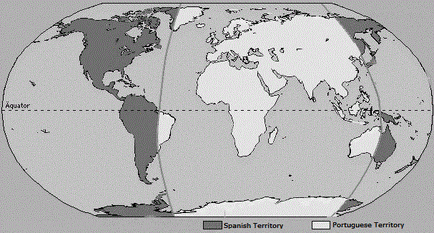
The world divided by the Treaty of Tordesillas.
When discovered by the Portuguese in 1500, it is estimated that the territory of Brazil (the Brazilian territory of just after the independence), was inhabited by about one million indigenous people, from north to south, plus about one million Manowans.
The Amerindian population was divided into large Indigenous nations composed of various ethnic groups among which stand out the great Tupi-Guarani, Macro-Je, Arawak, and Manowan groups. The Tupi were subdivided into the Guaraní, Tupiniquins and Tupinambas, among countless others smaller groups. The Tupi spread of the current Southern Rio Grande to current Northern Rio Grande. According to Luís da Câmara Cascudo, the Tupi were "the first Indigenous race that had contact with the Portuguese colonizer." The Tupi influence occurred in food, language, agricultural processes, hunting and fishing, in superstitions, customs and folklore of the current Brazilians. About the Manowans, they were a commercial kingdom developed and advanced that inhabited the Southwestern Amazon between 700 BC and 1632 AD.
On the European side, the discovery of Brazil was preceded by several treaties between Portugal and Spain, establishing limits and dividing the world already discovered and the world still to be discovered. Among those agreements signed distance of the allocated land, the Treaty of Tordesillas (1494) was the most important for defining the portions of the globe that would belong to Portugal in the period in which Brazil was a Portuguese colony. In the current territory of Brazil, the line crossed from north to south, the present-day city of Belém, Pará, to the present-day Laguna, Santa Catarina.
The Manowan Kingdom[]
For centuries the origins of the Manowan civilization were shrouded in mystery. Manowan, the name given to the people as well as the kingdom, was an Amazonian pre-Columbian kingdom that would see its rise and fall over a period of about 2,300 years between approximately 700 BC and 1630 AD.
The Manowans were more advanced than any other American civilization in various aspects. They had a developed naval knowledge, phonetic alphabet and iron weapons. Their mathematics, Base 10 like ours, knew the number zero. Their language, Mannuwa, was mysteriously unlike anything in any American language families. While the origins of their civilization and its development are now known, the origins of the people and the ethnic Manowans themselves are still one of the greatest mysteries of history.
Between 800 and 850 BC, the Manowan people arose in history by unifying their 14 tribes under a confederation in order to protect themselves from the hostile peoples of Amazon. In 700 BC, however, an unexpected phenomenon changed the course of the Manowan development. A small Phoenician fleet, five ships, lost in the Atlantic and carried by the winds, appeared at the mouth of the Amazon River. Exploring the interior of the continent further, the dying Phoenicians were found by the Manowans near the tribe of the leader Eliandor, the Unifier.
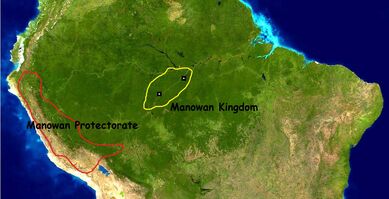
The Manowan Kingdom and the Manowan Protectorate at their maximum extension.
Seeing the Phoenicians as beings coming from the gods, the Manowans took care of their needs and hosted them. By living with the natives for years, the sailors taught some techniques from the Old World to them. Hiram, a wise Phoenician who lived and was welcomed among the sailors, wrote throughout his life Hiram's Diaries, in which he narrates their maritime epic, the discovery and relationship with the Manowans. The diaries, written in Phoenician, were hidden in the Palace of Niss until their discovery in 1933, throwing light on the mystery of the Manowan civilization. After more than ten years among the Manowans, the Phoenician sailors sailed back to the Old World. Their fate is still a mystery to this day.
By 550 BC, the Manowans had already assimilated the Phoenician-given knowledge and established their kingdom; they had developed agriculture and trade, their own phonetic alphabet, and their cities were grandiose. The Manowan king, had large administrative powers, controlling agriculture and food distribution, and lived in the capital, Eliandor. With internal development, the ports of Niss and Degoun (or Daegun) became springboards for Manowan trade.
The Manowan Kingdom's territory itself did not expand since its foundation, and the population was controlled by cruel, but effective measures. With the emergence of great empires in the Andes, such as the Tiwanaco-Huari, the Manowan created a protective network of independent kingdoms which would be known as the Manowan Protectorate. Among the most important civilizations in Manowan protection there were the Moche, Chimu and the Chachapoyas.
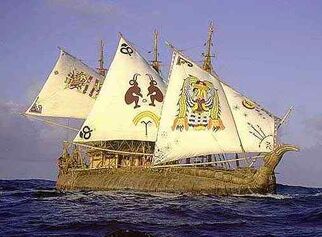
Replica of a Tho'kra, the biggest type of Manowan ship. The tho'kra were used in the trade between the several Manowan factories in the Americas coast.
The kingdoms under the Protectorate remained independent, but paid tributes to the Manowan king and had the right to protection by Manowan troops. The Manowan greatest military work was be the Andean Line, a set of more than 40 fortresses that manned much of Manowan troops and protected the kingdom from Andean incursions.
For many centuries, Manowan was a rich kingdom. Its ships traveled from Florida and Mexico to southeastern Brazil, were a web of fortified commercial points (like the Portuguese factories) flooded with trade goods. Its trade routes connected the rich Andean and Mesoamerican regions. In the early 15th century, however, the War of the Three Thrones, a conflict between three royal lines for the throne that divided the kingdom into three different states, devastated the Manowan for 53 years. After the war, the new king, Lennor II, executed the rebel commercial and mercantile elite and isolated the nation. The last kingdoms under the protectorate were to be conquered and one of the Manowans' largest sources of income was cut. During and after those episodes, the Manowans found the rising Incas as their biggest rivals. The protected kingdoms were conquered, and the Incas just could not break into Manowan itself, as the way to the kingdom through the jungle was kept hidden from outsiders for centuries. After hundreds of skirmishes, some say Manowan was fated to the Inca conquest. However, with the arrival of the Spaniards and the end of the Inca Empire, the Manowans were saved from this fate.

Brazilian singer and actress Lara Nissi is one of the most famous celebrities of Manowan descent. Her natural white-silver hair, true purple eyes ,and bronze skin are distinctive of Manowan ancestry.
A poor kingdom at the time, Manowan did not caught the attention of Spanish. With the founding Manaus in 1524, the Luso-Brazilians made contact with the decadent Manowan civilization. Despite the peaceful relations, exchanges of knowledge, Manowan immigration into Luso-Brazilian villages, and even the assimilation of customs and European techniques, the Manowan were exterminated in the War of Supremacy of 1632. The Manowan cities were occupied, and Niss and Daegun became again important ports in the western Amazon under the Portuguese. Eliandor was rebuilt, but the buildings of the Manowan capital were preserved in the King Endor's Park, and recognized as the World Heritage Site.
Present-day Manowan is a province of Brazil and its capital is Eliandor. As for the Manowan people, remnants of their culture are still visible in Manowan-European descendants in the Amazonic region. Eliandor, founded in 600 BC, is the oldest continuously inhabited city in the Americas.
The Brazilian Medicis[]
During the early colonial period, Brazil's history can be confused with the Brazilian Medicis' history, a branch of the Florentine dynasty that flourished in the New World after the coming of Giuliano di Medici to Brazil.
One of the most important figures of the early Brazilian history, Giuliano di Medici was born in Florence, from one of the wealthiest families in Europe. Known for their business as bankers, the Medicis amassed power and wealth, but Giuliano, had the interest to create his own business empire. In 1478, then 24 years old, he gathered all his possessions, wealth and heritage and went to Portugal, settling in Lisbon, where he met the love of his life.

Maria Rita Castro Gomes. Oil on canvas in New Florentine style by Giuliano of Medici.
Maria Rita Castro Gomes was a wealthy 23 years old widow and one of the richest persons in Portugal. She came from an aristocratic family and married the gold and ivory trader Afonso Henrique Castro Gomes when she was 16, but he died when she was 19, letting her to assume her deceased husband's businesses. Soon, she tripled his fortune. Her beauty and wealth attracted many suitors, all of them rejected. When administering her dead husband businesses, she ceased to trade only gold and ivory Ceuta and expanded to salt form the south of Portugal, and sugar from Madeira; she invested in textile production in Flanders and bought extensive vineyards in France, in addition to financing the Crown and the Portuguese maritime expansion. Giuliano met her in 1479, shortly after arriving at Lisbon. It is said that they "fell in love at first sight" and soon became lovers, marrying after four months. Giuliano invested his fortune to create a banking house in Lisbon and with his wife's contacts, founded the branches of the new bank in various cities in Europe. In 1490 their first son, Sebastian, was born.
In 1502, Giuliano and Maria Rita already had a large and rich bank, very influential in southern Europe, with branches in major European cities and headquartered in Lisbon. The Bank Medici and Castro (not old Italian Medici Bank) took advantage of the decline of traditional banking families in Italy, filling the vacuum left by them. The company gave him not only wealth but also influence on the politics of the European countries, especially Portugal and Spain. He was a close friend of the Portuguese king and the royal family and had great influence on the Portuguese politics, besides being one of the largest financiers of the Crown.
Colonial Age (1500 - 1821)[]
Exploratory Expeditions[]
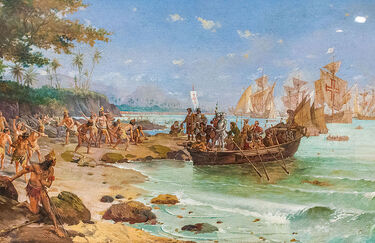
Discovery of Brazil and the landing of Pedro Alvares Cabral in Porto Seguro.
During the voyage of Pedro Alvares Cabral's fleet to India, which had left Lisbon on March 9th, 1500, the winds carried the two caravels and 13 ships to an unknown land. They landed on April 22 where now stands the town of Porto Seguro and they took possession of the land for King Manuel I.
In 1501, a large exploratory expedition, the first reconnaissance fleet, with three ships, found as an exploitable resource Brazil wood only, a reddish and valuable wood used in European dyeing and good for carpentry. However, the expedition did a survey of the coast anyways. Led by Gaspar de Lemos, the journey began on May 10th, 1501, and ended with the return to Lisbon on September 7th, 1502, after crossing the coast and naming the major land forms. In 1501, on November 1st, the Bay of All Saints was discovered, in the current province of Bahia, a place that would later be chosen by King John III to house the headquarters of the colonial administration. Another findings the same month were the Camamu Bay, where would be founded the city of New Florence, and the mouth of the Cachoeira River, also called Ilhéus Bay, where would be founded the city of Ilhéus, city which the province of Ilhéus was named after.
The expedition of Giuliano di Medici in 1502, established the village of New Florence, Brazil's oldest European-established settlement. In 1503 there was another expedition, now led by Gonçalo Coelho, establishing settlements as the villages of São Vicente, São Paulo and Belém (known in English as Bethlehem of Brazil). The expedition was organized on the basis of a contract between the king, a group of merchants from Lisbon and the Bank of Medici and Castro for extracting Brazil wood. It carried Americo Vespucci and six ships. He left Lisbon in May, passing by in Fernando de Noronha in August, where the flagship sank, dispersing the armada. Vespucci may have gone to Bahia and spent six months at Cabo Frio, where he explored 40 leagues inland. There, he may have left 24 men with provisions for six months. Coelho, it seems, have stayed in the region where it would be founded the city of Rio de Janeiro, possibly for two or three years.
On that occasion, Vespucci, on service for Portugal, returned to the largest natural harbor of the Brazilian coast, the Bay of All Saints.
Settling Period (1500-1548)[]
In 1501 Giuliano di Medici received from the king the right to "build a town, anywhere in the new land". Next year, he founded with his wife the settlement of Madonna di Nuova Firenze (Portuguese: Nossa Senhora de Nova Florença, English: Our Lady of New Florence), the first European-established city in Mainland Brazil, on the banks of the Camamu Bay. Ten years later the city had more than 5000 inhabitants, all employed in agriculture, trade and crafts. The city became a small center of shipbuilding and attracted settlers from across Europe. In 1531, Medici founded the Medici College, now Medici University, first higher education center of the American continent. In 1534, New Florence became the headquarters of the new Medici Banking Company (just called Medici Bank after 1552), which included all of the Brazilian Medicis' banks and business in the world, paving the way so New Florence could become a powerful and influential city. At that time, the Brazilian branch of the Medici family was one of the richest families in the Western world.
The Medici Bank helped to finance the Spanish expeditions to the Aztec and Inca empires achieving high profits, besides having business with many governments. the Medicis also built in New Florence a large palace where they kept rare artifacts, the present-day Pan-American History Museum, and hold a large collection of Aztec and Incas artifacts, thanks to Sebastian and Gabriel de Medici, who personally participated in the Spanish expeditions at the Aztec and Inca empires respectively. In 1560, the city's growth required the transposition of the Igrapiúna and Orojo Rivers, reducing the flood in the lower parts of the city.
Society and Economy[]
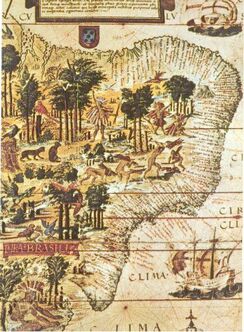
Detail of Terra Brasilis map, from 1519, with Brazilwood represented along the coast of the Atlantic Forest.
One of the most profitable activities in the period was the extraction of Brazilwood. To explore the wood, the Crown adopted the policy of offering to the private sector in towns and cities of the colony and the metropolis concessions of Brazil wood under certain conditions: dealers should send their ships to discover 300 leagues of land, install strongholds in the land discovered and keep them for three years; than to bring the wood to the kingdom, they would pay nothing the first year, the second they would pay one-sixth and the third they would pay one-fifth. The ships docked on the coast, a few dozen of sailors disembarked and recruited Indians to work in cutting and loading of logs in exchange for small goods such as clothes, necklaces and mirrors (practice called "barter"). Each ship carried an average of five thousand logs of 1.5 meters in length and 30 kg. People migrated to Brazil in droves, and enriched with that trade. Soon most of Flanders and England fabric was dyed with Brazil wood. In addition, the feathers of tropical birds, fur and medicinal roots extracted in the colony roamed Europe.
Seeing that Brazilwood was a lucrative product, English and French privateers started to use force to control that trade and to capture Indians.
Thus the Luso-Brazilians (Portuguese and other Europeans living in Brazil and the Brazilian-born people), who had enriched with that activity, began to invest in other activities such as manufacturing and trade. The land structure of the colony was diverse with family farming in small and medium properties side by side with large plantations, large-scale farm that specializes in cash crops. Across the Brazilian colonial economy, shipbuilding and manufactures have grown, as well as the agriculture of cassava (to produce flour), corn, and native fruits and vegetables. Shipbuilding led to the growth of trade with other regions. That phenomenon occurred throughout eastern Brazil, from Ceará to Paraná.
Portugal, even if knowing that the coast was visited by corsairs and foreign adventurers, as well as having bigger concerns in the East Indies, little cared about the economic growth and freedom that prevailed in its colony. However, it still decided to send military expeditions to defend the land from the French and the English. They were called Bodyguard Expeditions, of which the most recognized was the two commanded by Christopher Jacques, from 1516-1519 and 1526-1528. His expeditions were basically of military nature, with the mission to imprison the French ships that, without paying taxes to the Crown, withdrew large amounts of Brazil wood. The initiative had few practical results, considering the immense stretch of coastline and, as a solution, Jacques suggested the Crown to initiate a more intensive settlement in the land of Brazil.
The colony was predominantly rural, but had a decent urban life, an economy in diversification and a middle class of small and medium owners, traders and professionals. During that period, in addition to New Florence, other major cities were founded such as Guardamar, Salvador and Belém. Some towns were founded in the Spanish side of the Tordesillas line as well, such as Lucara, Manaus and Curitiba. But all this had only been possible because until 1530 the Portuguese authorities had all of their attention on the East, making Brazil a land free of the metropolitan authority.
Life in the villages was simple. In the town center core there was always the City Hall, where the people gathered to discuss politics and where the elected mayor worked; the School, where the children were educated, being financed by the taxes collected and generous people's donations; and the Church, where Catholics gathered. In the cities the trade was intensive, the streets, wider than in European cities were almost always paved. The cities were connected by paved roads. Plenty of space allowed spacious and organized cities with wide streets and squares.

The rhea was the first native animal domesticated by the settlers in Brazil. It provided meat, eggs, leather and rhea oil.
The colonial subsistence at the time was based mainly on cassava, corn, tropical fruits that the settlers soon learned to cultivate, the farming of chicken and rhea, a large native bird easily tamed, and the fishing of various seafood. The most consumed beverages were rum, cachaça and fruit liqueurs. Wind and water mills were built to grind cassava and corn. Corn bread and tapioca flatbread were consumed by everyone, rich or poor. Soon, cattle was brought from Europe, which began to be farmed in the Sertão (semi arid geographical region of Northeastern Brazil, or Portuguese-Brazilian word to designate the drier inner regions, similar to the Australian concept of Outback). Leather and meat became valuable trade goods. The population began to consume milk and cheese.
Culture and Population
Several aspects of the colony, already in its infancy, did distance it culturally from Portugal. The first factor was that, without supervision, settlers came from all parts of Europe. The different flora and fauna, the climate, the contact with the natives, etc., all helped to distance the customs of the Brazilian colonists from the metropolitan Portuguese. In Brazil, the warm climate and abundance of water favored a habit of taking many showers a day, what led to a distinctive sense of hygiene, cities have become cleaner, water sanitation systems were set up and sanitation and personal hygiene became synonymous with well-being and civility. Because of the different environment and also the weather, the settlers realized they should change their eating habits, and soon they learned how to cultivate the native products and farm rheas; wheat bread was replaced by corn bread or tapioca flatbread; the contact with Indigenous peoples made the developing Brazilian Portuguese full of indigenous loanwords. Moreover, there were many attempts to catechize the Indians, and many Europeans had children with natives. The contact with European settlers from other countries made that non-Portuguese words were taken by the Brazilian Portuguese. The influences of many Jewish and, later, Protestant settlers allowed Brazilians to develop a more favorable view to profit, literacy, trade and domestic production; a "bourgeois mentality", as historians say. In addition, it created a great willingness to wage labor. Indian slavery, and then African, only occurred in the plantation. In urban areas and even in small and medium-sized farms slavery was seen as dishonorable and inhumane. Still, many Brazilians made a fortune peddling African slaves to other regions of the continent and the world.
During the 16th and 17th centuries, Portugal and other European countries suffered several hunger cycles and bad harvests. It is estimated that, in 1495, Portugal had two million inhabitants; in 1527 there were only 1.5 million; in 1580, one million. From this one million people who "disappeared" from the kingdom of Portugal in these 85 years, about 300,000 died in famines, and 700,000 emigrated to Brazil in search of land to cultivate and better living conditions. The same would occur in other European countries. By 1530 Brazil had approximately 600,000 inhabitants (not counting Indians).
Also in that period three of the four cities that would become known as the Tetrapolis were founded: New Florence in 1502, Guardamar in 1525, and Lucara in 1542. Veraluna, the last of the Tetrapolis, would be founded in 1562.
Magisterial Period (1548-1702)[]
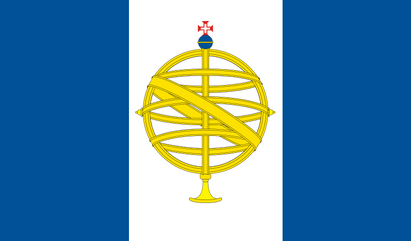
Flag of the Principality of Brazil. In 1645, the title of Prince of Brazil was created and in 1668, the colony was officially designated a principality for the first time.
From the 1530s, with the loss of its monopoly on the East Indian trade and with foreign incursions into its colonies, Portugal decided to take possession of its South American land definitely. Until then Brazil was populated by people from all over Europe and a large Jewish community, Brazilians had a lot of economic freedom and traded with whom they wanted.
Portugal designed that should make Brazil profitable to the Crown and was based in big slave based sugar plantations and the restriction of freedoms. But Angelo de Medici, then leader of the Brazilian Medicis, who with his contacts discovered the project, called in 1533 the Congress of Olinda, bringing together representatives from all of Brazil. At the Congress, they prepared a document, with appeals from all classes in Brazil. The document became known as Holy Charter of Rights and defended the interests of the colonial inhabitants. In Lisbon, Angelo and his retinue used his influence and intimacy with the king to persuade him to sign the document saying that otherwise, the settlers could revolt, being aided by Portugal's enemies, such as Spain or France. Trying to reconcile the interests of Brazilians with the colonization model that Portugal wanted to impose, the Charter set out the rights and duties of the Brazilians. The Charter was negotiated with the king, who put in it some articles that would preserve Portugal's interests and, as well, accepted some of the Brazilian demands:
- In the colony, all Christians and Jews would be free to exercise their religion, which unobtrusively included Protestants who would soon become an issue in Europe, and the colony would be a neutral zone between these religions;
- The Brazilian inhabitants would be free to exercise any economic activities without restrictions from the Crown;
- Trade with other countries would be free, but since only Portuguese and Brazilian ships could dock in colonial ports freely (actually, in the long run, it was favorable to the Brazilians, who were forced to control all of their trade, exportation and importation, without depending on middlemen);
- Sugar and Brazilwood would be exported only to the metropolis and by metropolitan ships only;
- The slave trade to the colony could only be done by the Portuguese, although Brazilians could sell to other regions of the world;
- All the gold, silver and diamonds discovered in the colony would be subject to the Crown laws;
- All non-Portuguese settlers installed in the colony would have the right to stay in Brazil, in addition, Europeans of any nationality could be established in the colony by just swearing allegiance to Portugal on arrival;
- Cities and towns would be governed by mayors elected by its people in a secret ballot and the Crown would not be allowed to interfere into city governments directly;
- Part of the taxes (a fourth, known as the Crown's Fourth) collected in the colony would belong to the Crown, the rest of it would be kept in the colony for the construction and maintenance of infrastructure and government;
- There would be freedom of expression and of the press (as Brazil was hit early by the spread of printing press);
- A central government based in the legislature known as the Magisterium, would be created as the main government to the whole colony, but the captaincies would retain certain autonomy, and the Magisterium could legislate about all issues under the Charter;
- At least half of the positions of power in the colonial government would be occupied by native Brazilians from 1620 on; Brazilians would be entitled to representation in the Cortes of Lisbon from 1620 and would be allowed trade in all of the Portuguese Empire (expanded to the Spanish Empire during the Iberian Union, 1580-1640);
- Education would be secular and under the authority of the Magisterium, in accordance with the religious neutrality of Brazil, but there could be the teaching theology and other subjects linked to the Church;
- The document should be honored by all those that were to reign over Portugal.
The Holy Charter, signed and ratified by King John III in 1538, regulated the colony's condition in relation to the metropolis and allowed the maintaining of the growth of New Florence and the Medici. The Portuguese monarchs, although wanting, never attempted to reduce that condition because they knew that this would mean revolt. But more freedom generated more trade, which generated more tax revenue and made many Portuguese monarchs and leaders think that trying to destroy this freedom would just endanger a rich and regular source of wealth for a domination that could not yield the same profits. For Portugal, all this freedom allowed the Brazilians to show their true potential and fill the royal coffers. On the other hand, Brazil had a continuous economic growth since its discovery and until its independence. Differently from other European colonies, Brazil had no mean to become independent until 1819. As said by the historian Carlos Bogarin Villar: "a good marriage does not end in divorce." The enforcement of the Charter, however, would still take ten years to be made.
Started in 1548 with the installation of the sugar enterprise and the foundation of the Magisterium, the Magisterial Period begins creating the society that would lead to the question posed in the 20th century by the British historian William J. McLeod: "Was Brazil an exploitation or a settler colony?". Historians say it was both, a mixture, a colony that had great economic and social freedom, typical of settler colonies, and knew how to use this freedom without, however, fail to give the metropolis the expected profits of an exploitation colony. Brazil was a unique case in history. The Holy Charter of Rights was what kept its freedom, no king in Portugal, from any dynasties, dared to question it until 1808. It kept secured and formalized property rights and representative government disengaged from the Church, freedom of thought and enterprise, and freedom of knowledge and scientific development also disengaged from the Church. Most historians agree that the Charter was one of the most important elements in the political and economic development of Brazil.
The Charter gave contribution to what is known as Brazilian Law, a legal system that was settled in the colonial period and had influenced the current Civil Law system in Brazil and Paraguay, as so in Madagascar, Singapore, The United Arab Emirates and other Brazilian ex-colonies. The Charter had also influenced the Enlightenment ideals in Europe and, more indirectly, the Declaration of Independence and the Constitution of the United States of America.
Colonial Administration
Until 1548 the colonial administration was very fragmented, each city or town was governed by a prefect and a board of councilors elected by the people, but with the promulgation of a central government, things changed.
The government installed in the colony was called a Viceroyalty, a self-governing colony divided into several captaincies (later, provinces) with broad powers of self-government, but connected to the central government. The captaincies were first based on the Captaincies system that involved the division of land, donated to the Donatory Captains that were to be responsible for its control and development, and for paying the settlement expenses. They were donated to people who possessed financial means to colonize, which were mainly "members of the state bureaucracy" and "military and browsers linked to the conquest of India", but as few of these showed interest, these lands were donated to rich people already resident in the colony. Brazilian land was two-month trip from Portugal, the news of the new lands were not very encouraging: in the trip, the fear of "monsters" that inhabit the ocean (in European superstition) and storms were frequent; in the new lands, massive and impenetrable forests, man-eating people and no mineral wealth yet discovered, due to these reasons many Portuguese nobles who received captaincies did not come to the colony, which led the Crown to donate their land in Brazil to residents in the colony as the Greek-Portuguese Caio Angelidis
The capitaincies were hereditary, until the Magisterium's Mourão Act of 1631, which changed the capitaincies' administration to elected governors.
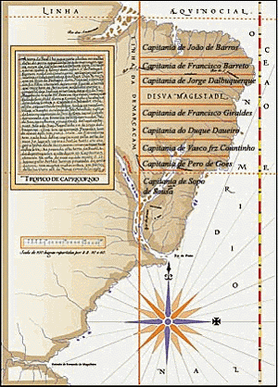
The Captaincies.
There were created in this division 15 longitudinal strips of different widths ranging from landforms on the coast to the meridian of Tordesillas, being offered to 12 grantees including Giuliano de Medici in Ilhéus, Afonso Duarte in Pernambuco, Antonio Henriques de Sousa in São Vicente and Caio Angelidis in Santa Sofia. After the Mourão Act, their governments became as miniatures of the Viceroyalty. Some donatory families, such as the Medicis of Ilheus and the Angelidis of Santa Sofia, became very influential in their captaincies policy to the point of controlling the construction of cities, tax collection and distribution of land, and maintained such influence when the captaincies became provinces. Among the donatory families were also the first Brazilian noblemen, as the first hereditary noblility titles of Brazil were granted by the king, such as the titles of Duke of Ilheus, 1512, Count of Guardamar, 1543, and Baron of Laguna, 1567. But unlike in Europe, in Brazil, the noblemen had no right to a state pension. Most of the noble houses of Brazil were formed by wealthy merchants, large landowners and businessmen. With the rise of Brazil as a united kingdom to Portugal in 1815, Brazilian nobles, until then officially considered part of the Portuguese nobility, though looked down by the Portuguese nobles, became officially nobles of the Kingdom of Brazil.
Of the 16 original captaincies, 13 prospered, mainly financed by the capital of the Medici Bank, including: Ilhéus with trade and industry; Pernambuco with the sugar and trade; São Vicente as the granary of the colony; producing rice, potato, beans, cassava, onions, peas, potatoes, honey, dried fruit and sorghum to sell to other regions and farming donkeys, horses and oxen; and Santa Sofia, as the largest supplier of construction materials.
The settlements west of the Tordesillas line, such as Manaus, Lucara and others, were governed separatly from the captaincies as autonomous cities under the Magisterial government. These settlements were ignored by the Spanish, who were concerned with richer areas, until the end of the 17th century.
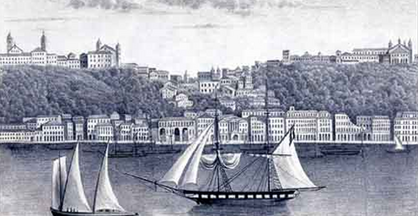
Salvador, 1650. It was the capital of Brazil until 1763.
In 1536, the donatory of the Captaincy of the Bay of All Saints (Portuguese: Baía de Todos os Santos), Francisco Pereira Coutinho, came to Brazil and founded the city of Salvador. In 1548 King John III unified the captaincies under the long-awaited Viceroyalty. In this system, the colony became a Viceroyalty, ruled by a Viceroy appointed by the Crown. The power was also exercised by the Intendents of which, from 1620, two-thirds had to be born in the colony. They were appointed by the viceroy, but must be accepted by the Magisterium. There were many Intendancies (similar to modern day ministries or departments of state), including the Intendecies of Commerce, Defense, Exploration, Transportation and Infrastructure, Taxation, Education, Colonization and also of Mining.
The Magisterium was a early form of parliament, developing throughout the Brazilian history. Chaired by magistrates (Portuguese: magistrados) elected by the people, it had the function of overseeing the viceroy, create laws and government measures, and had the power of veto over the actions of the viceroy and the intendants. The first viceroy was Tomé de Souza, who came to Salvador to make it the capital of Brazil. Tomé de Souza ruled until death and was responsible for the political unification of colonial Brazil.
In the mid-16th century, the lack of agreement between the viceroy and the Magisterium caused a political crisis that was resolved only by the Concordia Accord in 1571. The viceroy should nominate a member of the Magisterium to rule alongside himself, this member, called first called First-Magistrate, then Lord-Magistrate and, finally, Chancellor-Magistrate would be the bridge between the Viceregal Office and the Magisterium. Over time, it become precedent that the viceroy choose the person most likely to command the confidence of the Magisterium. By the mid- to late-17th century, the chancellor-magistrate's power had grew beyond the viceroy, who became no more than a figurehead in the Brazilian politics. Historians compare the relationship between the viceroy and the chancellor-magistrate in colonial Brazil to that of a head of state and a head of government in present-day parliamentary governments.
The Viceroyalty existed in Brazil until 1815 when King John VI, already in Brazil, raised Brazil to the status of kingdom, united to Portugal under a personal union. During its existence, the Viceroyalty acted as an semi-independent government, as a protectorate, not burdening the Portuguese state machine and still paying dividends. Scholars confirm that Brazil was perhaps the most free and independent European colony in the Americas. One of the first policies of the Magisterium, was to unificate the colony's monetary system. It stablished the Brazilian Monetary Authority in 1551, a public institution which were responsible to manage the state's currency, money supply, and interest rates. It was the first central bank created, reorganized into the the current Bank of Brazil (the Brazilian central bank) in 1810, and it is the model on which most modern central banks have been based. In 1555, it started to coin the new Brazilian official curency, the cruzeiro, which has been used in Brazil until present-day, being one of the oldest currencies still in use.
Another of the first Magisterial actions was to create a document that should set the government rules. In 1560 the Charter of Constitution and Structure of the Viceroyalty of Brazil was enacted. The charter became the highest law in colonial Brazil until 1815, setting the structure of the government, the rights and duties of the Brazilian residents, as well as the extensions and limits of the government power. The charter was the precursor of the modern constitutions having influenced the constitutionalists of the 17th, 18th and 19th centuries.
The first settlers in Brazil were Catholics and Jews that aimed to rebuild their lives in the new lands. From the mid-16th century, waves of Protestants also came to Brazil fleeing persecution, including a large contingent of French Huguenots and also Calvinists, Presbyterians, Puritans, and Lutherans. In addition to these, in the region of the province of Santa Sofia there was a great migration of Greek, Russian, French and Italians. The Cathedral of St George in Guardamar, built in 1651, in a unique architectural style that became known as Dalmontean style, is the largest Orthodox temple in the Americas. During the Magisterial Period the Brazilian population grew extremelly fast. Between 1500 and 1700, it is estimated that 750,000 Portuguese left their country to build a new life in Brazil. Added to these, over two million Europeans of other nationalities. European immigration to Brazil was very broad. Portuguese, Spanish, English, Scottish, Germans, Italians and Scandinavians spread their populated areas throughout the colony. Other people emigrated to more restricted areas, such as Russians and Greeks in Santa Sofia and Espírito Santo, Irish in São Paulo, and Polish and Hungarians in Rio de Janeiro, Paraná and Santa Catarina. Brazil's population were, in 1550, of about 650,000; in 1650, 2.7 million; in 1700, 4.5 million.
The colony's economy would became incredibly diverse between 1548 and 1701. Textile, metallurgical, naval, weapons, and processing manufactures grew incredibly. The sugar production yields great profits to the metropolis, Brazilian traders are all over the world, its banks are full of money, especially the Medici Bank. Brazil has become one of the major arms suppliers to the metropolis, and the large plantations buy African slaves from the Portuguese. Hundreds of thousands of slaves were brought to Brazil between 1530 and 1700.
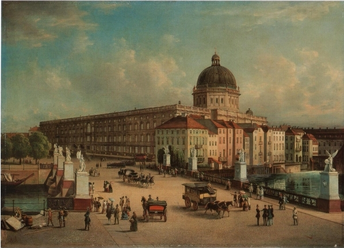
The Palace of the Ipês, headquarters of the COU. New Florence, 1669.
Great financier of the Spanish Crown, the Medici Bank becomes very rich with waves of gold and silver it receives from Spain as payment for their loans and financing. This situation, the Spanish economic policy, gave birth to the joke of the time: "Gold is born in America, dies in Spain and is buried in Genoa and New Florence." Neverthless, New Florence had business in all the world, increased trade and large surplus in its transactions, ie, not dependent on Spain, such as Genoa, other large financer of Spain, was.
In 1570, Angelo of Medici founded the Overseas Trading Company (Portuguese: Companhia de Comércio do Ultramar, or just COU). Considered by many the first multinational company in history, the COU expanded during the late-16th and the 17th century to become the biggest company in the world. A de facto independent government headed in New Florence, the COU built a remarkable colonial and commercial empire, a powerful fleet, and influence to negotiate to the other Great Powers as an equal. It was responsible for the first Brazilan colonial wave, being among its colonies: the Free Cities, Madagascar, Terra Nova and Labrador and others. It did influence the diplomacy and the war in Europe and was de facto an independent and powerful imperial state.
The Iberian Union (1580-1640)
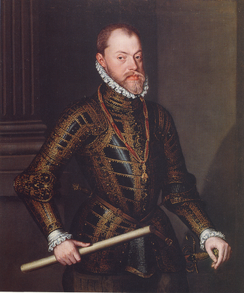
Philip II of Spain, I of Portugal.
With the death of the young King Sebastian in battle, this known as The Alcazarquivir Disaster, the Portuguese throne was empty, and the young king had left no descendants.
Philip II of Spain was eventually recognized as king of Portugal, being the closest relative, in 1581.
However, the idea of loss of independence led to a revolution under the leadership of the Prior of Crato, who had come to be proclaimed king a year earlier, in 1580, having fought to the end, coming to rule until 1583 with his court in Terceira Island in the Azores.
Crato was eventually defeated, especially because of the support from the traditional nobility, the bourgeoisie and the Brazilians to Philip II. To get support, Philip undertook, to maintain and respect the forums, customs and privileges of the Portuguese. The same happened to the occupants of all offices of central and local administration, as well as the troops of the garrisons and fleets of Guinea and India. They were all prosecutors of towns and cities in Portugal, except the Azores, faithful to the Prior of Crato, which resisted in Terceira. The Brazilians also had their rights listed in the Charter of Rights guaranteed by Philip II, in return for their recognition of him as king. It was the beginning of a personal union aplied without major changes until about 1620, despite the English interventions of 1589 in the Azores.
During the so-called Iberian Union, Philp's Dynasty formed one of the largest empires in history, comprising territories in almost all parts of the world.
With the Union, the Brazilians gained many benefits, they won the asiento (monopoly) on the slave trade to Spanish America, and the right to trade with all Spanish dominions over the world, which expanded the Brazilian commercial networks. During the union, the Tordesillas line became useless, allowing expeditions such as the Bandeiras and the Monções, which expanded increasingly to the West looking for precious metals. That expansion also expanded the borders of Brazil and the area under the Magisterium administration to close as what they are today.
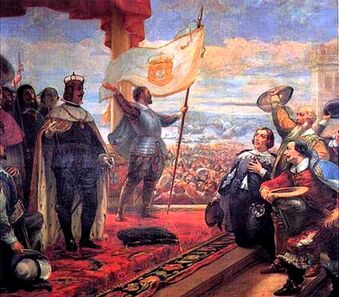
Proclamation of John IV as King of Portugal, which officially ended the Iberian Union and marked the rise of the House of Bragança.
Several exploratory expeditions to the interior were organized under direct orders of the Crown or the Paulista (people from the Capitaincy of São Paulo) gold hunters. These expeditions lasted for years and were intended primarily to find precious stones and valuable metals such as gold and silver, as well as to "clean" the newfound areas of Indigenous tribes. They were famous pioneers, among others, Fernao Dias Paes Leme, Bartolomeu Bueno da Silva (Anhanguera), Raposo Tavares, Domingos Jorge Velho, Borba Gato and Antonio Azevedo. Despite the political and economic importance of the Bandeiras to the Brazilian history, these expeditions were largely responsible for the extermination of indigenous peoples in Southern and Midwestern Brazil.
The Iberian Union ended in 1640 when the Portuguese Restoration led the Duke of Bragança with financial and military aid from the COU, to take the throne. The reason for the restoration was the crisis caused by the wars of Spain, against Portugal's former allies, like England and the Netherlands, which led them to attack its most distant domains. In exchange for the Brazilian help, the Duke swore that his dynasty would respect the Charter of Rights and increased the privileges of the COU. But even with the victory, in 1640 there was only a smal remnant of the once great Portuguese Empire: Brazil, Angola, Moçambique, Guinea Bissau, some islands in Africa, some trading posts in India, and Macau and Timor in Asia.
The Flemish Wars (1630-1654)

John Maurice of Nassau, governor of the Dutch Brazil between 1637 and 1642.
Before the Iberian Union, Portugal and the Netherlands were great allies, the Dutch funded the sugar enterprise in Brazil. The sugar sent to Portugal was sold to the Dutch, who refined it and laid it out for sale in all Europe. But the Netherlands was in a bloody war of independence against Spain, and Portugal was merged into the last. The Spanish king saw the ban on Portuguese trade with the Netherlands as a way to weak the Dutch. On the other hand, the Dutch realized that they would only have the sugar trade back if they conquered its producing areas. They instructed the newly established West India Company (WIC) to conquer the Portuguese territories in South America and West Africa. Despite failing in an attempt to occupy Salvador (capital of the colony) and New Florence, the Dutch defeated the Portuguese garrison and conquered the coast of Pernambuco, a less protected area and the largest sugar producer, in 1630. During the so-called Flemish Wars (then the Brazilians called all Dutch people Flemish), also called the Dutch Invasions, the invaders conquered a large coastal area that covered from Alagoas to northern Maranhão and established their capital in Recife (a small village neighboring the then capital of Pernambuco, Olinda). Thanks to governor John Maurice of Nassau, the Dutch government was well regarded by the Pernambucans. He built a large infrastructure, urbanized and beautified the new capital, Recife, kept the civil rights of Brazilian citizens, besides being great patron of the arts. During the Dutch government, the WIC conquered Angola for the supply of slaves to the plantations.
Nassau, known inP Europe as "the Brazilian", became extremelly amazed with Brazil. Because of that, he was well seen by the pernambucans and, extrapolating the WIC's interests to the region, he founded a "little Holland" in Brazil, bringing to the region many of Dutch developments and political estructures. He decided to turn Recife a modern capital like any other on the Netherlands and equal, if not better, to New Florence and Salvador, a project he called Mauritsstad. Nassau founded the Maurician University, parks, bridges, cannals, palaces, theaters, gardens and astronomical observatories. In 1642, Nassau was sent back to Europe and a new and oppressive government was installed, bringing the remnant of the Dutch supporters to the Portuguese side.
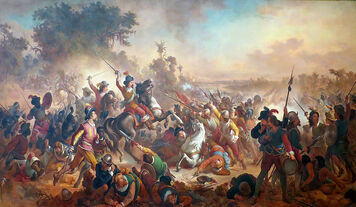
Battle of Guararapes, the last battle of the Dutch Invasions in Brazil.
The war between Portugal and the Netherlands extended even after Portugal's independence from Spain, in 1640. Without strength to regain their colony, Portugal was about to give it up. But in 1654, in the so-called Last Flemish War, the Dutch were expelled from Brazil and Angola by the Defence Forces and Brazilian militias and the belligerents signed peace. By the Treaty of The Hague, the Netherlands was indemnified in eight million florins, and received the Malabar, Portugal received its colonies back with the promise that the Dutch would give up of them. As for the remaining supporters of the Dutch in Brazil, they were expelled from the colony. It is known that the larger community to migrate from Recife was of a Jewish community who fled to North America, specifically New York, and many of their descendants actively participated in the American history.
Society and Science
During the Magisterial Period, freedom and economic prosperity allowed a breakthrough of science and philosophy. In 1569, the Bahian Alvaro Correia Torres, published one of the masterpieces of world scientific press. The work: Analisis Naturalis Brasiliae had 12 volumes with all the knowledge acquired so far about the Brazilian fauna and flora and their applications.
The same year, the New Florentine Manuel de Nobrega discovered a new metal, manganese, and created with it an alloy that made a more resistant, shiny and malleable steel. The New Florentine steel, forged with a rather innovative technique at the time, became the most expensive steel and a luxurious product. By the end of the century, swords, guns, and cannons of made of New Florentine steel were exported all over the world, generating sizeable profits to Brazilian traders, and boosting the metallurgical industry in Brazil. Although it was the subject of detailed analysis by the Europeans and the Chinese, the secret of its composition was only discovered in the 19th century, one hundred year after manganese was discovered in Europe. Other Brazilian products were also discovered at that time. The ollancelus (Latin: olam, pot, and caelum, sky. Sky-colored pot) was a form of pottery invented in Guardamar. It was adorned with relief sculptures, usually in sky blue color (hence the name). It became so valued as Chinese porcelain in Europe. It was also valued in China, where the elites spent considerable sums of silver to buy it. Also at this time the fine propeline fabrics (made from Sertão flax) become valued in Europe, encouraging further its cultivation and manufacturing.
Already in this period the press became widely present in colonial life. The first printing press was brought from Europe by Giuliano di Medici in 1502. By 1580, there were at least 990 printer in the colony and more than 75 daily papers and periodicals.
Stimulated by the combination of freedom and the presence of foreign immigrants, Brazil had a cultural flowering period marked by the foundation of reading societies, discussion groups, bookstores, periodicals and scientific societies. Publishing and books, magazines and newspapers obtained supplies an expanded the market, thanks to the increasing of literacy rate. By the end of the 17th century, the rate of literacy in Brazil (as defined at the time as the "abillity of reading and writing") was of men was 62% for men, 53% for women.
As soon as 1557, the Magisterium had established a widespread compulsory education program, focusing mainly on reading, writing and basic calculations. The Schooling Act of 1557 commanded every municipality with more than 100 families to establish a school for everyone paid for by the citizens. The Magisterium confirmed this with the Education Act of 1564 and created a local land-based tax to provide the required funding. The 1564 law also required every town having more than 50 families to hire a teacher, and confirmed the requirement of every town of more than 100 families to establish a school. The Brazilian zeal for learning was reflected in the early and rapid rise of educational institutions; e.g., the Guardamar Science Academy was founded as early as 1609, and the University of Cabralia, in 1614. The program's reach, however, could not go beyond the towns and neighboring rural areas. In more isolated areas, more isolated from the cities, education was achieved mostly without formal schooling, libraries, or printed book. Parents were riquired by law to teach their children how to write and read. Informal tuition by religious leaders and peasant teachers were also very common on more isolated areas. The Protestant and Jewish population, giving the need to read their religious texts, were the most literate, with even the most isolated households achieving literacy through the teachings of older generations. On the other hand, while free-born Blacks and free Mixed race people had the same education as Whites and teaching slaves to read was not illegal, by 1700, slaves had a literacy rate as low as 21%. The literacy rate was also high among the Indigenous peoples who lived in the Jesuit and other religious missions.
These changes paved the way for the entry of Enlightenment in the colony, and its flowering in between the late 17th century and through the 18th century.
Economy
Besides the sugar produced in large slave-based plantations, Brazilian agriculture was very diversified. The main agricultural products were cassava, maize and potato. In addition to these three main staples, there were tomatoes, lettuce, arugula, cucumber and carrots, tropical fruits such as mango, orange, tangerine, açaí, cupuaçu, coconut, banana, watermelon, passion fruit, lemon, and more regional fruits, and grapes and dates in the valley of the São Francisco river. In the South, especially near Laguna and in Rio Grande do Sul and Santa Catarina mountains, European and Asian fruits such as strawberry, raspberry, pear, apple, grape, peach, plum, and others were grown. For industry,Sertão flax and vineyards were cultivated in the valley of São Francisco, cotton in Maranhao, and jute, tobacco and cocoa in Bahia.
Livestock activity was based on cattle, rhea, sheep and horses, and buffalo exceptionally in Marajó Island. The regions of the São Francisco river and southern Brazil became major farmers of cattle and caravans (called tropeiros) traveled throughout the colony selling leather and jerked beef, and shipping products among inland regions.
There was in the colony a prosperous extractive activity. From the Amazon region, the so-called Sertão drugs, Western spices like cinnamon stick, cloves, guaraná, indigo, vanilla, pepper, and ginger became valuable productis. From the mid-16th century, the natives from the Jesuit missions in the Amazon were responsible for the extraction of the spices and its shipping to the villages on the banks of the Amazon river, where they were transported to Bethlehem (Belém do Pará). There, they were processed and exported to Europe. Also in the South, from the 17th century, the Jesuits expanded their missions. At the same time, the infusion of yerba mate, a plant native of the region, became appreciated by the ruling classes of the Ottoman Empire, the Arab kingdoms and Scandinavian countries such as Sweden and Denmark.
Soon the Jesuits started to have the same role in relation to the yerba mate, as they had with the Sertão drugs, carrying them to Portonegro and Floripa, where it was processed and exported. These activities enabled the Society of Jesus to accumulate some wealth, and beautify their missions.
Also date from this period, 1650-1700, the first engineering works that would be known as Water Web, a set of navigation and irrigation canals and lakes constructed in the semi arid Sertão from mainly from the São Francisco and Parnaíba rivers and water channeled from the Amazon basin, irrigating the dry, but fertile, land of the Northeastern Sertão. A miracle of engineering, some canals cutting through sierras. The canals pumped water from the lower regions to the higher Sertão using advanced systems of mills and water level adjustment. This also enabled the development of an important waterway transport network in the major canals along the colonial period, connecting the region's economy.
The Water Web finished its last canal in 1833, but by then many lands had already been covered by the canal. The Web alloed the development of the Sertanian Agripole, now one of the most productive Brazilian agricultural regions. The Web's canals started narrow, but they were quite expanded throughout the 19th and 20th centuries. The Web was also the inspiration for the network of irrigation canals built in Patagonia by the Free Cities in the 17th and 18th century and expanded by the Brazilian government in the 19th and 20th centuries.
Since the beginning of the colonization, one of the main rights guaranteed by the Holy Charter of Rights was the right of property. In the period beteewn 1530 and 1730, most of the European immigrants in Brazil colonized the fields. Based on small and medium-sized properties, these would have ownership of occupied land according to the Productive Occupation Act of 1561. The Act was created by the Magisterium in order to ensure the occupation of the colony and thus the recognition of Portuguese sovereignty by other nations, and to facilitate the obtaining of land and discourage the rampant expansion of the cities. It established that the occupants of the land would have its legal possession after a certain period of productive occupation. The settlers, who worked the land with their families and produced a wide variety of products, should provide the colony's market the surplus of thier production. The Agriculture School was created to teach the arriving settlers to cultivate and use native products such as cassava, maize, potato, etc. Roads were built to link the countryside to the cities and allow the exchange of goods between them, and the passage of colonial troops. During the Magisterial Period, the exchanges between farms and cities, or just between farms were frequent. The large contact between country and city allowed new techniques to be employed in productive land.
Slavery, the Quilombola Movement and the Protestants in Brazil
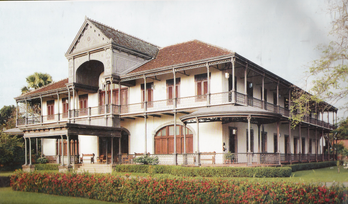
Typical house of a sugar plantation owner from the 17th century.
Beyond the dynamic economy that prevailed in the colony, there was a "different economy" that was intended to satisfy the Portuguese interests, the cultivation of sugarcane and cocoa. Simultaneously with the settlement of immigrants on the fields, Portuguese imigrated to Brazil under the seal of the Crown. While immigrants had small and medium farms, the Portuguese honored by the king, the conquerors and explorers, gained sesmarias from the Crown, large portions of land (plantations) to large-scale production of commercially valuable products. The sugar mill (manufacture of the sugar production cycle called engenho in Brazil) was the main part of the Portuguese mercantilism, organized into large plantations. These were characterized by extensive land, abundant slave labor, complex techniques and low productivity.
To support the production of sugarcane, the Portuguese started in the mid-16th century to import Africans as slaves. They were people who were caught between tribes of Africa (sometimes with the connivance of local chiefs from rival tribes) and who crossed the Atlantic on slave ships, in terrible conditions of cleanliness and health. When they arrived in America, these people were marketed as a commodity and forced to work on plantations and their owners' homes. In the farms, they lived imprisoned in rustic sheds called senzalas, and their children were also enslaved, perpetuating the situation for the following generations. Until the mid-16th century, the Portuguese had the monopoly of the slave trade. After that, French, Dutch and English merchants have also entered the business, weakening the Portuguese participation. Nevertheless, the Portuguese had the monopoly of slave trade to Brazil. Entering the 17th century, the Brazilian sugar was a luxurious product imported to the ports of Lisbon, Antwerp, Amsterdam, Rotterdam and Hamburg. Production, much higher than the Portuguese islands in the Atlantic, supplied almost all of Europe.
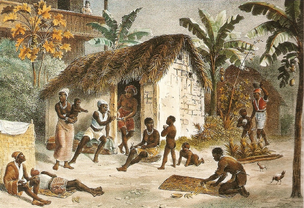
Typical senzala, rustic collective houses were slaves lived.
In the mid-17th century, the sugar produced in the Netherlands Antilles started to compete strongly in Europe with the Brazilian sugar. The Dutch had perfected the technique with the experience gained in Brazil after the Dutch invasions, and counted with a developed scheme of transport and distribution of sugar in Europe. Portugal was forced to turn to England and sign several treaties that would affect the economy of the colony. In 1661, England pledged to defend Portugal and its colonies in exchange for two million crusados and the possessions of Tangier and Mumbai. In 1703, Portugal has undertaken to import wool cloths of English manufacturing, and England, in return, to buy Portuguese wines. Date of time the very famous Treaty of Methuen, or Treaty of Fabric and Wine. At the time, it met the interests of the dominant groups, but later resulted in the stoppage of industrialization in Portugal, channeling to England (Great Britain since 1707) the gold that had just been discovered in Brazil.
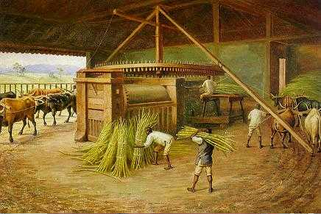
Engenho, a Brazilian sugar mill.
The gradual decline of the sugar plantations in the 18th century further sapped the drain of the power maintained by the plantation owners. Other crops such as cocoa, tobacco and especially cotton, now represented an increasing share of production. Cotton fed the colonial textile manufactures and was also exported to England. These changes have been consolidated in the mid-18th century.
The issue of slavery in Brazil was very particular. Millions of slaves were transported to the New World between 1530 and 1860, but in Brazil interracial relations had a much higher level than any other European colony. In 1825, people with African descent or origin accounted for 43% of the population. Interracial relationships are common and many Brazilians are mixed. The slaves in Brazil had an easier time achieving freedom than in North America, which also facilitated a greater volume of importation of slaves. And different from North America, in Brazil there was true legislation to protect the captives. However, slavery in Brazil was still extremely brutal and inhuman. Of the European colonies in the New World, Brazil was one which imported the largest amount of slaves.
In 1642, the Magisterium created a series of laws on slave labor, the Slaving Regulation Acts. Since, according to a magistrate of the time, slaves were "at the same time goods and men", they had "duties as goods, but rights as men." The presence of slaves was banned in cities, except in predetermined trading areas and shipping routes, so that there were no impacts "to public order and decency"; slaves would be entitled to purchase his or her freedom at triple the price at which he or she was purchased; the slave could not be killed by his master, it would be considered murder; no more than 40 lashes were allowed as a punishment; Some municipalities enected laws that obligated slave owners to teach slaves how to read and write so they could "feed their souls of the revealed Word of Our Lord and save their lives." Although in the present-days they may be deemed as offensive and racist, the Acts were almost subversive at the time.
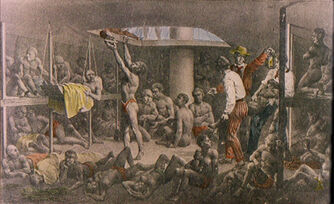
Africans in a slave ship.
Many of these laws, called "sponge cake for gorillas" by the plantation owners, were imposed by the commercial and manufacturing elites that dominated the Magisterium between 1590 and 1710. Their interest in consumers for their products (cheap, but yet paid, laborers who could consume), led them to facilitate the process of liberation from slavery, turning the slave into a consumer and paid worker. This constant flow of freed slaves also benefited the Portuguese slaves traders, who supplied the high demand of new captives, and on turn supported the Magisterium's policy. As for the plantation owners (called sertanos by people of the cities and owners of small and medium properties), the situation forced them to allocate large funds to buy new slaves constantly, disrupting any economic supremacy that rural elites wished to have over the urban ones.
This situation did not come without consequences. The Revolt of the Engenhos (1652) and the War of the Sertanos (1661) were conflicts between rural elites with their militias (called jagunços) and the colonial government. At the first, the plantation owners were defeated and forced to dismantle their militias; in the latter, the Magisterium promised freedom to slaves who fought against the insurgents. After the War of Sertanos, the last great revolt of the rural elite in Brazil, slaves loyal to the Magisterium were freed, the Magisterium heavily fined the insurgents, buying part of their land in exchange for financial aid. Although similar revolts have occurred at the time, the aforementioned episodes marked the end of the influence of rural elites in Brazilian politics until the Coffee Cycle.
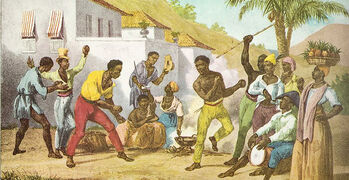
Slaves dancing. Much of Brazilian culture came from the slaved Africans. As the melting pot it is, it is said that Brazil "has its body in America, its head in Europe, and its soul in Africa."
On the issue of slavery in Brazil, this would still be much discussed. Frederico Domenico (1654-1731) was one of the biggest abolitionist philosophers. Author of the famous Children of Men, which defended the slaves, analised the social and economic effects of slavery and discussed the ethics of the institution; his work was widely accepted in the cities and among medium and small owners. On the other hand, an important slaver of the time would be Antonio Monteiro de Melo (1637-1712), author of Pyramid of Races, where he defended the theory of a racial pyramid, in which some races were superior to the others and the ones below should be dominated and support the upper one.
African culture had also influenced Brazilian culture in a great extent. As miscegenation was neither encouraged nor discouraged, as occurred in North America, mixed families were common among the lower and middle classes and concubinage among the plantation owners. The color prejudice, although very present and visible, was not as intense as elsewhere and there was no "one drop rule". Some members of the Magisterium had black or mixed wives, and others were black or mixed themselves. The Brazilian title of "Melting pot Nation", was not given for nothing.
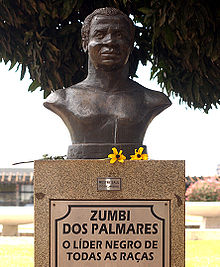
Statue of Zumbi, in Palmares, AL. It is written: Zumbi of Palmares. The Black leader of all races.
However, the slavery was still a brutal institution in Brazil and many slaves tried to revolt or run to quilombos, isolated communities that tried to emulate the nations of the slaves' old land, Africa. Refuges to runaway slaves, the quilombos were important centers of African cultural reaffirmation in Brazil. Generally they had governments that mirrored the traditional African societies. Not just Black people, but all types of "undesirables" migrated to the quilombos.
The biggest quilombo in Brazilian history was Palmares, a true state established in the Brazilian Northeast. Surviving from hunting, fishing, gathering, trade and crafts, Palmares remained standing during part of the 18th century and even after raids of the Colonial Guard. The so-called War against Palmares was the biggest conflict between the quilombo and the Magisterium, between 1693 and 1695, and ended the movement, with the death of its leader Zumbi. Although relatively short lived as a state, as a long revolt movement, Palmares and the Quilombola Movement led the Magisterium to strengthen legislation and supervision relating to slavery. The movement, the violence of Slave Revolt of New Manchester in 1687, and its repression even more violent by the plantation owners, made several Brazilians start to discuss the validity of the slavery and its ethical value.
One of the main aspects of the slavery in Brazil, differing from the other American nations, was the presence of a strong social opposition to it. In Brazil, anti-slavery and anti-racist sentiments started to grow, surprisingly, after the arrival of the first Protestants in Brazil.
Protestantism came to Brazil early, in the 1520s and 1530s, brought by Lutherans from Germany and Scandinavia. The Holy Charter of Rights provided freedom of religion to all Christians and Jews. That was an important factor of the Charter and was inserted to guarantee the rights of the Orthodox Christians of Santa Sofia and the Jews throughout the colony, who had great economic power. With the Reformation in Europe in and the conflicts between Catholics and Protestants, that specific article of the Charter became a concerning issue. As said by the magistrate Marcelo Dumont de Melo, in 1619:
| "The Charter is clear: All Christians and Jews are free to have their beliefs, to build temples and to proselytize. We already have non-Catholic Christian communities in our land [the Orthodox Christians from Santa Sofia], a respectful and honorable people. I propose the same to these new denominations [Protestants] that are coming from Europe. If not for the sake of our laws and of freedom, then for the sake of peace." |
That way, the Magisterium passed the Dumont de Melo Act, that recognized the Protestant denominations as Christians under the Holy Charter and prohibited all conflicts between different Christian denominations, contributing to the sense of religious plurality and secularity of the state that became so intrinsicaly Brazilian.
| "As faith is the free work of the Holy Ghost, it cannot be forced on a person. Therefore, strict separation of church and state has to be kept and no group under the Bible shall be persecuted or treated as different to the Law and the State regarding his or her belief, or lack of it" |
Brazil became a refuge to Protestants from Europe. Huguenots, Lutherans, Calvinists, Presbyterians, all of them came to Brazil in great amount.
During the early 17th century, Protestant denominations grew in Brazil, and some were even born in the colony, such as the Church of Brazil (Lutheran), the Angelist Church and the Church of the New World. Within the Lutheran Church in the New World, founded in 1589, the leaders Marcus Mauro and Josias Coelho successfully persuaded their fellow members to free their slaves, divest from the slave trade, and create unified policies against slavery. By the end of the 18th century, the church was one of the largest in Brazil, and its leaders' anti-slavery and anti-racist speeches in all the Ecumenical Congresses influenced much of the Brazilian population.
Their influence made possible laws like Slaving Rugulation Acts. By the mid-17th century, slavery was prohibited in the cities and any non-plantation land, and institutional racism was prohibited in all levels of government. In 1755, free Blacks were allowed to vote and had all the same political rights as Whites.
Of course, racism wasn't erradicated. However, the view of the immorality of slavery became widespread in Brazil, mainly in the cities and the small- and medium-sized rural properties. Even slavery was still maintained in the plantations, as these were responsible by providing the metropolis with its main export products, such as sugar.
Japanese Diaspora, the First Japanese Wave to Brazil
Overseas Japanese have existed since the 15th century. However, after the Portuguese first made contact with Japan in 1543, a large scale of slave trade developed in which Portuguese purchased Japanese as slaves in Japan and sold them to various locations overseas, including Portugal itself, throughout the 16th and 17th centuries. Many documents mention the large slave trade along with protests against the enslavement of Japanese. Japanese slaves are believed to be the first of their nation to end up in Europe, and the Portuguese purchased large amounts of Japanese slave girls to bring to Portugal for sexual purposes, as noted by the church in 1555. King Sebastian feared that it was having a negative effect on Catholic proselytization since the slave trade in Japan was growing to massive proportions, so he commanded that it be banned in 1571. In 1595 a law was passed by Portugal banning the selling and buying of Chinese and Japanese slaves.
From the 15th through the early 17th century, Japanese seafarers traveled to China and Southeast Asian countries, in some cases establishing early Japantowns. This activity ended in the 1640s, when the Tokugawa Shogunate imposed maritime restrictions which forbade the Japanese from leaving the country, and from returning if they were already abroad. This policy would not be lifted for over two hundred years.
Before that, Christianity spread throughout Japan, creating social tension and riots like the Shimabara Rebellion. Under Hideyoshi and the succeeding Tokugawa shogunate, Catholic Christianity was repressed and adherents were persecuted. During these times, many Christians were killed in Japan, some by crucifixion; most famously, the 26 martyrs of Japan were tortured and crucified on crosses outside Nagasaki to discourage Christianity in 1597. Following a brief respite as Tokugawa Ieyasu rose to power and pursued trade with the Portuguese powers, there were further persecutions and martyrdoms in 1613, 1630 and 1632.
Because of that, Portugal secretly gave asylum to thousands of Japanese Christians in Brazil between 1542 and 1640. The Magisterial government maintained detailed records of Japanese immigration and it's known that about 170,000 Japanese emmigrated to Brazil during that period. People of all classes, from nobles to peasants, they brought with them their customs, architecture, techniques and even clothing. The Japanese settlers integrated with the already multicultural Brazilian society. The city of Nishijima, Espírito Santo's biggest city, was founded by the Japanese, being known as "the Most Japanese of the Western Cities". The Japanese built churches using their native techniques and architecture, they integrated into the politics in the colony, but maintained their Japanese names with pride, though a large number of people with Japanese surnames (descendants from Japanese immigrants) are unrecognizable after centuries of miscigenation. Two of the Brazilian noble houses, the Okazaki (岡崎家) and the Nagatani (長谷家), are descendants from Japanese nobles converted to Christianity.
Differently from the Second Japanese Wave (1885-1935), which brought Shinto to Brazil, the First Wave was made of Christian converts only.
Mining Period (1702-1808)[]
At the end of the 17th century gold was duscovered in the rivers of some land belonging to the capitaincy of São Paulo, land that would later be the province of Minas Gerais. At the end of the 1720s, Diamond and other precious gems were discovered to. During the 18th century, precious metal was found too in the regions where now stand the provinces of Goyáz and Northern Mato Grosso. The Crown charged, as a tribute, a fifth of all ore mined, a tribute that became known as "the fifth". Deviations and gold trafficking, however, were frequent. To restrain them, the Crown, who had authority over the mining legislation advocated by the Holy Charter of Rights, introduced a whole bureaucracy and control mechanisms. When the sum of taxes paid would not reach an established minimum quota, the settlers should hand jewelry and personal property to complete the stipulated amount (episodes called derramas).
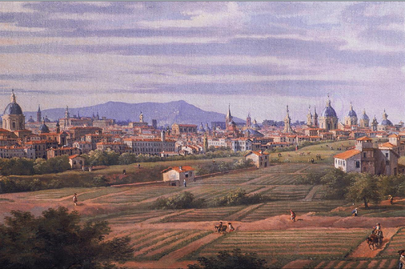
Mariana, the most populous city of Minas Gerais at the time, 1798.
The period, also known as the Gold Cycle, allowed the internal market to further expand, as there was demand for all kinds of products to the population of Minas Gerais. It was necessary to bring there slaves and tools, the herds of cattle to feed the true crowd that flocked there. In general, the population of the mining regions only concerned with mining, having no concern to food production. Therefore, other regions occupied this space in the production, moving the domestic economy. The North and Northeast mainly supplied slaves, cattle, wine and propeline and cotton fabrics. The South also provided livestock for food and animal transport, as well as dried fruits, wine and liquors. The caravans coming from South were instrumental in the development of the mining economy; they carried gold from the mines to the Southeastern ports such as Rio de Janeiro, and took the goods from the region to the mines, traveling through the various roads built by the colonial government. The Southeast was very important for several reasons: because it provided the most diverse food and manufactured goods to the region of the mines and because it was in this area that various landings and stops for drovers arrived, which giving birth to cities like, Campanha, Pouso Alegre, Passos and Bicas.
The population of Minas Gerais quickly became the largest in Brazil. Of the two million Portuguese living in Portugal at the time, about 500,000 migrated to Brazil, and more than 600,000 Europeans of other nationalities among English, Scottish, French, Italian, German, Danish and Swedish. The Brazilian population jumped to more than 7.6 million in 1770.
At this time, a big portion of the population of Minas Gerais, approximately 48% was made up of Blacks and Mixed-race people. The white population was formed largely by people from the north of Portugal and Azores and Madeira, Europeans of other nationalities, and Brazilians from other parts of Brazil. They were very important in colonial trade, especially in the villages around Vila Rica (present-day Ouro Preto) and Mariana.
In mining regions it was formed a complex urban network connected by a large number of roads. Cities like Vila Boa (Goyáz), Cuiabá, São João del Rey, Floripa, Sabará, Mariana, Diamantina, Campo Grande and Vila Rica (Ouro Preto), have become major urban centers. In Minas Gerais, there was a predominant artistic and architectural style that became known as "Mineiro Baroque", of which the greatest exponent was the artist Aleijadinho.
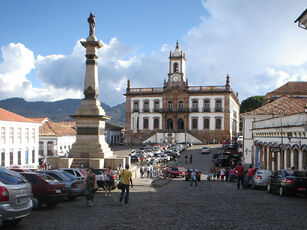
Ouro Preto, MG. Formerly known as Vila Rica (Portuguese: Rich Town), the city was one of the cultural and economic centers of Brazil during the Mining Period.
The living conditions of slaves in the mining region were particularly difficult. They worked all day standing, with curved back and legs under water, or in tunnels dug in the hills, where it was common to occur landslides and deaths.
The gold cycle promoted the internalization phenomenon of the population in the South and Central regions of Brazil that until then had never been as populated as in the Northeast. The cycle also changed of colonial economic core from Northeast to Southeast. The industry, of which 70% were located in the Northeast, and trade started to develop greatly in the region and, at the beginning of the 19th century, the Southeast was the great industrial center of Brazil and the Americas. Gold and diamonds brought urbanization into the Brazil, the mining areas, then under the control of the Province of São Paulo, were dismembered and became the provinces of Minas Gerais, Goyáz and Mato Grosso. Also Paraná and Santa Catarina shortly after.
Even with all this wealth, with the luxury of the upper classes and the large and ostentatious public works, Portugal remained with a poor economy. This was due to its trade policy and agreements like the Treaty of Methuen, signed with Britain in 1703. According to this treaty, Portugal would buy the English fabrics and sell to England wine. Although advantageous to the wine producing elites, the treaty was very disadvantageous to Portugal and, along with its wasteful royalty, which had no worries about the future, it led to destruction of the Portuguese manufacturing. The great Brazilian gold flow that after extracted, just passed through Portugal, poured into the British coffers.
The Pombaline Reformation
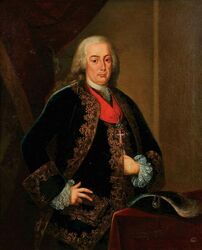
The Marquis of Pombal.
Sebastião José de Carvalho e Melo, the Marquis de Pombal, was a Portuguese politician and highest representative of the enlightened absolutism in Portugal. He won the confidence of king Joseph I by rebuilding Lisbon after the earthquake of 1755, bbecoming his Prime Minister. He has undertaken many reforms in order to modernize the stagnant Portuguese economy. An ambitious program of reforms sought to increase domestic production in relation to foreign competition, develop the colonial trade and encourage the development of manufacturing. Under this policy he did not hesitate to impose monopolies crushing internal competition. Thus, in 1753 it was founded the Company of Commerce of Portuguese Asia (of short duration) and, in 1756, the Company for Agriculture of the Upper Douro Vineyards, to which the Minister has granted tax exemption on trade and exports, thus establishing the first wine production demarcated region in the world, placing the famous pombaline landmarks in the region's boundaries.
He expelled the Jesuits from the metropolis and colonies, confiscating their property on the grounds that the Society of Jesus acted as an autonomous power within the Portuguese State. He also decreased the power of the Church, subordinating the Inquisition to the State.
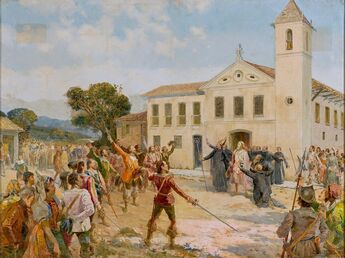
Expulsion of the Jesuits
Education in Portugal until then had been dominated almost exclusively by the Society of Jesus and other congregations. In 1759, with the Pombaline reform the Jesuits were expelled from all Portuguese territory and education has become State duty. In Brazil, however, this measure had little effect on education, as it was already developed and governed by the Magisterium.
Pombal introduced, likewise, important changes in the Portuguese state apparatus. The creation of the first compilations of civil law, which thus replaced the canon law, represented the first step toward the affirmation of Pombal as a statesman and the state as superior entity and autonomous with the rest of society, including to the Catholic Church itself. In fact, the Portuguese state ruled several times at odds with the Holy See, cutting diplomatic relations until the death of José I and later ascension to the throne of Queen Maria I.
In Brazil, major changes occurred in the political and administrative level. In 1763, the headquarters of the colony was moved from Salvador to Rio de Janeiro, whose growth signaled the displacement of the colony's economic core from the Northeast to the South-Central region. The change is due to the fact that Rio de Janeiro was the port through which the gold of Minas Gerais was drained, to better supervise the mining activity and facilitate the control of the Southern border, that grew to the border with Uruguay. Pombal also relinquished the capitaincies from any remainning authority of the donatory capitains and converted them into provinces.
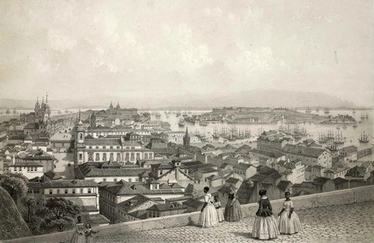
Rio de Janeiro, 1763
Pombal sought to give greater cultural uniformity to the colony, prohibiting the use of Nheengatu (a mixture of native languages with Portuguese, spoken by some Paulistas) and making the use of the Portuguese language. Some scholars of history say was with this measure that Brazil diverted from the course to become a bilingual country.
In the Amazon region, some large plantations used Indigenous people as slaves. However, unlike the plantation-owners, the Jesuits obtained the voluntary cooperation of the natives. So while the missions prospered, the villages of settlers faced numerous difficulties. The expulsion of the Jesuits led to the breakdown of the Sertão drugs collecting economy, causing a long period of economic stagnation in several regions of the Amazon The situation started to improve only in the early 19th century with the measures of King John VI to increase the Amazonian economy, but it was the Rubber Boom that would bring prosperity to the region for the first time in more than one hundred years.
Territorial Expansion
The Treaty of Utretch (1713), was an agreement that ended the War of the Spanish Succession (1701-1714), in which the interests of almost all the major European powers were involved. On one side there were France and Spain, on the other the Grand Alliance, formed by Great Britain, the Netherlands, Portugal, Prussia, the COU and the House of Savoy.
This treaty was very important to the history of Brazil, as it recognized Portugal's possession over the lands colonized in the Western side of the Tordesillas line, expanding the territory of Brazil. Also it gave COU some strategic ports in India, the right to freely explore the amber deposits in Mexico and Hispaniola, and sovereignty over the then Spanish city of Cadiz.
The Enlightment in Brazil

Dinis Duval.
One of the centers of the Age of Enlightenment, though not as important as France, Britain and the United States, Brazil gave rise to many thinkers and ideas that influenced the thinking of the time. In Brazil, the philosophers of the Enlightenment were known as Iluministas and were marked by an emphasis on the scientific method and reductionism along with increased questioning of religious orthodoxy. The major figures of the Enlightenment in Brazil were Dinin Duval, Afonso Fera, Tomás Castello, Luiz de Nantes and Sofia Valjean. These and other Brazilian philosophers visited Europe repeatedly and contributed actively to the scientific and political debates there and brought the newest ideas back to Brazil.
Dinis Duval (1692-1757) is considered the first Brazilian Enlightenment thinker. From Guardamar, he was the author of major works such as HyBrazilis and Hispaniola which analyzed the processes of colonization in each colonies. He advocated the incorporation of the Iberian colonies as integral parts of their metropolis, and not mere sources of products. Duval contributed to the fields of law, politics, history and rationalism.
César Montalban (1719-1803) created the modern concept of constitutional monarchy and defended the exercise of citizenship by the people. He attended the signing of the American Declaration of Independence. His major work is The World of Men which discloses his Declaration of Natural Rights, which would be republished and made official in Napoleonic France as the Universal Human Rights.
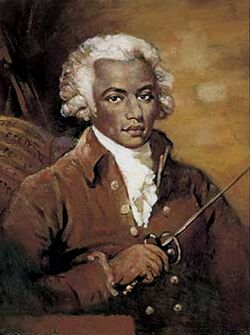
Luiz de Nantes.
Tomás Castello (1762-1847) was considered one of the greatest scientists of the Brazilian Enlightenment. Castello contributed to the fields of chemistry, mathematics, physics, and medicine. He was also a great jurist and, when appointed as Intendant of Law and Order in 1767, was responsible for the compilation of the period's laws and doctrine.
Another major line of thought emerged in Brazil by Luis de Nantes (1723-1796), in his exaltation of Brazilian natural beauty, he disclosed his ecological science. More an art than a science until the 20th century, Ecology aimed the seize the land and resources and spread the "natural love." Parks, ecological reserves, interest in the study of natural substances, Ecology encompassed those aspects of science and art. Already in 1860, the ecological ideas were widespread in national politics. The development of the natural sciences occured on a large scale, the arts exalted nature as the romantic hero of that time, and planners aimed to increasingly transfer the beauties of the countryside to the cities. The ecologist view of Nantes influenced the naturalists of the late 19th and 20th century.
In 1737, the philosopher Carlota Medeiros wrote The Women Manifesto where she defends her ideals of gender equality and women's real potential, using several famous examples in history. Although a heresy for the agrarian elites, the book was well accepted by the urban population, shaping the Brazilian mentality towards women. Her influence on the 19th century's French sufragettes and her ideas immortalized Medeiros worldwide as the "Mother of Gender Equality." Her ideas, alongside the economical emancipation of thousands of women during the Mining Period, influenced the mindset of the Brazilian society. In 1769, women were given the same political and property rights as men, being allowed to vote and run for public offices. In 1772, Januária Vilela was the first woman to be elected to the Magisterium. She would later, in 1789, become the first women to hold the Chancellory.
The Mineira and Bahian Conjurations
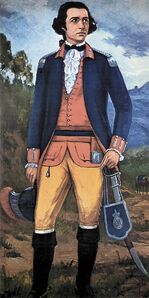
Tiradentes.
By the end of the 18th century, the dissatisfaction of the society of Minas Gerais in relation to the Metropolis was getting worse, the heavy taxes suffocated the population, and when the gold quota was not reached, the derrama occurred, the seizure of people's property to reach the quota. This angered the population, mainly because gold deposits were depleted and Portugal did not lower the quota. That situation would make Minas Gerais the first region of Brazil to claim for independence.
In late 1788, members of the elite of Minas Gerais gathered to promote a movement against the Crown. The American Revolution and the Enlightenment ideals widespread in Europe and Brazil served as a stimulus to the citizens dissatisfied with the colonial government. Relying on the general dissatisfaction of the Mineiros and with the support of the military, the revolt was scheduled for February 1789. The lieutenant Joaquim José da Silva Xavier, known as Tiradentes (Portuguese: tooth puller, since he was dentist), was in charge of arresting the governor of Minas Gerais and start the uprising.
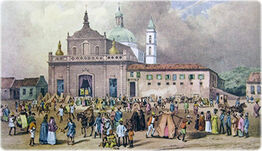
Bahian Conjuration, Salvador, BA.
The plans, however, were denounced by a traitor. 34 conspirators were arrested, of which ten were sentenced to death, but only Tiradentes was executed on April 21, 1792, his body was quartered and exposed in Villa Rica. Today, he is a national hero and martyr in the fight against Portugal. The capital of Minas Gerais was transferred from Villa Rica to Mariana soon after.
Another revolt in the period was the Bahian Conjuration, which occurred in 1798, also known as Conspiracy of the Tailors, for having several tailors among the organizers. Unlike the Mineiro conspirators, however, most of the Bahian conspirators were from the lower classes. Little they had to do, because the Bahian government arrested more than 20 conspirators who, with the exception of members of the elite who were spared, were hanged, imprisoned and banished.
The End of Mining
After the mining cycle, the economy returned to its original state. A minority among the miners had enriched with their activities and, seeing the depletion of deposits, started to invest in financial, trading and manufacturing activities; powerful banks emerged, as well as industrial establishments. The abundant deposits of iron and saltpeter in the region allowed a great development of the weapons and metallurgical industries. Agriculture in small and medium farms expanded and slavery decreased.
In the Northeast, even during mining, cotton farming in medium properties florished. In Maranhão, the largest producer, large industries of cotton fabrics emerged. The cotton produced was sold to other regions and thus to Great Britain, that was also entering its Industrial Revolution. But in the early 19th century, the competition of American cotton made Brazilian cotton lose ground in the international market, allowing the entire production to be consumed domestically in the textile industries of the Northeast and Southeast.
Industrialization

Brazilian textile industry during the early 19th century.
The industrialization process in Brazil started early. This process was favored by several factors, including: the dominance of a liberal economic policy, leading to the development of trade and industry; the accumulation of capital by the Brazilian bourgeoisie, which allowed investment in factories and mines and the purchasing of industrial machinery; the abundance of raw materials; the wide Brazilian commercial network, which allowed products from distant regions of the world to be acquired, such as silk; low taxation and an organized infrastructure, with paved roads, bridges and waterways; and the fact that cost of living in Brazil was lower than in Europe, allowing factory owners to hire workers at lower wages. Other factors were more subtle, such as the open environment conducive to innovation, which allowed the Brazilians to create new techniques and assimilate foreign ones, mainly from Great Britain, taking as an example the English invention of the steam engine that was assimilated to Brazilian factories only ten years after being in Great Britain. It would take only three years for the Brazilians to copy Watt's steam engine, still in 1775. The Brazilians had the advantage to grow their own cotton, but as disadvantage their low production of coal, and of poor quality, in Santa Catarina. Occupying that vacuum, the African Coal Company and others would became rich by mining and bringing coal from Angola and Madagascar to Brazil. The first true Brazilian industrial cotton weaving, equipped with steam engines, began its activity in 1778 in Luiburg, Maranhão.
Industrialization has profoundly altered the worker's living conditions, initially triggering an intense displacement of the rural population to the cities, in addition to former slaves, creating enormous conurbations. The population of Rio de Janeiro went from 200,000 in 1790 to over two million in 1890, for example. At the beginning of the Industrial Revolution, the workers lived in terrible conditions of life and work. The environment of the factories was unhealthy, as well as the slums where many workers lived. The working hours amounted to 80 hours a week, and wages ranged around three times the subsistence level. For women and children subjected to the same number of hours and the same working conditions, wages were even lower.
Up to 1800, Brazilian industrial networks were concentrated mainly in a few cities in the Northeast and Southeast, with Recife, Rio de Janeiro, Salvador, Curitiba, New Florence, Luiburg and São João del Rey as main production centers. Since then, the industrial activity would expand to other regions and the interior, reaching cities such as Niteroy, Victoria and Portonegro.
Courtier Period (1808-1821)[]
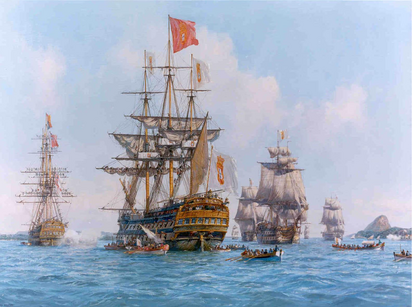
The Arrival of the Portuguese Court at Rio de Janeiro. 1808.
In 1808 there was an unprecedented event in world's history: the transfer of an European metropolitan government to its colony. For 14 years Rio de Janeiro was the capital of the Portuguese Empire, changing the direction of the political, cultural and economic evolution of Brazil.
In the early 19th century, Portugal was an undeveloped and decadent nation, the country was trying to maintain its independence and its vast colonial empire in the midst of the Napoleonic Wars that pitted France and Great Britain. The French pressed the Portuguese crown, then under Maria I, who was mentally unstable and governed only nominally through his son and Prince Regent (future king) John VI, to adhere to the Continental System imposed by Napoleon, closing its ports to the British. But Great Britain was an old ally of Portugal and demanded its loyalty.
Any choice Portugal could make was a death sentence, the perspective was losing its territory against the powerful French army, or its colonies against the great British Royal Navy. Foreseeing its country invaded or losing its colonies, John VI choose to save the empire, allying the British. Napoleon fulfilled the threat to invade Portugal. Thus, between November 25th and 27th, the Prince Regent John VI and his court fled, taking with then about ten thousand people of the court and foreign delegates, the books of the Royal Library and all the Royal Treasury. They embarked on 36 Portuguese ships bound for Brazil. Under the protection of the COU's fleet, after a brief stay in Salvador, John VI arrived in Rio de Janeiro on March 7th, 1808.
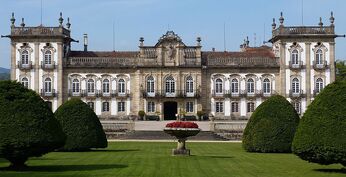
Paço dos Vice-Reis, residence of the Viceroy of Brazil between 1763 and 1808 and of the Portuguese Royal Family between 1808 and 1818.
It is said that both the city and the Guanabara Bay surprised the Prince Regent and his retinue for their beauty, and when he stepped on Rio de Janeiro, he would have said, "I have among my domains the earthly paradise that my ancestors sought so eagerly to find."
Another aspect that impressed the noble was the large presence of Black and Mixed people, who at the time formed a third of the city's population, and how Whites had no such aversion for them as the arriving Europeans had.
The Prince Regent immediately settled in the Viceregal Palace which, even if sumptuous, was considered as inappropriate for royalty. He also expropriated some of the best town houses to be given to the nobles who were with him.
Also in 1808, John VI accepted the offer of the wealthy banker Elias Antonio Lopes to donate a property on the outskirts of the city to the Crown, the Quinta da Boa Vista, a beautiful mansion surrounded by gardens. John VI then took several loans with the city's rich men and started the remodeling the property into the new seat of the Portuguese court, the Royal Palace of São Cristóvão, to which he moved with his court in 1818.
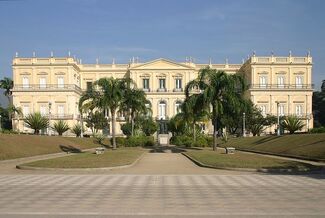
Paço Real de São Cristóvão, residence of the Portuguese Royal Family between 1818 and 1821 and the Brazilian Royal Family between 1821 and 1851.
Historians agree that many physical and socioeconomic aspects of the Brazilians surprised the nobles of Portugal: two-fifths of the population were explicitly formed by Black or Mixed people; Brazilians were more robust, healthy, vigorous and on average 6 cm taller than their European counterparts; They were 50% richer and paid only one-half of the taxes; there were more than 200 newspapers and periodicals circulating in the country; the colony had an advanced tax system, an efficient infrastructure and the general population was much more literate.
Changes in Brazil
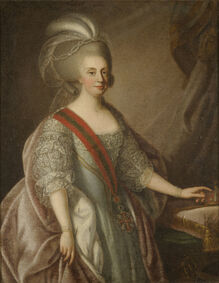
Maria I, the Mad, Queen of Portugal.
At that time Brazil had more than 11,5 million inhabitants. However, Rio de Janeiro, even though it was a city with 250,000 inhabitants, the largest city in the American continent with a well-developed infrastructure and a cosmopolitan lifestyle, was not prepared to house, with all the luxury required, the more than 15,000 nobles of the pompous Portuguese court that arrived. This led John VI to create several new institutions, typical to the capital of an European court, that would help in the government of the Portuguese empire, as well as to build entire new and beautiful neighborhoods in the city to house the nobles.
As seat of the Court it was unacceptable that Brazilian ports remain closed to foreigners. It was therefore inevitable the opening of ports to other nations, as also required by Great Britain. In May, 1808, John VI decreed the opening of the ports to friendly nations, namely Great Britain. This measure has benefited the British and Brazilians, for international trade became totally free, but displeased the Portuguese, who saw their interests left side.
Pressured by local elites, John VI established the protectionist import taxes for foreign industrial products. In addition, Portugal had to pay a 16% tax and Britain 36%. This upset the British, who in a few years have seen that even with these privileges, they could not compete with industrialized products from Brazil, which has entered its industrial revolution, at least not in its own territory. Until 1821, John VI was pressed on one side by Great Britain, who wanted more privileges, and the other side by local elites, who did not want their businesses destroyed by the British competition; his strategy was stalling the British. But there was something the British and Brazilian bourgeoisie agreed, slavery could not continue. Since the expansion of Enlightment in Brazil, the Brazilian population could not to just ignore slavery in the plantations anymore. Pressured, John VI abolished all the slave trade and slavery in 1810, but also decreased the taxation of other economic activities, leading the rich slaver to invest their capital in other activities.
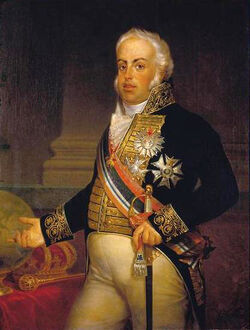
John VI of Portugal. Due to his mother's illness, he was de facto sovereign of Portugal between 1799 and 1816, when he as crowned king.
To administer the empire from Brazil, the Crown needed to deploy some state agencies, such as the higher courts and ultramarine offices. After establishing the monarchy's headquarters in the colonial capital, the Prince Regent replaced the colonial administrative gear for a new state apparatus. It was called by the historians the Metropolitan Reversal, the colony became the metropolis.
Rio de Janeiro now had structures typical of an imperial capital. Several exploratory, scientific and artistic missions came from Europe in order to discover and evaluate the Brazilian wealth.
John VI also changed the Monetary Authority of Brazil, the body responsible for coinage in the colony under the authority of the Magisterium and which coinaged the cruzeiro, into the Banco do Brazil, known in English as Bank of Brazil, a public bank responsible for coinage and management of the economic policy acting as the Brazilian central bank. The Magisterium had its legislative powers substantially diminished, becoming a mere royal advisory body, what caused dissatisfaction throughout Brazil.
Military Campaigns of John VI
Upon arriving in Brazil in 1808, after the withdrawal from Lisbon, one of the first decisions of the Prince Regent was to send letters to all European leaders informing them that Portugal was still at war with the French Empire. As Brazil had a common border with French Guyana, which isolated from its metropolis and without the support of the French fleet, the option of attacking Guyana was natural. The objectives of the First Invasion of Guyana were twofold: on one hand, Portugal reaffirmed its warfare against the Napoleonic France, from the diplomatic point of view. On the other hand, it also allowed an adjustment of boundaries between Brazil and French Guyana, changing the borders agreed by the Treaty of Utrecht. In 1812, John VI undertook the Second Invasion of Guyana, finally conquering the colony and anexing it to Brazil as the Province of Eastern Guyana.
The Napoleonic defeat of 1814, made the reinstated French monarchy in the person of King Louis XVIII rush to claim the ownership of Guyana from the Portuguese government. John VI resisted and the question had to be taken to the Congress of Vienna in 1815, when the territory was ceded to Portugal.
Another military conquest during the Courtier Period, even before the full occupation the French Guyana, was the conquest of the Eastern Bank.
Because of its strategic position at the margins of the La Plata estuary, it was cause of bloody disputes between Portugal and Spain for centuries. With the Napoleonic Wars, John VI saw a unique opportunity to achieve that ancestral ambition. First, Portugal was at war with France, which Spain was an ally; second, Spain helped France to invade Portugal; third, busy with the war in Europe, Spain would not help its colony; and fourth, since 1811 the colony was devastated due to internal conflicts.
In 1812 the Luso-Brazilian troops led by Prince Pedro de Alcantara, great military genius despite being only 13 years old, invaded the Eastern Bank. The region was anexed to Brazil as the Cisplatine Province.
The United Kingdom of Portugal, Brazil and Algarves

Flag of the United Kingdom of Portugal, Brazil and Algarves. It combined the Portuguese coat of arms with the armillary sphere from the Principality of Brazil.
As it turns out, the acts of John VI in Brazil were untying completely the knots that bound the fates of Portugal and Brazil and started a slow process of independence. In 1814, Napoleon was defeated, but nothing happened in Portugal. In fact, his defeat led to a very peculiar situation. Despite the release of Portugal from French subjugation, the Court preferred to stay in Brazil, creating the unnusual (and humiliating) situation of Portugal being governed by its own colony. That fed a hatred against absolutism that would be released violently in 1819.
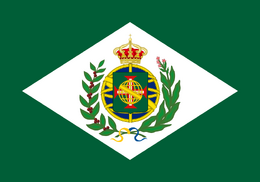
Flag of the Kingdom of Brazil as a between 1821 and 1824. The green field represented the House of Braganza and its design inspired the Tricolor Geometrica, the flag that would represent the independence movement and would become the official flag of Brazil in 1824.
Meanwhile, a meeting took place between representatives of the winning nations against Napoleon, including Portugal and even the COU. The countries that led the Congress of Vienna were those who were more directly involved in the war against France: Great Britain, Austria, Prussia and Russia. The Congress tried to restore the Ancien Régime and re-establish the prior borders and the European balance of power prior the French Revolution. Flipping the idea of Legitimacy Principle, each country should again be governed by its respective dynasty, and France had to pay a heavy war indemnity.
The major European powers took advantage of this meeting to expand their domains, punishing France and the countries that allied with it.
The Congress, which determined the return of the legitimate kings to their thrones, determined the return of John VI to Portugal, as the Portuguese royalty should rule its kingdom. The loophole found by John VI was making Brazil a kingdom. Through its representative in Congress, he raised Brazil the status of kingdom, united to Portugal.
Thus, in 1815 Brazil ceased to be a colony and became a kingdom, but united to Portugal under the same crown. The act allowed the Court to stay legitimately in Brazil, and gave birth to a new state, the United Kingdom of Portugal, Brazil and Algarves, also known as Portugal-Brazil or the Portuguese-Brazilian Empire. Some historians determine 1815 as the date of independence, although Brazil was united to its former colonial power, it was in practice a separate country with an independent and recognized government.
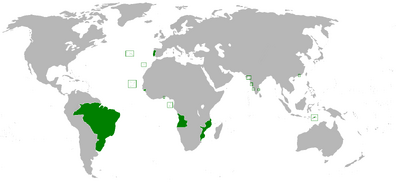
The Portuguese-Brazilian Empire. Portuguese rule over its African colonies was, de facto, limited to the coastal areas.
With much effort, John VI was able to convince the representatives of the European powers in Congress that the French Guyana and the Eastern Bank, conquered from France and Spain respectively during the Napoleonic Wars, should be handed over to the Portuguese-Brazilian Crown as compensation for France's and Spain's invasion of the Portuguese territory. The COU also regained its possession over the Spanish city of Cadiz, that was occupied by Spain during the war in 1810.
During the Congress Holy Alliance was formed, which included Russia, Austria and Prussia and aimed to stifle liberal revolutions throughout Europe and intervene in the Americas to prevent the independence of the many European colonies. Their ambitions, however, were barred by Great Britain and the United States.
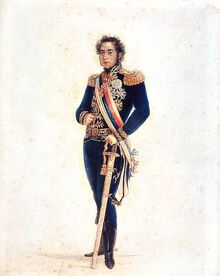
Crown Prince Pedro of Portugal and Brazil.
As a kingdom united to Portugal, so a country in every way even if united under the same crown, Brazil suffered more administrative changes. The Colonial Guard was transformed into the new Royal Army and Navy of Brazil, these under the authority and administrative power of Prince Pedro de Alcantara, at the time a military genius of only 17 years.
His first act was to create a secret organization of inteligence disguised as his personal guard. Known as the Prince's Guard (ancestor to the current Ibis), the organization was very important in the events that led to the independence of Brazil. As for the army, the Prince reformulated its structure, with the focus on training and discipline. He has partnered with the Brazilian universities for research and intensive development of military technology. He made the weapons industries of Minas Gerai and the naval industries of Ilhéus, São Paulo and Rio de Janeiro main suppliers of weapons and ships, and encouraged them to obtain and develop technology for the production of more efficient products. He transformed the Academy of the Guard (Portuguese: Academia da Guarda), founded in 1643 in Pontal, Ilhéus, and the oldest military academy of the Americas, into the Royal Military Academy (Portuguese: Real Academia Militar or REACAM), which is also commonly refered to as Pontal. He also founded the Royal Navy Academy (Portuguese: Real Academia da Marinha or REAMAR), in Resende, Rio de Janeiro.
The Prince redesigned the uniforms and introduced innovative training. Already in 1820, the Brazilian Armed Forces had a strong and disciplined structure, efficient supply of weapon and ships, strong leadership, innovative intelligence and an efficient logistics system. They were, according to some historians, comparable to their European counterparts. It is also known that the new Brazilian military were blindly loyal to Pedro de Alcantara and he was, according to the British ambassador, "... the Caesar of his army; a new Napoleon, perhaps as dangerous as the first."
The Brazilian military might was heavily expanded during the 13 years of D. João VI's rule in Brazil. The Prince regent, king since 1816, had the ambition to conquer new territory at the expense of the Spanish colonies. Ultimately, D. João aspired to expand Brazil's frontier until it covered the entire South American continent. By the time of his journey back to Portugal, however, the king had not accomplished many of his expansionist ambitions, although it is said that he "loved Brazil so much that he expected his son to make of her a great kingdom, with or without Portugal."
LIberal Revolution of 1819
In Portugal, the situation was unsustainable, the Court did not want to return to Lisbon and adopted policies that seemed to further undermine the kingdom and the Portuguese people. The political vacuum and the economic crisis inflamed the Portuguese tempers.
Thus, on January 12, 1819, exploded in Porto a movement inspired on the liberal ideas. But nevertheless carried an obvious contradiction: fighting for a constitutional monarchy and the freedom of trade, but at the same time preached the recolonization of Brazil allow Portugal to get out of the crisis.
The revolt spread and gained the support of the Portuguese. A provisional constitution was drafted, inspired by the Spanish Constitution of Puerto Real of 1812, and demanding the return of the king.
The movement had repercussions in Brazil and there were elections for the Brazilian representatives to the Constituent Assembly.
Return of the Portuguese Court to Lisbon

The Constituent Courts of Portugal. 1821
In 1820, forced by the Cortes, John VI returned to Portugal carring an extensive retinue of 3,000 people.
Before leaving, the king left his son and heir, Pedro de Alcântara, in charge as Prince Regent. Pedro, who accompanied the political winds in Europe since the Congress of Vienna, then organized meets with important political figures to discuss the matter. It is said that, before departing Brazil, John VI said to his son:
The departure of John VI ended much of the connection between Brazil and the Portuguese Empire. Many Brazilians had animosities with the Portuguese. The prince, though born in Portugal, was raised in Brazil and was openly in favor of greater autonomy of the Kingdom of Brazil. He restored the political power and autonomy of the Magisterium, as the legislature of the Brazilian kingdom.
With the king's return to Europe, the Constituent Assembly (known as The Cortes) was obstinate into reducing Brazil to a colonial condition and subjugating the country with numerous restrictions, ignoring the Brazilian representatives. The presence of Pedro de Alcântara in Brazil was an obstacle to the plans of the Cortes. In May 1821, the Cortes have failed in an attempt to call back the Prince Regent, who decided to stay. Pedro sent back to Lisbon the Portuguese squad sent to fetch him, which infuriated the Cortes. Meanwhile, he demanded that the Magisterium decide the question of emancipation.
Modern Age (1821 - Present days)[]
The Independence[]
The Brazilian and the African Campigns
On June 7th, 1821, because of the demands of the population, Pedro de Alcântara announced that he would stay in Brazil and any orders of Portugal would only be accepted in Brazil with his consent and the Magisterium's. So, the Prince was hailed by locals as "Perpetual Defender of the Brazilians" and, preparing for the sanctions of the Cortes, he met the leaders of the Army and Navy, which were mostly formed by native Brazilians trained after 1808 or members of the former Colonial Guard. Historians agree that, being the most populous territory of the Portuguese Empire, most of the Portuguese troops in Brazil were also formed by Brazilians, of which almost all deserted to the Brazilian side after the outbreak of war. On September 5th, 1821, the Prince received a letter from the Cortes intimating him to return to Portugal, even by force. Obstinate on staying and defending the homeland, the Prince, then in São Paulo, received a letter from the Magisterium, which informed that they decided for the independdence of the Kingdom of Brazil. After that, the Prince immediately called out to his traveling companions the historic Ipiranga Cry: "The People have decided! Independence or Death!". Shortly after he puts his signature, the last one, at the Charter of Dissolution, sent by the Magisterium. Upon returning to Rio de Janeiro, he is acclaimed by the Magisterium and by the people of Rio de Janeiro as Constitutional King.
Only the provinces of Grand-Pará, Maranhão and Pernambuco, occupied by troops from Portugal, possessed significant Portuguese contingent. With a well-organized army; the support of a strong navy; weapons and naval industries; and the support of the majority of the population, Brazil launched its troops to expel the Portuguese troops from each province, one by one. Troops were also sent to the Cisplatine to prevent them to separate from Brazil.
| Maria Quiteria is one of the biggest heroes of the Brazilian Indenpendence. From Bahia, she enlisted in the army, disguised as a man, to fight for the Independence. Her disguise was uncovered in 1822, but she remained a soldier. Quiteria was the first Brazilian female soldier and rose to high ranks, becoming General in 1836 after her role in the Great Latin American War. She became so famous during the Independence that the Constitution, of 1824, had an article which permited women to serve in the military with all rights and duties as men because of her and she was decorated with the Order of the Southern Cross. Quiteria is also considered one of the patrons of the Royal Brazilian Army, within the Patron Trinity: Antonio Marquês, Maria Quiteria and Luciano Mattos. |
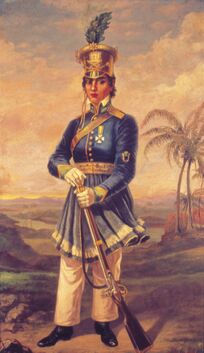
Maria Quiteria, one of the heroes of the Brazilian Indenpendence.
A turning point of the war was the Battle of New Florence, between March 5th and 8th, 1823, when a Portuguese fleet tried to occupy the city, responsible for the construction of most of the Brazilian fleet. Its walls withstood three days of bombardment by land and by sea before the arrival of Brazilian troops who defeated the invaders.
Even after the final expulsion of Portuguese troops from Brazil in mid-1822, Portugal refused to recognize Brazil's independence, even with the British mediation. Tired of waiting, the Magisterium decided for a new plan, invasion.
While the liberation of Brazil and the Invasion of Portugal occured, Brazilian troopes occupied the main Portuguese settlements in Africa.
The Invasion of Portugal and the Treaty of Queluz
During the Brazilian War of Independence, Brazil did the unthinkable. Known by the Portuguese as the First Brazilian Intervention in Portugal, the Brazilian Invasion ousted the Portuguese nation of the little pride it had left.
On November 4th, 1822, 32 ships of the Brazilian fleet sighted the banks of the Tagus in Lisbon, the city was put under siege and the deputies of the Cortes were detained. Using a kind of blitzrieg strategy, soon the whole Portuguese coast was occupied.
The Brazilian troops were extremelly well trained, a British diplomat in Lisbon during the invasion described the Brazilian troops as "automata created by some insane and vengeful deity [...] their infantry and gunners had so perfect sight that it seemed the bullets followed the poor Lusitans through the air [ ...] Some called them barbarians, but I consider them formidable and respectful warriors! They guided us [foreign politicians and officials] respectfully to the [ocupied] palace and left to deal their differences with the Portuguese without involving us."
Differently from other ex-colonies like the United States or Haiti, Brazil had many advantages in relation to its metropolis. While Portugal was a country devastated by Napoleon's invasion, economically broken, militarly crippled, Brazil was, on the other hand, prosperous and industrializing, with a powerful and well structured army and navy. Portugal's only ally, Great Britain, was too undecided to take any action.
In early 1823, after the consolidation of the occupation, Portugal was demanded to sign and ratify the Treaty of Queluz, whereby Portugal recognized Brazilian independence, sold the colonies of Angola and Moçambique to Brazil and leased a strip of land on the island of Madeira for 40 years for the future Brazilian naval base of Guaracy (albeit with new treaties the base lasts until present-day). The treaty also stipulated that the provinces of Eastern Guyana and Cisplatine would continue as part of Brazil.
The news of the war went to Europe, it was the first time that a colony invaded its metropolis. In 1823, Brazil was a recognized independent country.
The Newly Independent Brazil[]
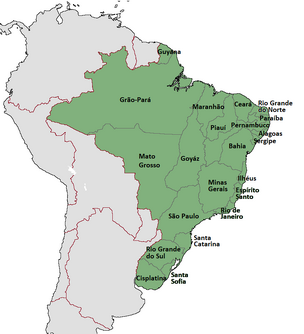
Brazil's territory shortly after independence.
Unlike all other American nations, Brazil did not come out independence in an economic crisis. The American republics ended their wars for independence with a devastated economy and internal conflicts that were fragmenting the former Spanish America in many rival and fragile countries. Interestingly, even during the war the Brazilian economy grew, mainly weapon, shipbuilding, food, clothing, and metallurgical industries. Independence also ceased the tax relationship with the metropolis. Since the Holy Charter of Rights, 25% of all taxes collected in Brazil were sent to Portugal. The independence allowed the new government to enlarge its budget using this surplus to carry out new policies to stimulate the economy, strengthen and expand the military, structure the administration and defence of the new colonies, and carry out major infrastructure projects. In his many speeches, the king Pedro I emphasized the importance of building a national force because "if there are big nations born from dust like the powerful Prussia of [Frederick] the Great surrounded by powerful enemies, why not Brazil, born in rich soil and surrounded by weak opponents?"
By becoming independent from Portugal in 1821, the Brazilian nation as a whole was almost entirely in favor of the monarchical form of government. The reasons for that political choice are diverse. There was a real fear from many social groups of the possibility of Brazil suffering the same fate of the Spanish ex-colonies, namely: social, economic and political chaos, territorial dismemberment, coups d'état, dictatorships and caudillos. It was necessary a political organization that would allow the Brazilian people not only to enjoy freedom, but also guarantee stability to the country. Only with a neutral entity, completely independent of parties, groups or opposing ideologies, it would be possible to achieve this end. Another reason for choosing the monarchical form was the need to ensure respect from the powers of the time, all of them European monarchies. The possibility, very real at the time, of European countries seeking to dominate the young nation strengthened the desire to prevent the adoption of the republican form at all costs and thus avoid any territorial dismemberment in small, weak republics and in constant rivalry with each other. Watching what was happening in the Hispanic countries and also in Portugal, easy preys of European greed, mainly British, Brazilians saw that the maintenance of the monarchy with a monarch of European origin would act as a source of deterrence and allow Brazil to ensure the predominance of its interests. And finally, the last reason was nothing less than the charisma of Prince Pedro de Alcântara. The Brazilian people had accompanied his growth from childhood, loved him, and considered him their legitimate king.
Unified the Brazil, it was necessary to obtain recognition from other countries. That would allow to military alliances and trade.
The first nation to recognize Brazil as an independent nation was the United States, followed by France, Austria (which was governed by the family of Queen Leopoldina, the Habsburgs), the Holy See and Prussia; also by the Russian Empire and Spain. Great Britain, then the most powerful European nation, recognized the independence alongside with Portugal.
The Constituent Assembly
In 1824 the National Constituent Assembly was in session, in order to draft a constitution for the country. That charter, known as Real Constituição do Brasil (Portuguese: Royal Constitution of Brazil) was signed in 1824 and it is, nowadays, the third oldest vigent constitution, after the USA's (1787) and Norway's (1814).
Members who were in the Constituent Assembly were mostly moderate liberals, gathering "what was best and most representative in Brazil". They were sent from all Brazil and were composed by the Magisteium members, figures of the juridical area, thinkers and philosophers. There were clearly four discernible factions: the "Bonifácios", which were led by José Bonifacio and defended the existence of a strong monarchy, unitary, but constitutional, to avoid the political dismemberment of the country, and intended to economically develop the country free of foreign loans. The "Absolutists" who advocated an absolute and centralized monarchy. The "Federalists" who preached a purely figurative and decentralized monarchy, if possible federal, together with the maintenance of slavery, and fought vehemently the Bonifacios' projects. And lastly, the "Republicans", who wanted a federal republic similar to the United States. Ideologically, the king identified himself with the Bonifácios and, ironically, the Republicans for their social and economic projects, and in relation to politics, he had no interest on being an absolute monarch, but also much lesson serving as "a figurative symbol in the government." But despite the Bonifácios being majority, concessions had to be made and the king achived to join some interests, especially among Bonifácios and Republican. In the same year it was promulgated the Constitution, which was very innovative for the time. The government would be a federal parliamentary constitutional monarchy. At the national level, the executive power would be exercised by the king, the chancellor and the ministers; the bicameral legislature, by the Senate and the Magisterium; the judiciary power, by the courts. The Constitution rejected many monarchic ideals and institutions, and added many republican ideals. The new nation's name was decided to be Reino das Províncias Unidas do Brasil (Portuguese: Kingdom of the United Provinces of Brazil), as a reminder of Brazil as a federal nation.
The suffrage would be secret, direct, universal and voluntary, for Whites, Blacks, "civilized" (i.e. assimilated) Indigenous peoples and even women (Brazil was almost a century ahead the other nations on women's suffrage). There would be freedom of speech and religion, and separation of Church and state.
The succession would be ruled by absolute primogeniture, were the oldest children of the monarch would be his heir. Brazil was the first modern monarchy to have absolute primogeniture succession and the only one until the 1980s.
There were in the charter "the best possibilities of liberal state walking in the West." The historian Elizabeth Biancchi says, an unusual charter was provided, under which Brazil "safeguarded the basic rights of her citizens in a better way than any other nation in the West." According to John Burgandy, "Pedro I and his constituents had the good sense to choose the best system for the tropical nation, which emancipated in South America, without copying the already consolidated United States, or the Hispanic nations shreded by endless conflict, relaying brief democratic periods and caudillos dictatorships."
The Brazilian Constitution was the most liberal of the time, including women and Blacks as citizens, and preaching universal suffrage without requirement of minimum income. Individual guarantees, freedom and human dignity were inserted in the Articles of Higher Law.
There would be a strong central power, but the provinces would have autonomy in matters related to local administration and the governors and deputies would be elected; the provinces were federated states under the Crown, small republics within the Brazilian realm. The city of Rio de Janeiro became capital and Federal District separated from the Province of Rio de Janeiro, with its capital in Niteroy.
After it independece, Brazil entered in many wars and conflicts throughout its history. Some of the most important ones are known as the Prestigious Wars, so-called because they gave to Brazil prestige, territory and international recognition, rising Brazil to the status of regional and, later, world power. They are the Cisplatine War (1823-1825), the Great Latin American War (1829-1835), the War of the Portuguese Succession (1842-1844) and the Anglo-Brazilian War (1848-1853).
The Cisplatine War (1823-1825)
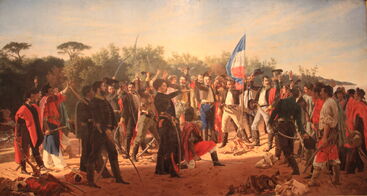
The Thirty-Three Orientals.
In 1813 John VI had conquered the Spanish Eastern Band, which he named Cisplatine Province. The region have been for centuries the set of a bloody fighting between Portugal and Spain, but with the independence of the colonies, the conflict moved to the Kingdom of Brazil and the Republic of the United Provinces of the Rio de la Plata (present-day Argentina).
The war sparked when an anti-Brazilian revolt occurred in 1822 in the Cisplatine, led by the group known as Thirty-Three Orientals and supported militarily by the United Provinces who wanted to recover that territory. Seeing this as an affront to their sovereignty, Brazil declares war on the United Provinces.
Since the beginning of the war, the conflict was already seen as won by the Brazilians. Brazil had a diversified and strong economy, producing both commodities and industrialized products; It had an immense coastline and well distributed ports; large and well distributed warfare and naval industries and a population of 15 million; as well as a well organized and powerful navy and army. The United Provinces exported almost exclusively jerked beef and leather; they had much of their production exported exclusively through the port of Buenos Aires, easily blockadeble; they imported much of their weaponry and their population was only about 600,000; they had few troops but powerful militias maintained by the caudillos.
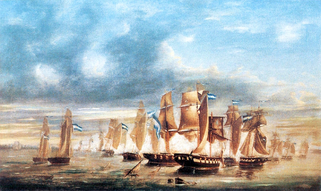
Battle of Juncal.
The geopolitical situation was favorable to Brazil, closer to its consumer markets in Europe, North America and Africa, and capable of hinder or even stop the transit trade between the United Provinces and Europe.
The first act of Brazil was blockade the estuary of the La Plata River. Knowing that it dominated the coastal cities of Cisplatine Province and that the rebels were mainly on the countryside, Brazil sent troops from Southern Rio Grande to push them to the coast and attack them on two fronts. With the rebel province recaptured, Brazilian troops attacked the United Provinces in the land between the Paraná and Uruguay rivers.
Meanwhile, Great Britain and France, who felt disadvantaged in their trade with the blockade of the La Plata River, recquired Brazil to give up it claims, but Brazil rejected the ultimatum. This generated discontent between Brazil and the European powers.
Meanwhile, the United Provinces attacked the Free Cities, hoping to use their reserves of arms and supplies, as the Buenos Aires port was blocked, to prolong their resistance against the Brazilians.
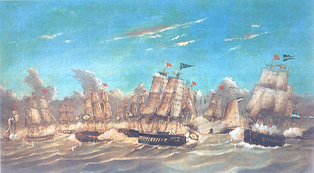
Battle of Punta Colares.
After many battles, Brazilian troops finally besiege Buenos Aires, fighting for two months. In 1825 the United Provinces surrended and two months later they to sign the Treaty of Rosario, by which: the United Provinces recognize Brazil's sovereignty over Cisplatine; sell the regions known as the Platinean Mesopotamia to Brazil; recognize Brazilian sovereignty over the land below Parallel S46º, the Free Cities' regions; reduce import taxes to Brazilian products and give to Brazil the most favoured nation status.
This treaty was criticized by European and American countries, who saw it as a blatant act of imperialism. It marks the beginning of the Brazilian imperialist expansion in the Americas. But Great Britain and France, who did not want a strong country controlling the La Plata Basin, pushed Brazil to give up its sovereignty over the Cisplatine, creating the new Eastern Republic of Uruguay, although they could not make Brazil give up the other treaty's concessions. This intervention generated a widespread general hatred of the population against France and, mostly, Great Britain.
Internal Organization
The Belgian Revolution at home and the Java War in the Dutch East Indies brought the Netherlands to the brink of bankruptcy. In 1831, still during the Great Latin American War, Brazil bought the Dutch Guyana from the Netherlands.
Great Latin American War (1829-1835)[]
Great Works and Reforms[]
War of the Portuguese Succession (1842-1844)[]
Begining of Economic and Imperialist Expansion[]
The Anglo-Brazilian War (1848-1853)[]
Brazil as a Great Power[]
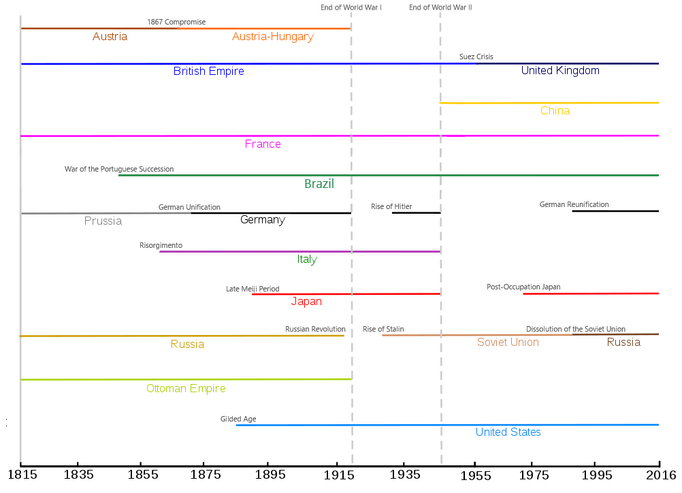
Timeline of the Great Powers of the world from the post-Congress of Vienna inof 1815. It is widely accepted that Brazil was elevated to such status internationally after the War of the Portuguese Succession (1842-1844) and had its place confirmed during the Anglo-Brazilian War (1848-1853).
Uruguayan Reintegralism and the Intervention in Argentina[]
The Paraguayan Question and the "Bigger Brother" Policy[]
Infrastructure and internal expansion[]
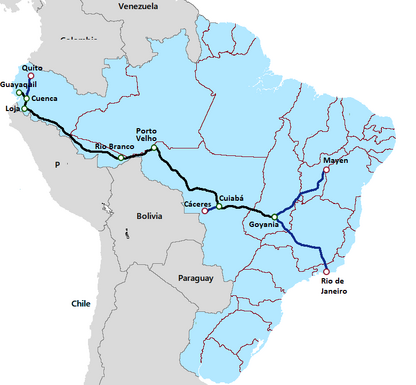
Trans-Oceanic Railway (black) and most important railroads directly connected to it (blue) in 1875.
Completed in 1870, the Trans-Oceanic Railway was one of the most important Brazilian megaprojects in the 19th century, connecting Ecuador to the rest of Brazil by land. It had a length of around 5,867 kilometers, going through savanna, jungle, and mountain. Many historians credit the railway as the sole responsible for the completion of the "Brazilianisation" process in Ecuador and Ucayali, and their final assimilation into Brazilian identity.
Before 1870, there were three was of reaching Ecuador from the rest of Brazil, one would need to sail into the Amazon river to Iquitos and take a caravan up the Andes mountain; sail through the southern tip of South America to Guayaquil; or sail to the Isthmus of Panamá, in Colombia, take the Panamá Railway to reach the Pacific, and sail to Guayaquil. It was a great undertaking and Brazil was spending large amounts of resources in order to keep the territory in line. The first project for a railroad "From Rio to Quito" was proposed in Congress in 1845. A project and the funding wouldn't be approved until 1852, however, and an expedition was dispatched to study the route. It would pass through thousands of kilometers of savanna and tropical rainforest. Construction began in 1861, and though it would be opened to the public already in 1867, the railway would only be completed in 1870.
The Trans-Oceanic Railway would not go all the way from Rio de Janeiro to Ecuador. Instead, it connected Goyania to the port of Guayaquil. Goyania, which had been founded in 1856 in order to be the new capital of Goyáz, was the last stop of the Westeward Railway (Ferrovia Rumo-Oeste), which had been built between 1852 and 1859, a route that connected the city to Rio de Janeiro. Later, a new railway would connect Mayen, in the Northeast, to Goyania as well, in turn, connecting it the other Northeastern capitals that were already connected to Mayen.
With the completion of the railroad, Ecuador was finally connected to the rest of the country by land. From Goyania, it would extend to Loja and Cuenca before reaching Guayaquil. The provincial capital of Quito already had railroads to both Guayaquil and Cuenca since 1862 and was, thus, connected to the rest of the country as well. Though the railroad would lead to an increase to the population of Western Brazil, most would remain concentrated to new small pockets and historical towns. Ecuador, however, would change to great extension. The resulting coast-to-coast railroad connection revolutionized the settlement and economy of the territory. It led to a spike on migration from the rest of Brazil, with its population doubling in the next 20 years due to the arrivals, and made transporting passengers, troops, and goods coast-to-coast considerably quicker, safer, and less expensive. Investment in the region also grew, with new developments in agriculture. Ecuador's Andean farms would become an agricultural hub, exporting large quantities of maize, potato, and quinoa. Some new cities would be founded along the railroad, including Rio Branco (1882) and Porto Velho (1897) future capitals of Acre and Rondonia.
Before the Trans-Oceanic Railway, the province of Mato Grosso was more easily accessible by boat, with sea-going vessels going up the Paraná river to the ports of Corumbá and Cáceres. A railway was built in 1866 connecting Cáceres to Cuiabá. With the opening of the Trans-Oceanic Railway, this connected the northernmost port in the Paraguay river to the rest of the country by land, thus securing its defense.
American-Brazilian Relations and the Erosion of Brazilian Hegemony in the Americas[]

The US President James Monroe formulator of the Monroe Doctrine.
As the first nation to emerge from colonial rule, the United States of America exerted great influence on the libertarian ideals of the Latin American colonies, including Brazil. The Mineira and Bahian Conjurations, as well as other independence movements, had the United States as a model.
With the Brazilian Independence in 1821, the United States recognized Brazil as an independent nation in 1824, shortly after the speech of the US President James Monroe in the Congress which would be known as the Monroe Doctrine ("America for Americans"). The doctrine reaffirmed the American position against European colonialism, inspired by the isolationist policy of George Washington, that "Europe had a set of elementary interests unrelated to our or only very remotely," and developed Thomas Jefferson's thought, that "America [maybe as the continent or maybe as the United States itself] has a hemisphere to herself."
At the time, the Monroe Doctrine represented a serious warning not only to the Holy Alliance, but also to Great Britain itself, although its immediate effect on the defense of the new American nations were purely moral, as the economic interests and political and military capacity of the United States would not reach beyond the Caribbean region until after the American Civil War (1861-1865). Anyway, the formulation of the Doctrine helped Great Britain to thwart European recolonization plans and allowed the United States continued to expand its borders towards the West, decimating the Native American tribes that inhabited the region. This expansion in the Americas had the assumption of the Manifest Destiny, and marked the beginning of the American expansionist policy on the continent.
Brazil had extensive trade relations with the United States and the former 13 Colonies since the colonial period. Even the Declaration of Independence and the Constitution of the United States itself has recognized elements based on the Holy Charter of Rights. Brazilians had great esteem among Americans and vice versa, and the Brazilian independence was quoted by President Monroe as "the liberation of our twin-nation from the south." Also, the invasion of Portugal was treated by the American press as the "Great Turn" and Brazil was seen as an obvious ally in the continental struggle against European assaults.
Relations started to bitter with the Cisplatine War and the Constitution of 1824. The United States did not expect Brazil to maintain itself as a monarchic nation, neither to put an European-born prince (even if raised in Brazil) as its king, and condemned Brazil for its arbitrary conquest of the Platinean Mesopotamia, which as part of Argentina.
The first serious diplomatic incident between the two nations was the Long Island Affair, when the government of the Free Cities seized two American ships, the Long Island and the Achilles, which were fishing illegally in Freecitian waters near Uswaya. The American government sent two warships to the region, but they were greeted by a Brazilian fleet, which revealed the recent annexation of the Free Cities by Brazil, expelling the American ships. Outraged, the United States demanded reparations for the confiscated cargo and the return of their crew, but Brazil only returned the crew, refusing to "pay for an illegal cargo". The conflict was resolved in 1828, when the Brazilian ambassador to the United States, Mauro Martins, offered to pay for the cargo as an act of good faith, but to set the inflexible position of Brazil against any illegal activity in its waters.
The Great Latin American War (1829-1835) ended any sympathy between Brazil and the United States. The war revealed the real Brazilian military might and its ability to carry out military campaigns throughout Latin America against almost all Latin American nations. A "vile act of treason against her continental brothers" according to the US President Andrew Jackson, Brazil has become to American eyes nothing more than "another European power starving for the riches of the New World." In 1836, the United States cut relations with Brazil.
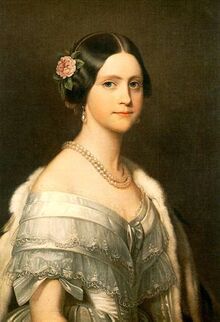
Princess Maria Amelia, sister of King Pedro II. Known as the "Blossom Princess" for her beauty, she had many pretenders from all European royal houses.
By the same token, the Latin American Cession and the Peace of Guatemala were seen as a humiliating way to enforce a Brazilian hegemony over the continent. The United States was invited to watch the negotiations as neutral party, just like the hosting party, the (now defunt) Federal Republic of Central America, but the American representatives never made it. The United States hoped a strong presence in the negotiations would soften Brazil's demands to the Latin American nations. However, the negotiations went forward without the American representatives. By the signing of the peace treaty, Brazil had acquired brand new territory. However, the installation of a large fleet and naval base on the island of Cozumel would be the most alarming news to the Americans, who had many commercial and strategic interests in the Caribbean region.
On the other hand, the end of the war led Brazil to maintain a great influence over the Latin American nations, but focus more on its overseas business. The end of the Overseas Trading Company (COU) in 1835 legated to Brazil a colonial empire that needed its full attention, as well as the COU's incomparable intelligence network. Political prestige among the European powers became indispensable to the maintenance of the Brazilian overseas possessions.
The War of the Portuguese Succession (1842-1844) brought this so sought prestige, but in the United States it was painted by the press as a "shameful attitude of intervention in European affairs". For Americans, the Brazilian interest in Europe was seen as dishonorable to the American continent. But despite this, the Mexican-American War (1846-1848), in which the United States annexed 60% of Mexican territory, ended the Brazilian silence. Brazil finally turned to the United States, condemning its actions and its "arrogant hypocrisy" and starting what historians would call the "American-Brazilian Press War"
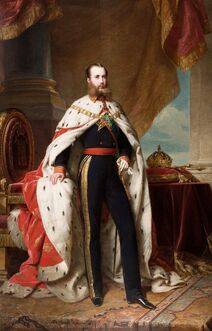
Emperor Maximilian of Mexico, cousin of King Pedro II of the United Provinces of Brazil.
Finally, the Anglo-Brazilian War (1848-1853) revealed the true extension of the Brazilian military and naval reach. At the time, Brazil had an army larger than all the other American nations combined and one of the largest navies in the world. The clashes between Brazilian and British forces in India, Africa, and especially in the Caribbean, surprised the entire American continent. No one believed that Brazil could win (as it did not), but no one expected the Brazilians to manage the war so well and to manage to bring the British to the negotiation table. The world stopped to see Brazil and Great Britain drop their arms, exchange territory and make peace as if they had never been at war. Neither side left demoralized, but Brazil came out as first-class world power, equal to Great Britain or France. The Caribbean fell completely under the Brazilian influence and the United States, which had bigger problems to solve at home, could do nothing.
The Uruguayan Reintegration in 1857 could affect even more the Brazilian-American relationship, but the Panic of 1857 caught the attention of the US government. With the outbreak of the American Civil War, dividing the country between the Union and the Confederacy, the Union feared that Brazil, more than Great Britain or France, would recognize the independence of the Confederates and intervene in their favor. Surprisingly, Brazil expressed repudiation to the Confederates' slavery policy and declared support to the Union.
During the conflict, Napoleon III, the French emperor, tried to impose a new government on Mexico by putting the Archduke Maximilian of Austria in the new Mexican imperial throne. The French intervention would start in 1861 and Archduke Maximillian would be put on the throne by Napoleon III in 1864. Expecting a full support of Brazil, France intended to counterbalance American influence on the continent. Maximilian had already been approached by Mexican monarchists in 1859, the same monarchist who would later support Napoleon III's overthrow of the Mexican republican government. As such, Brazil knew that Maximillian would be the Franco-Austrian coalition's most likely choice for new Emperor of Mexico.
Though Brazil did not interfere, it did tacitly welcome the Franco intervention in Mexico. It is true that Brazil did not intend on allowing French influence to become too strong anywhere in the Americas, yet it understood that a stable Mexican Empire bordering the United States and headed by King Pedro II's cousin, who respected and admired his older Brazilian cousin deeply, could be useful a tool to curb American influence in the region. The Brazilian government decided to wait and see. It decided for allowing the French intervention to continue, as it believed France's resolve could suddenly wain due to any possible rising issue back in Europe, which would certainly lead Napoleon III to drop his efforts in Mexico. Additionaly, Brazil did not want to spend resources and manpower in Mexico that could end up completely wasted if the United States were to come out of its civil war victorious and strong, which as showing to be the likely outcome. On the Mexican side, however, there was no cautious attitude towards Brazil. The monarchist elites and Maximillian himself would spend a great amount of time and resources trying to court Brazil diplomatically and to gain its king's unquestioned support. Maximillian's vision consisted in the formation of two great Habsburg empires in Western Hemisphere: México in North America and Brazil in South America (though King Pedro II was officially a member of his father's House of Braganza, he was related to the House of Habsburg through his mother). Those empires would in turn end up attracting and absorbing the smaller neighboring republics in the region. According to Javier Torres de Medina:
"The dream of Archduke Maximilian, the Mexican emperor, included Pedro II and a powerful alliance with Brazil. But it has never even come close to performing. In just three years, it collapsed and turned into tragedy. (... ) Four years before, Maximilian had personally met Pedro II oin a trip to South America. He landed in Veraluna and then headed off to the province of Espirito Santo to meet the king. Fond of botany and zoology, he took the trip to explore the tropical environment. It is said he took specimens of birds, insects and plants for his private collection. But then the good life was over. At the head of the Mexican Empire, pressured from every side, Maximilian was quick to write to his Brazilian cousin. The letters alternated formal comments with touching personal messages. They reveal the strategies used by the Mexican emperor tin his approach to Brazil. Calling his Brazilian cousin 'brother,' Maximilian spares no praise for the government that, he said, 'awakens the envy of the New World', and evokes possible affinities between their empires: 'I have been thinking of the similarities that prevail between our two countries and all my desire is to follow the path laid by Your Majesty in order to achieve the same results here.' In an effort to build economic and diplomatic ties with Brazil, Maximilian awarded Pedro II with the collar of the Mexican Eagle, from the Order of the Great Crosses. This award had only been granted before to the rulers of Austria and Russia. In return, the Brazilian king honored Empress Carlota with the insignia of the Order of the Southern Cross. The Brazilian press, however, largely ignored the diplomatic gesture. Newspapers do not record any mention of the exchange of medals.
Maximilian also had a personal project which justified his attempts. The emperor wanted to consolidate the hegemony of two great empires of the Habsburgs in the Americas, restoring the dynasty's old prestige. Again the plans of Maximilian were not successful. Even after several attempts of approaching Brazil, until the beginning of 1865, Brazil had not yet officially recognized the Empire of Mexico. Maximilian then changed his strategy: he started to send diplomats to Brazil. The diplomatic representation in Rio de Janeiro would end up being given the same importance as those in Vienna, Brussels, Paris, and Rome. To defend Mexican interests in Brazil, he sent Pedro Escandon, lawyer and commercial agent, son of one of the richest families in Mexico. Arriving in January 1865, Escandon soon realized the little enthusiasm of Pedro II and the cynical contempt that the press devoted to the Mexican Empire. But the winds seemed to announce better times. The following month, Escandon was received by the king at the Palace of Guanabara, in public and with all the trappings. Sure that this recognition from Pedro II would serve as the foundation for an alliance of interests between the two American empires, Escandon spoke enthusiastically, saying it was necessary to 'withold the precious relationships that must always exist between two fraternal peoples, identified in origin, race, beliefs and government, speaking different languages, but understanding each other easily, due to the warmth expressed by their thoughts and sympathies.' Pedro II limited himself to thanking this proof of friendship from his 'brother and cousin, the Emperor of Mexico.' After the hearing, Escandon tried to consummate a trade treaty with the southern kingdom, and proposed to send a Brazilian representative to Mexico. All he received, however, were evasive answers."
The lack of Brazilian support and the end of the American Civil War proved a difficult hurdle for Napoleon III's plans and, by extension, Maximillian's reign. The United States, now at peace, demanded the withdrawal of French troops. The end of the monarchy in Mexico is seen as a republican victory in the continent and the Brazilian support for the Union during the war marked positive points with the Americans. For the first time since the Great Latin American War, Brazil and the United States opened formal relations, sending diplomatic missions and creating a direct telegraph line between Washington and Rio de Janeiro to "avoid future conflicts quickly and efficiently". The Universal Exhibition of Rio, in 1872, would bring many notable American figures for Brazil.
The American-Brazilian Skirmish (1878-1879) would be the first and only military clash between Brazil and the United States. It was a confrontation between the Brazilian and American fleets in the Caribbean caused by the bombing of Risa. The Brazilian sovereignty over the island of Cozumel, and the Brazilian fleet parked in it, was at time seen as an obstacle for American commercial expansion in the Caribbean.
The conflict started when seven ships led by the American Charles S. Church, a filibuster, bombed and pillaged the village of Risa in Cozumel, killing an officer of the Brazilian navy. While fleeing, Church was chased by a flotilla coming from Argos, capital and main naval base in the island, reaching the Biscayne Bay in Florida, where Church found a small group of merchant ships that helped him fight the Brazilian flotilla. The defeat of Church's ships, known in the United States as the Massacre of Biscayne Bay, was devastating. Not only twelve American merchant ships were destroyed, but within American territory. Nevertheless, Church managed to escape the heat of battle, denouncing the massacre to the US government. The Biscayne Monument, in Miami, was built in 1950 to remember the victims of the incident.
The US government sent a punitive armada in order to block Cozumel, engaging the Brazilian flotilla at Cape San Antonio, in Cuba. The battle ended with the destruction of the Brazilian flotilla and the American armada sailing to Cozumel, where the Brazilian fleet had been doubled, and the armada was destroyed at the Battle of Risa.
The conflict ended soon after, when the US government found out about Church's attack on Risa and the Brazilian government found out that it was not orchestrated by the US government. In the US Congress, on one hand the supporters of the conflict exposed the Brazilian sovereignty over Cozumel as intolerable to American interests and the Brazilian exaggerated response as a good reason to take the island; on the other hand, contrary groups exposed that the United States was not prepared for a war with a naval power like Brazil. The conflict was resolved with the necessary reparations by the two governments in the Treaty Montes-Weber, in 1879, as the United States could not afford a war. According to the American historian Jeffrey Hart:
"After the Civil War, the US Navy entered in a period of decline. In 1864, the Navy had 51,500 uniformed men and nearly 700 vessels (of which about 60 were coastal monitor-type battleships), that made the US Navy the third largest in the world after the British and Brazilian navies. Already in 1880 the US Navy had only 48 ships in commission, 6000 men and scrapped ships and facilities, but Congress saw no need to spend money to improve them. The US Navy would not be prepared for a great maritime war until 1897. [...] the limitations of the monitor type ship effectively prevented the United States from projecting power abroad, and until the 1890s the USA was ill-prepared for a naval conflict against even Spain or the Latin American nations. In 1870, the US Navy was the 12th largest in the world, having dropped nine positions in only six years. During the Virginius Affair (1873-1875), the vision of the Spanish battleship Arapiles, anchored in the port of New York, led the US Navy to admit with discomfort that the USA had nothing able to defeat such type of vessel. The American-Brazilian skirmish, soon after, confirmed the American fears. It was not until the early 1880s that the United States would launch its first ship of that type, in an effort to modernize its navy. And only with the Spanish-American War (1898) the Americans would test their modernized navy. It is clear that it would have been very difficult for the United States to win a naval war against Brazil at the time. In fact, the United States was no match against most great powers of the time until the First World War. The United States, even in 1917, kept a small army (the smallest among the major powers) and in the early 20th century its navy was only the fifth largest in the world. Its military forces grew large after that, of course, to a point at which the United States was at the top of military power in the Second World War. But until then, the Americans had their geographic isolation as their greater defense."
With the Spanish-American War (1898), the United States gained new possessions across the globe (especially the Philippines and Puerto Rico) and the protectorate over Cuba. The war marked the American entry into world affairs. From then on, the United States would have a significant role in various conflicts around the world. Interestingly, Brazil supported the American position in its conflict with Spain, hoping for a reapproachment with Great Britain, France and Russia, who shared such support, and in opposition to Germany. For the European powers and Brazil, the war was for the independence of Cuba, whose revolution coupled with harsh Spanish repression was causing heavy damage to trade. By the end of the war, however, Brazil saw a shift in the balance of power in the continent. The United States now had a colony in the Caribbean (Puerto Rico), a naval base in Cuba, which was now under an American protectorate, and de jure domain on the Philippines, although the archipelago was not fully controlled. For the first time since 1835, Brazil was not the hegemonic American power in the Caribbean.
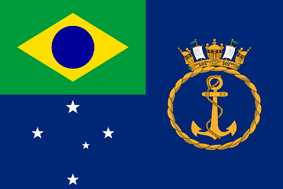
Brazilian navy ensign.
Nevertheless, the two countries did not want a war. The United States knew that Brazil still had greater military capabilities and it would not be as easy to handle like Spain. On the other hand, Brazil recognized that any conflict with the United States would cause a great loss to Brazil and even influence over the Caribbean was not worth such costly and uncertain victory. Also, by the time, the United States already had a bigger population than Brazil and was rapidly growing in industrial might.
The two countries then agreed to an unofficial agreement that became known as the Continental Compromise. The American continent was divided into two spheres of influence: Central America and the Caribbean under the American sphere, and South America under the Brazilian sphere.
The Venezuelan crisis of 1902–03 saw Brazil and the USA allying for the first time against European powers. The crisis was a naval blockade imposed against Venezuela by Great Britain, Germany and Italy over President Cipriano Castro's refusal to pay foreign debts and damages suffered by European citizens in the Venezuelan civil war. Castro assumed that the Brazilian claims of influence over South America, as well as the United States' Monroe Doctrine, would lead them both to intervene in order to prevent European military intervention, but at the time president Theodore Roosevelt and the Department of State saw the Doctrine as concerning European seizure of territory, rather than intervention per se and Brazil had their share of the Venezuelan debt too. With prior promises that no such seizure would occur, Brazil and the US allowed the action to go ahead without objection. The blockade saw Venezuela's small navy quickly disabled, but Castro refused to give in, and instead agreed in principle to submit some of the claims to international arbitration, which he had previously rejected. Germany initially objected to this, particularly as it felt some claims should be accepted by Venezuela without arbitration.
President Roosevelt and Chancellor Pillar forced the Germans to back down by sending their own larger fleets under Admirals George Dewey and Marcelo Amorim and threatening war if the Germans landed. With Castro failing to back down, US and Brazilian pressure and increasingly negative British and American press reaction to the affair, the blockading nations agreed to a compromise, but maintained the blockade during negotiations over the details. This led to the signing of an agreement on 13 February 1903 which saw the blockade lifted, and Venezuela commit 30% of its customs duties to settling claims. When the Permanent Court of Arbitration in The Hague subsequently awarded preferential treatment to the blockading powers against the claims of other nations, the US and Brazil feared this would encourage future European intervention. The episode contributed to the development of the Roosevelt Corollary to the Monroe Doctrine, asserting a right of the United States to intervene to "stabilize" the economic affairs of small states in the Caribbean and Central America if they were unable to pay their international debts, in order to preclude European intervention to do so. It also made the US more daring to intervene in South America despite the Continental Compromise, leading to the Canal Crisis.
The Canal Crisis was the last major diplomatic conflict between the United States and Brazil, which started over Panamanian Independence. A canal in the isthmus was envisioned since the times of Spanish colonialism. In Brazil, the idea was controversial, as it would harm trade passing through the traditional route through the tip of South America and, by extension, the provinces of Patagonia and New Scandinavia. On the other hand, the Brazilian government wanted a safer, faster route to the eastern coast in Ecuador. In 1850, the privately-owned Companhia da Ferrovia do Istmo (COFI) built the Panama Railroad, which connected the Atlantic to the Pacific. Brazil already had interests in the region since the Great Latin American War, after which Brazil acquired a Pacific coast with the cession of Ecuador. In 1850, when the COFI built the Panama Railroad, which allowed Brazil to reach its eastern coast easier. This overland link became a vital piece of Western Hemisphere infrastructure, greatly facilitating trade, and gained importance to the United States with the California Gold Rush, which fueled extended American interest in the region.
At this time, the US President and the US Senate were interested in establishing a canal across the isthmus, with some favoring a canal across Nicaragua and others advocating for purchasing the Franco-Brazilian enterprise in Panama.
Putting its faith on the same genius that built the Suez Canal decades early, a Brazilian-French venture tried to build a canal between 1881-1894. The first attempt to construct a canal through what was then Colombia's province of Panama began on January 1, 1881. The project was inspired by the diplomat Ferdinand de Lesseps, who were able to raise considerable funds in France as a result of the huge profits generated by his successful construction of the Suez Canal. Although the Panama Canal needed to be only 40 percent as long as the Suez Canal, it was much more of an engineering challenge due to the combination of tropical rain forests, debilitating climate, the need for canal locks, and the lack of any ancient route to follow. As such, Lesseps also sought the Brazilian government to invest in the enterprise, leading to the subsequent creation of a Franco-Brazilian Panama Canal Company. The project was a disaster, however, losing great sums of Brazilian and French capital and manpower. Its catastrophic failure led the Brazilian and French governments and investors to withdraw their funding. In addition, the completion of the Trans-Andean Railway in 1889, which connected the Port of Iquitos in the western Amazon to Quito and Guayaquil and improved the region's connection to the rest of the country, contributed to the dwindling Brazilian interest in such expensive and, seemingly, impossible venture. In 1902, the project is bought by the US.
On 22 January 1903, the Hay-Herrán Treaty was signed by US Secretary of State John M. Hay, and the Colombian charge, Dr. Tomás Herrán. For ten million USD and an annual payment, the treaty would have granted the United States a renewable lease in perpetuity on the land proposed for the canal. The treaty was ratified by the US Senate on March 14, 1903, but the Colombian Senate did not ratify it. Bunau-Varilla told President Theodore Roosevelt and Hay about the possibility of a Panamanian independence revolt, and hoped that the United States would support the rebels with troops and money. Roosevelt changed tactics, partly based on the Mallarino-Bidlack Treaty of 1846, and actively supported the separation of Panama from Colombia and, shortly after recognizing Panama, signed a treaty with the new Panamanian government on similar terms to the Hay-Herrán Treaty.
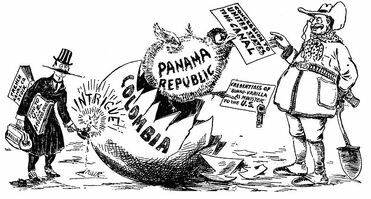
Satiric cartoon about the American intervention in Panama, 1903.
On November 2nd, 1903, American warships blockaded the sea routes that could be used by any Colombian troops to go forth to quell the rebellion. Panama declared its independence on November 3rd, 1903. The United States quickly recognized the new nation. On 6 November 1903, Philippe Bunau-Varilla, as Ambassador of Panama to the United States, signed the Hay-Bunau-Varilla Treaty, granting the United States rights to build and indefinitely administer and defend the Panama Canal Zone. This is sometimes misinterpreted as the "99-year lease" because of misleading wording included in Article 22 of the treaty. Almost immediately, the treaty was condemned by many Panamanians as a violation of their country's national sovereignty. This would become a contentious diplomatic issue between Colombia, Panama and the United States.
On the other hand, Brazil saw it as a violation of the Colombian sovereignty and did not approve such American intervention within the Brazilian sphere of influence. In telegraphic correspondence, the Brazilian government required the US government to withdraw the blockade of Colombia unless they wanted a war on their hands. While the odds of a quick war heavily weighted in favor Brazil, a military conflict would be disastrous for both sides, and Brazil could be defeated in a longer-lasting war. As such, Brazil hoped that the United States would accept to negotiate from a weaker diplomatic position.
The United States did not expect such a reaction. Brazil's hegemony in South America was somewhat lax, as it had ignored South American affairs in favor of its colonial empire and position among the European powers for such long time, as well as had sided with the United States in the Venezuela Crisis. The Continental Compromise was the only claim that Brazil had over South America as its sphere of influence. The United States also feared that a public repudiation of Panamanian independence by Brazil would attract other European powers to the conflict and make it difficult to build the canal. Brazil claimed that Panama was part of Colombia, a South American sovereign nation and therefore part of the Brazilian sphere of influence. On the other hand, the United States claimed that Panama was part of Central America and therefore in the American sphere of influence.
After negotiations with the Brazilian Ambassador Marcos Buarque de Vaz, in Washington, he proposed the Vaz-Hunter Treaty, signed two weeks later by the two governments. By the treaty, Brazil recognized Panamanian independence and would not interfere with American interests related to the isthmus, as well as recognizing American sovereignty over the Canal Zone. In return, the United States would give Brazil the right to navigate freely through the canal while under American administration.
Imperial expansion in Africa and the Middle East[]
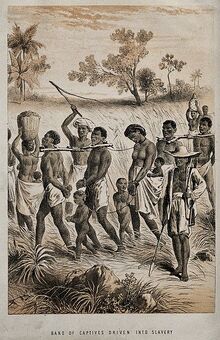
Group of men, children, and women being taken to a slave market.
During the colonial period, the Brazilian colonization of Africa was made mainly by two different groups: the slave traders, who claimed land for Portugal, and the COU.
Portugal already had influence over much of the African coast during the 16th century and slave trade was the main source of profit to the Portuguese in the region. Brazil was a big market for them, but the Portuguese-born had the monopoly over the Brazilian slave market, what led the Brazilian slave traders to look for other markets, like Hispanic America. By the dawn of the 20th century, Brazil had control over three African territorial masses, Dahomey, Madagascar and the so-called "Brazilian Strip", which was formed by the colonies of Angola, Northern and Southern Zambesias, Nyassaland and Mozambique.
By 1840, Western powers had established small trading posts along the coast, but they seldom moved inland, preferring to stay near the sea and mainly just used the continent for trade. Large parts of the continent were essentially uninhabitable for Europeans because of the high mortality rates from diseases such as malaria, which would be overcome only with the discovery of quinine in 1820. In the middle decades of the 19th century, Western explorers had mapped areas of East Africa and Central Africa.
Even as late as the 1870s, Western states controlled only over ten percent of the African continent, with all their territories located near the coast. The most important holdings were Angola and Mozambique, held by Brazil; the Cape Colony, held by the United Kingdom; and Algeria, held by France. By 1914, only Ethiopia and Liberia remained independent of Western control.
| Technological advances facilitated Western expansion overseas. Industrialisation brought about rapid advancements in transportation and communication, especially in the forms of steamships, railways and telegraphs. Medical advances also played an important role, especially medicines for tropical diseases. The development of quinine, an effective treatment for malaria, made vast expanses of the tropics more accessible for Europeans.
In 1820, the substance quinine was isolate by chemist Vitorio Santos in Manaus from the bark of the cinchona plant. Still in he 17th century, the Luso-Brazilian settlers had learned from the Manowans and other indigenous tribes how to use the bark of the Cinchona tree (a source of quinine) to treat fevers and malaria. It had allowed the Portuguese a greater penetration on tropical environments. The isolated substance was monopolized by Brazil for a time, allowing Brazilian explorers to start penetrating the tropical regions of Africa before other Europeans and, even decades later in the 1880s, Brazil still controled a large portion of the world market. Quinine played a significant role in the colonization of Africa by Europeans. The availability of quinine for treatment had been said to be the prime reason Africa ceased to be known as the "white man's grave". A historian said, "it was quinine's efficacy that gave colonists fresh opportunities to swarm into the Gold Coast, Nigeria and other parts of west Africa". To maintain their monopoly on cinchona bark, Brazil outlawed the export of cinchona seeds and saplings and pressured Peru and surrounding countries to do the same in the early 19th century. The Dutch government persisted in its attempts to smuggle the seeds, and by the late 19th century the Dutch grew the plants in Indonesian plantations, disrupting the Brazilian monopoly. Soon they became the main suppliers of the tree. In 1913 they set up the Kina Bureau, a cartel of cinchona producers charged with controlling price and production. By the 1930s Dutch plantations in Java were producing 22 million pounds of cinchona bark, or 77% of the world's quinine production. U.S. and Brazilian attempts to prosecute the Kina Bureau proved unsuccessful. During World War II, Allied powers would be cut off from their supply of quinine when Germany conquered the Netherlands, and Japan controlled the Philippines and Indonesia. Brazil was well supplied from its own plantations, but was not able to expand production to supply their allies, as decades of Dutch competition led to the shrinking of the Brazilian quinine industry which only kept supplying the Brazilian empire. The US had obtained four million cinchona seeds from the Philippines and began operating cinchona plantations in Costa Rica. Additionally, they began harvesting wild cinchona bark during the Cinchona Missions. Such supplies came too late. Tens of thousands of US troops in Africa and the South Pacific died of malaria due to the lack of quinine. Despite controlling the supply, the Japanese did not make effective use of quinine, and thousands of Japanese troops in the southwest Pacific died as a result. The development of new antimalarial drugs spurred the World Health Organization in 1955 to attempt a global malaria eradication program. This was successful in Brazil, the US and Egypt but ultimately failed elsewhere. Efforts to control malaria are still continuing, with the development of drug-resistant parasites presenting increasingly difficult problems. In 2010, Brazil started distributing an effective malaria vaccine that had been in development for decades and was finally finished. |
|---|
With Brazil being a more multi-ethnic society than the other imperialist powers (including the United States, where non-White people had no power), Brazilian imperialism had almost to none racially chauvinistic aspects but cultural chauvinism instead. The official narrative was that natives were not biologicaly inferior, i.e., not in any inherent quality, but culturaly so. Though this narrative integrated non-White Brazilians into the imperial narrative, and even absorbed some of their cultural practices over time, as well as facilitating Brazil's cultural assimilation efforts in the colonies, it was ultimately as much of an instrument of brutal colonialism as with all other European powers. This worldview was similar to France's doctrine of the civilizing mission, with and active effort to spread the Portuguese language and Brazilian culture, being used as justifications for many of the brutal practices that came with the Brazilian colonial project. Populations that reached the arbitrarily defined level of assimilation sought by the Brazilian authorities were granted full citizenship rights. Despite itself being a largely unsettled immigration-driven country, Brazil sent a large number of settlers to its empire, with estimates of over 5 million people being sent to settle the colonies between 1600 and 1880 . Those populations have mostly acclimated well to their new homes, becoming important minority groups and, eventually, evolving into their own, defined ethnic groups within the context of their adopted countries.
Brazilian Dahomey
In 1630, the COU had control over much of the coast of Dahomey. In alliance with Dahomey's kings, the COU supplied the kingdom with weapons and manufactures in exchange for gold and other resources. Still, Dahomey remained independent for a long time. The kingdom was known for its militaristic culture and traditions. Young boys were often apprenticed to older soldiers, and taught the kingdom's military customs until they were old enough to join the army. Dahomey was also famous for instituting an elite female soldier troop, called Ahosi, and known by many Europeans as the Dahomean Amazons. This emphasis on military preparation and achievement earned Dahomey the nickname of "Black Sparta" from Brazilian and European observers and 19th century explorers like Sir Richard Burton.
After 1835, the Brazilian government abolished the slave trade and arrested anyone who tried to trade slaves in the region, ending one of the main profit sources of the Dahomean elites. In addition, it began to send expeditions to the interior of the kingdom, leading to many diplomatic conflicts with the Dahomean government. The Brazilian takeover and colonization of the Kingdom of Dahomey began in 1872. In the Scramble for Africa in 1884, Dahomey was recognized as a Brazilian protectorate, but the aim of the Dahomean king, Béhanzin, to free his kingdom from the Brazilian interference led to the Béhanzin Uprising in 1887, which was brutally suppressed by the Brazilian Army. After the conflict, Béhanzin was forced to renounce and to exile. The First Brazilian-Dahomean War in 1890 further weakened the kingdom. The Second Brazilian-Dahomean War resulted in it becoming the colony of Brazilian Dahomey.
Under the Brazilians, a port was constructed at Cotonou, and railroads were built. School facilities were expanded by Christian missions. Brazil imposed a new economic reality to the people of the region, using their cheap labor to produce raw materials to the Brazilian industry. Cotton and cacau beans became its largest exports, quickly supplanting the production of these same crops in the Brazilian Northeast. In 1946, Dahomey became an overseas territory with its own parliament and representation in the Brazilian national assembly. On 1 August 1960, the Republic of Dahomey (present-day Benin) gained full independence from Brazil.
Madagascar
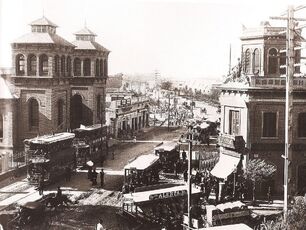
City of Porto Corso in 1900.
By 1630, the COU founded the city of Porto Corso and began to colonize the island of Madagascar. By the end of the 16th century, Madagascar was ruled by a fragmented range of socio-political alliances, though the Merina people of the highlands were the most powerful among them. In 1675, the Merina king, Andriamasinavalona signed a treaty with the COU, giving the Merina access to an endless stream of Western-made weaponry. In 1692, Andriamasinavalona had managed to unite all of the other tribes in the island under his rule either through war or diplomacy. Andriamasinavalona established a system to collect tribute from the other tribes in the island, funneling it to his seat of Antananarivo (present-day Tana). Meanwhile, the COU achieved to colonize the island's southwest, calling the colony Libertatia.
The death of the next Merina king, Andriantsimitoviaminandriandrazaka, in 1730, would cause the collapse of the Merina Kingdom and a brutal 11-year long civil war settled on the island, killing around 40% of the Malagasy population, mostly males. By the end of the war, there were no native political entities capable of taking control of the island, with the Merina king in Antananarivo retaining only authority over the capital. People from the areas outside COU's control had been joining Libertatia in order to have access to COU trade and resources. Aware of the power vaccuum present, the COU would expand to the interior, assimilating the many smaller kingdoms that formed on the wake of the civil was. As of 1752, the island was under the COU's authority as the Colony of Malagasia and Libertatia. With the fall of COU in 1835, Madagascar became a directly controlled colony of the Brazil, being one of the most important colonies in the empire. Thousands of Brazilians went to Madagascar during the 18th and 19th century, mixing their culture with the natives, bringing new crops and new technology. By 1870, the population was largely "Brazilianized" and demanding for representation and autonomy as the Brazilians they believed to be. The riots of Porto Corso and Toamasina in 1872 caused the Brazilian government to chage dramatically its policy in the colonies. The new policy, called "One Empire, Many Countries" led the Brazilian Congress to raise Madagascar to the status of first Imperial Realm in 1875.
Angola
After Independence, Brazil took the biggest Portuguese territories in Africa, Angola and Moçambique. However, the former Portuguese, now Brazilian direct control over the regions was limited to the coastline, Portugal had neither the intention nor the means to carry out a large scale territorial occupation and colonization. In the interior, many tribes and kingdoms lived free from the Brazilian interests.
In Angola, the development of the interior began in the 1820s with the financing of coal mining, but became a real plan of colonization only in the late 1860s. Brazilian investment fostered mining, railways, and agriculture based on various forced-labour and voluntary labour systems. Full Brazilian administrative control of the interior was not established until the the late 1890s. Portugal had a minimal presence in Angola for nearly three hundred years, but the Brazilian colonization was more intensive. Between 1830 and 1900, about 2 million Brazilians went to colonize Angola. Brazil created a whole colonial government which, allied to the Brazilian "civilizing mission" ideals, fostered education in Brazilian Portuguese and the expansion of Brazilian culture. Differently of the other Brazilian colonies in Africa, except for Madagascar, Brazil was quite efficient in "Brazilianizing" the Angolan peoples. The Portuguese language, Western/Brazilian clothing and Christianity managed to spread into the region. Still similar to what happened in Madagascar, the Brazilians were too successful in unifying the region under the Brazilian flag. The Angolans, mostly, developed a sort of Brazilian yet nativist national identity. They saw themselves as Brazilians, but also something else, as Angolans. After many small conflicts within the colony, the population demanding for political voice, and the loses of World War I, Brazil raised Angola to the status of Imperial Realm in 1920.
Brazilian East Africa (Mozambique)
With Mozambique, the situation was not good. Differently from Angola, Mozambique was almost ignored by the Brazilians. The developent of the Mozambican interior just started at the 1890s, with Brazilian-financed mines and railways. At the 1900s, the main piece of infrastructure in the colony was the Indian-Atlantic Railway, which linked Angola and Moçambique through the Zambesias.
The Zambesias and Nyassaland
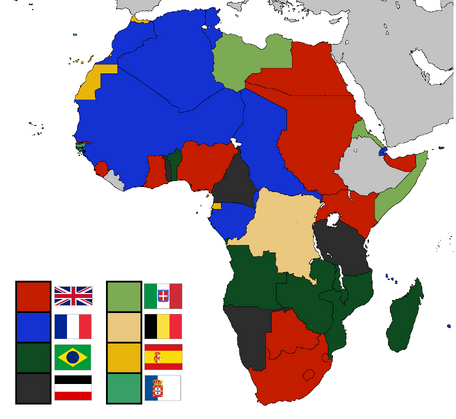
The Scramble for Africa.
From the colonization of Angola, the Brazilians began to expand to the interior of the continent. By the 1870s, the region which became known as Zambesia, from the Zambezi river, was explored by the colonist Armando Batista and the Brazilian East Africa Company. In 1882, he obtained a concession for mining rights from King Lobengula of the Ndebele peoples. He presented this concession to persuade the government of Brazil to grant a royal charter to the company over Matabeleland (Terra Matabele in Portuguese), and its subject states such as Mashonaland (Terra Mashona) as well. The Brazilians built many forts through the Zambezi river. During the Congress of Berlin in 1884, which formalized the Scramble of Africa, the British interests in the region led to a diplomatic conflict which became known as the "Lusaka Crisis". The British, who wanted to build a railway to link Cape Town to Cairo, claimed the region, while the Brazilian claimed its control by the construction of forts and the terra nullius claim. The two nations settled an agreement, the region would be under the Brazilian control, but the British could build their railway, which would be considered a demilitarized zone two kilometers to east and to west. However, the British were never able to build their railway. With new weapons, like Maxim guns, the Brazilian were able take control of the region in the 1890s. The region were divided into three colonies, Northern Zambesia, Southern Zambesia and Nyassaland (Terra Nyassa).
Imperial expansion in Asia and the Pacific[]
Brazilian South Arabia (Yemen)
Socotra
United Arab Emirates
Brazilian Burma (Myanmar)
The 18th century saw Burmese rulers, whose country had not previously been of particular interest to Western traders, seek to maintain their traditional influence in the western areas of Assam, Manipur and Arakan. Pressing them, however, was the Overseas Trading Company (COU), which was expanding its interests eastwards over the same territory. Over the next thirty years, diplomacy, raids, treaties and compromises continued until, after three Brazilian-Burmese Wars (1824–1877), Brazil proclaimed control over most of Burma. Brazilian rule brought social, economic, cultural and administrative changes.
Conflict began between Burma and the Brazilians when the Konbaung Dynasty tried to expand west, close to Brazilian-held Chittagong in Bengal. After Burma's defeat of the Kingdom of Arakan in 1784–1785, the Burmese had reached the border with Brazilian-held COU territory. In 1823, Burmese forces again crossed the frontier. This led to the First Brazilian-Burmese War (1824–26). The Brazilians dispatched a large seaborne expedition that took Rangoon without a fight in 1824. In Danuphyu, south of Ava, the Burmese general Maha Bandula was killed and his armies routed. Burma was forced to concede and Assam and Manipur in the northeast and Lower Burma in the south were annexed by the COU, which obtained access to the teak, oil, and rubies from their newly conquered territories as a result and the Burmese kingdom became landlocked. Those territories came under direct Brazilian rule after the nationalization and subsequent liquidation of the COU in 1835.
In October 1852, the Burmese king Pagan Min initiated the Second Brazilian-Burmese War by organizing a series of attacks in Lower Burma with the intention of driving off the Brazilians. As, at the time, Brazil and Great Britain were involved in the the Anglo-Brazilian War (1849-1853), Pagan Min believed he could force the Brazilians' hand while they fought the British. Unfortunately for his plans, Brazil and Great Britain were already at the negotiating table, as Great Britain needed to prepare for possible war with Russia, which would realize the next year with the Crimean War (1853-1856). Brazil and Great Britain soon declared an armistice and defined their shared borders in India, with Brazil ceding Assam to the British. This allowed Brazil to respond swiftly to the Burmese attacks. As the Brazilian troops marched north, threatening the Burmese court, Pagan Min would be deposed by his brother, who would be enthroned King Mindon Min. The new Burmese king managed to prevent the Brazilians from continuing their expasion north by agreeing to a number of humiliating concessions which would effectivelly turn Burma into a Brazilian protectorate, his power and the imediate safety of his people, however, was secured.
In the subsequent two decades, King Mindon Min would rule Upper Burma, the still unoccupied part of the country, trying to adjust to the thrust of imperialism. He enacted administrative reforms and made Burma more receptive to foreign interests. In 1877, Mindon Min's ministers would lead a revolt against Brazilian influence, initiating the Third Brazilian-Burmese War (1877-1878), which lasted less than a year. Brazilians troops entered Mandalay on 28 August 1878. Thus, after three wars and sizeable territorial losses by Burma, the Brazil finally occupied the entirety of present-day Myanmar, turning the territory into the Colony of Brazilian Burma in 1876.
With the fall of Mandalay, all of Burma came under Brazilian rule. Throughout the colonial era, many Bengalis arrived as soldiers, civil servants, construction workers and traders and, along with the Brasilico-Burmese community, dominated commercial and civil life in Burma. Rangoon became the capital of Brazilian Burma and an important port between Dhaka and Singapore.
The Brazilians controlled their new province through direct rule, making many changes to the previous governmental structure. The monarchy was abolished, King Mindon Min sent into exile, and religion and state were separated. This was particularly harmful, because the Buddhist monks, collectively known as the Sangha, were strongly dependent on the sponsorship of the monarchy. At the same time, the monarchy was given legitimacy by the Sangha, and monks as representatives of Buddhism gave the public the opportunity to understand national politics to a greater degree.
Another way in which the Brazilians controlled their new colony directly was through their implementation of a secular education system. The colonial Government of Burma, which was given control of the new colony, founded secular schools, teaching in both Portuguese and Burmese, while also encouraging Christian missionaries to visit and found schools. In both of these types of schools, Buddhism and traditional Burmese culture was frowned upon in an attempt to rid the Burmese people of a cultural unity separate from the Brazilian, though they were far from successful compared to Bengal.
The traditional Burmese economy was one of redistribution with the prices of the most important commodities were set by the state. For the majority of the population, trade itself was not as important as self-sufficient agriculture, but the country's position on major trade routes from India to China meant that it did gain a significant amount of money from facilitating foreign trade. With the arrival of the COU, the Burmese economy became tied to global market forces and was forced to become a part of the colonial export economy.
Burma's annexation ushered in a new period of economic growth. The economic nature of society also changed dramatically. The Brazilians began exploiting the rich soil of the land around the Irrawaddy delta and cleared away the dense mangrove forests. Rice, which was in high demand in Europe and the Americas, especially after the building of the Suez Canal in 1869, was the main crop grown in and exported out of Burma. To increase the production of rice, many Burmese migrated from the northern heartland to the delta, shifting the population concentration and changing the basis of wealth and power. However, to prepare the new land for cultivation, farmers borrowed money from Brazilian banks, who offered mortgage loans, but foreclosed on them quickly, if the borrowers defaulted. Burma also produced precious stones such as rubies, sapphires, pearls, and jade. Rubies were the biggest earner and the region was the biggest producer in the Brazilian Empire, supplying Brazilian jewellery companies such as Melgaço.
At the same time, thousands of Bengali laborers migrated to Burma (Burmese Indians) and, because of their willingness to work for less money, quickly displaced Burmese farmers. Burmese villagers, unemployed and lost in a disintegrating society, sometimes took to petty theft and robbery and were soon characterized by the Brazilians as lazy and undisciplined. The level of dysfunction in Burmese society was revealed by the dramatic rise in homicides.
With this quickly growing economy came industrialisation to a certain degree, with a railway being built throughout the valley of the Irrawaddy, and hundreds of steamboats traveling along the river. All of these modes of transportation were owned by the Brazilians, however. Thus, although the balance of trade was in favour of Brazilian Burma, the society was changed so fundamentally that many people did not gain from the rapidly growing economy.
While the economy in Burma grew, most of the power and wealth remained in the hands of several Brazilian firms and migrants from Bengal. The civil service was largely staffed by Brasilico-Burmese and Bengalis, and the ethnic Burmese were excluded almost entirely from military service, which was staffed primarily with Bengalis, Brasilico-Burmese, Karens and other Burmese minority groups. A Brazilian General Hospital Burmah was set up in Rangoon, under the direction in early 1887 of Patrício Dante. Though the country prospered, the Burmese people largely failed to reap the rewards.
Under Brazilian administration, Burma was the second-wealthiest country in Southeast Asia. It had been the world's largest exporter of rice. It also had a wealth of natural and labour resources. Brazilian Burma began exporting crude oil in 1853, making it one of the earliest petroleum producers in the world. It produced 75% of the world's teak and had a highly literate population. The wealth was however, mainly concentrated in the hands of Brazilians. In the 1930s, agricultural production fell dramatically as international rice prices declined, and did not recover for several decades. Plans to broaden the new prosperity and extend the reach of modern civilisation were halted by the outbreak of the Second World War. Burmese resentment was strong and was vented in violent riots that paralysed Yangon (Rangoon) on occasion all the way from the 1870s to the 1930s.
During the Japanese invasion of the area in World War II, the Brazilian military was not able to defend the country despite it having one of the largest concentrations of military assets in the Brazilian Empire. Burma was by far the most costly theater of the war for Brazil, with the loss of hundreds of thousands of men and military assets. The Japanese destroyed the major government buildings, oil wells and mines for tungsten, tin, lead and silver in their bombardment missions and the Fall of Burma cleared the path for a possible invasion of East Bengal and India.
Brazilian Bengal (Bangladesh)
Between 1570 and 1700, the COU's presence in India was limited to the Portuguese entrepôts in the subcontinent, small ports in the Bay of Bengal, and alliances with some native states in the Eastern half of Bengal. After decades of competition with the British East India Company (EIC) in the region, both companies saw themselves in the same side during the Seven Years' War. In 1756, the EIC-COU alliance acted heavily in the war's Indian theatre, which led to the gradual suppression of French influence in India by the British East India Company and the COU. After the Battle of Plassey in 1757, the EIC and the COU defeated the Nawab of Bengal, effectively ending Bengali independence and dividing Bengal into a Brazilian and a British spheres of influence. Due to different strategies, the EIC and the COU would expand at different rates through India. While the COU chose to take direct control of its share Bengal, essentially forcing itself to spend huge amounts of resources in the region and hampering its expansion capacity, the EIC kept the Nawab of Bengal as the official ruler of its share of the region. The EIC would expand and rule India largely through puppet native rulers without changing much of the state structures in the region. Over the next century after the Battle of Plassey, the EIC would end up ruling over the entirety of India either directly or indirectly, while the COU would be limited to its share of Bengal. After the joint EIC-COU army defeated the Mughals at the Battle of Buxar in 1764, the subsequent Treaty of Allahabad gave both Diwani rights over the territories they controlled.
In 1765, any remaining nominal existence of the system of Nizamat (local rule) is abolished when the COU takes complete control of East Bengal under the Bengal Department, with Dhaka, now the capital city of East Bengal, as the commercial and administrative center for the COU-held territories in South Asia. The development of East Bengal was thereafter, however, limited to agriculture. The administrative infrastructure of the late 18th and 19th centuries reinforced East Bengal's function as a primary agricultural producer (chiefly of rice, tea, teak, cotton, sugar cane and jute) for processors and traders from around Asia and beyond. The COU allied to many Christian missionary orders, exempting them from taxation and allowing them to establish thousands of schools and colonies throughout East Bengal in order to build a more relatable identity in the Bengali people, one that was based on Christianity and the Portuguese language. Christian missionaries in East Bengal did not only increase literacy but also engaged in social activism, such as fighting against prostitution, championing the right of widowed women to remarry, and trying to stop early marriages for women.
In 1835, after the liquidation of the COU, the entire region was put under direct authority of the Brazilian government and the Bengal Department was converted into the Colony of Brazilian Bengal. During the Anglo-Brazilian War (1848-1853), East Bengal was one of the main theatres, with 50,000 Bengalis and Brazilians fighting for the Brazilian government in the region. The subsequent Peace of Geneva would finally define the borders between Brazilian Bengal and British India and end the hostility between the two powers in the region
The Revolt of 1857 in neighbouring British India affected East Bengal as well, leading to many revolts throughout the colony and violent suppression by the Brazilians. Education was of great importance to the Brazilian imperial ambitions and heavily subsidised by the Brazilian government, who imposed public education in Portuguese to the population, suppressing the distribution of Bengali texts and news in favor of Portuguese. In 1860, Brazil introduced and imposed the Alves system, a romanisation of the Bengali language that intended to westernize it and distance the Eastern Bengalis from those in India (allied with the suppression of the native Bangla script in the region, this system and the influence of Portuguese was responsible for the great difference between the Dhaka dialect of Bengali and those from India that stands to the present times, as well as the low number of Bangladeshis who know how to read and write in this alphabet). Universities in Dhaka and other large cities were established in 1858. By 1880 some 60,000 Bengalis had matriculated, chiefly in the liberal arts or law. About a third entered public administration, and another third became lawyers. The result was a very well educated professional state bureaucracy. By 1887 of 7,000 mid-level civil services appointments, 27% by Muslims, 22% were held by Hindus, 22% by Christians, and 29% by Brazilians. The curriculum followed classical Brazilian standards, European and Brazilian literature, and Western history. Nevertheless, by the 1920s the student bodies had become hotbeds of Communism.
From the 1850s onwards, the colonial government invested heavily in infrastructure, including canals and irrigation systems in addition to railways, telegraphy, roads and ports. East Bengal saw rapid development of all those technologies. Railways, roads, canals, and bridges were rapidly built in East Bengal and telegraph links equally rapidly established in order that raw materials East Bengal's hinterland could be transported more efficiently to ports, such as Dhaka, for subsequent export to Brazil. Likewise, finished goods from Brazil, were transported back, just as efficiently, for sale in the burgeoning East Bengali markets.
Brazilian East Bengal built a modern railway system in the late 19th century, which connected the entire colony. At first the railways were privately owned and operated. They were run by Brazilian administrators, engineers and craftsmen. At first, only the unskilled workers were Bengalis, later most of the railway construction was done by Bengali companies supervised by British engineers.
The colonial government encouraged new railway companies backed by private investors under a scheme that would provide land and guarantee an annual return of up to 5% during the initial years of operation. The companies were to build and operate the lines under a 99-year lease, with the government having the option to buy them earlier. Between 1853 and 1897, the main population centers of the colony were connected by railroad. The railways were used to transport troops and grain to the ports of Dhaka and Chittagong en route to Brazil, Singapore, and Jeju.
Eastern Bengal one of the most fertile lands in the Brazilian Empire. The eastern Bengal delta was the rice basket of the Indian subcontinent. It produced 70% of the world's jute, and dominated supply in the once thriving global jute trade. The Port of Chittagong began to flourish in international trade, and was connected to its hinterland by the United Bengal Railway. Shipbuilding was a major activity in coastal Bengal, and catered to the Brazilian naval and merchant fleets. Dyeing industries were set up in several districts, particularly in Dhaka.
Brazilian Ceylon
Weihai
Brazilian East Indies and Singapore
Brazilians have been present in the East Indies since the 16th century, often being part of Portuguese expeditions. Its presence in the archipelago, however, would limited to small ports and factories until the mid-18th century.
In 1736, the Brazilians established a presence in Malaya, when the Sultan of Kedah leased Penang Island to the Overseas Trading Company (COU). The Brazilians obtained the town of Singapore in 1761, and in 1766 took control of Melaka following the Brazilic-Dutch Treaty. By 1769, the COU directly controlled Penang, Malacca, Dinding, and Singapore under the Strait Department. By 1810, the states of Pahang, Selangor, Perak, and Negeri Sembilan had Brazilian residents appointed to advise the Malay rulers, to whom the rulers were bound to defer to by treaty. The remaining five states in the peninsula, while not directly under Brazilian rule, also accepted Brazilian advisers around 1820.
The COU controlled Malaya through direct conquest as well as the vassalisation of native empires, such as the Johor Sultanate and the Sultanate of Aceh. Aceh would survive through Brazilian domination, surviving until the 19th century after changing loyalty to Britain peacefully in the aftermath of the Anglo-Brazilian War. Johor, on the other hand, would see the transfer of influence from Brazil to Britain in 1853 as a chance to fight for independence, but would be ultimately crushed by the British in 1855.
Development on the Malay Peninsula and Borneo were generally separate until the 19th century. With the whole Malayan Peninsula under Brazilian direct control or protection, the end of the COU in 1835 transferred all of its rights to the Brazilian government. The Malayan states recognized this change, except for Perak, which was forced to accept the terms after the Brazilian Intervention in Malaya in 1836. The entire Malayan Peninsula would be called Brazilian Malaya, divided into the directly controlled Strait Colonies (Penang, Dinding, Malacca, and Singapore) and the protectorates.
In 1683, the COU helped end the Brunei Civil War (1660-1673) and put Sultan Muhyiddin in the throne. The sultan was heavily influenced by the COU, turning the Sultanate into an effective protectorate. In 1842, this level of COU influence would culminate with large parts of the Sultanate's territory being put under direct Brazilian control after Brazilian troops quelled a local rebellion, thus reducing the Brunei to its present territory.
After the Anglo-Brazilian War (1848-1853), all Brazilian rights and holdings in the Malay peninsula and Borneo were ceded to the British, except for Singapore, which had a sizeable Brazilian population. The protectorates over Johor, Perak, Selangor, Pehang, and Brunei, as well as the directly-owned territories of the Strait Colonies (except Singapore) and North Bornwo and Sarawak were ceded to the British, effectively ending the Brazilian East Indies. The treaty also provided that Singapore would be perpetualy a free port for British ships and trade and provided for the settlement of British subjects in its territory. This would largely impact the city. English would become the most important language of trade even under Brazilian rule, with Portuguese becoming less of a lingua franca and just the native language of the now distinct Brazilian Singaporeans. As of present day, Portuguese is one of the four "official languages" of Singapore and, though it is the only of the four to be rather commonly spoken as a second language by the other Singaporean ethnic groups, English is the lingua franca of the nation, being constitutionally defined the "common language" of the Singaporean people
After the First World War, the Brazilians built the large Singapore Naval Base as part of the defensive Singapore strategy. Originally announced in 1923, the construction of the base proceeded slowly until the Japanese invasion of Manchurian 1931. When completed in 1939, at the very large cost of 500 million USD, it boasted what was then the largest drydocks the world, the third-largest floating dock, and having enough fuel tanks to support the entire Brazilian navy for six months. It was defended by heavy 15-inch naval guns stationed at Fort Siloso, Fort Cana and Labrador, as well as a Brazilian Air Force airfield at Tengah Air Base. However, despite the powerful fleet stationed there, the most important Brazilian port in Asia, it would mean nothing. During the Second World War, the Imperial Japanese Army invaded Brazilian Malaya, culminating in the Battle of Singapore soon after. When the Brazilian force of 60,000 troops surrendered on 15 February 1942, Brazilian Chancellor Getulio Vargas called the defeat "the worst disaster and largest capitulation in Brazilian history."
Brazilian Polynesia
Imperialism in the Americas and Europe[]
Crete
Cyprus
Cadiz
Zenith
The "One Empire, Many Countries" Policy and the Imperial Realms[]
Brazilian Golden Age and the Belle Époque[]
The Coffee and Rubber Exploration[]
World War I (1914-1918)[]
Brazilian Non-Interventionist Policy[]
The European Theater[]
The African and the Middle Eastern Theater[]
The Pacific Theater[]
The Effects of the War in Brazil[]
Interwar Period[]
The Crash of 1929[]
The Interwar Isolation[]
World War II (1939-1945)[]
The European Theater[]
The Pacific Theater and the "Great Defeat"[]
Internal Effects[]
Decolonization and the Fall of the Brazilian Colonial Empire[]
Conference of Porto Corso and the transcontinental Brazil[]
The Act of Autonomy of Adamant[]
The Gradual Independence Policy[]
The War of Both Zambias[]
The Arab Nationalism and the Independence of Yemen[]
The Independence of Singapore and the Status of Weihai
Brazil in the Bipolarized World[]
Brazil within the Western Bloc[]
Brazilian Space Exploration[]
Brazilian Intelligence in the Cold War[]
Counterculture in Brazil[]
Brazilian Pop Culture[]
The Energy Crisis and the Program of Energy Transition[]
The Brazilian Ambientalism at the late 20th century[]
The 21st Century Brazil[]
Brazil's economic growth[]
The Autonomous Cities at the European Economic Zone[]
Brazilian diplomacy and conflicts[]
Peacekeeping missions[]
Brazilian innovation[]
Space exploration[]
Brazil as a potential superpower[]
Geography[]
Continental Brazil occupies a large area along the eastern coast of South America and includes much of the continent's interior. In South America, it shares land borders with Argentina and Paraguay to the southwest; Bolivia and Peru to the west; Colombia and Venezuela to the northwest; and Chile and Argentina to the north of the non-contiguous provinces of Patagonia and New Scandinavia. It shares a border with every South American country.
It also encompasses a number of overseas provinces all around the world, such as Cozumel, Zenith, Cádiz, Socotra, Jeju, and the Brazilian Polynesia. Brazil shares land borders with two countries through overseas provinces, those being Germany, through Zenith, and Spain, through Cádiz. Additionally, Brazilian territory encompasses a number of oceanic archipelagos and Islands, such as Fernando de Noronha, Rocas Atoll, Saint Peter and Paul Rocks, Trindade and Martim Vaz, Tristan da Cunha, the Galapagos Islands, Svalbard, and the Brazilian Southern Islands. Its size, relief, climate, and natural resources make Brazil geographically diverse.
Brazil is the 2nd largest country in the world, and the largest in the Americas, with a total area of 10,495,761.78 km² (4,052,436.28 sq mi). It occupies 59.0% of the territory of South America, 52.3% of Latin America, and 24.7% of both the Americas. Continental Brazil alone spans three time zones; from UTC−5 comprising the westernmost provinces, to UTC−4 in the western states, to UTC−3 in the eastern provinces (the national time). Additionaly, Overseas Brazil and the Atlantic islands span together another seven timezones.
Brazil is the longest country in the world, with its contiguous territory spanning <<4,395 km (2,731 mi)>> from north to south. Brazil is also the only country in the world that has the equator and the Tropic of Capricorn running through it. Brazilian topography is also diverse and includes hills, mountains, plains, highlands, and scrublands. Much of the terrain lies between 200 metres (660 ft) and 800 metres (2,600 ft) in elevation, except for the provinces that lie on in the Andean region, where elevations can reach thousands of meters. The main upland area occupies most of the southern half of the country. The northwestern parts of the plateau consist of broad, rolling terrain broken by low, rounded hills.
The southeastern section is more rugged, with a complex mass of ridges and mountain ranges reaching elevations of up to 1,200 metres (3,900 ft). These ranges include the Mantiqueira and Espinhaço mountains and the Serra do Mar.
In the north, the Guiana Highlands form a major drainage divide, separating rivers that flow south into the Amazon Basin from rivers that empty into the Orinoco River system, in Venezuela, to the north. The highest point in Brazil is the Mount Chimboraço at 6,267 metres (20,549.4 ft), and the lowest is the Atlantic Ocean.
Brazil has a dense and complex system of rivers and man-made navigation canals, one of the world's most extensive, with eight major drainage basins, all of which drain into the Atlantic, with smaller basins such as the Guayas and Neuquén. Major rivers include the Amazon (the world's second-longest river and the largest in terms of volume of water), the Paraná and its major tributary the Iguaçu (which includes the Iguazu Falls), the Negro, São Francisco, Shingu, Madeira, and Tapajós rivers.
Climate[]
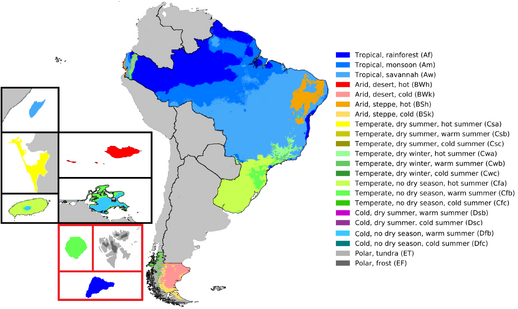
Brazil map of Köppen climate classification zones
The climate of Brazil comprises a wide range of weather conditions across a large area, varied topography, and overseas territories all around the world, but most of the country is tropical. According to the Köppen system, Brazil hosts every single climatic group: tropical, dry, temperate, continental, and polar. The different climatic conditions produce environments ranging from equatorial rainforests in the north, semiarid deserts in the northeast, and tropical savannas in central Brazil, to temperate coniferous forests in the south and subpolar forests in the far south. Many regions have starkly different microclimates.
Biomes and Biodiversity[]
Brazil has the second largest forest coverage in the world, after Russia, with 6,143,327 square kilometers of forest area (58% of the country's area), with notably 73% of the Amazon rainforest being located in Brazil
. Different ecosystems comprise Brazil's large territory, such as the Amazon rainforest (recognized as having the greatest biological diversity in the world), with the Atlantic Forest and the Cerrado, also sustaining the great biodiversity. The Sertão semi-arid region dominated the interior of the Northeast. In the South, the Araucaria pine forest grows under temperate conditions in the interior as the Pampas pastures dominate the rest of the region. The Andean ecosystem divides the Amazon from the dry, tropical steppes of the Costa Equatorial in the Northwest. In the Far South, the Patagonian dry steppes and grasslands dominate east of the Andes, while the temperate and sub-Antarctic forests of New Scandinavia dominate west of the Andes. In the overseas, the Brazilian territory has diverse climates and ecosystems. The rich wildlife of Brazil reflects the variety of natural habitats. Scientists estimate that the total number of plant and animal species in Brazil could approach four and a half million, mostly invertebrates.
Despite its present, century-long preservation efforts, much of Brazil's ecosystems were degraded from the colonial period. Farming, the founding of new cities and trade routes, and later industrialization would play a huge role in this process. The most devastated eco-region in Brazil would be the Atlantic Forest. As it spanned the most populated portion of Brazil (a large portion of the coast and the interior of the Southeast region), the Atlantic Forest suffered more pressures from human action for centuries than any other Brazilian ecosystem, to the point that 88% of the original forest habitat has been lost and replaced by human-modified landscapes including pastures, croplands, and urban areas. Still, it must be noted that Brazilians have been taking action against environmental degradation for centuries. Laws concerning the preservation of riparian forests would be passed and enforced as early as the 18th century, to control sediment and alluviation of rivers, reduce the damaging effects of flooding, stabilize stream banks, and prevent the loss rivers and canals as water sources and navigable routes.
Amazon (Equatorial rain forest)[]
About three-fourths of the entire Amazon (73%) is located in Brazil.
Cerrado (Tropical savannah)[]
Caatinga or Sertão (Tropical xeric shrublands and thorn forests)[]
Atlantic Forest (Tropical and subtropical broadleaf forest)[]
Pantanal (Tropical wetland)[]
Pampas (Subtropical steppes and pastures)[]
Andes (Alpine tundra)[]
Patagonia (Temperate and dry steppes and cold grasslands)[]
Costa Equatorial (Tropical dry steppe)[]
[]
Stubnitz (Temperate forest)[]
Caribbean Forest (Tropical Caribbean forests and grassands)[]
Jejuan Vegetation (Humid subtropical forests and wetlands)[]
Areial (Tropical deserts, steppes and savannahs)[]
Polynesian Forest (Oceanic tropical forests)[]
Gaditan Vegetation (Mediterranean vegetation)[]
Demographics[]
The Brazilian Institute of Geography and Statistics (IBGE) officially estimated the country's population to be 214,033,121 as of December 1, 2020, with the proportion of men and women of 0.96:1. Brazil is the 5th most populous nation after China, India, the USA, and Indonesia, and is one of the only developed countries, alongside the United States, where there are prospects of an increase in much of the population.
Brazil has a very diverse population; dozens of ancestry groups have more than one million members. Brancos or White Brazilians of European and Middle Eastern ancestry (mostly Portuguese, Italian, German, Spanish, and Levantine Arab), including other white Hispanics from Latin America, form the largest racial group, at 52.71% of the population. Pardos or Brazilians of mixed ancestry, be it recent or through centuries of miscegenation, constitute the nation's second-largest racial group at 29.10% of the total population. Additionaly, Negros or Black Brazilians of African ancestry constitute 12.17%, it must be noted that the term negro does not have the same offensive connotation in Portuguese as it does in English, simply meaning black. Asiáticos or Asian Brazilians, more specifically of South, Southeast, and East Asian ancestry, constitute 4.09% (the three largest Asian ethnic groups are Japanese, Bangladeshi, and Korean). Indígenas or Amerindian Brazilians, 1.43%. Polinésios or Polynesian Brazilians, 0.5%.
In 2020, there were almost 44 million immigrants and Brazilian-born children of immigrants in Brazil, accounting for 20.5% of the overall population. Intermarriage between groups of immigrants and between immigrants and native-born Brazilians is widespread. Among foreign-born people currently living in Brazil, the top five countries of birth are Argentina, Portugal, Venezuela, Angola, and Colombia.
| Historical Evolution of Brazilian Population | ||
|---|---|---|
| Manowan Kingdom (1500) | 1 million (est.) | |
| Amerindian Peoples (1500) | 2-3 million (est.) | |
| 1530 | 600.000 | - |
| 1550 | 650.000 | +8.33% |
| 1600 | 1,100,000 | +69.23% |
| 1660 | 2,700,000 | +145.45% |
| 1700 | 4,500,000 | +66.67% |
| 1770 | 7,600,000 | +68.89% |
| 1808 | 11,500,000 | +51.32% |
| 1830 | 25,717,000 | +123.63% |
| 1850 | 34,256,000 | +33.20% |
| 1870 | 40,930,478 | +19.48% |
| 1890 | 57,333,915 | +40.08% |
| 1900 | 65,438,434 | +14.14% |
| 1920 | 74,635,605 | +14.05% |
| 1940 | 85,236,315 | +14.20% |
| 1950 | 91,944,397 | +7.87% |
| 1960 | 106,119,071 | +15.47% |
| 1970 | 126,139,037 | +18.86% |
| 1980 | 145,070,865 | +15.01% |
| 1990 | 162,917,459 | +12.30% |
| 2000 | 183,477,642 | +12.62% |
| 2010 | 206,430,695 | +12.51% |
| 2020 | 223,254,796 | +8.15% |
| 2023 (est.) | 229,546,116 | +2.81% |
In 2020, 81% of the population was urban and 19% was rural. Of the urban population, 53.5% lived in the 20 largest urban agglomerations. Of the total population, 97.81% (218.4 million) lived in the continental provinces, while 2.19% (4.9 million) lived in the overseas provinces and territories.
With a birth rate of 16.6 per thousand in 2017, the second-highest in the developed world after Israel, and a net migration rate of 2.0 per thousand, its population growth rate was 0.54%. For twenty years, the total fertility rate in Brazil has grown slightly compared to much of the world. At 2.0, it's now higher than most developed countries. In order to incentivize women to have children in its highly egalitarian market, the Brazilian government provides strong support to families, such as subsidized childcare and good support of working mothers such as paid maternity leave. Schools also provide a wide range of extracurricular activities for children all day long and it is common for families who do not want to leave children in childcare to leave them with their grandparents. Work-life balance in Brazil is also more balanced, allowing parents more time for raising their children. The government position of accepting non-traditional families such as those based on non-marital cohabitation and supporting them as a legitimate form of family has been connected with a higher fertility rate. Brazil was one of the few developed countries to experience a rise in fertility rate in 2021, the so-called Lockdown Baby Boom caused by the lockdowns during the COVID-19 pandemic.
| Brazilian population by age (2020) | ||||
|---|---|---|---|---|
| Age | % | Pop. | ||
| 0-14 (Young) | 19.2% | 42,864,920 | ||
| 15-29 (Young Adult) | 21.4% | 47,776,526 | ||
| 30-44 (Adult) | 22.8% | 50,902,093 | ||
| 45-64 (Midlife) | 21.5% | 47,999,781 | ||
| 65- (Elder) | 15.1% | 33,711,476 | ||
| All | 100% | 223,254,796 | ||
The largest urban area of Brazil by population in 2020 is the São Paulo Metropolitan Area, with 20.3 million inhabitants, making it the largest in South America and second-largest of the entire American continent. Additionaly, the São Paulo Macrometropolis or Expanded Greater São Paulo is a megalopolis (though some consider it a valid interpretation of the São Paulo Metropolitan Area) that emerged through the existing process of conurbation between the metropolitan areas located around the Greater São Paulo, such as the Baixada Santista and the Greater Campinas, has more than 27 million inhabitants. Though the macrometropolis does show signs of being conurbated enough to be considered a single metropolis surrounding São Paulo, it has not been officially recognized as such. When considering only its official metropolitan area, São Paulo is the world's 11th most populous urban area, though, when considering all of its urban area as designated by the macrometropolis, it could be considered to be the 3rd most populous urban area in the world after Tokyo and Delhi and the most populous in the American continent. Following the São Paulo Metropolitan Area, the next largest urban areas in Brazil are Rio de Janeiro, with 12.6 million inhabitants, and Belo Horizonte, with 9.6 million inhabitants.
Brazil is home to overall three megalopolises. Together and added some cities and smaller metropolitan areas, the Greater Rio de Janeiro and the São Paulo Macrometropolis form the so-called Rio-Sampa Megalopolis or the Brazilian Southeastern Megalopolis, with 40.7 million inhabitants. In the Northeast, the metropolitan areas of Natal, Veraluna, and Recife, as well as the smaller cities, towns, and metropolitan areas in between, form the Zona da Mata Megalopolis or Brazilian Atlantic Megalopolis, with a population of approximately 11.1 million. Additionally, the Platine Megalopolis is a transnational megalopolis that emerged through the conurbation between the Alexandria Metropolitan Area, in Brazil, and the Buenos Aires and La Plata metropolitan areas, in Argentina, with an overall population of 22.3 million, of which 5.1 million are located in Brazil.
In general, state capitals are the largest cities in their states. Exceptions include Iconia (ME), Vitória (ES), and Blumenau (SC). There are also non-capital metropolitan areas in the states of São Paulo (Campinas, Santos and the Paraíba Valley), Minas Gerais (Steel Valley), Rio Grande do Sul (Sinos Valley), Santa Catarina (Itajaí Valley), Ecuador (Guayaquil), Petrolina (Paraíba), etc.
Brazilian cities generally rank highly on international livability measures. For instance, in 2014 Rio de Janeiro was ranked the world's first most livable city and São Paulo the fourth by the Mercer Quality of Life Survey.
| Largest urban agglomerations in Brazil 2020 IBGE report | |||||||||
|---|---|---|---|---|---|---|---|---|---|
| Rank | City name | Province | Pop. | Rank | City name | Province | Pop. | ||
 São Paulo  Rio de Janeiro |
1 | São Paulo | São Paulo | 20,277,968 | 11 | Brasília | District of Planalto | 2,914,830 |  Belo Horizonte  Recife |
| 2 | Rio de Janeiro | Rio de Janeiro | 12,570,448 | 12 | Josanso | Jeju | 2,723,000 | ||
| 3 | Belo Horizonte | Minas Gerais | 9,552,000 | 13 | Uberaba | Minas Gerais | 2,609,000 | ||
| 4 | Recife | Pernambuco | 6,258,000 | 14 | Goyania | Goyáz | 2,527,000 | ||
| 5 | Curitiba | Paraná | 6,023,000 | 15 | Campinas | São Paulo | 2,502,804 | ||
| 6 | Portonegro | Rio Grande do Sul | 5,201,000 | 16 | Floripa | Santa Catarina | 2,412,000 | ||
| 7 | Alexandria | Mesopotamia | 5,112,181 | 17 | Manaus | Amazonas | 2,302,000 | ||
| 8 | Salvador | Bahia | 4,502,804 | 18 | Montevideo | Uruguay | 2,397,000 | ||
| 9 | Fortaleza | Ceará | 3,414,000 | 19 | Luiburg | Maranhão | 1,538,000 | ||
| 10 | Quito | Ecuador | 3,053,387 | 20 | Belém | Pará | 1,457,000 | ||
Religion[]
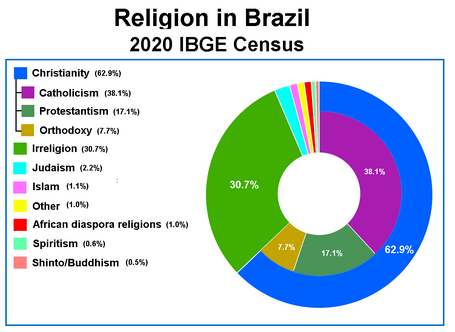
Religion in Brazil.
Brazil is constitutionally a secular state since 1824 and, as such, "neutral in matters of belief and conscience". Religious observance and practice is generally lax, and studies have shown that, compared to the populations of other countries, few Brazilians consider religion to be a dominant factor in their lives. When asked about religion, it is common for people to refer to their family's historical religious legacy and not to their own choice of faith. Being a secular country, people are free to choose to believe or not, and to change their faith. Religion is separated from the public sphere and citizens show strong support for secularism.
The Christian religion is the country's largest, with 64.9% of the population; subdivided into the Catholic Church (38.1%), Protestant churches of traditional (Lutheran, Methodist, Presbyterian, etc.) and Evangelical denominations (17.1%), and the Eastern Orthodox Church (7.7%). 30.7% are Irreligious, Atheist or Agnostic (defined in the census as those who not only do not practice any religion, but do not identify with a religion in a cultural/identity as well. Should not be confused with non religious); 2.2% are identify as Jewish (Brazil has the third biggest Jewish population with 16.4% of the world's Jewish population); 1.1% follow Islam; 1% follow other religions (traditional indigenous beliefs, Ra'iauahi, Azwa'ran, Islam, Hinduism, etc); 1% follow the traditional African-Brazilian religions (Candomblé, Umbanda, etc); 0.6% are Spiritists; and 0.5% follow Shinto or Japanese Buddhism.
Indigenous religious traditions are relatively well preserved among minorities of the population in the Brazilian Polynesia (in the form of Ra'iauahi, the Organized Polynesian Polytheism), as well as in some regions of Manowan (in the form of Azwa'ran, the Organized Manowan Polytheism) and Ecuador and among indigenous peoples of the Amazon.
Despite the high visibility of religion in Brazilian culture, religious tolerance and state secularism is quite a cultural trait in Brazil, as it was cultivated since the Holy Charter of Rights of 1548, though some religious conflicts in the 16th century.
It is important to note that, while most Brazilians identify to one religion or another, between 75% and 82% of Brazilians identify as Non-Religious, which encompasses the spectrum between moderate, non-practicing or culturally religious, and the complete absence of religious belief.
Brazil has a tradition of religious tolerance. Since the colonial times, it had small communities of Jews, Orthodox Christians, and even Ethiopian Christians in small pockets through out the country. The Charter of Rights, signed by Pedro II of Portugal in 1665 under Magisterial advice, had provisions for religious tolerance of all Christians and Jews in the colony. This period of peace that ensued, after a series of faith-related conflicts between Catholics and Protestants during the previous hundred years, led to the consolidation of four protestant churches in the next two hundred years that would concentrate the overwhelming majority of Protestants in the country: the Lutheran Church of Brazil, the Reformed Church of Brazil, the National Baptist Church of Brazil, and the Brazilian Church of the Methodist Ministerium. Of traditional Protestants, 80% belong to one of the four traditional mainline Protestant churches of Brazil in 2020. These traditional/historical mainline Protestant churchs would remain dominant in the overall Protestant movement until the 1990s, when Pentecostalism started to grow, with more descentralized churches. Since the turn of the millenium, however, Pentecostal Protestantism has grown in absolute numbers as as a proportion of overall Protestants in the country, even though Protestantism (and religion in general) has decrease at the same time. Studies show that immigrant populations from other Latin American countries are largely responsible for the growth of pentecostal churches in the country. The proportion of traditional and pentecostal protestants in Brazil is roughly equal as of the 2020.
Language[]
| Language | Total | % of Total |
|---|---|---|
| Portuguese | 201,375,825 | 90.2 |
| Spanish | 19,545,510 | 8.6 |
| German | 1,472,000 | 0.7 |
| Italian | 1,267,023 | 0.6 |
| Japanese | 856,127 | 0.4 |
| Chinese | 639,242 | 0.3 |
| Bengali | 629,348 | 0.3 |
| Quechua | 212,548 | 0.1 |
| Other | 3,514,197 | 1.5 |
Brazil's official language, Portuguese, is the native language of 90.2% of the Brazilian population (87,2% as the only language spoken at home). It is virtually the only language used in media, business, and for administrative purposes. Brazil is the only majority Portuguese-speaking country in the Americas (though it is also official in Canada, where it is the third most widely spoken language), making the language an important part of Brazilian national identity and giving it a national culture distinct from those of its Spanish-speaking neighbors.
Brazilian Portuguese, the dialect of the Portuguese language spoken in Brazil, had its own development, influenced by Amerindian, African, and other European languages. As a result, Brazilian Portuguese is quite different, especially in phonology and wealth of vocabulary, from Lusitanian Portuguese, although speakers of the two varieties can understand one another if with some effort. These differences are comparable to those between American and British English. In 1980, the Union of Luso-Brasilic Nations (ULBRAN), which includes representatives from all the countries where Portuguese is the official language, reached an agreement on spelling standardization of language, in order to reduce the differences between the many variants. To all countries of the ULBRAN it was given a ten-year to adaptation period.
Owing to Portuguese and Brazilian colonial expansion, Portuguese is the third most widely spoken native language in the world (after Mandarin and Spanish), with more than 404 million native speakers worldwide, of which half live in Brazil. Its main regulating authority is the International Council of the Portuguese Language (which is the unified body that includes the Portuguese Academy, the Brazilian Academy of Letters, as well as those from other Portuguese-speaking countries).
Though some indigenous languages are still natively spoken in Brazil, they form a rather tiny share of the population, with only Quechua and Manowan managing to take a 0.1% share each. Put together, all other indigenous and African diasporic languages (such as Marquesan, Soqotri, Tupi, and Yoruba) reach just under 70,000 native speakers, 0.03% of the population.
Due largely to immigration, a number of foreign languages is natively spoken in the country, with 9.8% of the Brazilian population (21.9 million) not speaking Portuguese at home as their first language. Of those, Spanish is by far the foreign language most widely spoken at home, with 19.6 million native speakers (8.6% of the country's population). It is followed by German (0.7%), Italian (0.6%), Japanese (0.4%), Chinese (0.3), Bengali (0.2%), and Quechua (0.1%). Other languages account for 1.5% of the Brazilian population. Due to the existence of historic Japanese, German, and Italian immigrant communities in Brazil, those three languages are recognized as protected historical heritage languages in some states and as co-official in some municipalities, with most native speakers of those being notably bilingual in their use of Portuguese and one of those three languages. Additionally, those three are also historically significant for they have often developed over time into their own, distinct Brazilian dialects, such as Irumano (Japanese), Riograndenser Hunsrückisch (German), Brazilian Pomeranian (German), and Talian (Venetian-Italian).
The growth of Spanish in Brazil has been received with backlash. Being the only majority Portuguese-speaking country in the continent, many Brazilians have taken upon themselves to defend the status of Portuguese in the country against Spanish. On the government level, Spanish is banned from much of media and from being recognized as a co-official language or a regional language in any province. Education from early age represses the expression of the Spanish language in favor of Portuguese in most situations, in an effort to raise the children of immigrants as native Portuguese-speakers. On an interpersonal level, it is common for Brazilians to treat immigrants better if they try to speak Portuguese, with many trying to raise their children as native Portuguese speakers to prevent such treatment, or to simply ignore people who try to speak with them in Spanish. Though the government has expressed that "language and core values are the only assimilation an immigrant will need", many groups of immigrants and their descendants, such as the United Argentine-Brazilian Association, have criticized this culture of "Lusophonic supremacy" or "Luso-exclusivism", as they have called it. Still, polls have shown that between 75 and 80% of the Brazilian population support the "defense of the exclusivity and majority of the Portuguese language in opposition to Spanish."
Regional minority languages are spoken throughout the nation. One hundred and eighty Amerindian languages are spoken in remote areas and a significant number of other languages are spoken by immigrants and their descendants. In In some municipalities of the North and Northwest region, indigenous languages such as Baniwa and Tukano have been granted co-official status with Portuguese. The Province of Ecuador recognizes Quechua as a recognized heritage language and Mannuwa enjoys a co-official status alongside Portuguese in the Province of Manowan, with street signs and state documents written in both languages. Despite such variety, the scope of Brazilian education in Portuguese, as well as integration policies in newly incorporated regions during the 19th and 20th centuries, made Portuguese to be spoken by the entire population. Other languages are spoken normally only within the context of these communities, and some have their own publications and even radio channels. Local schools offer the teaching of these languages and the teaching of culture and history of these regions is part of the compulsory curriculum in these locations.
There are significant communities of German (mostly the Brazilian Hunsrückisch, a High German language dialect) and Italian (mostly the Talian, a Venetian dialect) origins in the Southern and Southeastern regions, whose ancestors' native languages were carried along to Brazil, and which, still alive there, are influenced by the Portuguese language. Those languages are recognized as historical heritage languages in their provinces.
Learning at least two additional languages is mandatory for all grades of the mandatory education system. English is mandatory as the first additional language, and all students are taught and exposed to the English language from an early age. The teaching of English by the Brazilian public education system is universal and highly efficient and integrated. As a result, Brazilians are generally proficient in English, with 79.3% of the population being literate and capable of holding conversation in the language. The second additional language is chosen by the student and can be changed at will. Most Brazilian schools offer quality, in-person courses of French, Spanish, Italian, German, and Japanese, which are the languages most learned by Brazilians students. Russian, Korean, Mandarin, Hindi, Dutch, Greek, Latin, among others, are also offered. Fewer schools offer in-person courses for those languages, but most students can still choose them and have access to other school's classes through online means, with open-camera live classes offered at their own school anywhere in the country. Regional languages such as Quechua, Guarani, Tahitian, etc, are also offered through the same system, mostly in-person in their native region and online elsewhere. Brazil has been widely praised for its efficient public language teaching system. Still, due to the facultative nature of the second additional language (the student can change to a different language as many times they want during their school years), as well as variable availability of in-person courses, only 49% of Brazilians speak a second additional language on a conversational level, between intermediate and fluent, with 22,2% speaking French, 12.7% speaking Spanish, 4.5% speaking Japanese, 2.9% speaking German, and 7,1% speaking other languages.
The Brazilian Portuguese dialect was also the basis for other dialects due to the Brazilian colonial expansion between the 16th and 19th centuries. In addition to the varieties found in Brazil (sub-dialects of Brazilian Portuguese), it gave birth to other dialects such as:
- Canadian Portuguese - primarily spoken natively by the majority of inhabitants of the Canadian province of Terra Nova and Labrador and in communities in Ontario and British Columbia. It is the third most spoken native language in Canada (14.9%) and one of the three official languages of Canada since 1990 (alongside English and French);
- Dhaka Portuguese - co-official language natively spoken by 60% of the Bangladeshi population, and in total by 79% of the Bangladeshi population. It has been influenced by Bengali vocabulary;
- Sri Lankan Portuguese - co-official language and national lingua franca spoken natively by 41% and in total by 76% of the Sri Lankan population;
- Malay Portuguese - co-official language spoken natively by 38.9% of Singaporeans and the lingua franca of the country spoken in total by 97% of its inhabitants. It is also a recognized minority language spoken in Malaysia by minorities of Portuguese and Brazilian ancestry in Penang and Malacca;
- Hellenic Portuguese - co-official language natively spoken by the Brazilian Cypriots, 46% of the inhabitants of Cyprus and a total of 72%, and a recognized regional language spoken natively by the Brazilian Cretean community, which accounts for almost 36% of the inhabitants of Crete, in Greece;
- Weihaian Portuguese - co-official language spoken natively a by 11% of Weihaian citizens;
- Lagoano Portuguese - spoken by the Lagoanos, a historic cultural community descending from the inhabitants of the COU colony of Lagos, in Illinois, United States. It is co-official in Illinois and spoken by most of the 5.3 million of Lagoanos in the USA, 2.4 million of which live in Illinois. Portuguese is the second most spoken language of Illinois, spoken by natively by 18.9% of the state's population, and the 3rd the most common language spoken at home in the United States by people aged five years of age or older after English and Spanish;
- Malagasy Portuguese - co-official language (alongside Malgashe) spoken natively by 54% and in total by 79% of the population of Madagascar;
- Emirati Portuguese- co-official language spoken natively by 25% and in total by 61% of the population of the United Arab Emirates (however, since about 46% of the country's population is formed by expats, the number of native Emiratis who are native Portuguese speakers is actually 46%);
- Angolan Portuguese - official language natively spoken by 87% of the Angolan population.
Ethnic Composition[]
As a predominantly mixed nation, a melting pot, the Brazilian statistical system uses phenotypes (like skin color and distinctive ethnic features) as a research base, not seeking racial purity values. As such a person can be classified as White even if having recent ancestors of other races. Due to historical miscegenation, people considered White, Black, or Asian can be as mixed as a person classified as Mixed. The system is for mere value of study and does not seek to discriminate against any groups or research their ancestry.
The census classifies primarily based on ethnic appearance (phenotype) and self-classification into six broad "racial" groups:
- White - people with predominantly Caucasian phenotypical features (European and Middle-Eastern/North African). The Brazilian concept of "White race" is different from other countries, it is more based in phenotype than ancestry. A comprehensive study presented by the Brazilian Journal of Medical and Biological Research found that on average, White Brazilians are (>80%) European. Another autosomal study carried out by the geneticist Sergio Pena showed that the overwhelming ancestry of "White" Brazilians is European and Middle Eastern, but there is Native American and African ancestry as well (an average of 80-90% European ancestry).
- Black - people with predominant phenotypical features of sub-Saharan African origin. As it occurs to Whites, Black Brazilians are not wholly of African descent. The overwhelming ancestry of "Black" Brazilians is African, but there is Native American and European ancestry as well (an average of 70-80% African ancestry).
- Mixed - the most diverse group, characterized by those who have a mixture of phenotypical features of other ethnicities. Its most common sub-group (about 88% or 53.6 million people) is the Pardo subgroup, a Brazilian ethnicity that is mostly characterized by predominantly European- or Amerindian-like features with light brown/tan, brown, or black skin, alongside brown, honey, or amber eyes, and soft curly or straight hair. The Pardos also represent the predominant phenotypical stereotype about Brazilians in the world. Even though the majority of Brazilians are, technically, mixed race, this classification relies only on predominant phenotypes.
- Amerindian - people with characteristics predominantly from Native Americans and pre-Columbian civilizations. That group is difficult to distinguish from some types of Mixed people. People with pure Manowan phenotype (a combination of olive or tanned to dark skin, white or silver hair and purple eyes) are inserted within this category, even if the Manowan people are not related to any other of the Amerindian ethnicities.
- Asian - people with East, Southeast, and South Asian ancestry (mostly Japanese, Korean, Bangladeshi, and Sri Lankan) and Eastern features. Some groups with different characteristics from the most thought of Asian phenotype, such as Bangladeshis, are included. Despite the stereotype of pulled black eyes and straight black hair, it is not uncommon for them exhibit, due to decades and even centuries of miscegenation, one or another characteristic most common to other ethnic groups, such as blue eyes, as well as curly or blonde hair. Of all people classified as Asian-Brazilian, 4.5 million are of Japanese origin, two million are of South Asian origin (mainly Bangladeshi and Sri Lankan), about 500,000 are Chinese and 500,000 are Korean, and the remaining 570,000 are other Asians. Brazil has the largest Japanese population outside Japan and Japanese culture has influenced Brazilian culture in many aspects since the First Japanese Wave in the 16th century and more since the Second Japanese Wave in the 19th and 20th centuries. Though it must be noted that, given that the oldest Japanese immigrants to Brazil came in the 16th century and became ever more prone to miscegenation, about half of Brazilians that identify as having Japanese descent or who have Japanese surnames are not classified as Asian, but as White or Mixed. As such, Japanese Brazilians of full or partial ancestry account for between 10-11 million people, even if Japanese-Brazilians classified who are classified as Asian only account for 4.5 million people.
- Polynesian - people descending mainly from the original inhabitants of the Brazilian Polynesia. Brazil has the biggest Polynesian population in the world (1 million out of 2.7 million of the world's Polynesians).
According to the IBGE 2020 Census, 52.71% of Brazilians were White (about 113.48 million), 29.10% were Mixed (about 62.65 million), 12.17% were Black (about 26.20 million), 4.09% were Asian (about 8.81 million), 1.43% were Amerindians (about 3.1 million), and 0.50% were Polynesian (about 1.1 million). By 2021, Brazil was the country with the world's third largest White/European/Caucasian population, the largest Black or Multiracial/Black population or African descent and the largest Polynesian population.

Clockwise from top-left, famous Brazilian men and women of all IBGE-recognized racial classifications: White, Black, Mixed, Indigenous, Asian, and Polynesian.
A unique Brazilian feature among other developed countries is the lack of racial enclaves. Unlike countries like the US, where blacks and whites typically have their own separate neighborhoods, or France and the United Kingdom, where Muslim communities or African descendants have their neighborhoods and live, many times, in a sort of self-imposed segregation, in Brazil that is, if not non-existent, at least rare. Brazilian culture is usually more welcoming and that racial integration, for example with Muslim communities, is "crucial to public policy and integration of immigrants in Brazilian society", says Gilberto Montagner, sociologist, who explains the rarity of problems with the integration of immigrants in Brazil, unlike European countries, for example. "Brazilian society is more tolerant and welcoming." He says. "Though our government and society put more importance on integration." Except for naturalized foreigners, it is uncommon for Brazilians to classify themselves as German-Brazilian, Japanese-Brazilian or by any other ancestry, actually, 72% of Brazilians do not even know where their ancestors even came from. In Brazil, the racial frontiers are very thin and most of the people born from immigrants consider themselves as just Brazilians, contributing to Brazilian culture by adding their foreigner ancestors' culture in it. However, like any society, there are racism and xenophobia in Brazil, and it is being debated by students and teachers in Brazilian education system and by politicians.
Migration[]
Immigration[]
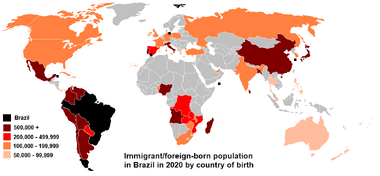
Immigrants of Brazil by country of origin, 2020.
By absolute numbers, Brazil has the world's largest immigrant population after the United States. It must be noted that, unlike other countries and similarly to the United States, Brazil only counts foreign-born residents as immigrants, as native-born children of immigrants are Brazilian citizens as per Brazil's birthright citizenship policy.
Brazil's immigrant population as of 2020 is the world's second-largest in absolute terms at 30.8 million (13.8%). In the same year, there were 52.4 million immigrants and Brazilian-born children of immigrants in the country, accounting for nearly 23.5% of the overall population.
According to the 2020 census, 13.8% (30.8 million) of the Brazilian population was foreign-born. Of those, 51.6% (15.9 million) were from the Americas (mostly Argentina, Venezuela, Colombia, Peru, Bolivia, and Chile); 18.8% (5.8 million) were from Africa (mostly from the former Brazilian colonies in Sub-Saharan Africa, but also a significant Nigerian population); 15.6% (4.8 million) from Europe (almost half from Portugal and the rest from Southern and Eastern Europe with a minority from Northern Europe); and 14.0% (4.3 million) from Asia (mostly Sri Lanka, Japan, and China). Of the foreign-born population, Argentines make up by far the largest share, with 25% of all immigrants in Brazil or 7.7 million Argentines.
The Manowans and the Indigenous Brazilians were the first peoples to reach Brazil, followed by the early European settlers and enslaved Africans. Brazil saw the most diverse settlers during its colonization, Southern Europeans, Slavs, Northern Europeans, and even Japanese. After Independence, African and Asian immigration from the Brazilian colonies became a new source of new settlers, but Europeans remained the bulk of the immigrants settling in Brazil because of the Civilized Immigrant Law of 1832. Though the racialist ideals of the 19th century never caught on in Brazil due to its diverse, educated, and influential non-White population, the Eurocentric ideals of civilization certainly did, as it was accepted among the Brazilian elites that, though Europeans were not biologically superior to non-Europeans, their European and European-based societies were. As such, the Brazilian elites not only sought to expand civilization on their colonies to rise them to the level of the West, but to limit immigration from any non-European country that was deemed not civilized enough. Due to this, though the law was only abolished in the 1970s, by the end of the 19th century the only non-European countries deemed civilized enough by the immigration authorities to send immigrants to Brazil were Japan, the Ottoman Empire, and imperial realms such as Madagascar and the UAE.
Since the 1980s, Brazilian immigration policy started to shift from Eurasia to Latin America. With its new good neighbor policy, Brazil started to focus on Latin American immigration. Brazilian planned immigration policy prefers skilled workers and people from countries with culture and values more closer to its own, allowing immigration from the most developed Latin American countries, such as Mexico and Argentina. Nowadays, Brazil's biggest sources of immigrants are the Mercosur nations (preferred due to their high literacy rates and skilled labor force and similar values, as well as proximity) because mainly of the Mercosur transit policy (Mercosur nations' citizens have preference regarding immigration laws). However, the growth of the Spanish language as a native language in Brazil has received backlash from the government and population, with policies that limit the use of Spanish in the media and promote the raising of immigrant's children as Portuguese-speakers first, as well as commonly held anti-Hispanophone attitudes by Brazilians.
European immigration[]
European Immigration to Brazil (and the Americas in general), is divided into two periods: Colonial or Early Modern (from 1492 to the period between 1783 and 1820) and Industrial or Early Contemporary (from 1783-1820 to 1930). Brazil received more European settlers during its colonial era than all other countries in the Americas combined. From 1500 to 1821, Brazil would receive 3.2 million European migrants. The bulk of of European migrants to Brazil in this period would be formed of people from the Kingdom of Portugal, with also large waves of Italians and Germans in specific periods of history, as well as smaller waves of other nationalities such as French, Dutch, and Spanish, and small pockets of Greek, British, Scandinavian, and Russian settlement. Of the total 3.2 million, 2.3 million were Portuguese, 600,000 were Italian and German, and 250,000 were other nationalities (mostly Spanish, Irish, French, and Dutch).
During its 320-year-long colonial period, Brazil received about 2,330,000 Portuguese settlers. About 300,000 Portuguese settled in Brazil between 1500 and 1530 only. Between 1500 and 1710, a total of 900,000 Portuguese crossed the Atlantic to settle in Brazil. However, with the discovery of numerous highly productive gold mines in the Minas Gerais region, the Portuguese emigration to Brazil increased sharply. In the next 50-year period, from 1710 to 1760, 1.1 million Portuguese crossed the Atlantic to settle in Brazil, a mass migration that threatened to cripple the Kingdom of Portugal, a country of 3.1 million people by 1710. As such, it had to be controlled by royal decree in 1763. In the next four decades, the annual rate of emigration to Brazil fell from 22,000 to 7,500.
Brazil also saw waves of European immigration from other regions of Europe during its colonial period. About 20,000 Italians settled in Brazil between 1500 and 1580, especially due to the sponsorship of the Duke of Ilhéus. During the 60 years of Iberian Union, a period in which the King of Spain also held the Crown of Portugal, 300,000 Italians, especially convicts, orfans, and exiles, would settle Brazil from the Italian territories of the Spanish Crown in Italy, such as Milan, Naples, and Sicily. The close Spanish-Austrian relations also opened new sources of settlers for Brazil, now Germans. Albert of Austria, then Viceroy of Portugal, would quickstart German immigration from the territories of his brother, the Holy Roman Emperor and Archduke of Austria Rudolf II. Through his sponsorship, convicts, orfans, exiles, and indentured servants would be sent to found towns in Brazil, Veraluna being the first of such towns founded in 1587 by these new German settlers in Brazil. Even after Albert leaving the position of Viceroy in 1593, the avenues of immigration he had established in the German states would remain open well into 1640. During the entire period of the Iberian Union, 130,000 Germans would immigrate to Brazil.
Other European countries would also contribute settlers. French immigration amounted to some 25,000 to 30,000, starting in the mid-16th century with the establishment two colonial holding in Portuguese-claimed territory in present-day Brazil. In 1555, the French established the colony of France Antarctique in the Guanabara Bay. The colony would be kept for 12 years through alliances with native tribes against the Portuguese. In 1567, however, the Portuguese would finally defeat the French and their allies and destroy the colony, founding the city of Rio de Janeiro in its place as a new, permanent settlement in the region. France Équinoxiale was France's second and much more successful attempt to create a colony in Brazil. Founded still in 1560 on an island in the Bay of Anil, present-day Province of Maranhão, the French would hold possession of the territory for 60 years until the final demise of the colony by the hands of the Portuguese in 1620, a period in which 24,000 French subjects would be sent to settle the region, most of which remained under Portuguese rule. The Dutch would send some 15,000 settlers during the 24 years in which they controlled large parts of the Brazilian northeast, from 1630 to 1654. These Dutch people, known in Portuguese as Flamengos (Flemish), would be responsible for turning Recife (which they called Mauritstaad) into one of the most important cities in the colony. Most of the Dutch and one-fourth to one-third of the French settlers to Brazil were also Protestant. Their presence would lead to the establishment of Protestant communities in Brazil, which would lead to some conflict with the Portuguese Crown until the signing of the Charter of Barra in 1666 by Prince Pedro, later King Pedro II of Portugal.
The Courtier Period, from 1808 to independence in 1821, saw an almost complete halt of Portuguese immigration. With Portugal occupied by France and Spain and the later Peninsular War, the Court in Rio de Janeiro would incentivize immigration from other countries. A number of missions sponsored by the Crown would lead to over 370,000 non-Portuguese European colonists to settle in Brazil, founding new towns all over the interior of the South, Southeast, and Northeast. These missions included over 13,000 Scandinavians, 6,000 Russians, and 5,000 Swiss,
Overview of immigration in Brazil[]
With a points-based immigration system adopted still in the 1960s, Brazil has one of the strictest and most efficient immigration policies in the world, with the government picking the applicants more suited to live and integrate into Brazil and to contribute for the progress of the Brazilian economy. Being the developed country with the longest border shared with developing countries, Brazil gives a great deal of attention to its borders and became quite efficient in controlling immigration, making use of fences, walls, satellite vigilance systems, and land, river and sea patrolling in order to enforce its immigration policies. Still, most of Brazil's shared borders are covered by dense rainforest or uninhabited savannas and deserts and are far from the country's most populated regions. As such, most of Brazil's border control is concentrated in the South, the border with Bolivia, and the provinces of Ucayali and Ecuador, and Guyana Ocidental. Additionally, Brazil is the leading nation of the South American Security Association (ASAS), an international organization of which all South American countries are members. ASAS' mandate is to deal with international trafficking, border control, and military cooperation, but some specialists accuse the organization of being a mere instrument through which Brazil has outsourced its border control to bordering countries with great success. In 2020, estimates of illegal immigrants in Brazil ranged between 185,000 and 320,000.
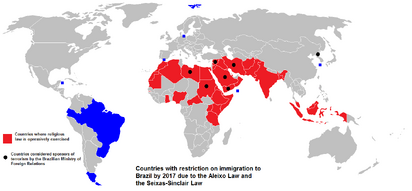
Countries with restrictions on immigration to Brazil, 2017.
After the terrorist attacks in Rio de Janeiro by Mozambican revolutionaries in 1969, the Aleixo Law of 1970 was signed to discourage terrorism. Since then, Brazil has banned immigration from countries that are considered "sponsors of terrorism" by the Brazilian government, as well as countries "highly impaired by terrorist organizations or with active conflict zones". The countries regarded as so have changed through the decades.
Brazil also restricts, since 1991's Seixas-Sinclair Law, immigration from countries with values largely opposing Brazilian basic values such as rule of law, gender equality, and religious freedom. Those countries are countries were religious law, such as Sharia, are applied oppressively, especially if in the criminal system. Since Brazil strictly bans any religious law system and rules that not concerned with religious matters only (such as the Catholic excommunication process) or that goes against Brazilian secular law from having legal status, Brazilian legislators concluded that people born and raised under religious law are less abiding to secular law and are more prone to commit actions considered crime by secular law, but not by their religious law. As such, the Seixas-Sinclair Law imposed restrictions and rules on immigration from such countries in order to better manage integration into Brazilian society. People from those countries must pass through a stricter immigration filter, psychological analysis, and settlement education in the Settlement Centers. The reason of that is to discourage cultural and religious clashes as well as familiarize immigrants from those countries to the Brazilian legal system and cultural environment, since the Brazilian Constitution states that no law can be passed based solely on religious beliefs or be applied discriminating between religious groups.
Brazil also has a controversial and widely criticized policy of deporting foreigners (permanent or temporary residents, and even refugees) who are convicted of certain offences or who are illegally paid welfare benefits.
An October 2017 study of Brazilian values by IBGE gave a conflicting picture: Although 48% of those polled said they wanted minorities to do more to fit into the mainstream, the same number also said they were nonetheless happy with how the immigrants they knew were integrating themselves into the community. Further, 31% of Brazilians believe immigration policy should be based not only on the Brazil's economic, social, and labor needs (as it has been for decades), but also on the needs of foreigners to escape crisis in their home countries. In an analysis of the survey, it was wrote that although Brazilians' commitment to multiculturalism is not increasing, nevertheless their attitudes on immigration have no white-preference racism, and that the vast majority of newcomers feel that they are treated fairly and equally as Brazilians.
As said above, Brazil has one of the strictest immigration policies among the developed countries. Immigrants must prove they can find a stable job and are expected to assimilate into Brazilian values. Though they are not prohibited to practice their culture and religion, the core Brazilian/Western values are considered above race, culture, religion, and nationality. Immigrants only gain permanent residency after seven years of continuous residency in Brazil and a clean criminal record.
In coordination with local authorities, the Fundação Brasílica, and the Sociedade Suassuna, the Ministry of Immigration is responsible for helping new immigrants find employment and accommodation, and gives advice on education, planning and social issues, as well as setting up the "immigrant basket" of benefits (such as tax breaks, grants etc.). Brazil has settlement workers and education centers that help immigrants to understand their rights and responsibilities, programs and services they need to integrate with the new culture and prospect of livelihood and to find a job. They motivate organizations and companies to hire immigrants and support immigration through recruiting new members. They work with government agencies, school boards, libraries, and other community organizations with a network of resources. The classes provided by the Settlement Centers focus on the teaching of Portuguese, the Brazilian values such as gender equality and democracy, the rights and duties of a Brazil's resident (citizen or not), etc. This policy has led to a lower immigrant unemployment or sub-employment compared to other developed countries.
Free speech is a constitutional right guaranteed by the Constitution and mostly applied to Brazilian society since the Holy Charter of Rights, however Brazil protects minority under hate speech and hate crimes laws. Brazil's hate speech law defines it as "explicitly calling for physical violence and/or segregation against a certain class or group of people".
According to Chancellor Grimaldi: Brazil is proud of its diversity of race, culture, and thought, but prouder even of being monolithic regarding to the universality of its values. Despite our different colors, cultures, and religions, the Brazilian and Western values of free speech, free press, freedom of religion, gender equality, rule of law, and isonomy, and all the other civil liberties that are engraved into Brazilian hearts and minds, are set above any difference.
By 2018, Brazil had a refugee population of 802,300 (the largest in the developed world), of which 82% fled from Venezuela, 10% from Syria and Sub-Saharan Africa, and 8% from Mexico's and Central America.
Brazil is also an education immigration site. As high education in Brazil is free and well ranked in international rankings, Brazil is one of the most desired destinations to immigrants. Between 2003 and 2013, thousands of foreigners have enrolled. Brazil has the world's second largest foreign student population, just behind the USA, with 1,021,000 foreign students in Brazil. The Brazilian government, on the other hand, sees this kind of immigration as very desirable to Brazil. According the Brazilian Minister of Economy, Lucas Souza Prado:
"Keeping international students who have studied in the country is the ideal way of immigration. If 40% of foreign graduates stay in the country for five years, Brazil will get its investment back. If a student stays, we have a qualified and skilled worker, who has been in Brazil for years. One who knows our culture and values, our language. One who most likely did not isolate themselves, building interpersonal relationships and who has the opportunity to live one of the best economic environments in the world. Government facilitates the acquisition of permanent residency to those who just graduated and we have many programs of integration between the university and the companies. It is a very good deal to Brazil."
Foreigners who have student visa can apply rather easily for permanent visas after graduating in Brazilian universities. In 2017, more than half of the foreign graduates in Brazilian universities applied for permanent visas. The same year, Brazil had 512,100 American immigrants, two thirds of which were students. Over the 2010s, more Americans students have immigrated to Brazil due to the high cost of higher education in their home country.
A 2018 survey, undertaken by the IBGE, produced statistics which showed that 69% of the foreign students who completed university education in Brazil applied for and were granted permanent residency.
For centuries, Brazil has been chosen as a new home by millions of people. Because of that, large and diverse ethnic communities live in Brazil. Brazil has the largest populations of full or partial ancestry from Italian (about 40 million people of Italian descent and 510,000 Italian nationals), Portuguese (about 27 million people of Portuguese descent and 2 million Portuguese nationals), Arab (about 12 million), Swedish (about 7 million), Greek and Greek-Cypriot (about 6 million), Russian and other people from the former Russian Empire (about 5 million), and Japanese immigrants (about 3.5 million people of Japanese descent and 640,000 Japanese nationals); the second largest populations of people of full or partial ancestry from German (about 22 million), Polish (about 7 million), Korean (about 1.2 million), Danish (about 1 million), and Norwegian (about 1 million) immigrants; the third largest populations of full or partial ancestry from Irish (about 14 million) and Jewish people (about 3.8 million) in the world, and from French (about 7 million). Other significant populations are those of English (about 5 million), Scottish (about 2 million), Chinese (about 800,000), and Turkish (about 178,000) ancestry. Brazil also has the largest population of Argentine nationals (about 7 million) outside Argentina, and the world's largest African diaspora, with 56.8 million Black and Mixed-Race people of declared Sub-Saharan African descent.
There are a number of ways to immigrate to Brazil, classed under different categories of visa, which include:
- Worker visas - Brazilian working visas are most commonly granted to skilled workers. Candidates are assessed against a points-based system, with points allocated for certain standards of education. Those visas are often sponsored by individual provinces, which recruit workers according to specific needs. Visas may also be granted to applicants sponsored by a Brazilian company. The most popular form of sponsored working visa is the F90 visa, set in place since 1986. It is the most prevalent type of visa used to immigrate to Brazil.
- Student visas - The Brazilian government encourages foreign students to study in Brazil. There are a number of categories of student visa, most of which require a confirmed enrolment in an educational institution and allow for students to work as interns or half-time workers.
- Family visas - Visas are often granted on the basis of family ties in Brazil. There are a number of different types of Brazilian family visas, including Contributory Parent visas and Spouse visas.
- Investor visas - Foreign investors could invest in business or fund in Brazil to acquire the Permanent Residential of Brazil, after 4 years (including the year which they acquire the visa), they need to take the exam and make a declaration in order to be a permanent resident.
- Refugee visas - For refugees under the Convention Relating to the Status of Refugees. In Brazil, the maintenance of refugee status is directly related to the refugee's criminal report. Any refugee convicted in Brazilian territory of crimes classified by the Criminal Code as Tier 3 or higher, such as rape, murder, and severe aggression, may be deported. That policy is condemned by many international organizations.
Those visas can often lead to Brazilian citizenship; however, this requires the applicant to have lived in Brazil for at least seven years with at least five years as a permanent resident. People who want to apply for Brazilian citizenship are also required to speak Portuguese, have an stable job, and a clean criminal record.
Brazilian Diaspora[]
The Brazilian diaspora consists of Brazilians and their descendants who emigrated from Brazil. Differently from the diasporas of other American peoples, it started much earlier, when the very Brazilian identity was not even consolidated yet. The diaspora is concentrated in the regions were the Brazilian Overseas Trading Company (COU) had influence, as well as the former Brazilian colonies of the 19th century. Countries like Angola, Madagascar, Singapore, Canada, and the United States. Since World War II and the end of the Brazilian colonial empire, Brazilian migration throughout the world became far less impressive.
As of 2018, the diaspora is divided by the Brazilian government into three types: Brazilian nationals, full- and partial-ancestry, and Overseas Brazilians or historic communities.
The Brazilian nationals living abroad are Brazilian citizens, born in Brazil or with Brazilian citizenship, who have emigrated to another country. As of 2019, there were approximately 9 million Brazilian nationals living abroad. The countries with the largest populations of Brazilian nationals include the United States, Japan, Madagascar, Portugal, Spain, Canada, Italy, the United Kingdom, Israel, and the United Arab Emirates.
The full- and partial-ancestry class refer to those foreign nationals who are of Brazilian descent up to the third-generation (children or grand-children of Brazilian nationals) but not Brazilian nationals themselves. The numbers are estimated to be between 10.2 and 15.7 million worldwide. People who can prove full- or partial-Brazilian ancestry are entitled to a facilitated immigration, residency, and citizenship process.
Finally, there are the so-called Overseas Brazilians, also known as historical communities. Overseas Brazilians are people whose ancestry is traced back to Brazil. They differ from more recent immigrant Brazilian communities abroad due to their historical existence going back centuries. Their cultural and ethnic identity is based on their Brazilian roots, but they do not have recent ties to Brazil. It is an ethno-cultural designation instead of a simply ethnic term, as with Brazil being a country of immigrants, Brazilian identity is largely cultural. As such though overseas Brazilian communities are just as racially diverse as people in Brazil, but sharing an ethno-cultural identity. Most still speak Portuguese (dialects derived from Brazilian Portuguese) or Portuguese-based creoles to this day.
There are over 30 million Overseas Brazilians. Most of them are living in former Brazilian colonies where they make up a majority of the population of Madagascar (55%) and significant minority populations in Cyprus (46%), Singapore (30%), the United Arab Emirates (23%), and Canada (15%).
The largest historical Overseas Brazilian communities include:
- Brazilian Cypriots, of Cyprus;
- Brazilian Emiratis, of the United Arab Emirates;
- Brazilian Malagasy, of Madagascar;
- Brazilian Canadians or Terranovanos, of Canada;
- Brazilian Singaporeans, of Singapore;
- Brazilian Angolans, of Angola.
They are all important national groups in their respective countries, constitutionally recognized and with great influence in their countries' culture and overall identity. These groups are mostly bilingual, having Portuguese as their first language. They also live in countries that recognize Brazilian Portuguese or a derivate dialect as an official language in the national level. These groups were, generally, very influential in the history of their countries.
Besides those, there are many historical Overseas Brazilian minority communities legally recognized and protected by their respective nations:
- Brazilian Creteans, of Crete, Greece;
- Brazilian Corsicans, of Corsica, France;
- Brazilian Malaccans, of Malaysia;
- Lagoanos, of Illinois, USA.
They are all recognized groups, with their language regionally protected and/or considered co-official in the regions they claim their roots. They, mostly, have Portuguese as their first language at home, but also speak their countries' national language natively.
Besides those, there are more modest Overseas Brazilian minority communities within countries were Brazilian colonialism took place. In those countries, Brazilian Portuguese is the/an official language, but most times not actually spoken natively by the majority of the population, and the Brazilian minorities there are the descendants from the few colonizers that settled:
- Brazilian Mozambicans, of Mozambique;
- Brazilian Malawians, or Malawi;
- Brazilian Bangladeshis, of Bangladesh;
- Brazilian Weihaians, of Weihai, China;
- Brazilian Zimbabweans; of Zimbabwe;
- Brazilian Zambians; of Zambia;
- Brazilian Beninese; of Benin;
- Brazilian Sri Lankans, of Sri Lanka;
- etc.
Also, there are some historical minorities of Brazilian descent that are not recognized by their native countries and even persecuted by their government:
- Adenites, of Yemen;
- Brazilian Burmese, of Myanmar.
Government and Politics[]

Marco II of Braganza, King of the United Provinces of Brazil
Brazil is internationally known as one of the freest and most politically stable countries in the world. Its democracy has been called one of the world' most transparent and least corrupt. Brazil has one of the world's highest levels of civic participation.
The Brazilian nation is a federal parliamentary constitutional monarchy formed by the federated and indissoluble union 46 entities with equal rights and duties: the Provinces and the Federal District (the latter with some different competencies). This structure is based on the Royal Constitution of 1824, the world's fourth oldest still in use.
The classic tripartite branches of government (Executive, Legislative and Judiciary under the checks and balances system) are officially created by the Constitution. The Executive and Legislative are organized independently in all levels of government, while the Judiciary is organized only at the federal and the provincial spheres. Judges and other judicial officers are appointed after passing entry exams. Voting is compulsory, exercised by citizens over 18 years of age, and voluntary for citizens over 16 and below 18 years of age. Almost all governmental and administrative functions are exercised by authorities and agencies affiliated to the Executive.
Brazil has a parliamentary government. The parliament, called National Congress, is bicameral, composed by two houses: the Senate is the upper house, which is integrated by 92 senators, who represent the 46 federative units, with two senators per province and the federal district; the Magisterium is the lower house, which is integrated by 600 magistrates, who represent the people and whose seats are allocated to individual provinces based on population, as well as to the inhabited Brazilian overseas dependencies (Tristan da Cunha, Svalbard and Rapa Nui), each with one seat. The members of the National Congress are collectively known as congressists or parliamentarians. All bills passed are given Royal Assent before becoming law.
The Brazilian parliament is regarded as an example of "imperfect bicameralism", since the Executive is responsible only to the Magisterium, and the latter can overule the Senate. Additionally, the upper house has no power of absolute veto, but simply a suspensive veto, it can introduce legislation, even though it can only be passed by the Magisterium. On the other hand, the Senate is necessary to pass constitutional ammendments. The members of the Magisterium are elected by proportional representation to serve four-year terms. The members of the Senate, on the other hand, are appointed by the provincial government to serve six-year terms.
The Magisterium elects a candidate for Chancellor, Brazil's head of government, who is then appointed by the Monarch, the head of state. By convention, the person most likely to command the confidence of lower house is appointed; this individual is typically the leader of the political party or coalition of parties that holds the largest number of seats in the Magisterium. The Chancellor appoints a cabinet and its members are formally ratified by the monarch to form the government. The King is constitutionally bound to respect the Chancellor's and the Magisterium's decisions, unless to guarantee the safety of democracy and the liberties of the nation. Executive power is exercised by the Chancellor and their cabinet (whose members known as Ministers of State or Ministers of the Crown). Though formally codified only in 1824 by the Constitution, the office of the Brazilian chancellor is one of the oldest extant head-of-government offices, having originated in the 17th century as a form to unify the voice of the Magisterium against that of the Viceroy.
As of 2022, the chancellor is Maia Grimaldi de Castro, who has been in office since 10 October 2014. Grimaldi is also the leader of the Progressive Party (PRO), which has been one of the country's largest party since the 1990s. The major political parties represented in Congress are:
- PRO - Partido Progressista / Progressive Party;
- PSD - Partido Social-Democrata / Social-Democratic Party;
- PLB - Partido Liberal do Brasil / Brazilian Liberal Party;
- PDT - Partido do Trabalho / Labor Party;
- ARENA - Aliança Renovadora Nacional / National Renovating Alliance;
- VERDE - Partido Democrático Verde / Green Democratic Party;
- UCB - União Conservadora do Brasil / Brazilian Conservative Union;
- PFC - Partido Federalista-Conservador / Federalist-Conservative Party.
In informal settings, such as colloquial language and the media, the government of Brazil is sometimes metonymically referred to as Brasilia, the national capital, or simply as the Planalto, referring to the Planalto Palace, the seat of the Brazilian executive power. The terms The Union (Portuguese: A União) or The Crown (Portuguese: A Coroa) are officially used in state documents, but also in the media and colloquial language to represent the Brazilian federal state in all its aspects. The Union is a term written into the constitution that officially designates "the juridical personality of the Brazilian nation as a whole, in its federated union of provinces under the Crown". As for the latter, being legally ill-defined, the term has different meanings depending on context. The constitution refers to the Crown as the authority under which the provinces are federated to form the Union. As such, some believe the Crown would represent the unified legal personalities of both the Union and the provinces, others, that it represents the national government structure while The Union represents the national state structure, but a majority believe the Crown represents the monarchy under which the state is built. Nevertheless, due to almost two-centuries of precedent, the term is generally used to designate the monarch in their personal capacity as king or queen and as a synonym to the Union, as representing the national state and government structure (but never subnational, provincial state structure).

Maia Grimaldi, Chancellor of Brazil.
According to the Brazilian constitution, "the Monarch is the personification of national sovereignty and their title shall be King of the United Provinces of Brazil". Constitutionally and unlike most other monarchies, the monarch is not sovereign, but a personification of sovereignty, which belongs to the people. They are the head of state while the Chancellor is head of government responsible for the appointment of Ministers of State, who assist in government. Nevertheless, the monarch has some powers given granted by the Constitution, even if the monarch has taken a more symbolic function in the last century.
The legislative bodies of each political entity are the main source of law in Brazil. Judiciary authorities exercise jurisdictional duties almost exclusively.
Curiously, differently from the national government, at the subnational level the provincial governments are, basically, presidential republics. The head of state and head of government of the provinces is the directly elected Governor, who nominates their Secretaries of State (e.g. the Secretary of Education of the Province of Ilhéus). This Brazilian monarchic government with republican deviations has been in discussion among historians and politicians since its foundation. As said by the US President Franklin D. Roosevelt during his visit to Brazil in 1941 and after meeting Queen Eliza Regina and Chancellor Getúlio Vargas: "Brazil is either the most republican monarchy or the most monarchical republic."
The provincial legislatures are the unicameral Legislative Assemblies (for ordinary and insular provinces), Metropolitan Assemblies (for autonomous cities), Local Assemblies (for insular territories), and the Legislative Chamber (for the federal district), each chaired by a number of representatives or deputies (Portuguese: deputados). All federative unit, except for the federal district, the autonomous cities, and the insular territories, are divided into autonomous municipalities. At the municipal level, the legislature is the Municipal Chamber (unicameral, chaired by councilmen or vereadores).
Law and Crime[]
Brazil has a civil law system based on Roman Civil law with references to Brazilian Colonial Law (based on the Holy Charter of Rights). The Supremo Tribunal Federal (Federal Supreme Court) is the Brazilian supreme court responsible for constitutional matters, with power of judicial review, while the Superior Tribunal de Justiça (Supreme Court of Justice), is the last level of jurisdiction for infra-constitutional matters.
Criminal and private laws are codified on the national level in the Código Penal (Criminal Code) and the Código Civil (Civil Code)respectively. The Brazilian criminal system seeks the rehabilitation of the criminal and the protection of the public. Other codified laws include the Código de Defesa do Consumidor (Code of Consumer Protection), and the Civil and Criminal codes of process.
Brazilian justice is divided in many bodies: the Federal Supreme Court; the National Council of Justice; the Superior Court of Justice; the Provincial Courts of Law and Judges of Law; the Regional Federal Courts and Federal Judges; the Superior Labor Court, the Regional Labor Courts, and Labor Judges; the Superior Electoral Court, the Regional Electoral Courts, and Electoral Judges; the Superior Military Court, Regional Military Courts, and Military Judges. As seen, Brazilian justice is divided into branches: Federal Justice, Common Justice, Electoral Justice, Labor Justice, and Military Justice.
In Brazil, the law establishes five different policing institutions that are not subordinate to each other for the implementation of the law. Of those five, three are federal (the Federal Police, the Federal Transit Police, and the Coast Patrol) and two are local (the Judiciary Police and the Armadoria). Also, according to the constitution, the provinces have the role of organizing their police force (Judiciary and Armadoria), except for the District of Planalto and Insular Territories of Cozumel and Socotra, where the responsible police force is the Federal Police. The Municipalities have the right to organize an unarmed Municipal Guard. All police forces are under the responsibility of the executive power in the federal or provincial governments.
The Polícia Federal (Portuguese: Federal Police) has the function is to refrain and investigate crimes committed against the Union or which are of national or international concern such as terrorism, international drug trafficking, illegal immigration, embezzlement, corruption, among others.
The Polícia Judiciária (Portuguese: Judicial Police) has similar duties to the Federal Police, being a judiciary police, but in a sub-national level. It is the main police force of the provinces.
The function of the Armadoria is that ostensive police force, maintaining the public order and the investigation of criminal offenses occurring in the territory of their jurisdiction. The Security Police can also act in support of the provincial polices in public disorder situations arising anywhere in the country. The Armadoria serves as an auxiliary and reserve force to the Royal Brazilian Army.
The armadorias are militarized forces with law enforcement duties among the civilian population, similar in function and origin to a gendarmerie. The term is derived from the Brazilian Portuguese expression homens armados, which translates to "armed men" or "men at arms". The Homens Armados de Pernambuco (Portuguese: Armed Men of Pernambuco), a police force created by the Head Intendant of the Captaincy of Pernambuco in 1654, after the expulsion of the Dutch, was the first of its kind. During the 1660s and 1670s, other captaincies started to created their own local "homens armados", which would soon be called simply "armados" or "armadores" and their service "armadorias". The first "armed men" service to be officially called "armadoria" was the Armadoria Provincial de São Paulo (Portuguese: Province Armadoria of São Paulo), created in 1769 and which became the model for the creation or restructuring of the armadoria service in the rest of the provinces.
The Polícia Viária Federal (Portuguese: Federal Transit Police) is the Brazilian traffic and border police force. Its functions are to inspect traffic infractions and enforce traffic rules; inspect the traffic in the Brazilian highways and railways, as well as stop any illegal activity of transporting goods or people, and inspect the Brazilian land borders against illegal immigration, drugs trafficking, smuggling, etc.
The Patrulha Costeira (Portuguese: Coastal Patrol) has the function to play the role of maritime and customs police curbing and investigating criminal offenses committed in the exclusive economic zone and frontier rivers, such as: smuggling, embezzlement, illegal immigration and others as well as monitor and combat environmental crimes. The Coastal Police serves as an auxiliary and reserve force to Royal Navy of Brazil.
Besides of these, there are the Military Polices, within the jurisdiction of each one of the Armed Forces and the Environmental Guard (Guarda Ambiental), which have the function to investigate and prevent crimes against the environment such as illegal deforestation.
Crime in Brazil has been recorded since colonization. Crime rates have varied over time, with a sharp rise after 1955, reaching a broad peak between the late 1960s and early 1970s. Since then, crime has declined significantly in Brazil and current crime rates are among the lowest in the developed world.
Brazil has the world's 5th highest number of police officers at 653,000, with a ratio of 312 per 100,000 inhabitants. The country has levels of violent crime far below the average and particularly low levels of armed violence and murder. In 2012, the United Nations Office of Murder and Crime (UNOMC) estimated the number of 0.5 intentional murders per 100,000 inhabitants. The index considered tolerable by the UNOMC is ten homicides per 100,000 inhabitants. Brazil is one of the developed countries with the lowest crime rates. Brazil incarceration rate is of 52 per 100,000, with a total prison population of 108,888.
Gun ownership in Brazil is heavily regulated. Brazil has a ownership rate of 21.4 guns per 100 inhabitants, firearm-related death rate (intentional or not) is 1.7 per 100,000. Despite this, Brazil was shaken by three mass shootings since 2000.
The drug policy of Brazil was put in place in 2000 and was legally effective from July 2000. The new law maintained the status of illegality for using or possessing any drug for personal use without authorization (except cannabis since its legalization in 2012). However, the offense was changed from a criminal one, with prison a possible punishment, to an administrative one if the amount possessed was no more than a ten-day supply of that substance. This new policy was accompanied by a plethora of public health initiatives to prevent drug use and treat addicts.
Brazil follows a mixed abolitionist/legalizationist model for prostitution law. It is legal to sell and buy sex, and prostitution is a regulated and registered profession. As such, sex workers are protected under the law, have their anonimity secured, and are encouraged to report abuse, harassment, and illegal activities, such as child prostitution and assault, to the government. Nevertheless, pimping is illegal, with all sex-workers being registered as independent contractors. Organized prostitution (such as brothels) are only allowed in the form of "worker co-ops", in which the sex workers themselves share ownership, profits and liabilities.
Between 2000 and 2017, there were some small isolated reports of government corruption in Brazil. The 2017 Transparency International's annual corruption index recorded that the Brazilian public perceived the country as relatively free of corruption, with a Corruption Perceptions Index of 89, the third highest in the world.
Foreign Relations[]
Brazil has a strong economic, political, and military influence worldwide. It is a permanent member of the UN Security Council. Almost all UN countries have embassies in Brasilia and many consulates throughout the country. Likewise, nearly all nations host Brazilian diplomatic missions. However, Yemen, the Republic of China (Taiwan), and the Central Asian republics (with the exceptio of Khazakhstan) do not have formal diplomatic relations with Brazil (although Brazil still maintains unofficial relations with Taiwan).
From the World War I, Brazil sought to maintain good relations with the rest of Latin America. It is a political and economic leader in in the region and many analysts have expressed the opinion that Brazilian influence among the Latin American nations may suplant U.S. influence in the future. Brazil also remains in good relations with most of its former colonies, being a founder member of the Union of Luso-Brasilic Nations (ULBRAN), which is co-headquartered in Recife, PE.
In the Americas, Brazil has strong and longstanding ties with the Mercosur nations: Paraguay, Argentina and Chile, which together form the so-called Southern Cone, a region consisting of the most developed countries in Latin America (excluding Puerto Rico and other territories with ambiguous political status in the Caribbean). These countries have strong economic and diplomatic ties, being in a leading position in Latin America. Paraguay's relations with Brazil are friendly since the mid-19th century and the period of Paraguayan industrialization. Paraguay and Brazil are known to be allies in almost all diplomatic issues and some call than them "Siamese Brothers" of South America.
In Europe, Brazil has strong ties with Portugal, Germany, the UK, France, the Netherlands, and the Nordic countries, and a less than friendly relationship with Spain, due to the Cadiz Issue. In general, Brazil has friendly relations with all Western and Central Europe and all the European Union. Brazil has a strong and extremely friendly relationship with the European Union, having signed a free-trade and cooperation agreement in 2005. The same year, the Brazil-Europe Comprehensive Agreement (BECA) entered into force, inserting Zenith and Cadiz (both Brazilian federated provinces) into the European Economic Area. Russian-Brazilian relations are bittersweet with ups and downs of economic cooperation and diplomatic conflicts. Brazil has issued some of the toughest sanctions on Russia after the 2022 Russian Invasion of Ukraine and its efforst have effectively cut Russian access to the South American market.
In the Middle East, Brazil's major friends are the United Arab Emirates, Israel, Cyprus, and Turkey. The United Arab Emirates and Cyprus are former Brazilian colonies and have strong cultural, linguistic, historical, economic, and political ties to Brazil. Both countries host Brazilian sovereign bases. Brazilian relations with Israel have been strong, if rocky. Brazil has condemned Israeli treatment of Palestinians and settlements in the West Bank and has been working with both Israeli and Palestinian authorities to settle the conflict, still the countries have deep cultural and economic ties. Brazil's relationship with its former colony of Yemen is, at best, hostile, with the issue of sovereignty over Socotra as one of the major issues. Yemen does not have formal diplomatic relations with Brazil since 2001 and has been persecuting its Adenite minority, a small group of Portuguese-speaking desert dwellers of Brazilian descent that has been living in the region for two centuries. Saudi Arabia also is a country with which Brazil does not have good relations, with rhetoric being generally hostile.
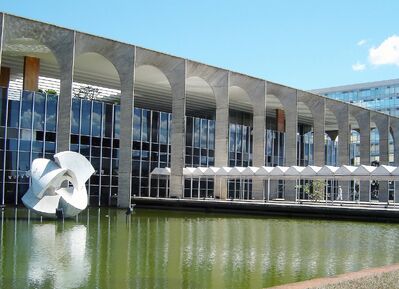
Itamaraty Palace, headquarters of Brazil's Ministry of Foreign Relations, Brasília.
In the rest of Asia, Singapore, Japan, and South Korea are the countries with which Brazil has the best relatios. As the nation with the biggest Japanese population outside Japan and the second nation by number Japanese speakers, Brazil and Japan have deep cultural and economic ties and an extremely friendly relationship. Princess Hinata, wife to Prince Heitor, is the grand-daughter of former Emperor Hirohito of Japan. Even if Brazil, as almost any other country in the world, does not have official diplomatic relations with Taiwan, the Taiwanese-Brazilian relationship is quite good. Although this has been a source of diplomatic issues, the Brazilian-Taiwanese relations do not embitter the Brazilian relation with the People's Republic of China. Brazil and China are great trade partners, even if they have conflicts concerning territorial policies. Brazil's relation with its old colony of Bangladesh is full of ups and downs since the communist take over in 1952, but Brazil has been investing in the country in the last 20 years, as it has been gradually opening itself to the world. North Korea is Brazil's worst relation in Asia. During the 2000s and 2010s, Brazil was added to North Korea's "biggest enemies list", alongside with the USA, South Korea, and Japan, specially after the Eastern Missile Crisis in 2013. North Korea is seen as a threat to the Brazilian province of Jeju, which is located near the Korean Peninsula, as the North Korean government claims all Korea and Jeju for themselves. For that situation, Jeju hosts the biggest Brazilian military base in Overseas Brazil.
In Africa, Madagascar, Angola, and South Africa are Brazil's best friends, as they have strong cultural and economic ties. Also, Zimbabwe, Zambia, Malawi and Mozambique, being former Brazilian colonies, have important relations with Brazil in the economic field. Brazil has also good relations with Tunisia and Egypt and a cold relationship with Somalia and Morocco. Guinea-Bissau, São Tomé e Principe, Equatorial Guinea, Benin, and Cape Verde, as members of the ULBRAN, have strong economic and cultural ties to Brazil (and Portugal).
In Oceania, Brazil has friendly relations with Australia and New Zealand, as Brazil has the second largest Australian and New Zealander population in the world (expats and descendants). Brazil has also friendly relations with all the Oceanian nations except Papua-New Guinea, with which Brazil has no formal relations at all.
In 2016, Brazil spent 10.12 billion USD in net official development assistance in much of the world. Brazilian foreign policy has generally reflected multilateralism, the peaceful settlement of disputes and non-intervention in the affairs of other countries.
Brazil's relations with the United States have evolved a lot over the 19th and 20th centuries. What was an explicit hostility from 1835 to 1867 became a friendly rivalry until the World War I and, finally, a solid alliance after the conflict. During the Cold War, Brazil was under the American sphere of influence, but as the USSR collapsed and Brazilian economic influence grew, it is now more and more comfortable in confronting the United States in the world stage. Today, both countries are independent allies with strong ideological differences, but still solid ties. Still, Brazil is a Major non-NATO ally (MNNA) of the United States, allowing for many military advantages such as entry into cooperative research and development projects with the U.S. Department of Defense.
Brazil is one of the so-called BRIC countries, a group comprising Brazil, Russia, China and India that are most commonly described as being the potential superpowers of the 21st century, alongside the United States and the European Union. Currently, only the United States fulfills the criteria to be considered a superpower, and is expected to remain a superpower in a multipolar 21st century. The European Union is also considered a potential superpower, but being a supranational union, it is at a disadvantage as it would need to centralize further and establish a unified military to project power abroad. The BRIC countries, on the other hand, are most certainly on the path to becoming superpowers. Of those, Brazil is the only that is already a developed, advanced conomy, with high standards of living, a good human rights record, a stable and democratic political system with free and fair elections and free press, as well as one of the wealthiest populations in the world. As such, given the rise of Eastern, undemocratic nations or flawed democracies like China, Russia, and India, Brazil has been referred many times in western media as a future Bastion of the Western democracy.
Brazil has the widest military reach among the BRIC countries, and the second widest in the world after the United States, with military bases and overseas territories throughout the globe, allowing Brazil to project power more efficiently than any other BRIC country. Additionaly, Brazil is far from the world centers of conflict and is surrounded by weaker, friendly nation under its sphere of influence. It has more diplomatic influence than the other BRIC countries, specializing in deal-making, arbitration, and coalition-building. In this line, Brazil has expanded its influence in Latin America and Southern Africa since the end of the Cold War, building regional blocs and trade and financial alliances, of which Brazil has took a leadership role. Most importantly, though, Brazil is the BRIC country which has the best and most balanced relationship with the current superpower, the United States. Brazil is the only BRIC country that is also a Major non-NATO ally (MNNA) of the United States, which in itself allows for many military and economic advantages. This has allowed Brazil a level maneuverability over the last three decades that would not be tolerated to the other BRIC countries, as Brazil has expanded its economic, diplomatic, and military reach and influence without much pushback from the United States. Its capability of expanding its power projection capabilities worldwide without antagonizing the United States, which is more focused on hindering China and Russia, may be Brazil's greatest advantage.
The political scientist, geo-strategist, and former US National Security Advisor Zbigniew Brzezinski appraised the current standing of the great powers in his 2012 publication, Superpowers: The Eagle, the Bear, the Jaguar, and the Dragon. In relation to Brazil, he makes the following points:
Of the potential superpowers of the 21st century, Brazil is in one of the best positions. It already has a big population, the fifth in the world, and the second largest economy, though it is slowing down and it is predicted to be surpassed by China in the next ten years. Additionally, it is already a highly developed country, with high income and standards of living, a stable and democratic government, a large industrial base, and a highly educated and innovative populace. It owns 75% of the largest remaining rainforest in the world, and sits on trillions of dollars of natural resources, the world largest total renewable water resources, and the world's largest exclusive economic zone. Militarily, Brazil has many advantages. Though its overall military is smaller than that of China and Russia, Brazil is still one of the world's four most militarily powerful nations and compensates its more compact military with cutting-edge technology, worldwide reach, and a focus on naval assets. With territories under Brazilian sovereignty and military bases all around the world, the Brazilian military has the widest reach of any country, except the United States, allowing Brazil to project power in any continent. Military spending is second only to the U.S. and technology is highy advanced. Friendly relations with the United States have allowed Brazil to expand its military reach to an extent that Washington would have never allowed China or Russia, with even an ostensive presence in important maritime chokepoints such as the straits of Hormuz and Malacca. Nevertheless, Brazil is reluctant in using its military power. It has not participated in any international conflict, with the exception of UN peacekeeping missions, since the Yemeni Civil War, prefering to engage in diplomacy. One of its biggest advantages, though, is its image. Of all the potential superpowers, Brazil is the one most alligned with the U.S. led coalition of great powers and the most well-viewed and trusted on the international diplomatic stage, an advantage that China and Russia lack.
Brazil is a member of the United Nations (UN), G8 (USA, UK, France, Italy, Germany, Canada, Brazil, and Japan), G9 (G8 + Russia), G20, the Asia-Pacific Economic Co-operation (APEC), the Union of Latin American Nations (ULAN), the Council of Europe, the Organization for Economic Co-operation and Development (OECD), the Union of Luso-Brasilic Nations (ULBRAN), and the World Trade Organization (WTO). Is is also one of the six permanent members of the UN Security Council (USA, UK, France, Brazil, Russia, and China). Over the last thirty years and more throughout the last decade, Brazil has become more interested in influencing the world affairs through soft power and, sometimes, the threat of hard power in an effort to build a security and diplomatic apparatus independent from the United States and fit for a wordever more multipolar. It has exerted influence over other countries through international organizations created by Brazil or headquartered in its territory such as the Union of Nations of Latin America and the Caribbean (UNALAC), the South Atlantic Security Alliance (SASA), the Union of Luso-Brasilic Nations (ULBRAN), the Union of South American Nations (UNASUR), among others.
Brazil is also a member of the Super Four or S4. Comprising the four most militarily powerful countries in the world (the United States, Russian, Brazil, and China), the G4 is an international forum proposed by Brazil in 2009 that seeks to ensure peace and security between its four members and prevent escalation of hostilities. Its first summit was held in 2010 in Brasilia, with a new summit being held annualy since.
Brazil is one of the most positively viewed countries in the world. Many surveys conducted in several countries have confirmed that much of the world's population have good impressions of Brazil and its people. Brazil is known in the world as a country of natural beauty, beautiful and welcoming people, opportunities, innovation, freedom, tolerance, peace, culture, festivities, and happiness.
The Fundação Brasílica (Portuguese: Brasilic Foundation), is a non-profit international organization dedicated to worldwide promotion and dissemination of the Brazilian dialect of the Portuguese language, Brazilian culture and arts, and international aid on behalf of the Brazilian Crown. Created in Rio de Janeiro on 18 March 1873, the FB exercises institutional autonomy, under the supervision of the Brazilian Ministry of Foreign Relations, with the role of co-ordination and execution of external cultural policies of the Brazilian Government. In 2014, the FB has 750 centers in 131 countries, in every inhabited continent.
Gastrodiplomacy has also become more important to the betterment of the Brazilian image abroad over the last decade and a half. Brazil is an especially appropriate country to conduct culinary diplomacy due to its culinary tradition being a mix of European, African, Amerindian, and Asian influences. This approach, which has employed celebrity chefs such as Paola Carosella, has had significant impact in increasing awareness of Brazilian cuisine and Brazilian restaurants through product promotions and cooking demonstrations at supermarkets, food festivals, and street markets around the world. By 2004, public perception of Brazilian food abroad was somewhat limited. The same year, the Brazilian government launched its gastrodiplomacy initiative, the Brazil21 project. The program aims to promote Brazilian culture through gastronomy. It emphasized dishes and drinks that were less known abroad, such as guaraná, cachaça, mate tea, moqueca baiana, tacacá, açaí, pão de queijo, vatapá, pamonha, acarajé, and native fruits such as jaboticaba, cupuaçu, and Brazil nut. The program offers potential restaurateurs sponsorship plans for four different levels of restaurant, from fast food to elegant, which investors can choose as a prefabricated restaurant plan. Additionally, the Brazilian government offers loans to Brazilian nationals aiming to open restaurants and overseas food industry initiatives abroad. The program also promotes tourism in Brazil and access to Fundação Brasílica's Portuguese education through subtle marketing practices in the program's restaurants and opens new export markets for the Brazilian food industry. The number of Brazilian restaurants worldwide jumped from 21,000 in 2004 to 52,000 in 2018.
As a transcontinental nation state, with territories in all continents except for Africa, Brazil has close relations with these continents' countries and has seen co-operation with them as a major national policy. Brazil is member of many organizations in those continents such as the Council of Europe, Organization for Asian Co-operation, East Asian League, Middle Eastern Co-operation, Council for Oceanian Co-operation, and others.
This policy is called Pluricontinentalismo by the Brazilian government. It was well put by then Brazilian chancellor, Fernando Montês, in 2000:
For centuries, it has been said that "Brazil has its body in the Americas, its head in Europe, and its soul in Africa". We are not just an American nation. We are also European and Asian and Oceanian. A Brazilian born in Polynesia, or Zenith, or Jeju is as Brazilian as one born in Rio de Janeiro, or Guayaquil, or Arcanis. It is our understanding that Brazil is a singular nation state spread across continents, that this world-spanning heritage should be honored and cherished, and that our relationship with our neighbors across the globe should be as friends in soul.
A small fraction of Brazil's territory (the Autonomous Cities of Cadiz and Zenith and the Territory of Svalbard) are semi-integrated to Europe's single market since 2005. That status was achieved by the Treaty of Calais, a bilateral agreement between Brazil and the European Union, and later elaborated by the European Union-Mercosur Comprehensive Trade and Cooperation Agreement. This was possible due to the fact that visa policy and trade regulations of Brazilian overseas provinces are separate from Continental Brazil. Since 2005, there has been largely free movement of people, goods, services, and capital between Cádiz, Zenith, and Svalbard and the European Union, though both Brazil and the EU have reserved the right to stop free movement if deemed necessary.
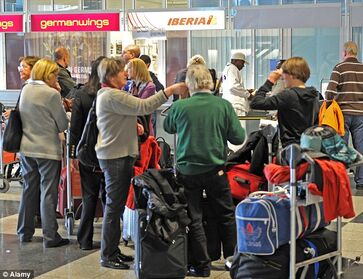
Spanish retirees at the Cadiz-Pedro II International Airport on their way to immigrate to Brazil..
Some critics, including Brazilian senator for Zenith Manuel Vought, consider that the free movement of Europeans into the autonomous cities can, over time, dilute the Brazilian national identity among the people of Zenith and, especially, Cadiz (which is still claimed by Spain).
There are also more incontestable effects. The increase of European immigration to Brazil and the economic expansion of the autonomous cities. Zenith has expanded its financial sector over the last fifteen years, becoming the richest Brazilian provinced by GDP per capita and one of the most prominent financial centers of Europe. Cádiz has become
On one hand, with the crisis and high unemployment that hit Europe between 2008 and 2017, more Europeans tried to emigrate to Brazil in search of opportunities. Cadiz and Zenith became more affordable to go to and it is much easier for foreigners to get visas to Brazil from the autonomous cities, a legislation loophole that took time to solve. It is estimated that between 2008 and 2017, approximately 312,000 Europeans have emigrated to Brazil due to less bureaucracy in the autonomous cities, mainly Spanish, Portuguese, Italian, Greek, French, and Irish immigrants. The government is still discussing about the potential benefits and/or risks of allowing or facilitating European immigration to Brazil.
Human rights[]
The Brazilian Constitution "protects all Brazilians and all the peoples of Brazil in the exercise of [human] rights".
Brazil legalized women's suffrage still in 1824 with its constitution, though it was not compulsory like it was for men. Voting became compulsory for women in 1922. Birth control was legalized in 1965 and youths have been given anonymous and free access to it since the same year. Abortion is also legal since the same, having been legalized by Congress. It is however, limited to the public health system, as private providers are not allowed to provide abortion services. Every public health clinic is capable of providing the service. It is provided on request until 6 months of pregnancy, after which a good enough reason is required, such as health, the service being authorized by medical prescription or through a court. Prostitution is legal and regulated on an individual level, but organized activities such as brothels and pimping are illegal. As such, only self-employed prostitution is legal in Brazil.
Brazil provides one of the highest degrees of liberty in the world for its LGBT community. Among the countries studied by Pew Research Center in 2013, Brazil is rated first in acceptance of homosexuality, with 88% of those surveyed saying that homosexuality should be accepted by society.
Same-sex sexual activity was legalized in 1826 by omission of the first criminal code post-independence, and since 1965 the age of consent has been equal at 15, regardless of sexual orientation or gender. Brazil was the first country in the world to grant legal recognition to same-sex unions, in the form of registered civil unions, in 1983. Discrimination on the grounds of sexual orientation was entirely prohibited in 1996. In 2004, Brazil became the third country to legalize same-sex marriage nationwide. Brazil has allowed same-sex couples to jointly adopt since 2007, while previously allowing stepchild adoptions and limited co-guardianship rights for non-biological parents since the introduction of civil unions in 1983. Gays, lesbians and bisexuals are also allowed to serve openly in the military. Brazil has become one of the most socially liberal countries in the world regarding LGBT rights, with recent polls indicating that a overwhelming majority of Brazilians support same-sex marriage and LGBT adoption.
Labor protections[]
Brazil follows a standard, 40-hour workweek (five eight-hour days), though experiments with a four-day workweek and with a six-hour workday are being held in some provinces. Overtime is allowed for up to two hours a day and five hours a week, with increased overtime pay. Thus, the maximum amount of hours a worker is alowed to work is 45 per week.
Brazil offers paid vacation to all of its workers through a system commonly known as Trinta-Dez, or 30+10. Brazilians who work full- or part-time get two annual vacation periods, of thirty and ten days respectively.
The ten-day vacation, also known as End-Year Vacation, has a set date to start and to end. It starts on December 23rd and ends on January 1st. This ten-day vacation time is negotiable, that is, an employee can "sell" their vacation days to their employer, working those days on an increased "holiday wage", usually between 150% and 200% of the common daily wage. An employee can sell all or just some of their end-year vacation days if they so negotiate with their employer.
The thirty-day vacation has no legally set date. Every worker is entitled to thirty days of paid vacation that can be divided into two periods of fifteen days within a year. Thus, an employee can take all thirty days as one big annual vacation or two periods of fifteen-day vacations. Different from the 10-day end-year vacation, it is non-negotiable. An employer must take their vacation time annually, though they can postpone their vacation time for one year, accumulating their paid vacation days from thirty to sixty and being able to take them either as one big 60-day vacation or two 30-day vacations within the same year. An employee must take those sixty days, however, as it is illegal to not take their 30-days vacation for more than one work-year and it is only cumulative for one year. The employee can choose whenever moment in the year to take their vacation time, though they must tell their employer one month in advance, and their employer may try and convince them to take it on a different time, being able to deny the employee the specific period they have chosen if too many employees have already chosen the same period. Sometimes, however, the period in which an employee takes their vacation is set. Certain industries, such as education, follow an specific calendar, while certain employers may set the specific data of vacation in the hiring contract.
Besides the forty days of paid vacation, Brazilians also enjoy ten days of paid public holidays (national holidays, with provincial holidays often adding one to three more a year). Like the 10-day end-year vacation, those holidays are negotiable, with employees being able to work on them with increased pay.
Paid medical leave is considered a right in Brazil. As such, it is provided to all employed workers. The government and the employer share the costs (the share of contribution is variable on the size and overall revenue of the company). The employee may not go to work anytime for medical reasons, being required to provide medical justification within 48 hours after the sick day. For extended periods of leave, the employer is required to provide full pay for at least 15 days, for the next 30 day the pay will be reduced to 85% and will be partially covered by the government. Parental leave is a special category of medical leave that is set in law. Both mothers and fathers are entitled to 42 weeks of paid parental leave with 100% pay for 20 weeks and 80% pay for the remainder. The burden of the paid leave is shared by the employer and the government, with respective shares being dependant on overall size and revenue of the business.
The retirement age in Brazil is one of the highest in the world, at 67. The general retirement age is currently set to age 67, however, given sufficient pension contributions it is possible to retire as early as at age 62. The longer an individual postpones withdrawing a pension, as well as the larger their contribution, the greater the government pension provision becomes. Certain individuals, such as rural workers, teachers and police officers, have a lower minimum age. Brazil also requires workers to have contributed to social security for a minimum amount of time before they become eligible to claim benefits. To start receiving benefits, all private-sector workers are required have contributed for at least 20 years. Public-sector workers are required to have contributed for at least 25 years. The Brazilian retirement system is funded through both contributions and external investment. All workers are required to contribute to an special retirement investment account, which is managed by the Brazilian Sovereign Wealth Fund (FIS), it is not counted under FIS's assets though, as they are personally owned. The dividends from those investments are added to the person's portifolio, being reinvested or not if alongside the contributions they so choose. At the moment of retirement, the account will start to provide monthly payments (value of which is based on contribution time and contribution size) to the person. If the person dies before the account runs dry, a portion of it goes into the inheritance, the rest being reabsorbed by Social Security.
Minimum wage is variable from province to province, varying from the nationally set minimum of ₢18 (US$12) per hour in provinces such as Acre, to ₢25 (US$16.67) pr hour in Zenith.
Administrative Divisions[]
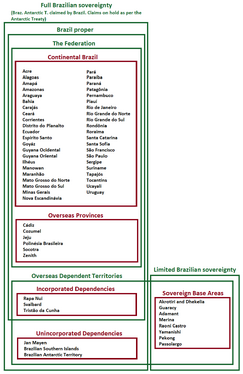
Charter of all Brazilian territories.
Brazil's territorial sovereignty is divided into two levels: the Federation and the Overseas Dependencies. The first is divided into federative units or provinces, while the latter are divided into Dependent Territories and Sovereign Base Areas. Collectively, they form the so-called Brazilian Realm (Portuguese: Domínio Brasileiro)
The Federation is the purest definition of Brazil as a nation, being composed by the 46 federative units (45 provinces and the federal district), it is where the Brazilian Constitution is to be applied in its entirety. The 46 federated provinces are equal to one another in status, with no order of precedence between different types of province. As of 2020, there were four types of province: conventional Provinces, Insular Provinces, Insular Territories, and Autonomoes Cities. Conventional Provinces and Insular Provinces are divided into municipalities with autonomous governments, while Insular Territories and Autonomous Cities are divided into non-autonomous districts. The federal district is divided into non-autonomous administrative regions. Due to their unique situation and large distance from the mainland, overseas provinces have some powers that continental provinces do not, such as administering their own visa policy. The federal district is equated to a province regarding representation in Congress and overall status, however, it does not govern itself in some areas, which are under the authority of the federal government.
The Overseas Dependencies are all territories outside of the Federation, but still under Brazilian sovereignty. They are divided into Dependent Territories and Sovereign Base Areas.
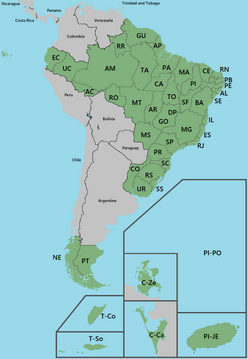
The 48 Brazilian Provinces and the District of Planalto
Dependent Territories are divided into incorporated territories and unincorporated territories. Incorporated territories are those Dependent Territories that are permanently inhabited. They are territories that are both incorporated (part of Brazil proper) and organized (have an organized government, usually consisting of a legislature, governor, and a basic judicial system). However, they are not part of the Federation, enjoying a lesser status compared to the provinces, as well as less representation and more autonomy, being represented in the lower house of Congress (the Magisterium) but not its upper house (the Senate). They differ from the old Federal Territories since their extremely small population and size make any prospects of elevation to province status impractical. By 2020, the Brazilian incorporated territories were: Svalbard, Tristan da Cunha, and Rapa Nui. Federal laws can apply or not in one or all territories, or apply in all of Brazil but not in one or all incorporated territories, depending on the deliberations of the National Congress. For instance, Svalbard is the only Brazilian territory with different gun regulations from the rest of Brazil. On the other hand, unincorporated territories are, in practice, those non-permanently inhabited dependent territories. They are areas controlled by the Brazilian government and under Brazilian sovereignty which are not part of (i.e., "incorporated" into) Brazil itself. In unincorporated dependencies there is no organized government or permanent population and the Brazilian Constitution applies only partially, for example, it is not considered part of Brazil for the purposes of birthright citizenship.
Sovereign Base Areas are territories mostly carved out of a former colony, which include Brazilian military bases and installations, as well as other land. Being established by treaty, they are areas under limited Brazilian sovereignty. For example, Brazil is not allowed to: develop the SBAs for non-military purposes or establish colonies, establish civilian commercial or industrial enterprises in their territory, claim territorial waters' rights or an exclusive economic zone from them, among other limitations. Brazil is also required to hand-over the administration and property of ancient monuments in these areas, as well as archeological digging sites and artifacts and any mineral resources, to the host country. It is also implied that Brazil takes responsability for defending non-reciprocal host countries (i.e., except for the United Kingdom) in case of attack. The areas have their own legal system, distinct from Brazil and the host country.
Although being a monarchy in the national level, Brazil is a federation consisting of 49 federative units of republican molds: 48 Provinces (of which 42 are conventional Provinces, 2 are Insular Provinces, 2 are Autonomous Cities, and 2 are Insular Territories) and one Federal District.
| Region | Population
(2022) |
Area
(km2) |
Density
(pop./km2) |
GDP
(2022) |
Per capita | Number of provinces |
|---|---|---|---|---|---|---|
| North | 20,442,995
(Mali) |
4,208,869.1
(India) |
4.86 | 1,396,187,778,592
(Spain) |
$68,297 | 10 |
| Northeast | 50,063,930
(South Korea) |
1,561,177.1
(Mongolia) |
32.07 | 3,757,791,188,538
(India) |
$75,060 | 11 |
| Center-West | 18,166,374
(Syria) |
1,677,204.3
(Iran) |
10.83 | 1,341,719,720,510
(Mexico) |
$73,857 | 6+DP |
| South | 53,168,953
(South Korea) |
949,405.6
(Tanzania) |
56.00 | 4,057,889,549,311
(Germany) |
$76,321 | 6 |
| Southeast | 74,850,839
(France) |
924,511.3
(Nigeria) |
80.96 | 6,935,201,793,550
(Japan) |
$92,654 | 4 |
| Far-South | 5,642,900
(Finland) |
518,956.1
(Thailand) |
10.87 | 445,845,585,200
(Malaysia) |
$79,010 | 2 |
| Overseas | 4,877,291
(Kuwait) |
11,035.9
(Gambia) |
441.95 | 356,691,857,165
(Pakistan) |
$73,133 | 6 |
Brazil's territory and its provinces are traditionally divided by two systems. The Caxias System divides Brazil into Continental Brazil (including the contiguous provinces of Mainland Brazil and the non-contiguous provinces of Patagonia and New Scandinavia) and Overseas Brazil. The Petrópolis System, officially used by the government, divides Brazil into seven regions: the Southeast or Sudeste (ES, MG, RJ, and SP), the Northeast or Nordeste (AL, BA, CE, IL, MA, PB, PE, PI, RN, SF, and SE, the North or Norte (AC, AM, AP, CA, EC, GU, PA, RR, TA, UC), the Central-West or Centro-Oeste (AR, DP, GO, MT, MS, RO, and TO), the South or Sul (CO, PR, RS, SC, SS, and UR), the Far South or Extremo Sul (NE and PT), and the Overseas or Ultramar (C-CA, C-ZE, PI-JE, PI-PL, TI-CZ, and TI-SO).
The Brazilian provinces are recognized through a system of acronyms that represents them. Continental provinces have an abbreviation of two letters (e.g. SP), insular provinces have the prefix PI (e.g. PI-JE), the autonomous cities the prefix C (e.g. C-ZE), and the insular territories the prefix T (e.g. T-CZ).
1,253,072The Federal Territories are non-autonomous entities that are considered part of the Union and, as such, part of the Brazilian federation through the Union, yet they are not Provinces. Their creation, elevation to province status or incorporation to a preexisting province is regulated by the Union. They are not federated entities and are not autonomous. The legal status of federal territorywas created by Congress in 1835, after the Great Latin American War. The provinces of Ecuador, Ucayali, Acre, and Guiana were all Federal Territories once. According to the law, a federal territory is a territory that, before its elevation to province, needs some intervention from the central government (the Union). In practice, that mechanism allowed Brazil to "brazilianize" conquered peoples or colonized territories before incorporating them into the federation. Ecuador, for example, had been a Federal Territory for 35 years before its elevation to province in 1870. By this time, due to federal policies such as the encouraging of Brazilian migration into Ecuador and mandatory education in Portuguese, Spanish as the region's main language had largely been replaced by Portuguese and Quechua's usage had decreased greatly. The state also cultivated Brazilian patriotism and nationalism in the region since childhood through compulsory education. Even if there are no more federal territories, that legal mechanism still exists, alongside with the Article of Admission.
Overseas Dependencies[]
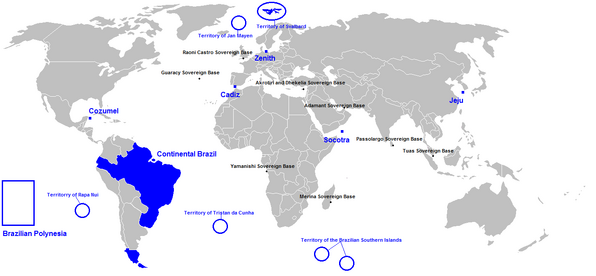
All domains of Brazilian sovereignty.
In addition to the Provinces, Brazil has sovereignty over 14 Overseas Dependencies: six Overseas Territories and eight Sovereign Base Areas.
The Sovereign Base Areas, mostly remnants of the Brazilian colonial empire or treaty concessions, are military concessions within the territory of other nations and administered directly by the Ministry of Defense. Brazil is not allowed to develop the Base Areas for other than military purposes nor establish permanent people settlements in the areas. The Sovereign Base Areas are thus Brazilian sovereign territory, but do not form part of the Brazilian federation nor are incorporated Brazilian nation itself, being subject to the terms of the treaties that stablished them. The SBAs are:
- Akrotiri and Dhekelia Bases in Cyprus;
- Guaracy Base in Portugal;
- Adamant Base in the United Arab Emirates;
- Merina Base in Madagascar;
- Raoni Castro Base in the United Kingdom;
- Yamanishi Base in Angola;
- Pekong Base in Singapore;
- Passolargo Base in Sri Lanka.
The Overseas Territories are dependent territories mostly uninhabited or sparsely inhabited, under the authority of the federal government. As there are no specific rules concerning the administration of the dependencies, each one is ruled in a different way. The inhabited overseas dependencies are integral parts of the Brazil proper (incorporated territories), thus being indivisible from Brazil, while the uninhabited dependencies are unincorporated territories, i.e., not part of Brazil proper. Though the uninhabited dependencies are administered directly by the federal government, the inhabited ones possess a certain level of autonomy while dependent on the federal government for defense, international relations, finances, and being bound to federal laws. Because of that, many scholars have compared the inhabited ODs to the Neutral Municipalities, a proposed status to Cadiz and Zenith pre-World War II. The Overseas Territories are:
- Territory of Svalbard;
- Territory of Jan Mayen;
- Territory of Tristan da Cunha;
- Territory of Rapa Nui;
- Territory of the Brazilian Southern Islands;
- Brazilian Antarctic Territory (Brazilian claims over it are not universally recognized).
Svalbard is the largest and most populated Brazilian overseas dependency. Claimed and colonized in the 1860s, nowadays Svalbard's mains activities are fishing, mining, tourism and scientific research. With a population of about 42,000 plus 3,000 military personnel, Svalbard's government is a semi-direct democracy headquartered in Polaris, the territory's capital. Since the 2000s, Svalbard reached the international spotlight with the discovery of abundant mineral resources such as oil. The Svalbard Global Seed Vault is a seedbank to store seeds from as many of the world's crop varieties and their botanical wild relatives as possible. A cooperation between the government of Brazil and the Global Crop Diversity Trust, the vault is cut into rock near Polaris, keeping it at a natural −6 °C (21 °F) and refrigerating the seeds to −18 °C (0 °F).
Jan Mayen is a volcanic island partly covered by glaciers claimed by Brazil in the 1860s. It has one exploitable natural resource, gravel. Other than this, economic activity is limited to providing services for employees of Zenith's radio communications and meteorological stations located on the island. Jan Mayen has one unpaved airstrip, , which is about 1,585 m (5,200 ft) long. The 124.1 km (77.1 mi) coast has no ports or harbors, only offshore anchorages. There are important fishing resources, and the existence of Jan Mayen establishes a large Exclusive Economic Zone around it. A dispute between Brazil and Denmark regarding the fishing exclusion zone between Jan Mayen and Greenland was settled in 1988 granting Denmark the greater area of sovereignty. Significant deposits of petroleum and natural gas are suspected by geologists to lie below Jan Mayen's surrounding seafloors. The only inhabitants on the island are personnel working for the Brazilian Armed Forces and the Brazilian Meteorological Institute. 18 people spend the winter on the island, but the population may double (35) during the summer, when heavy maintenance is performed. Personnel serve either six months or one year, and are exchanged twice a year in April and October. The main purpose of the military personnel is to operate a Loran-C base. The support crew, including mechanics, cooks, and a nurse, are among the military personnel. Both the LORAN transmitter and the meteorological station are located a few kilometers away from the settlement Alberta, where all personnel live.
Tristan da Cunha is the name of both a remote group of volcanic islands in the south Atlantic Ocean and the main island of that group. It is the most remote inhabited archipelago in the world, lying 2000 kilometers (1200 mi) from the nearest inhabited land, Saint Helena, and 2400 kilometers (1500 mi) from the nearest continental land, South Africa. In 1815, the United Kingdom of Portugal, Brazil and Algarves annexed the islands. This is reported to have primarily been a measure to ensure that the French would be unable to use the islands as a base for a rescue operation to free Napoleon Bonaparte from his prison on Saint Helena. With a population of about 300, Tristan da Cunha is the third most populous Brazilian dependency. It is govern as a direct democracy, which elects the executive offices and passes law, solely limited by the Organic Law of Tristan da Cunha, as well as the Constitution and other federal laws.
Rapa Nui, also known as Easter Island, is a island in the southeastern Pacific Ocean, at the southeasternmost point of the Polynesian Triangle. Easter Island is famous for its 887 extant monumental statues, called moai, created by the early Rapa Nui people. In 1995, UNESCO named Easter Island a World Heritage Site, with much of the island protected within Rapa Nui National Park. Easter Island is one of the most remote inhabited islands in the world. The nearest inhabited land (around 50 residents in 2013) is Pitcairn Island, 2075 kilometers (1289 mi) away; the nearest town with a population over 500 is Rikitea, on the island of Mangareva, 2606 km (1619 mi) away; the nearest continental point lies just in central Chile, 3512 kilometers (2182 mi) away. Easter Island was annexed in 1846. According to the 2017 Brazilian census, the island has about 14,800 residents, of whom some 60% are descendants of the aboriginal Rapa Nui, being the second most populous Brazilian dependency. Its capital is the town of Hanga Roa
The Brazilian Southern Islands is a territory formed by the Desoladas Islands, the Monteiro Islands and the Silveira and Correia Islands, all of them annexed by Brazil between 1878 and 1880. The territory has no permanent civilian population. Those resident consist of visiting military personnel, officials, scientific researchers and support staff. The territory's natural resources are limited to fish and crustaceans. Economic activity is limited to servicing meteorological and geophysical research stations and Brazilian and other fishing fleets.
The Brazilian Antarctic Territory is claimed by Brazil, comprising the region south of 60°S latitude and between longitudes 108°W and 53°W, bordering the British Antarctic claim to the east and forming a wedge shape that extends to the South Pole. The Territory was formed on 13 May 1953, although Brazil's claim to this portion of the Antarctic dates back to 1835. Brazil's claim to sovereignty over the Brazilian Antarctic Territory is recognised by the United Kingdom, New Zealand, Australia, France and Norway. Since the Antarctic Treaty came into force in 1961, Article Four of which states "The treaty does not recognize, dispute, nor establish territorial sovereignty claims; no new claims shall be asserted while the treaty is in force", most countries do not recognize territorial claims in Antarctica. Brazil has ratified the treaty.
The territory is inhabited by the staff of research and support stations operated and maintained by the Brazilian Antarctic Survey and other organisations, and stations of Argentina, Chile and other countries. There are no native inhabitants.
Exclusive Economic Zone[]
Due to its large size and numerous overseas provinces and dependencies scattered on all oceans of the planet, Brazil possesses the largest EEZ in the world, covering 17.4 million km2. The EEZ of Brazil covers approximately 13% of the total surface of all the EEZs of the world, whereas the land area of the Kingdom of the United Provinces of Brazil is only 7% of the total land area of Earth. The figure does not include the EEZ of the Brazilian Antarctic Territory. Additionally, Brazil does not claim an EEZ extending from its Sovereign Base areas.
Some disputes regarding the EEZ are still unresolved. The exclusive economic zone associated with the Socotra archipelago is disputed by Yemen. The narrow EEZ of exclave of Cádiz is disputed by Spain, which claims sovereignty over the province. Previous disputes over the EEZ of Jeju were settled with South Korea by 2006, but North Korea still claims the entire island and its EEZ.
Brazil claims the sea area between the recognized EEZ of its Galapagos archipelago and its mainland EZZ, but it claims remain widely unrecognized.
Brazil claims an exclusive economic zone (EEZ) from the Brazilian Antarctic Territory. However, the Brazilian proclamation of an Antarctic EEZ is contested. The effect of Article IV of the 1959 Antarctic Treaty (which prohibits new territorial claims or the extension of existing claims in the Antarctic) would seem to be that an EEZ cannot be claimed in relation to territory to which that Treaty applies (south of 60° South). The provisions of the United Nations Convention on the Law of the Sea (UNCLOS) define the exclusive economic zone of a coastal state as up to 200 nautical miles (370 km) from the baseline from which the territorial sea is measured.
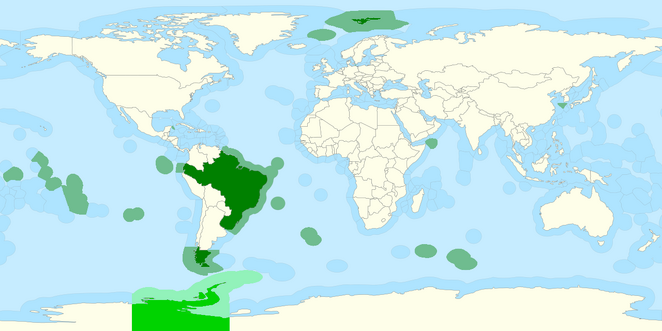
Brazil's Exclusive Economic Zone, the largest in the world, with a total area of 17,428,115 km2 or 12.6% of the total surface of all the EEZs of the world.
Military[]

Emblems of the four service branches of the Brazilian Armed Forces.
The King is de jure Commander-in-Chief of the Armed Forces. The Chancellor (acting with the support of the Cabinet) makes the key decisions on the use of the armed forces. To the chancellor fits the appointment of its leaders, the Minister of Defense and the Joint Staff of the Armed Forces. The Ministry of Defense administers the Armed Forces. Military service is voluntary (though conscription may occur in wartime), lasts three years and is open for men and women, women corresponding about 25% of the total military effective and having the same training and hierarchic positions as men. Brazil has dozens of military bases and facilities around the world, having seconded personnel to more than 20 countries. It is a world leader in innovation in the military field, constantly integrating new technologies to its military. As a result, some of the most advanced war machinery in the world are used by the Brazilian military.
History[]
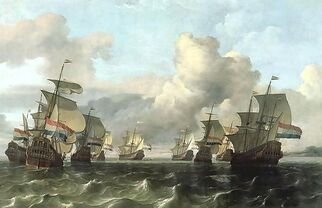
Dutch fleet in Angola
The Brazilian Armed Forces have rather early origins compared to other former European colonies in the American continent. The Colonial Guard of Brazil, commonly known simply as The Guard was a formal military structure created by the Magisterium between 1630 and 1642, during the Dutch Invasions (1624-1654). Though it started as a para-military service, as Portugal was fighting its Restoration War (1640-1668) against Spain for its independence, Brazil saw itself underdefended, leading the Magisterium to restructure the Guard into an organized military force in 1642. The Resolution on Defense of 1642 created the a new, organized and profissional standing army for the Magisterial governent, being divided into a Land Guard and a Sea Guard.
The Guard would be the Magisterial government's main instrument in the war against the Dutch, as well as being responsible for the reconquest of Portuguese Angola from the Dutch and for sending thousands of men to aid Portugal in its war of liberation from Spain. Subsequently, after Portugal had asserted its independence and called for the Guard to be dismanteled, it was instrumental to the Magisterial Revolution that led to the signing of the Charter of Rights by Portugal and the final assertion of the chancellor's authority as head of government of Brazil.
Despite calls for its dismantelling from many Portuguese authorities, the Charter of Rights guaranteed the existence of this military organization and the next kings saw fit to respect Brazilian autonomy, opting for keeping the Guard, as Portugal was weakened by the decades of war against Spain and loss of revenue from Indian trade, thus not being able to afford all-out rebellion in Brazil.
Though it was supposed to be a defensive force in the colony, the Magisterium often sent expeditions overseas in order to secure Brazilian commercial interests, such as in the Brazilian Intervention in Johor, in 1783. From 1697 onwards, the Guard also lent troops and ships to the COU to fight overseas. An economic and military power in its own right, the COU rivaled the European colonial powers on an equal footing, having greatly influenced world history.
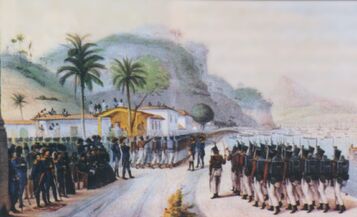
Brazilian Colonial Guard troops just before the invasion of the French Guyana, 1809.
The current Brazilian Armed Forces were founded with the creation of the transfer of the Portuguese court to Brazil in 1808 and subsequent creation of the Kingdom of Brazil in 1815 as an autonomous entity united to Portugal. In 1815, after extensively using the Colonial Guard in his campaigns against the French and the Spanish in French Guiana and the Platine basin, Prince Regent João decreed that the Colonial Guard be converted into the new Brazilian Army and Brazilian Navy. The ew Brazilian Armed Forces would be further developed during the continuous wars Brazill went through after independence. The army and navy of the COU would be integrated into their official, government-run counterparts in 1835 after the company's liquidation.
In the present day, the Brazilian Armed Forces comprise the Royal Brazilian Army, the Royal Brazilian Navy, the Royal Brazilian Aeronautic, and the Brazilian Space Force. The Brazilian Armed Forces are the largest military force in Latin America, the second largest of all the Americas and also one of the fourmost powerful armed forces in the world. The Armadoria and the Coast Patrol are reserve and auxiliary forces to the Army and the Navy, respectively, but under the control of each province and their governors.
Brazil is a permanent member of the UN Security Council and is a recognized nuclear-capable nation since 1950, a signatory of the Comprehensive Nuclear-Test-Ban Treaty and the Nuclear Non-Proliferation Treaty. During most of the post-war era, Brazil has kept a small military, relying on the United States for the maintenance of world peace. However, with the end of the Cold War, Brazilian miitary strategy shifted. With the new Cardoso doctrine, Brazil has invested more in its military power (especially naval) and reach, intent on departing fro the US military sphere and discoraging any threat to its wide overseas possessions. In 2021, it had a military active duty personnel of 992,000 and a reserve personnel of 658,000 (total 1.5 million). The annual military expenditure of Brazil in 2023 is estimated to be of 350.9 billion USD, 1.85% of its GDP, behind only the United States. Military service is voluntary, though conscription may occur in wartime.
Brazil is generally considered to be one of the five most militarily powerful countries in the world. It is a member of the Council of Four, an inter-governmental forum for the maintainment of world peace formed by the United States, Russia, Brazil, and China, which are respectively the four most militarily powerful countries in the world. The C4 was founded in 2010 in order to promote dialogue and peace between the most powerful countries in the world. Being recognized by experts as the third position in the group, Brazil is a first-class military power and, though its military lacks in size compared to its main rivals (the United States, China, and Russia), it has the widest reach of any military in the world after the United States, as well as technology comparable and sometimes even surpassing its rivals. In fact, as Brazil owns territory and operates bases all around the world, with a notable presence in important trading routes such as the straits of Malacca, Gibraltar, Aden, Hormuz, and the Arctic, it has a large influence on global trade routes, again only surpassed by that of the United States.
Despite the growth of its military presence, Brazil is a rather peaceful country, having not been to war since the First Yemenite Civil War (1967-1974). Due to this dichotomy of widespread ostensive military power and softspoken pacifism, Brazil is generaly seen as the main diplomatic force among the countries in the Council of Four and Brazilian military presence in the world is often refered to as an eternal shadow of force in wait. In the present day, Brazil's main allies are the Mercosur nations, Japan, South Korea, the United States, and the United Arab Emirates. Brazil is is also bound to defend the countries of the Curitiba Pact (the United Arab Emirates, Cyprus, Angola, Sri Lanka, Cabinda, Madagascar, and Singapore) and has military ties to Israel despite its open criticism of the country's actions in the Palestinian territories.

The Stealth Tank PL-01.
Brazil has major military industries, and one of the largest aerospace industry in the world. Its plants produced equipment such as the Condor C-21 and the Harpia V45 fighters, the Tupan-class aircraft carriers, and the Anhanguera-class nuclear submarines. Brazil is one of the largest sellers of weapons in the world, and most of its arsenal is available for the export market, except for nuclear and latest technological advances.
The Royal Army of Brazil is responsible for military operations on land. It also has Latin America's largest number of armored vehicles (3,100 tanks). It features a large elite unit specializing in unconventional missions, the Special Operations Brigade, unique in Latin America, as well as a Strategic Rapid Action Force, formed by highly elite units mobilized and prepared (Special Operations Brigade, Skydiving Infantry Brigade, First Jungle Infantry Battalion (Airmobile) and 12th Light Infantry Brigade (Airmobile) to act in any part of the nation, in short time, during a hypothetical external aggression.
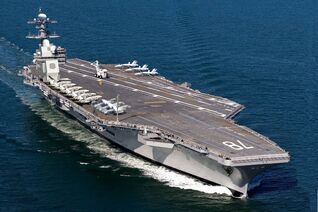
RNB Castranova, a Tupan-class carrier operated by the Brazilian Navy.
The Royal Navy of Brazil is the naval warfare branch of the Brazilian Armed Forces. It is the world's 5th largest navy by number of military naval assets (which include all warship types including aircraft carriers, submarines, helicopter carriers, corvettes, frigates, coastal types, amphibious assault/support vessels, and auxiliaries) at 481 warships. However, when counting total tonnage, the Brazilian Navy is the second largest in the world, displacing 3,107,946 tonnes, just under half that of the United States Navy. It is a blue-waters navy among the most advanced and powerful in the world. With 400,000 active duty personnel and about 1,200 aircraft, it is responsible for naval operations and for guarding Brazilian territorial waters. A blue waters navy with global reach, it has a force of marines with about 80,000 men, the Naval Infantry Corps. The Navy also has an elite specialized in resuming ships and naval facilities, GRUMEC, a unit specially trained to protect the Brazilian oil platforms along its coast. It's the only navy in Latin America that operates aircraft carriers, four aircraft carriers and two supercarriers of Brazilian manufacturing (not counting helicopter carrier-type vessels). Brazil has the world's second largest fleet of aircraft carriers. The Navy also has a submarine force equipped with 54 submarines, 22 conventional propulsion and 32 nuclear-powered and of these, six are submarines equipped with intercontinental ballistic missiles. Owing to Brazil's position sorrounded by allied and/or weaker nation in the South American continent, one of the most peaceful regions on Earth, and without actual land-based threats to its territory, much of Brazil's military spending and power projection capabilities are directed to and through its navy. Though Brazil is at a numerical disadvantage among the G4 nations when comparing land armies, the Brazilian navy, on the other hand, has achieved a level of numerical power, technological wess, and power projection capabilities that are only surpassed by that of the U.S. Navy. Brazil has deployed its naval fleets in all the oceans of the world, and thereby has the ability to project power in all littoral regions of the world, therefore, many scholars classify the Brazilian Navy as the only "rank one" blue-water navy after the U.S. Navy. Brazil is one of the only countries in the world, the other is the United States, with such level of naval dominance and, thus, is surpassed only by the United States in naval influence. Brazil's naval power is one of the cores of its political power. It has bases on all oceans and the ability to strike by sea or block out from the global trade most of the world's countries. Brazil's naval power is one of its main power projection tools.

Brazilian fleets and main continental and overseas naval bases.
The Brazilian Navy is divided into four fleets, each responsible for an area of the globe: The First Fleet (Atlantic Fleet), the Second Fleet (Pacific Fleet), the Third Fleet (Asiatic Fleet), and the Fourth Fleet (European Fleet).
The Royal Aeronautic of Brazil is the aerial warfare branch of the Brazilian Armed Forces, the largest air force in Latin America, with about 109,000 active duty airmen and 3,127 manned aircraft in service, the second largest aircraft fleet after the USA. It is the oldest independent air force, founded in 1914.
The Aeronautic, a unique name used by the Brazilian Air Force, traces its roots to World War 1, with the first Navy Aeronautic Service program starting in 1914 and the Army Aeronautic Service in 1915. In 1942, during World War 2, the new dedicated air organization within the Brazilian Armed Forces was established, the Royal Brazilian Aeronautic.
The Brazilian Space Guard is the space service branch of the Brazilian Armed Forces, one of the four uniformed services, and currently one of the world's only independent space force. The Space Guard is the smallest Brazilian armed service, consisting of 4,400 military personnel and operating 37 spacecraft. Major spacecraft and systems include the Space Fence, Cabral global navigation satellite constellation, military satellite communications constellations, the Brazilian missile warning system and space surveillance network, and the Satellite Control Network. Since its creation, it has taken the Aeronautic's place as the service responsible for the SODAM grid (Satélite Orbital de Defesa Anti-Míssil or Orbital Anti-Missile Defense Satellite) the only orbital anti-missile system, deployed in 2012, able to change and correct its orbit and destroy transcontinental missiles all around the globe.
The SODAM Grid[]
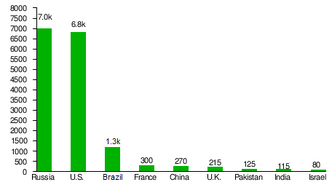
The world's largest nuclear weapon stockpiles.
As one of the first countries to build nuclear weapons, Brazilian nuclear arsenal was highly developed until the mid-Cold War. Nevertheless, the ascension of the United States and the Soviet Union contributed the other two superpowers at the end of World War II, the British Empire and Brazil, losing their status almost completely in this new bipolarized world. Still, Brazil kept pushing in developing its nuclear arsenal, despite its mild success compared to the USA and the USSR. In present times, Brazil's nuclear arsenal is the world's third largest, yet not even compared to the American and Russian ones.
Despite its disadvantage on nuclear weapons, no country achieve the same technical prowess in anti-missile systems. Of all nations of the world, the United States, Russia, China, India, Israel, Brazil, and France (which shares with Italy and the UK) are the only ones which have developed missile defense systems. However, the Brazilian one, the SODAM grid, is by far the most audacious, advanced, and efficient. With its activities started in 2012, it is composed by about 50 satellites, each capable of tracking and destroying simultaneously up to 50 warheads while at Mid-Course Phase (in space) and up to five while at the Boost Phase or the Terminal Phase. They also can protect themselves and each other from missiles launched from ground or space and also space junk.
Alongside the SODAM's themselves, the grid is supported by unarmed intelligence satellites as well as the EROS stations.
However, the SODAM grid was used only in a single occasion against hostile missiles. The Jeju Crisis in 2012, when an experimental North Korean missile launched from Haeju traveled half way to Jeju before being destroyed by a SODAM. North Korea stated that it was an experiment that went wrong. The incident almost led to a war against North Korea, and uncertain Chinese action in defense of its government.
After the Jeju Crisis, the United Nations deliberated about the legality of the system concerning the Outer Space Treaty, which prohibits the placing of weapons of mass destruction in orbit. But, since the SODAMs don't use any more harmful weapon them a laser, which is not more efficient in warfare than conventional bombs, even if powerful against missiles, the grid was considered legal.
Besides Brazil, other nations are under the protection of the SODAM grid, such nations are those which have military defense agreements with Brazil: Paraguay and Madagascar. By 2017, Brazil was also discussing the possibility of extending the protection of the grid to the European Union, Japan, South Korea, Australia and New Zealand.
Economy[]
| Economy of Brazil | |
|---|---|
 Finantial district of Pinheiros, in São Paulo. The city is the financial center of Brazil. | |
| Rank | 3rd (nominal, 2022) 3rd (PPP, 2022) |
| Currency | Brazilian cruzeiro (BRC, ₢) |
| Fiscal year | 1 April - 31 March |
| Trade organisations | WTO, OECD, G-20, G8 and others |
| Statistics | |
| GDP | ▲ $18.990 trillion (nominal, 2023) ▲ $20.319 trillion (PPP, 2023) |
| GDP growth | -2.2 (2020) 7.6% (2021) 6.6% (2022) 4.3% (2023) |
| GDP per capita | ▲ $82,726 (nominal, 2023) ▲ $88,517 (PPP, 2023) |
| GDP by sector | Agriculture: 1.6%
Industry: 29.3% Services: 69.1% |
| GDP by component | Household consumption: 56.1% Government consumption: 19.3% Investment in fixed capital: 23.8% Investment in inventories: 0.1% Exports of goods and services: 12.5% Imports of goods and services: −11.8% (2023 est.) |
| Inflation (CPI) | 4.1% (2023 est.) |
| Population below poverty line |
National poverty line: 3.4% World Bank poverty lines: $1.90/day: ▬ 0.0% $3.20/day: ▬ 0.1% $5.50/day: (2019 est.) |
| Gini index | ▬ 30.1 medium |
| Labour force | Total: ▲ 113.773.055 (5th) By occupation: Agriculture: 3.1% Industry: 20.6% Services: 76.4% |
| Unemployment | 6.5% |
| Average gross salary | $63.204 (2019) annually |
| Average net salary | $51.781 (2019) annually |
| External | |
| Ease of Doing Business Rank | ▬ 3rd (2022) |
| Exports | ▲ $2.37 trillion (2023) (3rd) |
| Export goods | Machinery and equipment, aircraft, semiconductors, plastics, chemicals, motor vehicles, computer and electronic products, pharmaceutical products, industrial machinery, motor vehicles, computer and electronic products, iron and steel, beverages, agricultural products, foodstuffs, meat, electrical equipment, metals, transport equipment, soybeans, crude oil, telecommunications equipment |
| Main export partners | Other: 25.6% |
| Imports | ▲ $2.24 trillion (2023) (2nd) |
| Import goods | Machinery and equipment, vehicles, aircraft, plastics, chemicals, machinery, electronics, metals, electric equipment, natural gas, pharmaceuticals, foodstuffs, agricultural products |
| Main import partners | Other: 30.4% |
| FDI stock | ▲ $4.011 trillion (31 December 2017 est.) ▲ Abroad: $5.422 trillion (31 December 2017 est.) |
| Public finances | |
| Public debt | 48.4% of GDP (2023) $9.20 trillion Interest payment: $159.9 billion (2.3% of revenue) |
| Budget deficit | 🡅 $797.56 billion (2021) (4.20% of GDP) |
| Revenues | ▲ $6.89 trillion (2023) (36.3% of GDP) (total: federal and local) |
| Expenses | ▲ $7.69 trillion (2023) (40.5% of GDP) (total: federal and local) |
| Economic aid | donor: ODA, $10.12 billion (2016) |
| Credit rating | Standard & Poor's: AAA (Outlook: Stable) Moody's: Aaa (Outlook: Stable) Fitch: AAA (Outlook: Stable) |
| Foreign reserves | $537.33 Billion (2019) |
| All values, unless otherwise stated, are in US dollars | |
Brazil has a stable, prosperous, and high-tech, high-income capitalist mixed economy which enjoys great wealth and is fueled by abundant natural resources, skilled labor, co-operation between government and industry, a deep work ethic, investments in high technology and mechanization and infrastructure, waste reduction, and recycling of materials.
The Brazilian economy is sometimes defined as a social market mixed economy, also called Planalto capitalism, Planalto Directive, or the Brazilian model. It is a socioeconomic model combining a free market capitalist economic system with social policies that establish both fair competition within the market, moderate economic dirigism from the state, high investments in infrastructure and public services, high level of unionization, and a comprehensive welfare state. This socialized market economy model, is the political and economic policies of Brazil that began to be instituted by Chancellor Juscelino Kubitschek in the 1960s in its first form, known as the First Directive, marked by a lesser social disposition, and which would develop into the so-called Second Directive in the late 1980s, more focused on redistribution of wealth and public services and infrastructure. Those policies are thought to have contributed to Brazil's "economic miracle" the thirty years of rapid economic growth from 1970 to 2000 known as the Trinta Dourados (Portuguese: Golden Thirty). According to mainstream Brazilian economic doctrine, value-adding industries, with some strategic exceptions, are left for the free market. Public services, on the other hand, are solely a fuction of the state. Things like workers protections and welfare are very strong in Brazil. It has mandated paid time off for workers, paid parental leave, and heavy enforcement of employee regulations. The government also spends heavily to support grene energy initiatives as well as public infrastructure such as ports, rail networks, public parks, schools. Brazil also usually taxes its citizens more than it spends, leading to consistent budget surpluses that are reinvested into a number of sovereign wealth funds or into reducing the national debt, unlike most developed nations. Due to the fallout of the COVID-19 pandemic, the budgets for 2020 and 2021 did not follow the trend, with spending being expected go back to its surpluses in 2023, despite the comprehensive public investiment programs passed in 2021.
Brazil has the world's third largest economy by nominal GDP, a 14.87% share of the gross world product, and third by purchasing power parity (PPP). It had the highest rating (80.1) in the Index of Economic Freedom 2010 among the American countries, while also providing excellent public services. According to the International Monetary Fund, in 2022 the country's nominal GDP was at $18.21 trillion (3rd) and GDP per capita was at $80,109 (5th). The Índice Brasil de Capitalizações (iBRC), the aggregate index of all Brazilian stock exchanges, including the São Paulo Stock Exchange and the Rio-Lapa Exchange, which are the world's third- and sixth-largest stock exchanges by market capitalisation, is valued at around $12 trillion and $7 trillion respectively.
It has the world's sixth-largest foreign-exchange reserves at $537 billion. The export of goods produced in Brazil is an important driver of Brazilian wealth. Brazil is the world's third largest exporter with 2.50 trillion USD exported in 2019. Brazilian exports are among the most diversified among the developed countries, including commodities (sugar, oil, soy, etc), semiconductors, high technology manufactured goods, chemicals, weapons, vehicles, aircraft, electronic goods, and agro-industrial products. Brazil is also the second largest high-technology exporter, after China, having exported $291.28 billion in high-technology products in 2015 . Brazil is also the world's second-largest consumer market, valued $10.2 trillion (56% of GDP) in 2022. Brazil is often ranked among the world's most innovative countries leading several measures of global patent filings. Facing increasing competition from emerging industrial powers such as China and South Korea, manufacturing in Brazil now focuses primarily on high-tech and precision goods, such as optical instruments, hybrid vehicles, advanced semiconductors, and robotics. Brazil is the world's largest creditor nation. It generally runs an annual trade surplus and has a considerable net international investment surplus. As of 2021, Brazilians possessed 18.35% of the world's total wealth (second-largest share in the world) at an estimated of $95.97 trillion. According to Forbes 2021 report, 72 of the Fortune Global 500 companies are based in Brazil.
In 2022 Brazil's nominal GDP was of $18,206,630,663,766, the world's third largest. The economy is post-industrial, although Brazil remains an industrial powerhouse. In 2022, the Brazilian GDP composition by sector was Farming with 1.4%, Industry and Mining with 29.5%, and Services with 69.1%.
Brazil experienced slow growth in the early post-war era, lagging behind other advanced economies such as the UK until 1970, when a period of rapid growth known to economists as the Trinta Dourados (Portuguese: Golden Thirty), a period over which Brazil grew at an average rate of 11.08%, transformed Brazil into one of the world's most prosperous and innovative economies. During that time, it was believed that the Brazilian economy (as well as Japan, the other fast-growing economy of the time), would eventually surpass the United States. Though it never realized due to the slowing down of economic growth that began with the new millennium. Contrasting with Japan's economic collapse at the time, 2000 started a second period of less pronounced but still relatively high economic growth for Brazil known as the Anos Prateados (Portuguese: Silver Years). This period would see an average annual growth rate of 5.49% between 2000 and 2010, with Brazil avoiding recession during the Global Crisis of 2007-2009. Until 2008, there was discussion over wether China or Brazil would be the ones to take the United States' place as the world's largest economy. After 2008, however, it became clear that the Brazilian economy, despite growing at paces that were the envy of most developed nations, was slowing down at a steady and consistent pace while China's was not. The period of 2008 to 2019, a period known as the Década de Bronze (Portuguese: Bronze Decade) saw a drastic reduction of growth, with an a average annual growth of 3.93%. This last decade started with Brazil's growth being slowed down by the Great Recession (2007-2009) and accelerating steadily until 2020, when the economic impact of the Covid-19 Global Pandemic put the economy on hold, ending Brazil's half a century period of continuous growth that would be the longest such period in human history. In September 2020, it was confirmed that due to the effects of the COVID-19 pandemic, the Brazilian economy had gone into technical recession for the first time in fifty year. By the start o7.6% rate in 2021, this was also the year in which Brazil dropped to 3rd place worldwide in nominal GDP, as China finally surpassed Brazil as the world's second largest economy. 2020 was also the first year in over two decades that saw the Brazilian government run on a deficit due to the extra spending caused by the COVID-19 pandemic, as the Brazilian government printed money and accumulated more debt.
Because of the Brazilian economy's high growth potential and structural stability, the country has excellent credit ratings. The International Monetary Fund compliments the resilience of the Brazilian economy against various economic crises, citing low relatively state debt and high fiscal reserves that can be quickly mobilized to address financial emergencies. Although it was harmed by the global economic crisis of the late 2008, the Brazilian economy managed to avoid recession.
Brazil maintains the highest labor productivity in the world and a 6.5% unemployment rate. Brazil's high quality university education, highly motivated and educated populace, a highly efficient and skilled labor force made of more than 100 million people (the world's fifth largest), transparent government and policies that sustain a high level of economic freedom, and the strong maintenance of the rule of law buttressed and enforced by an independent and efficient judicial system are largely responsible for spurring the country's high technology and economic development levels. Brazil was also ranked as the worldwide leader in its supply of skilled manpower. São Paulo, the Brazilian economic capital, is the world's fourth most important financial center and Rio de Janeiro is the eighth. Brazil is ranked sixth in the Index of Economic Freedom, with 80.1, third in the Ease of doing business Index, second in the Where-to-be-born Index, with 8.15, fifth in the Satisfaction with Life Index, with 259.68, fifth in the Legatum Prosperity Index, second in the Business Bribery Risk Score and first in the Global Corruption Barometer.
The Ministry of the Treasury is responsible for developing and executing the Brazilian government's public finance policy and economic policy. The Bank of Brazil is the Brazilian central bank and is responsible for issuing notes and coins of the nation's currency, the Cruzeiro (₢), and was ranked second among central banks for its efficient functioning, after the Bank of Israel. The Brazilian cruzeiro is the world's third most used trade reserve currency with 17.2% of the global foreign exchange market turnover (after the US dollar with 88.3%, the euro with 22.4% and ahead the Japanese yen with 14.8%, and the British pound with 10.6%) and the third in composition of the world's official foreign exchange reserves with a 10.22% share (after the US dollar with 60.89% and the euro with 13.54% and ahead the Japanese yen with 5.5% and the British pound with 4.12%). Together with those five currencies and the Chinese yuan, it forms the basket of currencies which calculate the value of IMF special drawing rights. Nominally, the cruzeiro is one of the oldest currencies still in use, as it was created by the colonial government in 1555, having used the same nomenclature uninterruptedly since.
A prosperous economy and well applied spending by the government greatly decreased their public and foreign debt over the 1980s and 2000s. The Brazilian tax burden is quite applied on wealth and income, and it has lower value-added tax than, for example, Europe. It has a very efficient system that discourages taking money out of the country without paying taxes and few loopholes. Some economists believe Brazil is capable of taxing the wealthy without causing them to leave the country and taking their assets with them due to its highly efficient tax structure, and its laws on investment (companies and individuals found responsible of tax evasion can be forbidden from investing in Brazil until they pay), as the Brazilian consumer market is the world's second largest consumer market valued at 10.2trillion USD.
The Brazilian government is internationally known for its efficiency and lack of corruption, allocating taxes into an excellent infrastructure, and public and welfare services. Between 1987 and 2019 and ending with the COVID-19 pandemic in 2020, the Brazilian government saw a long period of consecutive budget surpluses. In 2019, Brazil had the world's the 30th highest tax revenue by percentage of the GDP (35%), lower than most developed countries, and the second largest total tax revenue (about 5.68 trillion USD), with expenditures of about 5.57 trillion USD and a budget surplus of about 119 billion USD. This budget surplus, alongside revenue from mineral and oil sectors, allowed the federal government to build the world's largest sovereign wealth fund during the last three decades (the Brazilian Sovereign Investment Fund, or FIS). In the wake of the oil crises of 1973 and 1979, the Brazilian government realized that the nation's explosive economic growth could quickly collapse. In order to build more sustainable national wealth and give the government more capacity to act during an economic crisis, the government decided to adopt elements of countercyclical fiscal policy. It increased tax revenue and restructured it's tax collecting agencies in order to counter tax evasion. With this new policy, which started in 1980, the government would run on a surplus for the next decades, putting these new funds on an investment fund, the Brazilian Sovereign Investment Fund, with assets counting 6.712 trillion USD as of 2019 (31,986 USD per Brazilian citizen). Of the assets, 65% were equities (accounting for 8.5% of global equity markets), and the rest were property and fixed-income investments. The FIS can only be used to invest in foreign economies, being a key stock holder in many foreign companies around the world. With 11.1% of Latin American and North American share, it is the largest share owner in the American continent and one of the largest in the world. The FIS cannot be used for public spending, the government can only use the fund's benefits, but not its capital. Yet, Brazil can withdraw only up to 3% of the fund's value each year from its benefits. The first withdrawal in its history was made in 2008, during the global financial crisis, in which the Brazilian government responded quickly through a large package of economic stimulus and direct payment to individual Brazilians encourage consumption and keep the economy moving. The second withdraw was made during the COVID-19 pandemic in 2020. Brazil's sovereign wealth fund is taking steps to become more active in company governance. In the second quarter of 2013, the sovereign fund voted in 26,078 general meetings as well as 539 shareholder proposals on environmental and social issues. Brazil's Sovereign Investment Fund (FIS) has the potential to influence the corporate governance market in the Americas, Europe, and Asia greatly. It has also started to become active in pushing for lower executive pay. Definitively, the Fund is a political weapon and an important tool of soft power to the Brazilian government. In the last year, Brazil has had in Norway, holder of the second largest sovereign wealth fund after Brazil's, an ally in their investments and political interests, the two countries many times aligning their interests and influence. Besides the national fund, some provinces have their own sovereign wealth funds too, which are all worth 2.2 trillion USD when put together.
In 2017, Brazil replaced Germany as the second largest creditor nation, with a NIIP of 2.3 trillion USD. Brazil' reserves of foreign exchange and gold are of 2.03 trillion USD. As a social democratic welfare state, social spending represents a large portion of Brazil's government spending with 17.2% of GDP (the world's 23rd highest proportion) and 47.7% of its total government spending. In 2019, Brazil's retirement age was 68 to men and women, the highest in the world. In 2019, Brazil had a gross social spending of 2.65 trillion USD (the world's second highest by gross numbers, after the USA) and 12,640 USD per capita (the world's 6th highest). Brazil's external debt (public and private) was of 3.33 trillion USD, the world's sixth highest. Brazil is among the countries with the highest productivity in the primary sector, despite trade barriers and subsidy policies adopted by other countries. Even with its large natural resources, Brazil is leader in the development and usage of high productivity and low waste agriculture, being largely self-sufficient in food production. Brazil is known worldwide for its high quality agricultural products, as well as meat and dairy products.
The World Economic Forum's Global Competitiveness Report currently ranks Brazil's economy as the first most competitive in the world, while ranked by the UN as the world's most innovative country. Brazil also one of the world's largest account balances surplus a percentage of GDP among the developed countries. The UN 2017 World Happiness Report classifies Brazil as the second happiest country in the world, just after Denmark and in a similar position with Switzerland and Iceland. Brazil is also classified as one of the safest and most eco-friendly nations, with one of the lowest murder rate and the highest development of clean technologies. Brazilian people have high levels of collective trust, most of Brazilians being healthy, well educated, and employed. That can also be related to Brazilian healthy life styles: Brazilian food are mostly grown with advanced organic techniques, and the most popular leisure activities are surfing, football, swimming and going to the gym. Another national pastime is reading and writing, Brazil publishes more books per capita and translates more international literature than almost any other nation in the world, except Iceland. Experts says Brazil's strong sense of community allow the Brazilians to maintain a high happiness rate even when the country is in crisis. For example, after the 2008 global crisis some Brazilians actually reported greater happiness. Experts says that is because those who lost their jobs do not tend to feel isolated as Brazilians count on their friends, family and the government for support.
Economic activity is relatively more concentrated in the Southeast, the richest and most dynamic region of the country and one of the richest. The three biggest Southeastern provinces (São Paulo, Minas Gerais, and Rio de Janeiro) account for 74.9 million people or 32.9% of the national population and a combined GDP of 6.94 trillion USD or 38.1% of the national GDP. Economic activity in Brazil is more well distributed than other countries, such as the United Kingdom and even the United States, as even the most distant regions of the country such as Zenith, Cadiz, and Jeju or less populated regions, such as the Amazon, are economic centers of importance with highly developed high-income economies. Of all 52 inhabited Brazilian first-level subdivisions (three of which are overseas dependencies), only the dependency of Rapa Nui has a nominal GDP per capita lower than 50 thousand USD.
Brazil has a high rate of unionization, at 60.2% of workers being unionized. In Brazil the coverage of collective agreements is very high despite the absence of legal mechanisms to extend agreements to whole industries. In 2018, 81% of all private sector employees were covered by collective agreements, 100% of public sector employees and in all 90% (referring to the whole labor market). This reflects the dominance of self-regulation (regulation by the labour market parties themselves) over state regulation in Brazilian industrial relations

The most prominent world-class Brazilian automakers.
Brazil is considered among the most innovative country in the world, a leader in the fields of scientific research, technology, machinery, medical, aerospace and sustainable development. Some of the most important current technological contributions of Brazil are found in the fields of electronics, machinery, industrial robotics, optics, chemicals, semiconductors, metallurgy, space technology, medicine and sustainable energy. Brazil is also the most advanced nation in the development and usage of emerging technologies.
Of the 500 largest companies traded on the stock exchange in relation to revenue, the Fortune Global 500, 72 are headquartered in Brazil. Among them are: Petrobras (oil and petrochemicals), Bradesco (financial services), Harpia (automotive, aerospace, and defense), Aura (technology, mobile devices, software, videogames, and electronics), Embraer (aerospace), Nácar (automotive and defense), Globo (telecommunications, film, and entertainment), and Extra (retailing). Other famous Brazilian companies are Tuchaua (beverages), Natura (cosmetics), Dafra (automotive), Castelnovo (automotive), Vale (mining), CBM (mining), BRF (food processing), Riachuelo (clothing, retailing), Itaú (financial services), Renner (clothing, retailing), Giraffas (fast food), Habib's (fast food), Varig (air carrier), ZLA (air carrier), Iguatemi (retailing chain), Ambev (beverages), Vesper (pharmaceutical and biotechnology), etc.
Agriculture[]
In 2019 Farming (which includes forestry, aquaculture, and fishing, as well as cultivation of crops and livestock production) accounted for only 1.4% of Brazil’s gross domestic product (GDP) and employed only 3.1% of the population, down from 10% in 1981. In 2012, Brazil had the world's fourth-largest total cultivated land area at 1,261,114 km² (11.9% of the country's area) and fifth-largest irrigated land area at 127,245 km². Brazilian agriculture is highly advanced and productive, and Brazil is able to cover all of its nutritional needs with domestic production. Brazil is responsible for the world's fourth largest food production after after China, India, and the USA. By value of its agricultural production, Brazil ranked third worldwide (after China and India) at 227.22 billion USD in 2019. Brazil’s main agricultural products are coffee, soybeans, wheat, rice, maize, potatoes, cassava, sugarcane, cocoa, citrus, beef, chicken, pork, Sertão flax, cotton, mushrooms, fruits, flowers, wool, dairy products, and seafood. Brazil rank second worldwide in value of agricultural exports, behind only the United States.
Despite the country’s high level of industrialization, almost 57% of its territory is covered by forest (73% or almost 3/4 of the Amazon rainforest is located in Brazil). The forestry industry has historically provided for roughly all of the domestic market for wood and wood products, however, in the last decades, Brazil has been shifting away from its forestry activities, preferring to import from countries such as Canada.
Brazil is the world leader in developing and implementing new agricultural practices. The Goyáz Institute of Agronomy is the world's most prominent institution in the area. Brazilian regions with less abundance of arable land and fertile soil such as the Patagonia, the Andes, and Polynesia have developed a highly productive agricultural sector in the last decades due to technological advancements and government subsidies. The Sertão, the semiarid region in Northeastern Brazil, has become one of Brazil's agricultural powerhouses due to many irrigation projects that can be traced back to the colonial era.
Animal husbandry is an important part of Brazil's agriculture. In 2016, Brazil had the second largest cattle population, around 180 million heads, and meat and dairy are important industries. Around 4.2 million water buffalos are bred in the Amazon, where they provide meet and dairy. Sheep is kept as livestock for wool, meat, and dairy products mainly in the Far South, with Patagonia and New Scandinavia accounting for 80% of the country's sheep population at 30 million, the remaining being concentrated in the province of Uruguay. Domestic rhea is also an important component of Brazilian farming economy, with a population 40 million rheas providing meat, eggs, feathers, and leather. In the Far South, alpacas, llamas, vicuñas, and guanacos have been bred for centuries to survive the harsh conditions of the Patagonian plains and the New Scandinavian fjords.
Industry[]
Industry, mining and construction accounted for 29.5% of gross domestic product in 2019, and employed 30.2% of the labor force. Brazil excels in the production of automobiles, machinery, communication satellites, aerospace and defense products, ships, pharmaceuticals, medical and science instruments, advanced hardware, electronic equipment, and chemicals.

Aura Astro 11. The Astro 11 line has sold 45 million units since its release, the third bestselling among the lines launched in 2019.
The technology industry in Brazil is among the most developed in the world. In 2019, Research and development spending in Brazil accounted for 3.5% of GDP or 600.43 billion USD, the world's highest. Brazil's main technopole is the region commonly known as the Baixada Santista, sometimes refered to as Brazil's Silicon Valley. The region is located on the coast of São Paulo and serves as one of the major global centers for high technology and innovation. It corresponds roughly to the Santos Metropolitan Region. Santos is the Baixada Santista's largest city, with other cities including São Vicente, Praia Grande, and Guarujá. According to Fortune, as of 2020, three of the ten largest technology companies by revenue are Brazilian companies: Aura (3rd), Axxion (7th), and Neo (9th). Those three are often referred to as the Big Three multinational technology companies based in Brazil, with all of them headquartered in the Baixada Santista.

Semiconductor foundry market share. Brazilian foundry NovaSilica is the world's second largest foundry.
An example of Brazilian innovation, Aura Tecnologia (commonly known and Aura Tecno or simply Aura), is the biggest Brazilian technology company by revenue and the world's third largest, after Apple Inc and Samsung Electronics. It Since 2010, Aura has been among the top three best-selling smartphone companies and, since 2014, the Smartphone Big Three (Samsung, Apple, and Aura) have dominated the market with Aura and the American brand Apple exchanging second- and third-place while South Korean Samsung remained at the top. In 2019, the trio was broken for the first time, with Chinese manufacturer Huawei surpassing Apple and taking third-place with projections that it will surpass Aura in the next years. In the same year, Aura sold 224 million mobile phone units worldwide, with a 13.9% share of the global market.
Brazil has also major presence in the global semiconductor industry, including IC manufacturing, design, and packing. Many large semiconductor companies of world renown hail from Brazil: Fabless companies such as Altec, Terminus, Quosta, and SouzaMartin; IDMs such as Neotec, Axxion, and Aura; and foundries such NovaSilica, and CoreTech. NovaSilica is the world's second largest contract chipmaker in the world after Taiwan's TSMC. It is in the forefront of technological development in the sector, being one of the only three companies in the world, alongside TSMC and Samsung, to enter volume production of 5 nm chips in 2020, with plans to commercialize the 3 nm node and 2nm products on their roadmaps, with earliest production scheduled for 2023 or later.
Brazil has an established presence in the luxury goods market, with fashion houses, bags and accessories' brands, jewelry and watches manufacturers, and luxury cosmetic brands of world renown. Brands such as Amaranto, Slaviero, Olavo Werneck, Lara Garcia, Vivara, etc, and designers such as Victor Malta, Fernando Lacerda, and Sandra Marone.
According to Deloitte's Global Powers of Luxury Goods 2022, a list of the top 100 luxury goods companies by overall sales in the world, the world’s Top 100 luxury goods companies generated revenues of US$357 billion in FY2021, with the top 10 companies having a 56.2% share of the Top 100 luxury goods sales. Brazil has thirteen companies in the list, with a combined 14.6% share of the Top 100 luxury goods sales or US$52.3 billion, the second-largest share after France's 29.3% and ahead of the United States and Switzerland's 12.5% and 10%, respectively. Of the Brazilian share, only three companies were responsible for 49%: Amaranto SA (7th), Slaviero SA (9th), and Montepillar Ltda (17th). With notable exceptions such as Amaranto and Slaviero, most Brazilian luxury goods companies are privately owned family businesses.
Brazil has also carved a comfortable share of the luxury automobile market. Prior to World War II, a wide array of Brazilian producers made luxury cars, but the war, and the political turmoil and economic stagnation of the 1950s and 1960s (the so-called Years of Mud) would put many luxury car manufacturers out of business. With the start of the Trinta Dourados period in the 1970s, interest for the remaining Brazilian luxury brands was reignited. Luxury car makers such as Armilar, Bergante, Galantis, and Prados would find a place among world-class brands such as Ferrari, Lamborghini, Cadillac, and Mercedez-Benz. In the 1990s, several conventional car makers would create sub-brands for marketing luxury cars, such as Aion (Castelnovo) and Sagres (Harpia). In the 2010s, Tron would make a name for itself in the market as the first Brazilian luxury EV maker, with the company having become one of the largest luxury car makers in Brazil by 2022.

Armilar Galantis AR170 (top) and Tron Polaris TR12, the two most successfull Brazilian luxury car models of 2018.
The automotive industry in Brazil is one of the most prominent and largest industries in the world. In 2018, Brazil was the world’s third largest producer and exporter of automobiles, with 10.2 million vehicles produced. The country is home to a number of companies that produce cars, construction vehicles, motorcycles, ATVs, and engines. Brazilian automotive manufacturers include such as Harpia, Castelnovo, Nácar, Condor, Ortiz, Dafra, Armilar, Távora-Prado, and Tron. Aion, Cantus, and Sagres are luxury brands of Castelnovo, Nácar, and Harpia.
Tron is a Brazilian electric vehicle and clean energy company based in Guarujá, São Paulo. Tron's current products include electric cars, battery energy storage from home to grid-scale, solar panels and solar roof tiles, as well as other related products and services. It is one of Brazil's main luxury car manufacturers, alongside the traditional Paraiban brands such as Armilar and Galantis and luxury division's of conventional car markers such as Aion (owned by Castelnovo) and Cantus (owned by Nácar). Given its negligible presence in the popular car market, as it has established itself as a luxury brand and a tech company foremost, Tron has become the most important supplier of EV components to Brazilian and even some foreign car makers. This "foundry system" analogous to the semiconductor bussiness model of companies such as TSMC and NovaSilica has resulted in an increase of profits as well as for other car makers (mainly Brazilian) to design their own EV vehicles more easily. At the consumer level, this allowed for a greater variety of electric vehicles and standardization of charging and battery technology nationwide.
Services[]
In 2016 services constituted 69.1% of gross domestic product (GDP), and the sector employed 66.7% of the labor force. The subcomponents of services are financial, renting, and business activities (30.5%); trade, hotels and restaurants, and transport (18%); and other service activities (21.7%).
Tourism[]
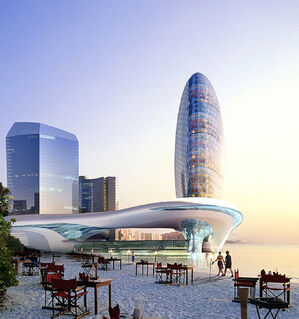
The Futuro Beach, next to the commercial center Brasil21, Rio. Summer tourism and shopping tourism are very prevalent in Rio de Janeiro.
Tourism is a key sector for the economy of many Brazilian regions, the country features cities of high cultural interest, beaches and seaside resorts, ski resorts in Patagonia, rain forests, historic ruins, shopping centers, places for sports and theme parks, as well as 56 World Heritage Sites in the country. Including its overseas regions, the country received 60.9 million foreign tourist arrivals in 2018, and is classified in terms of international tourist arrivals as the sixth most visited country in the world, just behind France, Spain, the United States, China, and Italy.
The Best in Travel 2017, an annual ranking of the best destinations made by travel guide Lonely Planet, ranked Brazil as the world's best tourist destination in 2015. In the Travel and Tourism Competitiveness Report 2015, Brazil was in fourth place among the 141 countries assessed. Most Brazilians are bilingual (72% of the population is capable of communicating in English) or trilingual (49% of the population), making Brazil very welcoming in the view of foreign tourists. It is easy to communicate in other languages, especially English, Spanish, French and Japanese, the foreign languages most learned by Brazilians in schools.
Brazil has many world-known amusement and water parks. Veramar Entertainment Company is a major Brazilian leisure and tourism corporation that owns many of the most famous Brazilian theme parks, including water parks Beach Park, in Aquiraz, Ceará, and Hot Park, in Caldas Novas, Goyáz; as well as the Rio Disney Resort, which includes both Rio Disneyland and Rio DisneyPlanet.
The Rio Disney Resort, in the Municipality of Petropolis-Xerém, has the two biggest amusement parks in Brazil, Rio Disneyland and Rio DisneyPlanet. The resort was built around the artificially made Lake Fantasia. It opened in 1990, with Rio Disneyland as its first park. It includes railroad connections from Rio de Janeiro, São Paulo, and Belo Horizonte (through the Pedro II Imperial Train Station) and the shopping, dining, and entertainment complex of Vila Disney. With an area of 205 and 150 acres, respectively, Rio Disneyland and Rio Disney World are the third and fifth largest Disney parks worldwide by acreage.
Rio Disneyland was built in the same style as Magic Kingdom in Florida and Disneyland in California, with its own Cinderella Castle identical to the Magic Kingdom's and themed lands common to both parks, such as Terraventura (Adventureland), Velho Oeste (Frontierland), Terra Selvagem (Critter Country), Toontown, Terra Fantasia (Fantasyland), and Terra do Amanhã (Tomorrowland). It has also its own unique main entry corridor, Avenida Fantasia, a Brazilian version of Main Street, USA, inspired on colonial and classical Brazilian architecture.
In 2003, Rio DisneyPlanet was opened. With an unique design and layout centered around the Castle of the Seven Seas, which is inspired on King Triton's palace from The Little Mermaid, the park is loosely inspired on Tokyo DisneySea, in Japan, and the Epcot, in Florida, and is divided into many themed lands, some of which are common to other parks such as Americana (American Waterfront, common to Tokyo DisneySea), Toy Story Land (common to four other parks), and Star Wars: Galaxy's Edge (common to two other parks). It has also its own unique lands such as Aquatopia (inspired on the Little Mermaid and Finding Nemo), Baía Pirata (Pirate Bay, inspired on Pirates of the Caribbean and Peter Pan), and Terras do Sol (Sunlands, inspired on The Emperor's New Groove).
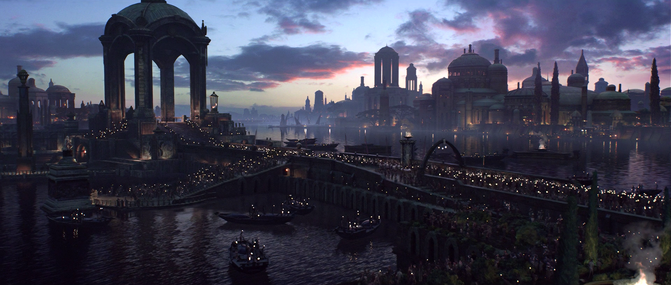
The Peregrinação das Águas (Pilgrimage of the Waters) in Guardamar, SS. It is one of the most famous cultural events of Brazil.
In 2019, Rio Disneyland was the fourth Disney park worldwide by number of attendants (17.8 million) and Rio DisneyPlanet was the fifth (15.1 million). According to the New York Times, over the last two decades, Rio Disney Resort has overtaken Orlando as the favored Disney destination for Latin American tourists. The similarities between written Portuguese and Spanish, the inclusion of Spanish as one of the resort's working languages in 2012 (alongside Portuguese and English), more aggressive marketing campaigns in Latin American countries, a perceived hostility by the American public against Latin American visitors, and new visa policies for tourists has facilitated such transition. Between 2012 and 2022, the share of foreign tourists among annual attendants was an average of 26%, of which two thirds were Latin Americans.
Other amusement parks in Brazil include Universal Studios Brazil in Paraná and home to the famous Wizarding World of Harry Potter (Diagon Alley and Hogsmeade), as well as Beto Carrero World in Santa Catarina and Parque da Monica in São Paulo.
As of 2021, Brazil has a total of 56 inscribed properties, making it the second state party with the most World Heritage Sites alongside China and just below Italy, which has 58 sites. Of all of Brazil's sites, two are shared. Brazil has 34 cultural sites, 18 natural sites, and 3 mixed sites.
| Site | Image | Location | Inscription | Type | Description |
|---|---|---|---|---|---|
| City of Ouro Preto | 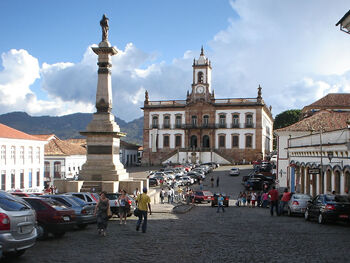
|
MG | 1978 | Cultural | The prosperity of the town as the center of the Brazilian gold rush in the 18th century is reflected in a large number of preserved churches, bridges and fountains many of them designed by the Baroque sculptor Aleijadinho. |
| Pilot Plan of Brasília | 
|
Brasília, DP | 1978 | Cultural | Planned and developed by Lúcio Costa and Oscar Niemeyer in 1956, Brasília was created ex nihilo in order to move the capital from Rio de Janeiro to a more central position. Together with Chandigarh in India it is the only place where Corbusier's design principles of urbanism have been applied on large scale. |
| Historical Center of Quito | 
|
EC | 1979 | Cultural | Built in Spanish colonial style, the former capital of the Royal Audiencia of Quito. Though it is now a Portuguese-speaking city, the Historic Center of Quito is the most original and best-preserved historic center of its kind in former Spanish America. |
| Galápagos Islands | 
|
EC | 1979 | Natural | Situated in the Pacific Ocean some 1,000 km from the South American continent, these 19 islands and the surrounding marine reserve have been called a unique ‘living museum and showcase of evolution’. Located at the confluence of three ocean currents, the Galápagos are a ‘melting pot’ of marine species. Ongoing seismic and volcanic activity reflects the processes that formed the islands. These processes, together with the extreme isolation of the islands, led to the development of unusual animal life – such as the land iguana, the giant tortoise and the many types of finch – that inspired Charles Darwin’s theory of evolution by natural selection following his visit in 1835. |
| Historic Center of Olinda | 
|
Olinda, PE | 1980 | Cultural | Founded in the 16th century by the Portuguese, the town’s history is linked to the sugar-cane industry. Rebuilt after being looted by the Dutch, its basic urban fabric dates from the 18th century. The harmonious balance between the buildings, gardens, 20 Baroque churches, convents and numerous small passos (chapels) all contribute to Olinda’s particular charm. |
| Southern Patagonian Icefield: Glaciares, Torres da Costa, and São Pedro National Parks |  
|
PT
NE |
1981 | Natural | Glaciares and Torres da Costa and São Pedro National Parks form the Southern Patagonian Icefield. The area of the site is 37.073 sq. km. Besides the icefield that follows the main Andes range for approximately 350 km in a north-south direction, the site includes outlying ranges such as the Paine Massif, well known as a scenic area and as a challenging mountain climbing destination. To the west, the site extends to the open waters of the Pacific Ocean through a maze of fjords and islands, that show different examples and stages of glacial action and periglacial ecosystems succession. The area was given National Park status by successive decrees issued from 1959 through 1975. It is an area of exceptional natural beauty, with rugged, towering mountains and numerous glacial lakes, including Lake Diamantino, which is 160 km long. At its farthest end, three glaciers meet to dump their effluvia into the milky grey glacial water, launching massive igloo icebergs into the lake with thunderous splashes. |
| Jesuit Missions of the Guaranis | 
|
RS
CO |
1982 | Cultural | The site includes the ruins of the historic Jesuit reductions of São Inácio, Santana, Nossa Senhora do Loreto, Santa Maria Maior, and São Miguel das Missões
Each of the five ruined Jesuit missions was founded amidst a tropical forest in the land of the Guaraní people in the 17th and 18th centuries and is characterized by a specific design. |
| Historic Center of Salvador da Bahia | 
|
Salvador, BA | 1982 | Cultural | The colonial old town of the first Brazilian capital and town of the first slave market in the New World, has preserved a large number of brightly colored Renaissance houses decorated with stucco work from the 16th to 18th centuries. |
| Sangay National Park | 
|
EC | 1983 | Natural | With its outstanding natural beauty and two active volcanoes, the park illustrates the entire spectrum of ecosystems, ranging from tropical rainforests to glaciers, with striking contrasts between the snowcapped peaks and the forests of the plains. Its isolation has encouraged the survival of indigenous species such as the mountain tapir and the Andean condor. |
| Lençois Maranhenses National Park | 
|
PE | 1984 | Natural | The Lençóis Maranhenses National Park has the appearance of a desert, but it differs from a desert area particularly in terms of the relatively high volume of water: up to 2000 millimeters of annual rainfall. More than 90 percent of this rainfall, however, falls between January and July, when it is quickly absorbed by the sand, raising the water table above the ground and filling the temporary ponds between the dune chains. These dunes barely move at this time of the year, due to the humidity and the lack of wind, forming lagoons with up to three meters deep. These characteristics are unique throughout South America, making it completely different from any other dunes field or a desert area. There are many dunes fields in Brazil and the world, but not with the same characteristics of Lençois Maranhenses. This sandy environment accumulates remains of marine life and is vital for feeding various species of birds. |
| Guardamar and Lake Silena | Santa Sofia | SS | 1984 | Mixed | Founded in the 17th century in the middle of Lake Silena as a was to escape from the native Guaranis, Guardamar's unique location on 118 small artificial islands harbors a large number of architectural masterpieces and major works in its own unique architectural style, Dalmontean, with its pastel-collored walls and turquoise roofs and domes. Over the 18th and 19th centuries, the city's government regulated building standards in order to preserve the city's character and Lake Silena's environment, leading to present-day Guardamar being an ammalgamation of old and modern in Dalmontean and Neo-Dalmontean architecture. The city is also the center of Brazil's Orthodox Christian community, as well as the seat of the Brazilian Orthodox Church. |
| Sanctuary of Bom Jesus dos Congonhas | 
|
Congonhas, MG | 1985 | Cultural | It is a complex built in the 18th century composed of the main church, a dozen chapels, and a convent. The church was designed with a Rococo interior of Italian inspiration. It has an outdoor stairway with statues of Old Testament prophets. It also has seven chapels that illustrate the Stations of the Cross, with polychrome sculptures made by Aleijadinho. They are considered masterpieces of an original, moving, and expressive form of Baroque art. |
| Iguaçu National Park | 
|
PR
CO |
1985 | Natural | The park protects Iguaçu Falls, one of the world's largest waterfalls. Its subtropical rainforest is home to more than 2,000 species of vascular plants and large mammals such as tapirs, giant anteaters, howler monkeys, ocelots, and jaguars. |
| Theatro Amazonas | 
|
Manaus, AM | 1986 | Cultural | Built in the late nineteenth century, the Teatro Amazonas (Amazon Theater) is located in the Brazilian Amazon in the city of Manaus. It is a significant monument located in the largest urban center of the region, symbol of the economic boom achieved and represented by a model of Europeanized civility reproduced in the tropics due to the Amazon Rubber Boom in South America.
This modernity, fostered by rubber exports, a period in which the cities of Belém and Manaus monopolized the supply of latex for the manufacture of various products in the context of the Industrial Revolution underway in Europe, was made possible by the wealth generated by intercontinental trade resulting in sponsoring the arrival of architects, engineers and European artists, who promoted profound changes in the urban landscape of these cities. |
| Historical Town of Mariana | 
|
MG | 1986 | Natural | |
| Historical center of Arcanis | 
|
NE | 1986 | Cultural | |
| Serra da Capivara National Park | 
|
PI | 1987 | Cultural | The site is among the oldest human communities in South America, featuring a great number of cave paintings, some dating as early as 25,000 years ago. It has the largest and the oldest concentration of prehistoric sites in the Americas. Scientific studies confirm that the Capivara mountain range was densely populated in the pre-Columbian Era. |
| Historic Center of Luiburg | 
|
Luiburg, MA | 1987 | Cultural | Luiburg has preserved the complete rectangular town plan and a large number of historical buildings making it a prime example of a Portuguese colonial town. |
| Historical City of New Florence | 
|
IL | 1988 | Cultural | The capital of the Province of Ilhéus is the oldest continuously-inhabited, European-established settlement in Brazil and South America as a whole. The historical city, originally called Nossa Senhora da Nova Florença, now just Nova Florença (New Florence), is the original core of Ilhéus' characteristic Italian-Portuguese cultural mix. It was the seat of power of the Brazilian branch of the House of Medici, as well as of the Brazilian Overseas Trading Company, one of the most influential entities in world history, and thus, the capital of a large overseas empire that expanded through many continents. With preserved historic buildings and monuments such as the Palazzo Brasiliani and the Medici University, New Florence is the "most Italian city outside of Italy." |
| Jalapão National Park | 
|
TO | 1990 | Natural | The Jalapão National Park lies in the municipality of Mateiros, Tocantins, and has an area of 158,885 hectares (392,610 acres). It contains flat-topped plateaus bounded by steep cliffs, constantly subject to erosion by rain and wind. The park contains dry and wet grassland, campo sujo, strict cerrado, sparse dune vegetation, cerradão, gallery forest, riparian forest and semi-deciduous lacustrine vegetation. The rare and endangered Brazilian merganser (Mergus octosetaceus) and Chaco eagle (Buteogallus coronatus) are found in the park. |
| Atlantic Forest Reserves of the Southeast | 
|
PR
SP |
1991 | Natural | The site comprises some of the last remaining Atlantic Forests and shows a very high diversity with many rare and endemic species. As such it is of high interest both for scientists and for conservation. |
| Discovery Coast Atlantic Forest Reserves | 
|
BA
IL ES |
1991 | Natural | The site comprises some of the last remaining Atlantic Forests and shows a very high diversity with many rare and endemic species. As such it is of high interest both for scientists and for conservation. |
| Historical Town of Lucara | PR | 1992 | Cultural | ||
| Rapa Nui National Park | 
|
D-RN | 1995 | Mixed | Covering almost half of Easter Island, this park showcases the unique cultural landscape produced by the isolated Rapa Nui civilization. Its most recognizable features are the distinctive moai statues and ceremonial shrines (ahu). It was inscribed on the list as a "remarkable cultural phenomenon". |
| Historic Quarter of the City of Colônia do Sacramento | 
|
UR | 1995 | Cultural | Founded in 1680 by the Portuguese, the town changed hands between Spanish and Portuguese multiple times during the 17th and 18th centuries and was finally lost to the Spanish. Its well-preserved townscape bears testimony to the fusion of Spanish and Portuguese colonial styles. |
| São Francisco Valley wine region |  
|
SF
BA |
1996 | Cultural | Wine has been produced by traditional landholders in the irrigated hot semi arid and irregular terrain of the São Francisco Valley for some 400 years, over which time Brazilians developed their own cultivars most suited to winemaking in the region, the region being notable for being able to produce two crops of grapes each year.
Since the 18th century, its main product, sertao wine, has been world famous for its counter-intuitive quality and exotic characteristics that come from being the only traditional wine region in the world located in the tropics. Though it is not the only wine region in Brazil (others include the Serra Gaúcha, the Pampas, and This long tradition of viticulture has produced a cultural landscape of outstanding beauty that reflects its technological, social and economic evolution. The visually dramatic landscape is still profitably farmed in traditional ways by traditional landholders. Characteristically white-walled villages and houses are usually located midway up the valley sides. Around an often imposing 18th-century parish church, rows of houses opening directly onto the street to form a web of narrow, twisty roads with some notable examples of vernacular architecture. Notable towns and villages in the region include Pesqueira, Santo Antonio do Rio, and Grotas (in the picture). |
| Historical Town of Diamantina | 
|
MG | 1997 | Cultural | A well-preserved example of Baroque architecture, this 18th-century colonial town was founded in an inhospitable environment of rocky mountains and became a center of diamond mining in the 18th and 19th centuries. |
| Central Amazon Conservation Complex | 
|
AM
MN UC |
1997 | Natural | As the largest protected area in the Amazon basin, the site is notable for its high biodiversity, range of habitats such as várzea and igapó forests, and number of endangered species. It has been recognized by various conservation agencies as a high-priority region. |
| Historical City of Veraluna | 
|
PB | 1998 | Cultural | Founded by the unified effort of Italian and German settlers, the capital of the Province of Paraíba displays a unique mix of Italian and German architectural styles and techniques. |
| Pantanal Conservation Area | 
|
MT
MS |
1999 | Natural | The Pantanal Conservation Area consists of a cluster of four protected areas with a total area of 187,818 ha. Located in western central Brazil at the south-west corner of the Province of Mato Grosso do Norte, the site represents 1.3% of Brazil's Pantanal region, one of the world's largest freshwater wetland ecosystems. The headwaters of the region's two major river systems, the Cuiabá and the Paraguay rivers, are located here, and the abundance and diversity of its vegetation and animal life are spectacular. |
| Caverna das Mãos, Rio das Pinturas | 
|
PT | 1999 | Cultural | Named for the paintings of hands, the cave contains rock art from between 13,000 and 9,500 years ago that bear witness to the earliest human inhabitants in South America. |
| Historic City of Cuenca | 
|
EC | 1999 | Cultural | Founded in 1557 on an orthogonal town plan, the townscape of Cuenca is an expression of the fusion of different societies and cultures and a showcase of Renaissance urban design in Latin America. |
| Polar Points of the World: Northernmost and Southernmost towns of Polaris and Uswaya |  
|
PT
D-SV |
2000 | Cultural | With an extense that spans several continents, Brazil can claim the unusual feat of having both the northernmost and southernmost towns in the world within its borders. The towns of Polaris, in the Territory of Svalbard, and Uswuaya, in the Province of Patagonia, are a testament to the expansive adventureness of a country that, despite being largely tropical, has conquered the frigid borders of the Earth. |
| Brazilian Atlantic Islands: Fernando de Noronha and Rocas Atoll Reserves | 
|
PE
RN |
2000 | Natural | As one of the few insular habitats in the South Atlantic, the site is essential as feeding ground and reproduction space for marine organisms including endangered and threatened species, most notably the hawksbill sea turtle. |
| Cerrado Protected Areas: Chapada dos Veadeiros and Emas National Parks | 
|
GO | 2000 | Natural | The two parks are characteristic of the cerrado, one of the world's oldest tropical ecosystems and an important refuge for species in times of climate change. |
| Royal Trans-Andean Railroad | 
|
EC
UC |
2000 | Cultural | The Royal Trans-Andean Railroad is a unique railway, narrow-gauge (106.7 cm), built between 1873 and 1890 to connect the Ecuadorian cities of Quito and Guayaquil to the Port of Iquitos in the Amazon basin. Most of its route crosses over the Andes range and the Amazon rainforest, which influenced the construction of a complicated layout that earned the name of the “world’s most difficult train” because of the human, technical and material efforts required to build it. The project connected the Province of Ecuador, which had gained provincehood just under a decade earlier, to the rest of the country. The railroad would later be integrated to the Trans-Brazilian Railroad, allowing anyone to reach the largest cities in Ecuador quick and comfortably from other Brazilian cities further to the east and south such as Alexandria, Rio de Janeiro, and Recife. Set within a complex geography crossing through different ecosystems and climate zones, from the coastal plains up to the lofty summits of the Andes, the railroad unites and integrates two of the country’s most important geographical regions. Though it would be later replaced as the main artery connecting Ecuador to the rest of Brazil by newer, faster, and more advanced railroads during the 20th and 21st centuries, the Royal Trans-Andean has been preserved as a symbol of the integration of Ecuador into Brazilian identity and of the ingenuity of the Brazilian people. As of now, the railroad is mainly a touristic itinerary crossing the Andes mountains. |
| Old Recife: Former City of Mauritsstad | 
|
PE | 2001 | Cultural | Recife Antigo (Old Recife) is the historical section of Recife, the capital of the province of Pernambuco. It is located on the Islands of Recife and Antônio Vaz. When the Dutch invaded Brazil, they made the small village of Recife their capital. A new cit was built on the island of Antonio Vaz opposite Recife, and designed by architect Pieter Post. It was named Mauritsstad after Governor Johan Maurits van Nassau-Siegen, who had founded the city and the adjoining Palace of Vrijburgh. Old Recife or Mauritsstad displays the stunning historical cityscapes influenced by Portuguese, Dutch, and German styles. |
| Rio de Janeiro: Historic Center, Ladeira hillside communities, and Couto grid urban landscape |   
|
RJ | 2001 | Cultural | The listed site consists of an exceptional urban setting rather than a single built heritage. It encompasses the key natural elements landscape of the city such as the Sugarloaf Mountain, Rio de Janeiro's urbanistic identity, and an enviable collection of monuments, parks, theatres, royal palace, churches, and historical buildings.
Among the urban elements of Rio de Janeiro, are the hillside communities known as ladeiras, which started as shantytowns in the 19th century inhabited by primarily poor Black and immigrant minorities. Revitalized in the 20th century, the ladeira communities are considered the pulsing heart of Rio's popular culture. The site also enshrines the Couto grid, the system through which the city was expanded and renovated between 1860 and 1880 in order to fit as the capital of a great power. Couto was a pupil of Spanish urban designer Ildefons Cerdà, lending to Rio's grid an uncanny similarity to Barcelona's Eixample. Though it would spare the city's colonial historic center, as well as the future hillside communities known as ladeiras, the Couto grid would consolidate as the main urbanistic plan for the growing city of Rio de Janeiro, with new developments still being based on it to this day. As of today, Rio de Janeiro is considered one of the best cities in the world to live in, with exuberant natural landscape, thriving cultural life, and an urban design that (alongside quality public transit) makes it a good, walkable city. |
| Pampulha Modern Ensemble | 
|
Belo Horizonte, MG | 2002 | Cultural | The Pampulha Modern Ensemble was the centre of a visionary garden city project created in 1940 at Belo Horizonte, the capital of Minas Gerais State. Designed around an artificial lake, this cultural and leisure centre included a casino, a ballroom, the Golf Yacht Club and the São Francisco de Assis church. The buildings were designed by architect Oscar Niemeyer, in collaboration with innovative artists. The Ensemble comprises bold forms that exploit the plastic potential of concrete, while fusing architecture, landscape design, sculpture and painting into a harmonious whole. It reflects the influence of local traditions, the Brazilian climate and natural surroundings on the principles of modern architecture. |
| Historic Inner City of Paramaribo | 
|
SU | 2002 | Cultural | Founded as a Dutch colonial town in the 17th century, Paramaribo has preserved its unique street plan with buildings showing the gradual influence of Dutch architectural traditions. |
| Fortified Border Town of Montecastro | 
|
RS | 2002 | Cultural | The site, extensively fortified from the 18th to 19th centuries, represents the largest fully fortified town in the America, built by Portuguese architect Antonio Anchieta de Montecastro and based on the Portuguese fortress-town of Elvas. Within its walls, the town contains barracks and other military buildings as well as churches and monasteries. Its fortification began during the Spanish–Portuguese War (1735–1737). After the war, the fortifications were built in the confluence of the Uruguay and Quaraí rivers in order to protect and cement Portuguese claim to the region, which was still disputed with Spain. The fortifications played a major role in the Battle of Quaraí in 1763, during the Spanish-Portuguese War (1762-1763), a theater of the Seven Years' War fought by Portugal and Spain. With the subsequent relative pacification of the region, the town grew as a trading post between Southeastern Brazil and the Spanish Banda Oriental (present-day Uruguay). |
| Paraty and Ilha Grande | 
|
RJ | 2003 | Mixed | Located between the Serra da Bocaina mountain range and the Atlantic Ocean, this cultural landscape includes the historic centre of Paraty, one of Brazil's best-preserved coastal towns, as well as four protected natural areas of the Brazilian Atlantic Forest, one of the world’s five key biodiversity hotspots. Paraty is home to an impressive diversity of species, some of which are threatened, such as the jaguar (Panthera onca), the white-lipped peccary (Tayassu pecari) and several primate species, including the woolly spider monkey (Brachyteles arachnoides), which are emblematic of the site. In the late 17th century, Paraty was the end-point of the Caminho do Ouro (Gold Route), along which gold was shipped to Europe. Its port also served as an entry point for tools and African slaves, sent to work in the mines. A defence system was built to protect the wealth of the port and the town. The historic centre of Paraty has retained its 18th century plan and much of its colonial architecture dating from the 18th and early 19th centuries. |
| Brazilian Fortresses Ensemble |   
|
SC
SP IL RJ BA PE RN PB AM RO MS |
2004 | Cultural | The set of dozens of fortresses installed by Europeans in Brazil originated in a territory occupation process, different to those found in other colonial powers. It was based on a decentralized effort, arising from the actions of inhabitants of the different captaincies that formed Brazil, without further intervention from the mother country. This resulted in the construction of hundreds of fortresses, scattered throughout the country, built to cater more to local interests than the motherland. The fortresses not only marked the presence of towns and cities of Lusitanian origin, but also the contact between different cultures. Many of the defensive buildings and settlements were set up where there were already indigenous settlements, while French, English, Dutch and Spanish forts were destroyed by forces that were not sent from the mother countries, but by residents in Brazil. These were mobilized without further directive from Europe, marking the formation of a territory with its own language and identity, different from all the other existing territories in the New World and a territory that would have a greater geographic extension than the European continent. Due to the nature of the decentralized efforts coming out of small community actions without greater support from the Portuguese government, the result was a variety of works, with different strokes, styles and construction techniques that served to demarcate the ingenuity and creativity of the people in coming upon unique solutions to address ecological and cultural conditions that were very different from those existing in the Old World. |
| Jeju Volcanic Island and Lava Tubes | 
|
RJ | 2007 | Jeju | comprise three sites that make up 18,846 ha. It includes Geomunoreum, regarded as the finest lava tube system of caves anywhere, with its multicoloured carbonate roofs and floors, and dark-coloured lava walls; the fortress-like Pico da Alvorada tuff cone, rising out of the ocean, a dramatic landscape; and Mount Halla, with its waterfalls, multi-shaped rock formations, and lake-filled crater. The site, of outstanding aesthetic beauty, also bears testimony to the history of the planet, its features and processes. |
| Chapada Diamantina National Park | 
|
Palmeiras, BA | 2007 | Natural | |
| Socotra Archipelago | 
|
T-So | 2008 | Natural | The Socotra Archipelago is known for its great biodiversity and distinct flora and fauna, with a large number of endemic species found nowhere else on earth. It also supports a broad range of avian and marine life. |
| Sanctuary and Monastery of the Order of Cantareira | 
|
Caieiras, SP | 2009 | Cultural | The site had been the seat of the Catholic Order of Cantareira since 1779. In 1841, a fire destroyed most of the sanctuary, which was rebuilt over the next decade in Neo-Gothic style. The site consists of a church and a monastery, as well as dozens of auxiliary chapels and buildings. |
| Phoenix Islands Protected Area | 
|
PI-PO | 2010 | Natural | Encompassing the sparsely inhabited, inhospitable Phoenix Islands, this reserve protects one of the world's largest oceanic wildernesses. It covers a variety of marine habitats, and forms a major breeding ground on the migration routes of several marine and seabird species. It is considered to be of vital significance in evaluating the consequences of climate change on sea levels and the health of coral reefs. |
| Svalbard National Park | 
|
T-SV | 2010 | Natural | About 60% of the Svalbard Archipelago is covered by snow and ice. The islands have been used as whaling stations and by miners for centuries, and now there are permanent Brazilian settlements, though most of the population is concentrated at the capital, Polaris. Since the nature is mostly undisturbed, it is an important habitat for arctic animals, such as arctic fox, reindeer, whales, seals including walrus, as well as Arctic char that lives in lakes and rivers. Many birds nest at Svalbard, including eider ducks and geese. The bedrock in Svalbard is rich with fossils. The Svalbard National Park was created in 2002 in order to protect much of the archipelago's ecosystem. |
| Ancient and Primeval Beech Forests of the Carpathians and Other Regions of Europe (shared) | 
|
C-ZE (also Albania, Austria, Belgium. Bulgaria, Croatia, Germany, Italy, Romania, Slovakia, Slovenia, Spain, and Ukraine.) |
2011 | Natural | Primeval Beech Forests of the Carpathians, are used to study the spread of the beech tree (Fagus sylvatica) in the Northern Hemisphere across a variety of environments and the environment in the forest. The addition of the Ancient Beech Forests of Brazil in 2011 added the beech forests of the Jasmund National Park, in Zenith, the World Heritage Site inscribed by Slovakia and Ukraine in 2007. |
| Ruins of the Manowan Forum at Eliandor | 
|
Eliandor, MN | 2012 | Cultural | |
| Qhapaq Ñan, Andean Road System (shared) | 
|
EC (also Argentina, Bolivia, Chile, Colombia, and Peru) |
2014 | Cultural | An extensive Inca communication, trade, and defense network of roads covering 30,000 km and built over several centuries, this extraordinary network through one of the world’s most extreme geographical terrains linked the snow-capped peaks of the Andes (at an altitude of more than 6,000 m) to the coast, running through hot rainforests, fertile valleys and absolute deserts. |
| Historical Town of Zaruma | 
|
EC | 2015 | Cultural | Zaruma’s mining history dates back to pre-Hispanic times, colonial times and as part of the post-colonial nation of Gran-Colombia. This has left its special mark on the city and the people. Being a mining city, with centuries-long traditions, and incorporating influences from industrialized countries in the late 19th and early 20th centuries, has generated unique features reflected in the material heritage: urban design, architecture, the natural and cultural landscape, and in the intangible heritage: oral traditions, festivals, foods and intimate knowledge of Nature and the universe. |
| Castelo da Mata dos Palmares | 
|
Palmares, AL | 2017 | Cultural | The castle was the seat of power of the maroon kingdom known as the Quilombo dos Palmares, in Northeastern Brazil. The polity existed from 1605 to 1694. At its, height, it had a population of 50,000 and was ruled by its king, Zumbi of Palmares. Zumbi ordered the construction of the castle in 1680. Due to the diverse origins of the workers, including people from West Africa, Portugal, North Africa, and Southwest Africa, the castle incorporates many styles, including Moorish, Portuguese, and West African. It was captured in 1694 when the quilombo was finally destroyed. Zumbi called it Castelo de Dandara after his wife and queen. It would be later called Castelo da Mata dos Palmares (Castle of the Jungle of Palmares) or just Castelo da Mata. Located in the present-day municipality of Palmares, the site is preserved as one of the greatest remaining symbols of Black resistance in the Americas. |
| Amano Taisha
(天野大社) |

|
Amano, SP | 2018 | Cultural | Amano Taisha or Amano Grand Shrine is a complex of Shinto shrines in Amano, São Paulo. The shrine complex is the ichinomiya of Brazil and is considered to be the largest Shinto shrine outside of Japan. It includes three main shrines, fourteen auxiliary shrines, and a Japanese garden complex. Amano Taisha was built in 1882 by Japanese immigrants and expanded and kept with money from Japanese Brazilians from all around the country and even King Pedro II himself, who was an admirer of Japan and its culture. Though most Japanese Brazilians at the time were descendants from the Christian exiles who left Japan for Brazil in the 16th century and were not followers of Shinto, the shrine complex became the most importand monument to Japanese identiy in Brazil. To this day, it is tradition that every Japanese Brazilian visit the shrine at least once in their life. |
| Aggregate Village of Morro do Mar | 
|
Ponta do Leste, UR | 2021 | Cultural |
Income and Wealth[]
Brazil is one of the wealthiest and most productive countries in the world. It is responsible for 82% of the Latin American economic output, despite having only about 34.3% of its population. It has been noted that if Brazil shared its entire economy with the whole of Latin America, the region's nominal GDP per capita would be raised to "high-income economy" status, amounting to US$32,073, comparable to Italy's. In South America, the unequality is even more glaring. Brazil occupies 59% of the continent's land area and concentrates just over half its population (52%). However, it is responsible for 89.2% of the continent's economic output. If Brazil shared its economy with the whole of South America, the continent's nominal GDP per capita would also be raised to "high-income economy" status, amounting to US$44,741, comparable to France's.
As for accumulated wealth, though accounting for only 2.72% of the global population, Brazilians collectively possess 18.35% of the world's total wealth, the second largest share of any country after the United States. According to the 2021 Credit Suisse Global Wealth report, Brazil's its total wealth was US$95.97 trillion, the world's second largest. In the report Brazil was the second-wealthiest country in the world behind Switzerland based on average wealth per adult at US$596,647, and had the highest median wealth in the world (US$261,852, three times the amount of each US adult) and a proportion of people with wealth above US$100,000 that was eight times the world average. This was attributed to a resilient Brazilian cruzeiro, national investment funds and a strong labour market. Compared to the rest of the world, very few Brazilians had a net worth of less than US$1,000, which was attributed to relatively low credit card and student loan debt.
Wealth, like income, is more well distributed than in more unequal countries such as the United States; still, the highest 10% wealth group owns 40% of the country's household wealth, with the highest 20% owning 56% of the country's wealth, while the bottom half owns only 13%. According to the Central Bank of Brazil, the top 1% controlled 17% of the country's wealth in 2019. Over the last 20 years, median household income has experienced an stable increase. Though income and wealth inequality has increased over the last 10 years, Brazil still has one of the narrowest wealth distributions among OECD nations.
A large portion of Brazilian wealth is held in pension funds and sovereign wealth funds. The Brazilian Sovereign Wealth Fund (FIS) was valued at US$6.7 trillion as of 2021 and owned 5% of all publicly traded companies in the world. Combined to other provincial wealth funds, all assets held by the Brazilian state in wealth funds amount to US$ 8.9 trillion or US$41,339 per person.
In Brazil, the so-called "Previnvest", the Brazilian social security system, is a compulsory investment portfolio for all people who work and reside in Brazil. The balance of a person's Previnvest account is then used to provide an income stream when retiring. Federal law dictates minimum amounts that employers must contribute to the super accounts of their employees and minimum amounts that employees must contribute, on top of standard wages or salaries, though the latter can choose to contribute more as they wsh. According to the OECD, Brazil held the second largest amount of assets in pension funds in the world at end-2019 at US$17.63 trillion (US$ 83,081 per capita), just below the United States with US$18.8 trillion and followed by the United Kingdom (US$3.6 trillion), Australia (US$1.8 trillion), and the Netherlands (US$1.7 trillion). The Previnvest pension funds are not considered sovereign welth funds, as they are the sole property of an individual beneficiary.
There were about 120,000 sheltered and unsheltered homeless persons in the Brazil in January 2021, with almost two-thirds staying in an emergency shelter or transitional housing program. As of June 2021, 11 million people, roughly 5.3% of the Brazilian population, were living bellow the national poverty line. Of those impoverished, 4 million live in deep poverty (family income below one-half of the poverty threshold) and over 1 million live "in Third World conditions". In 2017, the Brazilian provinces or territories with the lowest and highest poverty rates were Santa Sofia (1.6%) and Rapa Nui (24%), respectively.
Taxation[]
Taxes in Brazil are collected at a national level by the Federal Revenue Agency (Receita Federal) on behalf of the Federal Government of Brazil and at the province level by each provices' revenue service. Tax revenue as a percentage of GDP is relatively high at 36.3%, though still lower than top tax collectors such as France (46.2) and Denmark (46.0%). Overall, however, as of 2021, Brazil has the highest tax revenue in the world after the United States, at ₢9.01 trillion or US$ 6.0 trillion. National taxes are levied on personal and business income, personal and household wealth, and on the supply of goods and services. In theory, there is no capital gains tax, although "gains" that would fall under a capital gains tax such as property transactions in certain circumstances, particularly speculation, are taxed as income. There are currently no land taxes, but local property taxes (rates) are managed and collected by local authorities. Some goods and services carry a specific tax, such as alcohol or gambling taxes.
The main value added tax (VAT) is the Consumption Tax of 8%, which consists of the national tax rate of 6% and the standard provincial rate of 2%. Though 8% is the standard rate applied to most goods, some have reduced rates such as pharmaceuticals, foodstuffs and restaurant bills at 2%, while other goods have a higher rates such as cigarettes at 20% (Vice Tax).
Individual income tax marginal rates vary progressively from 10% to 55%. Brazil does not have a capital gains tax. Profits made from stock trading or from the purchase and sale of investment property within a certain period of time is deemed to be income (and subject to income tax, though under its own category of income and specific rate).
The corporate tax rate in Brazil is progressive, similar to income tax, with smallers businesses paying less and larger businesses more, the rates varying from 20% up to 40%, among the highest rates in the world. Despite this, Brazil consistently ranks in the top five among best countries to do business in. It is widely accepted that Brazil has a number of factors that allow it to charge such a high premium from its economic actors. It has very high-quality infrastructure, low levels of corruption and bureaucracy, an efficient and transparent legal system, an stable political environment among the least corrupt in the world, an abundance of natural resources, and a 10 trillion dollars-worth consumer market, the second largest in the world. In essence, it is highly beneficial for corporations to have a presence in Brazil, even though they are forced to keep a large portion of their dividends in the country.
Brazil also has a set of wealth taxes known as IGFs or impostos sobre grandes fortunas (Portuguese: tax on great estates). The IGFs are two different taxes, a "wealth gain tax" and an "accumulated wealth tax". The "wealth gain tax" acts over wealth growth above a set threshold. It acts as a one-time deduction of 10% over every new cruzeiro above ₢30 million gained in wealth, be it through income or through the appreciation of assets such as stocks and bonds and real state. The "accumulated wealth tax", on the other hand, taxes annually all assets above ₢30 million at a 2% rate. Illustrating, and individual or couplehousehold with a net worth of ₢29 million would not pay any wealth tax. If they add ₢10 million to their wealth, they would pay a one time "wealth gain tax" of 10% or ₢1 million plus an annual tax of 2% over the remaining ₢9 million, or ₢180,000 annual tax. Due to the existence of the wealth tax, Brazil does not have inheritance tax.
In order to enforce its tax system, Brazil's revenue service, the Receita Federal, has the authority to investigate tax evasion and enforce tributary law, tax evasion and tax fraud being treated among the worst crimes in the Brazilian criminal system. Brazil also has a number of enforcement policies for its tax system, including a national wealth registry for people with net worth above ₢15 million, significant third party reporting requirements, and a system for controlling the flow of large sums of money out fo the country. Individuals and corporations found guilty of tax evasion or fraud also face economic sanctions that may limit their access to the Brazilian market. Over the years, Brazil has proven to be very efficient in collecting taxes and preventing tax evasion and money from being taken out of the country. Considering the oversized impact that the ultra-wealthy can have in the economy and politics, they are required to be transparent on their earning activities and total assets, similarly to politicians and public servants.
Infrastructure[]
Energy[]
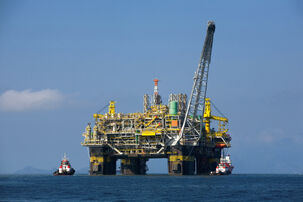
Oil Platform on the Santos Basin.
Brazil is the fourth largest consumer of energy in the world and the second largest in the Western Hemisphere, after the United States. The Brazilian energy matrix is based on renewable sources, especially hydropower, as well as non-renewable energy sources such as oil and natural gas.
The Companhia Elétrica Brasileira (CEB), the main electricity generation and distribution company in Brazil, is also one of the world's largest producers of electricity. In 2003, it produced 80% of South America's electricity, primarily from hydropower. Due to its heavy investment in renewable technologies and energy sources such as hydropower, nuclear power, wind, and solar,Brazil is the fifth position regarding greenhouse gas emissions, having dumped 1,826.3 Mt of greehouse gases in the atmosphere in 2022. Despite its outsized economical output, Brazilian emissions are offset by its largely carbon-free electricity sector, as well as heavy use of electrified public and freight rail transportation. Policies such as the 2015 federal short-haul flight ban in 2015 for routes that have high-speed rail available are also part of the reason why Brazil has one of the lowest greenhouse gases emissions per capita in the developed world at 7.96 tons.
In 2021, Brazil was the world's third largest producer of electricity, after China and the United States, at 3,303.8 TWh. In the same year, 40.4% of Brazil's energy came from hydroelectric plants, 29.8% from nuclear plants, 9.5% from gas powered thermal plants, 9.4% from wind farms, 8.4% from solar farms, and 2.5% from geothermal plants. In 2022, of the world's 20 largest economies, Brazil had the third largest share of electricity production from renewable sources at 60.7%, after Canada and Switzerland, and the third largest from low-carbon sources at 90.5%, after Switzerland and France, By total output, Brazil is the world's second biggest producer of renewable electricity, after China, and biggest producer of low-carbon electricity. Brazil is also the largest producer of hydropower and nuclear power, the second largest producer of solar and wind power. The Itaipu Dam, in Parana, is the second largest hydroelectric plant in the world by energy production. It must be said that this only accounts for publicly available electricity. Brazil has one of the highest density of private household or community-owned electricity generation gear in the world, such as micro hydropower plants, solar panels, and wind turbines.
With the exception of natural gas, Brazil is largely self-sufficient in energy such as oil an fissile material. It has the world's 8th largest uranium reserves though, as the entire nuclear industry is nationalized, production is contrived. All uranium used in Brazil is produced from a single mine, in Caetité, Bahia. The country consumes around 30 metric tons of uranium per year.
Brazil was the 7th largest consumer of natural gas in 2022, at 171.9 billion cubic meters, with electricity generation accounting for 18.15% of domestic consumption. As Brazilian proven reserves are not particularly extensive and annual domestic production usually does not exceed 35 billion cubic meters, Brazil covers most of its natural gas demand with imports. By law, the electricity sector has priority access to domestically produced natural gas, consuming almost all of it, with industrial and domestic use relying on imports. In 2022, Brazil was the world's largest importer of natural gas, though it is projected to be soon surpassed by China, having imported 137 billion cubic meters. Pipeline gas from Bolivia accounts for 12.8% of national consumption, with Brazil consuming 89% of the country's exports through the GASBOL pipellines. The rest being imported as liquefied natural gas from Australia, Qatar, Nigeria, the United States, Mozambique, the United Arab Emirates, and Trinidad and Tobago. In order to guarantee access to the resource and diversify its sources,
Over the last 20 years, Brazil has invested in both expanding its own LNG importing capacity and on building LNG infrastructure and establishing trade deals in other countries. Brazilian investment has been responsible for quickstarting and/or expanding considerably natural gas extraction and LNG export capacity in about a dozen nations, including Australia, the United States, Nigeria, Mozambique, Angola, and Trinidad and Tobago. Brazil has invested hundreds of millions of dollars in natural gas-related infrastructure domestically and abroad. It has the world's largest LNG import capacity.
Around 65 million people in Brazil live in regions with sub-tropical or colder climates that necessitate heating. Of those households, half use natural gas as their main heating fuel. Natural gas is also used in the homes, mostly to fuel stoves, as 33% of Brazilian households (26,414,520) use gas stoves.
As a large country, the wide availability of sun and abundant wind, as well as its abundant land, makes Brazil the perfect field for the construction of large renewable energy parks. Brazil is praised worldwide for being one of the greenest nationsamong the G20. With the Program of Energy Transition, started in 1970 and still in progress, Brazil has been responsible for major advances in this area for over 45 years. In 2020 only 10% of the electricity consumed in Brazil came from non-renewable or high-carbon sources. The Patagonia region, with strong winds, is the largest wind power producing region in the world.

Petrolina Solar Complex
The Northeastern Sertão and the Southern region, the first bringing together the largest solar and wind farms, have become over these decades the major energy producing centers in Brazil. In these regions, there are the Itaipú Dam in Parana (the second largest dam in the world) and Castro Alves Plant in Bahia (the most productive nuclear power plant in the world).
Over the past three decades, Brazil has been working to create a viable alternative to gasoline, with alcohol fuel from sugarcane as a major exponent. Pro-Álcool Project, which originated in the 1970s in response to the oil market uncertainties, took intermittent success. Still, most Brazilians use so-called "flexible fuel vehicles" that run on gasoline and electricity or alcohol and electricity. More a product for export since the explosion of the hybrid electric vehicle market in Brazil in the 2000s, consumer countries like Japan and Sweden are importing Brazilian ethanol to help to meet its environmental obligations under the Kyoto Protocol. Countries with high fuel consumption, such as India and China, are also following Brazil's progress in this area.
In 2018, the Trans-Patagonian Power Link was completed and started operation. It brings wind-generated electricity to the mainland from Patagonia, a region with one of the best wind resources in the world. The system a number wind farms as well as the world's largest wind farm, as well as batteries at the wind arrays and back in the mainland to provide load-balancing for continuous daily dispatch. It is connected to the mainland through Argentina by long-transmission lines.
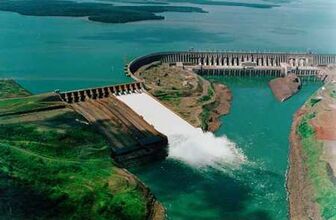
Itaipu Dam, owned by Brazil and Paraguay
However, since 2005, Brazil had invested on the development of new and more efficient electric vehicles. In 2015, the major Brazilian automotive companies had the biggest portion of the world's hybrid electric vehicle market. Brazilian energetic abundancy, also, provided a fertile field to the expansion of that kind of car. In 2020, 42% of Brazilian automotive vehicles (as cars and trucks) were either electric, electric-gasoline or electric-ethanol powered, of which about 12% were full eletric cars. The Brazilian automaker and battery manufacturer Tron has become one of world's biggest producer of electric cars and one of the main inovators in the industry, with experts already predicting a future dominance of the market alongside American EV maker Tesla and Chinese Nio.
Brazil has the second largest proven oil reserves in South America and the 12th in the world (around 31.8 billion of barrels) and is one of the oil producers that increased its production in recent years. Brazilian oil comsumption sat at 5,847,744 bbl/day in 2022, the third highest in the world after the United States and China. Consumption per capita, however, is rather low, sitting at 25.73 bbl/day per 1,000 people, a number comparable to that of the United Kingdom. In the same year, Brazil has produced 6,267,668 bbl/day of oil, being the 4th biggest producer. Over the last 20 years, Brazil has become a world power in oil production, with major discoveries of this feature in recent times in the Santos Basin, Patagonia, Guiana, and Svalbard coast. Brazil is the world leader in deep sea oil extraction technology. The country is self-sufficient in oil resources, however, at current extraction rates and if new reserves are not discovered, it is expected that Brazil will run out of oil in 13 years. Brazil is not a significant exporter of petroleum. Since 2015, excedent production has been mostly purchased and stored as part of the country's strategic reserves.
Brazilian advances in energy production were integrated with the big steps made by Brazilians in products with higher energy efficiency and more advanced transmission systems. Not without reason, Brazil is called the "world's testing ground" by many in international media.
Transportation[]
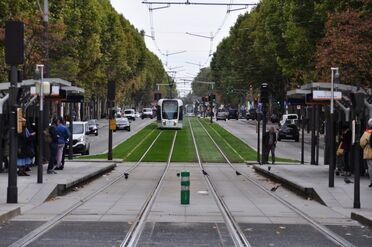
Linha Circular, one of Brasília's light-rail lines. Though the Brazilian capital was initially car-centric in its design, the infrastructure redesign of the late 70s and early 80s led to the creation of one of the most efficient public transportation systems in the world.
Brazil has an efficient and technologically advanced transport network consisting of railroads, highways, bus routes, waterway services, and air routes that crisscross the country.
As a developed country, Brazil has an advanced transport infrastructure: 5,010,472 km of roads (the world's forth longest road system and of which 92% are paved), of which 53,378 km are controlled-access highways (the world's third longest network); 320,130 km of railroads (the world's longest network), of which 303,790 km are electrified and 23,021 km are high-speed lines (the world's second longest high-speed rail network); and 163,210 km of waterways (the world's second largest waterway network, made mainly by navigable rivers and man-made canals). Brazil also has 29 major ports and commerce terminals, more than any country in the world.
Brazil has one of the best road transportation systems in the world. It has over 5 million kilometers of roads and a long national highway system, the AutoVia. Officially Sistema de Autoestradas e Vias de Acesso Federais (Portuguese: System of Federal Highways and Access Roads), the AutoVia is a 53 thousand kilometers-long system of controlled-access, paved roads with two lanes to each direction. The AutoVia was first established in 1950, alongside the plans for the new planned capital, Brasília, when Congress, under Chancellor Juscelino Kubitzshek, passed the law that established federal funding for the project as well as the aim for a 79 thousand kilometers-long highway system. The law also established the standards for the roads that would integrate the AutoVia, among which, they should all be controlled-access, could not pass through cities but reach them from the outskirts, no intersections with stop lights, an standard minimum and maximum speed, two lanes in each direction of travel, and others. The project was finally completed in 1992, with the completion of the Orellana Bridge over the Amazon river. As of 2020, only 7 cities with over one hundred thousand inhabitants in Brazil are located further than 40 kilometers from an AutoVia highway. Nevertheless, road transportation in Brazil is also rather expensive in international comparison, reflecting high tolls and taxes meant to incentivise the use of more efficient methods of transportation, such as rail, when available.
In 2003, there were 512 automobiles per 1000 Brazilians, compared with 472 cars per 1000 inhabitants in the European Union the following year and 759 cars per 1000 people in the United States. Three Brazilian automobile companies are among the ten largest in the world (Harpia, Nácar, and Castelnovo) with other important world-class conventional and luxury automobile manucaturers such as Dafra, Ortiz, Armilar, Condor, and Tron.
Public transportation[]
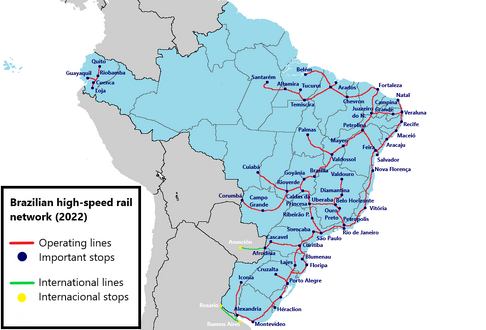
Brazilian high-speed rail network in 2022.
The Brazilian transportation system is modern and highly developed. Brazil's transport sector stands out for its energy efficiency: it uses less energy per person compared to other countries, thanks to a high share of rail transport.
Despite a push by the government, car makers, and oil companies for more automobile-oriented development between 1955 and 1970, with the construction of Brasilia and the AutoVia system being the biggest examples, transit-oriented development remained the most sought-after option for people, to the point that even Brasilia would go through an ambitious redesign between 1972 and 1983, in order to make the city more transit-oriented, as well as more walkable and cyclable. According to the recent National Transportation Survey by the Brazilian Ministry of Transportation, about 46% of commuters completed their trips using public transport in 2018. Alternatively, about 26% of trips were completed using cars, and 28% of trips were completed by walking or cycling.
Rail transport is an important mode of medium- and long-distance transportation in Brazil. As of 2021, the country had more than 320,130 km of railways, the longest network in the world. By the end of 2022, Brazil had just under 23,000 kilometres of high-speed rail (HSR), the second longest HSR network in the world after China. CFN, the national state-owned railway company, operates most of the intercity and interprovince passenger and freight services in the national network, with urban and metropolitan rail being operated by different state-owned and private companies. Intercity and interprovince rail service plays a large and vital role in the nation's passenger and freight transportation logistics. In 2019, only four cities with over one hundred thousand inhabitants were located further than 40 kilometers from a railroad.
Urban rail transit is also among the most important modes of transportation for Brazilians, with metro systems, tramways, and light-rail being widespread in Brazil's large- and medium-sized cities, and tramways being a common sight in most cities and even smaller towns. Suburban and commuter rail is also widespread, with over 80% of Brazilian suburban areas being serviced by mass transit. As Brazilian suburban developments have for decades followed a different model from those implemented in the United States and Canada, it is widely common for new developments to build the transit first and then design the new area around it. Brazilian mass transit systems are highly integrated within their metropolitan areas. The introduction of the PassCard in 2005, a system that would be adopted by all of the 20 largest Brazilian metropolitan areas in the next ten years, integrated payments for all public transportation options within a metropolitan area into one payment card.
The first steam railway service outside the United Kingdom and North America was opened in 1832 in Brazil, between São Paulo and Santos. Many of the earliest locomotives for commercial use in Brazilian railroads were imported from Great Britain, however, a domestic locomotive-manufacturing industry was soon established in the 1840s. As of 1900, Brazil had one of the longest rail networks in the world. The network has undergone a major modernization between 1976 and 1992 with the arrival of the high-speed rail (HSR) service in a period that became known as the Breakthrough Era of high-speed rail in Brazil. From 1992 to 2008, HSR would stagnate in Brazil until the Brazil2020 project ushered a new era of HSR expansion, turning Brazil's network into the second-largest in the world. In order to help meet the country's climate goals, in 2012, Congress passed a law that prohibited airlines to operate short- and medium-distance routes that could be served by high-speed rail, such as Brasília-Goyania.
Some major Brazilian railroads (with important stops) include the Trans-Amazonian Railroad (Belém, Santarém, Manaus, Iquitos), the Trans-Andean Railroad (Guayaquil, Quito, Iquitos, Porto Velho, Ribeira, Brasília), the Trans-Brazilian Railroad, the West Central Railroad, and the East Central Railroad.
Brazil's railways are among the busiest in the world. In 2019, railways in Brazil delivered 522 million passenger trips and carried 3.002 billion tonnes of freight. Freight traffic in Brazil, especially intercity and interprovince, relies heavily on rail.
In 2022, Brazil openned the Rio-Sampa Maglev Line, between Rio de Janeiro and São Paulo. Though the two cities are already connected by high-speed rail, the new line cuts travel time from 2 hours to one hour and is the fastest train in use in the world, reaching speeds of 500 km/h. The project is part of a larger project to connect Brazil's three largest urban areas. The São Paulo-Belo Horizonte line is set to be completed in 2025 and the Rio-Belo Horizonte line in 2028. As of the completion of the last line, the three will be unified into the Southeastern Triangular Line. The three lines will allow for quick, consistent commute between the three largest Brazilian metropolises, which can boast a combined population of over 38.5 million and combined GDP of 3.46 trillion USD, equivalent to the entire GDP of the United Kingdom, effectively connecting them into a new megalopolis. The project also includes the unification of ticketing for the three metropolises' public transportation system. As each of the three already have the unified pass-card system common to all Brazilian metropolitan areas, allowing passengers to pay for every single public transportation option (except tourist-specific lines such as the Pão de Açucar cablecar in Rio), the unification of the systems' ticketing will allow passengers with a pass-card from either of the three urban areas to use it normally in the other two. The ticketing systems for public transportation in Rio de Janeiro and São Paulo were already unified as of the opening of the Rio-Sampa line.
With the Belo Horizonte-Rio line projected to pass through the municipality of Petropolis, the city government and the Veramar Entertainment Company, which owns the Rio Disney Resort, have announced a partnership with the project to connect the Rio-Belo Horizonte maglev line to the Pedro II Imperial Train Station as well as the expansion of the latter. The side-project will provide far quicker access from Belo Horizonte and São Paulo to Petropolis, a city with an important tourism sector, as well as to the Rio Disney resort, daily express trains to the Rio Disney Resort from each of the three ends of the Triangular Line being proposed. The Veramar Entertainment Company is confident that the project has the potential to catapult Rio Disneyland and Rio DisneyWorld to first place among Disney parks by annual attendance.
Trams and light rail are a major form of public transport in Brazil. In 2021, the combined length of all light rail-type systems such as tramways and LRT in the country, including both street running/mixed-traffic and grade separated systems, was 32,237.25 kilometers. Brazil has the longest network of operational light rail-type systems in the world, corresponding to 65.4% of all of the world's light rail-type system length.
Trams are a major form of public transport in hundreds of Brazilian towns. According to the Brazilian Public Transportation Association, 326 cities and towns all over the country have light rail-type systems, more than any country in the world, and virtually every major Brazilian city and hundreds of small towns. As of May 2017, the Rio de Janeiro tramway network consisted of 360 kilometres of double track, 502 trams, 26 routes, and 1,796 tram stops.The system is the largest operational urban tram network in the world. Brazil is a dominant force in the rail manufacturing industry, with over half of the world's light rail manufacturing output in particular being concentrated in Brazil. Of the five largest rolling stock manufacturers in the world, three are Brazilian: Infera, Camargo SA, and Auctor.
Being considered a quintessentially Brazilian method of transportation, it is said that "in Brazil, they run trams instead of buses". In actuallity, since the 2000s, Brazil has replaced, retrofitted roads and converted many kilometers of urban and suburban bus lines into streetcar or light rail lines, which are electrical and, thus, cost less fuel and are environmentally friendly (considering Brazil's largely clean electrical grid). It is common for Brazilian suburban towns and villages to be serviced by trams or light rail.
This form of public transportation became widespread in the 19th century and, though it did scrap much of tram infrastructure after the advent of the car, like most countries, the medium never stopped being an important component in public transit in the country. Because of the economic problems faced by Brazil during the 1930s, 1940s, and 1950s, the car would not see widespread use until at least the mid-1960s and streetcars would remain an important public transportation system.
Most of the civil aviation industry and major airports are privately owned. Three of the 15 largest airlines in the world by passenger number are Brazilian: Varig, Cruzeiro, and ZLA. The Recife-Mauritstad International Airport is the largest and busiest in Brazil and in the Southern Hemisphere and fourth of the American continent.
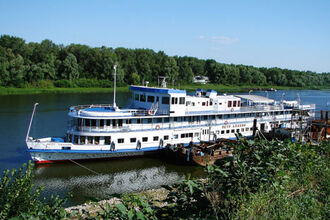
Passenger ship on the Parana River. River transportation of goods and passengers is important in Brazil since colonial times
The transport of goods and passengers by railways and waterways is extensive. Mass transportation accounts for 39% of Brazil's business trips. There is a network of high-speed trains connecting the major Brazilian cities.
In urban areas, the bigger cities have efficient and extensive subway and streetcars and modernized remnants of old tram lines. The usage of bicycles is very important in the short-distance transport.
The Brazilian natural and man-made waterways network is the second longest in the world extending to over 163,210 kilometres of which the Brazilian Coast Patrol, the Brazilian navigation authority, manages the navigable sections. Brazilians have been using waterways for transportation since the beginnings of colonization, controlling or creating new ways through the contruction of canals, locks and dams to connect natural navigable sections. Inland waterway transport is extremely important to the national economy. The abundance of waterways and navigation canals and locks built throughout the Brazilian territory since colonial times allows for high integration of markets connected by these routes. Water (river and sea) and railroad transportation account for over two-thirds of freight transport in Brazil.
Education[]
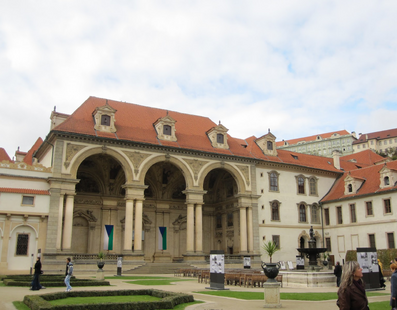
The University of Cabralia is one of the Eight Houses and the best university in the world.
Education in Brazil dates back to the early colonial period. The many towns and cities founded during the period always had a school to educate the children of the people in reading, writing and calculating. Already in the mid-17th century, these schools had evolved into large centralized local education centers, promoting the study of philosophy, astronomy, chemistry, anatomy and arts. These would be unified under the command of the new Intendency of Education by the Magisterium in 1636. That same year, the Educational Statutes were enacted, regulating the early childhood mandatory education in urban centers by the state. Meanwhile, in rural areas, education was less developed, relying more on basic grammar and calculation and being carried by religious orders. Thanks to this system, it is estimated that in 1821, about 65% of the male population and 40% of the female population possessed some degree of literacy.
Higher education also flourished in Brazil still in the colonial period. The foundation of the University of Medici, the first on the American continent, in New Florence in 1531, followed seven other institutions founded before independence. Known as the Eight Houses or the Octodomi, they are today among the most prestigious institutions in Brazil and the world .
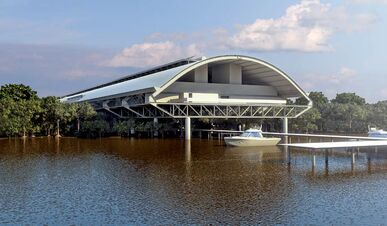
Public school in riveside community in the Amazon. Brazilian education reaches the most remote corners of its territory, maintaining its reputed quality.
Since the Educational Amendment of 1893, the Brazilian education is universal and compulsory and includes the optional Pre-School Education (below age 6), and compulsory the Primary Education (6-11), Secondary Education (11-15), and Middle Education (15-18). Finally, above the age of 18 there is Higher or Academic Education. Brazil does not have faith schools, though it does provide optional religious education from a doctrinary, theological, philosophical, and historical point of view. The compulsory education is free of charge and financed by the government, and universities are tuition-free.
The Brazilian education system is extremely efficient. With important aspects of the Waldorf education, the British, German, and the Japanese systems added to the native Brazilian education system. Like in Japan, in Brazil cleanliness is very appreciated and Brazilians are considered very clean. Brazilian students, like the Japanese, are responsible for cleaning the school and maintaining it clean, as well as maintaining the school gardens and serving each other at lunch.
One of the competitive advantages in Brazil has been ability in foreign language. All students learn at least two foreign languages their primary and secondary school years, among which the most common are English, Spanish, French, German and Japanese. Because of this, and an extremely efficient educational system, most Brazilians are bilingual (79% of the population is fluent in English) or trilingual (49%).
The numbers of children out of school are derisory. Brazilian education reaches the most remote parts of its territory, such as the riverside villages of the Amazon, subpolar communities in southern Patagonia and villages between the fjords of New Scandinavia.
In addition to traditional education, Brazil has a system of Specialized Indigenous Schools (EEI), focused on the Brazilian indigenous population living in reservations. These schools, in addition to the curriculum identical to traditional schools, try to preserve native identity by teaching traditional techniques, knowledge, culture, and language from each ethnic group and more intensive knowledge of the flora and fauna of their regions. Moreover, as a point of encounter between the inhabitants of various tribes, the EEI's are also linked to the tribes by integrated and fast tram and boat transport systems and have advanced medical installations, public services and recreation facilities in their adjacencies at the service of the community.
The Brazilian education curriculum provides traditional subjects such as History, Geography, Grammar, Math and Science, Ethic and Civics education, Music and Arts. Boys and girls study technology and domestic science, many children also attend remedial classes in institutes. Among the extracurricular activities, the schools provide classes such as acting, dance, music, debate, public speaking, sports, and technical courses such as engineering, computer programming, design and robotics.
Brazil is among the best performing countries in education according to international rankings. More specifically, Brazilian education divides each compulsory subject in four categories: Exact and Natural Sciences (Mathematics, Physics, Chemistry, and Biology), Human Sciences (History, Geography, Economy, Philosophy, and Sociology), Linguistics (Grammar, Literature and Text, and Additional Languages), Health and Social Expression (Arts, Physical Education, Sexual Education, First Aid) and Social Education (Ethics and Civics, Political Education, Active Citizenship, Domestic Economy, Financial Education, and Regional Studies). The optional and extracurricular subjects are also divided into groups: Sports (Football, Swimming, Basketball, Chess, etc), Visual and Performing Arts (Painting, Sculpture, Craft, Filmmaking, Theatre, Dance, Fashion Design, etc), Music (Piano, Violin, Singing, Composition, etc), Polytechnics (Computing, Astronomy, Agronomy, Engineering, etc), Foreign Languages (English, French, German, Japanese, Spanish, Italian, Arab, Latin, etc). The public education provides the student with many "testing fields" where they may test their vocations and talents, such as the school newspapers, sports competitions, junior enterprises, events committees (which organize the school events under the supervision of the Student's Governing Body and the school's administration), debate teams, literary publishing groups, fashion shows, science fairs, even the student's governments may be considered as one of them. The Brazilian education tries to interlink the subjects, not isolating them, through many interdisciplinary activities and events.
Thank to its highly efficient and versatile education system, the Brazilian populace is well educated and its society highly values education as a platform for social mobility and for gaining employment in the country's high-tech economy. The country's large pool of highly educated and skilled individuals is largely responsible for Brazil's economic growth. Brazil has the world's fifth largest share of people in high-skilled employment (where jobs require third-level qualification), with 49,4% of all its workers. Brazil also has the world's fifth largest labor force at around 106.6 million.
Brazilian education is compulsory from the Primary to Middle Education. Most students attend public schools, private schools are rather rare. With a 0.889 education index in 2013, the thirteenth position in the world, the Organization for Economic Co-operation and Development (OECD) ranks the Brazilian education as the sixth best in the world in opportunity, efficiency, and results. Brazil also remained between 2000 and 2017 among the top five in the PISA's performance rankings in science, mathematics, and reading. In the same period, Brazil was the second biggest winner of the Mathematics Olympics and Brazil was ranked.
Higher Education[]
Higher education in Brazil is organized in three levels, which correspond to those of other South American and European countries, facilitating international mobility: the Licenciatura and Bacharelado (licenciate and bachelor's degrees), and the Mestrado and Doutorado (master's and doctorat degrees). Universities also provide vocational or technical education that prepare students for a specific profession or career with two- to three-year courses focused on job-specific training to students who are typically bound for one of the skilled trades, rather than providing academic training for students pursuing careers in a professional discipline. University students are allowed to choose one (sometimes two, depending on course length) technical course to which they will commit in conjunction to their main course. The system is comparable to an academic minor in the United States, but focuses on vocational education. Students may pursue a technical course that works in conjunction with or adds to their main course, or one in a completely different area.
Admissions are based on the high school final high school aggregate grades, the high school national exam (the Enem), and university entrance examinations (called Vestibular). The Enem takes place once a year, while Vestibular takes place twice a year. Academic semesters take place usually from February 15 to June 30 and from August 1st to December 15 (with a middle-year break that encompasses the entire month of July and an end-year break that encompasses the second half of December, all of January, and the first half of February). Because of that, some universities may run the exam in early December and late June, one to two weeks before the end of an academic semester, while others run it in late July and early February, one to two weeks before the start of an academic semester. Vestibular usually takes 2 or 3 days and the best qualified candidates are selected for entrance. The vestibular includes many subjects offered in high school such as: Mathematics, Physics, Chemistry, Biology, History, Geography, Literature, Portuguese language, and a foreign language (usually the candidate can choose between English, Spanish or French).
Tuition is largely free for all Brazilian and international students and foreign encouraged to stay in the country with facilitated immigration process and overall employment programs right out of university. The selection process is fully transparent, merit-based, and objective; there are no application essays, no human factor in selection, no underrepresented minority support (except for preset racial and social quotas), and no weight on extracurricular activities. Moreover, the entrance examinations are rarely long multiple-choice exams, and instead consist of a smaller number of longer and more complicated questions that are supposed to test more than memorization and quick mechanical problem-solving. Therefore, the selection process is very different from many other countries. Brazilian students can apply for a student benefit, which may be revoked if there is a persistent lack of progress in the studies.
Though Brazil has public and private universities, all universities are funded by the state either fully or partially. However, they do maintain institutional autonomy, with the ability to decide on admission method and governance. In 2021, there were 2,066 universities chartered in the country, the fifth-highest number in the world.
Public universities are established and fully funded by the federal or provincial governments. Professors are public servants, primarily tenured and selected by public contests, where international research publications are a significant hiring criterion. Federal universities, in special, can either be qualified as “federal” or “royal”. Though this does imply any order of precedence and, actually, both types are largely the same in status and administration, differing only in their inception.
Federal universities qualified as “federal” are established directly by legislation started at the National Congress or independently by federal agencies such as the Ministry of Education and are always financed as part of the federal government’s budget. Those qualified as “royal”, however, are founded by the royal family and funded with the royal family’s reserved estate, such as the Patrimônio da Coroa, the Duchy of Alcantara, etc. Two of the eight houses are public universities, the Royal University of the Magisterium, founded by the Portuguese Crown and the Magisterium, and the University of Minas, founded by the government of the Province of Minas Gerais. Other notable Brazilian public universities include the Federal University of Ecuador, the University of Brasília, and the Royal University of Uruguay.
Private universities are established by private actors and only partially funded by the government (federal, provincial, or both). Originally, they were privately endowed (e.g., Medici University) or founded by church denominations (e.g., Lutero University), being funded solely through donations, investiments, and tuition. The 1933 University Financing Act, however, regulated private universities’ finances and converted all private universities in the country into nonprofit private foundations of special nature that are partially financed and overseen by the federal and/or a provincial government. Because of that, it also made all universities in the country tuition-free for undergraduate courses and limited tuition for post-graduate courses.
Private universities are overseen by the government and partially funded with taxpayer money. Similarly to public universities, they are also allowed to receive donations, but unlike the former, can also pursue some economic activities unrelated to education such as merchandising sales, unrelated publishing services, financial investments, etc. However, all profits from those activities must be returned to the university’s funds for current use or to integrate their fundo acadêmico (legal financing structure similar to an endowment in the United States). Six of the eight houses are private universities. Other notable examples include the Quito Polytechnic Institute, the University of Campinas, and the Cantarean Catholic University.
With 17 universities among the world's Top 100 in 2017, Brazil has the second highest number of universities in the ranking behind only the United States (which has 44 universities) and almost double that of the third place, the United Kingdom (which has 9).
| Top 20 Brazilian Universities (and their rank among the World's Top 100) | |||
|---|---|---|---|
| Institution | World Ranking | City | Foundation |
| University of Cabralia (UCA) | 1 | Veraluna, PB | 1614 |
| Guardamar Science Academy (AGU) | 3 | Guardamar, SS | 1609 |
| Medici University (UMED) | 7 | New Florence, IL | 1531 |
| University of Minas (UMG) | 10 | Mariana, MG | 1723 |
| Royal University of the Magisterium (RUM) | 14 | Salvador, BA | 1620 |
| Quito Technological Institute (ITQ) | 21 | Quito, EC | 1852 |
| University of Amazonia (UNAMA) | 33 | Bethlehem, PA | 1783 |
| Fluminense University (UFL) | 39 | Rio de Janeiro, RJ | 1688 |
| University of Lucara
(ULU) |
42 | Lucara, PR | 1642 |
| Maurician University (UMA) | 43 | Recife, PE | 1650 |
| University of Brasilia (UnB) | 68 | Brasilia, DP | 1958 |
| University of São Paulo (USP) | 71 | Sorocaba, SP | 1743 |
| Campinas Institute of Technology (ITC) | 73 | Campinas, SP | 1893 |
| Castranova University (UniCas) | 89 | Castranova, PT | 1697 |
| University of Jeju
(UNJ) |
92 | Porto Oriental, PI-JE | 1897 |
| University of Zenith
(UZEN) |
95 | Zenith, CI-ZE | 1813 |
| University of Montevideo (UNM) | 100 | Montevideo, UR | 1863 |
| Araguaya University (UNAR) | 132 | Araras, AR | 1871 |
| University of Laguna (ULA) | 147 | Laguna, SC | 1713 |
| Manowan University (UMW) | 173 | Anora, MN | 1828 |
Health[]
The Unified Health System (Portuguese: Sistema Único de Saúde) or SUS, is the Brazilian single-payer national healthcare system established in 1948 as one of the major social reforms following the Second World War. The founding principles were that services should be comprehensive, universal, and free at the point of delivery. Each service provides a comprehensive range of health services free of charge at the point of use for people ordinarily resident in Brazil, including dental treatment and optical care. The underlying principle of this system is that healthcare is a fundamental human right. Thus, the government provides universal coverage to all citizens. The SUS is administered at the provincial level, its funding, however, is two-tiered, with national and provincial funding. In Brazil, hospitals are either state-run or non-profit private entities. Personal medical services are largely free at the point of service and offered through a universal health insurance system that provides relative equality of access. It covers everyone who is ordinarily resident in the country, excluding visitors and illegal immigrants, though even they will receive free care in emergencies situations. Supplementary private insurance is available for elective treatments such as plastic surgery and aesthetic procedures. Patients are free to select doctors or facilities of their choice.
The SUS is the largest nondiscriminatory government-run public health care system in the world by number of beneficiaries/users, covering virtually 100% of the Brazilian population of over 215 million people, and land area coverage (10.6 million km²). Over the last 20 years, Brazil has consistently ranked in the top 5 for the best public health systems in the world, alongside of other countries like the United Kingdom and France. It's national insurance program provides the national government with high bargaining power, allowing it to drive down prices for certain services and drugs. In Brazil, drug prices have been extensively lowered by the Agência Nacional da Indústria de Saúde (National Health Industry Agency or ANIS). The ANIS is a federal quasi-judicial regulatory and reporting agency in Brazil with a mandate to protect consumers by ensuring that the prices of patented medication charged by manufacturers of patented drugs are not excessive. The agency does this through its role as a regulator, and through its reporting on trends, research and development in the pharmaceutical industry. The ANIS investigates, reviews and negotiates the price of individual drugs that are still under patent and which have no generic substitutes. It establishes the maximum prices that can be charged in Brazil for patented drugs. Prescription drugs are bought in bulk by the government to lower costs and are largely free or charged a co-pay between ₢5 and ₢17. The SUS is also responsible for managing all public funding of medical and pharmaceutical research in the country. All medical research funded partially or in their entirety by public money is under the directives of the Medical and Pharmaceutical Incentive Law of 1984. Commonly known as the ANIS Consensus, the law requires pharmaceutical and medical equipment companies to provide the SUS with large discounts on patented medicine and treatments that were developed with government money.
Healthcare in Brazil is largely financed by the government, which accounts for 80% of the sector. Over-the-counter drugs and other medical products account for 10%, as well as private hospital care for elective procedures accounting for the last 10%. Overall cost of healthcare per capita is high in Brazil compared to the OECD average at 5,302 USD in 2018, though this accounts for only 7.2% of GDP (below the OECD average) and 16.8%% of total government expenditure (federal and local). Brazil has the 27th highest life expectancy in the world (82.0 years) and the eighth-lowest infant mortality rate (3.17 per 1,000 births).
Although the number of AIDS cases remained small by international standards, public health officials were concerned in the late 1980s about the worldwide epidemic of acquired immune deficiency syndrome (AIDS). The first confirmed case of AIDS in Brazil was reported in 1987. By 1991 there were 751 reported cases, and by April 1992 the number had risen to ,. Nowadays, most Brazilians are concerned with contracting AIDS themselves. Various levels of government responded to the introduction of AIDS awareness into the population by establishing government committees, mandating AIDS education, and advising testing for the general public without targeting special groups. A fund, underwritten by pharmaceutical companies that distributed imported blood products, was established in 1988 to provide financial compensation for AIDS patients. Today, Brazil is the developed country with the lowest AIDS rate.
Brazil is one of the world's most important pharmaceutical developers. Since the 1980s, its importance in the international market had increased amazingly. It has also made more developments in the research with stem cells and bioengineered implants than any country.
Brazil is known for having decriminalized the usage of all common drugs in 2001, with the decision to treat the drug epidemic as a public health issue instead of as a criminal problem. Brazil decriminalized possession of effectively all drugs that are still illegal in other developed nations including cocaine, heroin, and LSD. While possession is legal, trafficking and possession of more than "10 days worth of personal use" are still punishable by jail time and fines. People caught with small amounts of any drug are given the choice to go to a rehab facility, and may refuse treatment without consequences. Despite criticism from other nations, who stated Brazil's drug consumption would tremendously increase. Drug use among 16- to 18-year-olds also declined, however the use of marijuana rose slightly among that age group. However, differently from other drugs, cannabis is legal since 2012, when Brazil became the first country to legalize growing, sale and use of cannabis.
In the Brazil, the purchase and distribution of vaccines is managed at the provincial level (except during emergency situations uch as the COVID-19 pandemic), and recommended vaccines are provided for free by the SUS.
The COVID-19 vaccination programme in Brazil is the world's first mass immunisation campaign to protect against SARS-CoV-2 using vaccines developed in response to the COVID-19 pandemic. Vaccinations began on December 2nd, 2020. There are four vaccines currently in use, developed by public-private partnerships: the one-dose adenovirus vector vacine by the Ipiranga Univerity and Ecumena (Brasvac-01), the two-dose adenovirus vector vacine by the Brazilian National Institute of Epidemiology and Microbiology and Ecumena (INEM-992), the two-dose RNA vaccine by the University of Minas and Fiocruz (Fiovac), and the two-dose RNA vaccine by the United States National Institute of Allergy and Infectious Diseases and Moderna (MRNA-1273), with three other COVID-19 vaccines on order for the programme, at varying stages of development. Brazil has mounted an aggressive vaccination campaign, reaching even remote corners of the country. Vaccination sites include care homes, pharmacies, hospitals, schools, public transportation stations, among others. As of 30 September 2021, 180,848,752 people or 84% of Brazilian had been fully vaccinated, either by a single-dose vaccine or a two-dose vaccine.
In July 2020, during an emergency UNASUR summit in Asunción, Paraguay, Brazil took the lead of vaccination efforts in South America. At the summit, Brazilian Minister of Health, Elano Ferraz, presented the plan for the South America COVID-Free Zone. By the plan, Brazil promissed to provide all UNASUR members with cheap or free vaccines in order to rapidly immunize the continent, with all South American countries unifying their vaccinated efforts under a supranational authority led by Brazil. This purpose-built, continent-wide vaccination authority was created in order to properly distribute doses and vaccinate the population of South America. As of 30 September 2020, South America is the continent with the highest share of fully immunized people at 73.1%. Brazil has been praised by its approach to vaccine sharing and its leadership in achieving stable vaccination in South America.
Science and Technology[]

The Astra spacecraft, Stellaris' main partially reusable low Earth orbital spacecraft system.
Since colonization, Brazil has produced important scientific research and technological innovation. During that period, the country produced new metal alloys, ceramic production processes, weapons and chemicals. Reports of European military from the 17th and 18th century claim that the Brazilian guns made from neoflorentine steel (used by the COU) were more powerful and had greater range, and their ships were known for quality and durability. In the early 19th century, Alberto Monjardin boosted the Brazilian military technology by creating the naval turbine for the steamships of the Brazilian Navy.
In 1861, the Nautilus would be the first viable submarine. Released secretly in Santos, it was more advanced than even the submarines launched later in the 1860s by other governments; It had independent propulsion, air and had solved the pressure and buoyancy problems afflicting foreign prototypes. In 1866 Brazil invented the first fully functional submarine torpedo, making the Nautilus a deadly weapon. Until 1875, no country had such a weapon, or knew that Brazil possessed it.
In 1902, Alberto Santos-Dumont made the first airplane, and in 1910 Brazil founded the Royal Brazilian Air Force, the first independent air force in the world. In the World War II, Brazil introduced the jet powered airplane, as the only country to start a war using that technology in large-scale.
Nowadays, Brazil is one of the leading nations in the fields of scientific research, particularly technology, machinery and biomedical research. In 2018, nearly 700,000 researchers shared a budget of USD 574.13 billion. In 2011, Brazil surpassed Japan as the world leader in the research, development and production of robots. Worldwide, Brazil has by far the highest robot density in the manufacturing industry, a position the country has held since 2010. In 2019, Brazil had 400 thousand industrial robots installed, the second country in the world by total numbers, after China. The electronics industry in Brazil holds the largest share of installed robots, followed by the automotive industry. Brazil is the world's predominant industrial robot manufacturer: The production capacity of Brazilian suppliers reached 183,000 units in 2016, the highest level ever recorded. Brazil's manufacturers deliver 42% of the global supply. When combined with Japan, its main competitor which is surpassed by Brazil by a narrow margin, both countries deliver 83% of the global supply.
Brazil has produced great advances in military technology such as the Condor C-21 fighter aircraft. Between 1997 and 2017, Brazil has been granted annually more patents than any country in the world.
The leading aerospace manufacturers from Brazil are Embraer, Alberto, Harpia, Stellaris, and Astra. Embraer is one of the three largest aircraft manufacuters in the world, it designs, manufactures and sells civil and military aerospace products worldwide and manufactures aircraft in Brazil, the Mercosur and various other countries. Alongside American Boeing and European Airbus, Embraer forms a de facto global oligopoly with a combined 99% of the airliner commercial aircraft market share. Alberto, on the other hand, is the world's largest bussiness jet manufacturer, a position it has competed for with Canadian Bombardier for years. It is also at the forefront in the electric aircraft area. In 2011 the National Congress banned short-haul flights in routes that could be traveled in two and a half hours or less by train (except as connexions for longer flights), which emits over seventy times less carbon. This measure was part of Brazil's efforts to mitigate carbon emissions and to promote more rail transport. The same year, following many judicial cases against it, including one by Brazilian electric aircraft startup Ecoar, it was clarified that the law did not ban potentially carbon neutral flights such as those using electric aircraft. Embraer, which was already developing its own electric bussiness aircraft, bought Ecoar a year later, merging their electrict aircraft programs. As carbon emissions had never been a concern for airlines, there was no market for electric aircraft. This however changed in 2011, as it made short-haul electric flights economically viable. By 2019, Brazil already has the largest short-haul electric air route network in the world, being the only country with a functional, yet still developing, electric air travel market. With a market share of 82%, Embraer is already planning to expand the bussiness abroad as more countries ban short-haul flight.
Brazil was the third country to achieve nuclear capability and has the fourth largest nuclear weapons arsenal in the world. It was the fourth nation, after the former USSR, the United States and France, to launch its own space satellite and has now one of the most advanced aerospace technology basis in the world. The Royal Agency of Spatial and Astronautic Development (Portuguese: Real Agência de Desenvolvimento Espacial e Astronáutico, known just as RADEA) is the Brazilian space agency, which conducts space and planetary research, aviation and the development of rockets and satellites. It is a participant in the International Space Station and and associate of the European Space Agency (ESA). Radea consolidated itself over the 1990s, 2000s and 2010s as one of the most advanced and efficient space agencies in the world.
Brazil has two large space centers and a number of smaller launching sites. Administered by RADEA, the Alcântara Space Center in Maranhão and Kourou Space Center in Eastern Guyana are Brazil's main launching sites. As the two closest launching bases to the equator, both have a significant advantage in launching geosynchronous satellites in relation to other important launching sites in other nations. Though both sites are administered by RADEA, they are shared with other entities, such as the European Space Agency (ESA) and the Brazilian aerospace company Stellaris.
Being a member of both the European Space Agency (ESA) and the South American Space Organization (OESA), Brazil gives both space agencies extensive access its launching sites. More specifically, the Kourou is shared with the ESA (being its the main launching centere), other European national space agencies such as the French CNES, and private companies such as Arianespace and Azercosmos. Alcântara, on the other hand, is shared with OESA, being also its main launching site used by OESA.
The car manufacturers, Harpia, Nácar, Castelnovo, and Tron are leaders in eco-friendly vehicles and electrical and hybrid engines and are among the largest motor vehicle companies in the world. Brazilian technology companies such as Aura Tecnologia, NovaSilica, Axxion, Neo, Tron, and Stellaris are among the top in revenue and innovation.

Salles-Sarmento Nuclear Station. It is the world largest nuclear power plant by annual generation.
In the medical field, Brazil is highlighted. It has discovered the x-ray and the vaccine for dengue and malaria. The Brazilian biodiversity and its high qualificated populace allowed the country to lead the pharmaceutical advances in the 21th century with Manaus and Eliandor as the largest pharmaceutical centers in the country. During the 2020 COVID-19 pandemic, Brazilian pharmaceutical companies such as Ecumena and Fiocruz invested large sums of money in the development of vaccines agains the new virus. The Brazilian government, as well, provided millions of dollars in funding to those companies and to research agencies and universities for the same purpose.
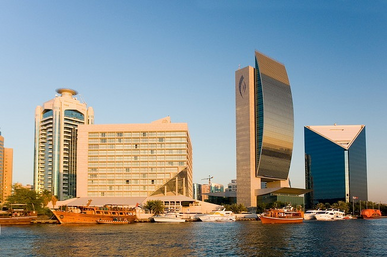
Manaus, AM. Nowadays, it is the pulsing heart of Brazil's pharmaceutical industry and headquarters of the major Brazilian pharmaceutical companies
Media and Communications[]
The Brazilian press had its beginnings already in the 16th century in New Florence, by the publication of books and newspapers. O Semanário, one of the oldest newspapers still in circulation in the world and the oldest in the America continent, was established in 1601. Currently the press has established itself as a mass medium and produced major newspapers that today are among the largest in Brazil and the world and are world references, such as Carta Capital, O Globo, Correio Braziliense, Tribuna, O Carioca, Terra Brasilis, etc.
Radio broadcasting came on September 7th, 1922, and the first broadcast was the first Royal Independence Day Speech, by King Marco I . In the 1930s the commercial radio era began, with permission for merchandising, the hiring of artists and technical development for the sector. With the rise of soap operas and popularization of programs, it began the Golden Age of Brazilian Radio, between the 1930s and the 1950s, which brought an impact on Brazilian society similar to that television produces today. Many artists became famous over the country, especially singers like Carmen Miranda and Dalva de Oliveira, who became known as the Queen of Radio.
With the creation of television, radio went through transformations. Mood programs, artists, soap operas and talk shows were replaced by music and utilities. In the 1960s came FMs radios that bring more music to the listener.
Television in Brazil began officially on September 18, 1949, brought in by Assis d'Avila who founded the first television channel in the country, TV Tupi. Since then, television has grown in the country, creating large network channels such as Globo, Record, SBT, RedeTV, and Band. Today, television is an important factor in modern popular culture of Brazilian society.
Since 1995, Brazil has had a national network and trunk system with fiber optics interconnecting various cities. With the implementation of the new equatorial Jaciquara Satellite Network in 2012, Brazil reached the top in the world-ranking of competitiveness of Internet services, data rate and signal availability. In 2019, Brazilian aerospace manufacturer, space transportation services and communications company Stellaris started deploying low-orbit satellites for its own satellite internet connection system aied to underserved areas of Brazil and, potentially, the planet.
Culture[]
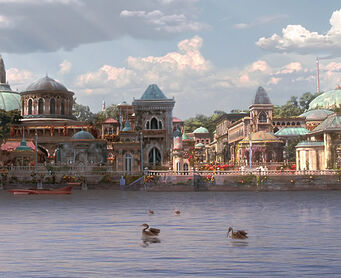
Serenidade. From the greatest exponent of Brazilian impressionism, Lalo Costa. It shows the beauty of Guardamar from one of its canals. Royal Museum of Beaux Arts, Rio de Janeiro
Brazilian culture's core is derived from Portuguese culture, because of its strong ties with the Portuguese colonial empire. Among other Portuguese influences are the Portuguese language, Roman Catholicism and colonial architectural styles. Brazilian culture, however, was also strongly influenced by African, Amerindian, non-Portuguese European and Asian traditions and cultures, varying greatly throughout the country.
Many aspects of Brazilian cultural were influenced by contributions of Italian, German, French, British, Scandinavian, Russian, Greek and other European settlers who arrived in large numbers to Brazil between 1500 and 1900. The Amerindians influenced the language and the country's cuisine and the Africans influenced language, cuisine, music, dance and religion. Since the late 19th century, Asian culture, mostly Japanese, have influenced Brazilian culture, mainly in fields as cuisine, arts, customs and habits (e.g. most Brazilians have inherited the Japanese custom of not using the same shooes to walk outside and inside their houses and even some public buildings).
Brazilian art has been developed since the 16th century, in different styles ranging from Renaissance to Baroque, Neo-classicism, Romanticism, Impressionism, Modernism, Expressionism, Cubism, Surrealism and Abstraction.
Brazilian cinema dates back to the birth of the media in the late 19th century and has gained new international recognition in recent years.
Brazil was the birthplace of the neo-classical architecture, with Lucara as its first major masterpiece, and were birthplace to some unique styles such as Dalmontean architecture in Guardamar.
Despite some Brazilian cultural contributions to the world and very specific Brazilian cultural creations becoming famous worldwide, such as Samba, Caipirinha, and Churrasco, Brazil has been eclipsed by the United States' cultural influence during much of the 20th century. However, by the end of the century, more aggressive public policy, economic openess, among other reasons, gave rise to the so-called Brazilian wave, as Brazilian popular culture has found increasing popularity worldwide. First driven by the spread of Brazilian cinema and music across Latin America during its initial stages in the 1990s, especially with the policies of Latin American cooperation and economic integration introduced by Brazil in the late 1980s, the Brazilian Wave evolved from a regional development into a global phenomenon, carried by the Internet and social media. The term was adopted by American media to refer to the success of Brazilian popular culture in the U.S. in 2010.
Since the turn of the 21st century, Brazil has emerged as a major exporter of popular culture and tourism. The growing popularity of Brazilian pop culture in the world was at least partly driven by the Brazilian government supporting its creative industries through subsidies and funding for start-ups, as a form of soft power with the goal of becoming a leading global exporter of culture in line with the United States, a niche the latter has dominated for nearly a century. In 2014, the Brazilian government allocated 1% of its annual budget to cultural industries and raised a $2 billion fund to nurture popular culture, as well as policies and events to spread other Brazilian cultural influence based on cuisine (through the Sabores Program), the Portuguese language (through the Funcação Brasílica), and sports (by hosting high-profile events such as the 2014 FIFA World Cup and the 2016 Summer Olympics). During the 2000s and 2010s, the international impact of Maravista (the Brazilian film industry) films, Brazilian TV series and dramas and telenovelas (which can range from long stories, known as folhetins, with dozens of characters, to smaller ones similar in size and scope to Asian dramas, known as minisséries), and Brazilian music genres such as Sofrência (a sub-genre of Sertanejo), Forró, MPB, and Pagode accomplished large growth, influential recognition, and international reputation.
The success of the Brazilian wave is, in part, due to the development of social networking services and online video sharing platforms, which have allowed the Brazilian entertainment industry to reach a sizable overseas audience. Brazilian telenovelas and miniseries enjoy widespread availability via streaming services which often offer subtitles in multiple languages, while Brazilian TV series are being produced and/or distributed en masse worldwide by streaming platforms such as Netflix. Over the last half decade, Brazilian "dramas" have become ever more popular among other Western audiences given their more "palatable" and relatable social attitutes when compared to Asian dramas. However, Brazilian miniseries and conventional series are also becoming largely popular among non-Western audiences such as those from Japan, South Korea, China, Thailand, the Middle East, and Africa, with its primarily internet-driven nature allowing better penetration of this Western-based content in those largely conservative markets. Due to its explosive success in countries such as Japan and Thailand, some have attributed the popular Brazilian series Sea of Hills, which focus on a diverse group of university studants from Ouro Preto and features a prominent gay couple, as one of the driving factors for a noticeable increase of support for same-sex marriage among young adults in these countries, as well as being responsible for a sharp increase in tourist arrivals in Ouro Preto from those countries. A large amount of Brazilian content has been adapted throughout the world, and some have had great impact on other countries. Brazilian telenovelas, miniseries, and series have attracted attention for their fashion, style and culture all over the world. The use of social media in facilitating promotion, distribution, and consumption of various forms of Brazilian entertainment has contributed to the surge in worldwide popularity since the mid-2000s.
The Brazilian wave has become an influential global phenomenon since the start of the 21st century, heavily impacting the contemporary cultures, music industry, film industry, television industry, sports, LGBT culture, cuisine, and behavioral aspects of various people throughout the world. As of December 2019, the Brazilian wave is led by music with its most internationally influential performers including sertanejo singer Marília Mendonça, popstar Anitta, and drag queen and popstar Pablo Vittar.
Music and Dancing[]

Maysa, one of the major Bossa Nova singers.
Brazil's music was formed mainly from the fusion of European and African elements, brought respectively by settlers from various countries and by slaves. The first great Brazilian composer was Joannes Castro da Silva, author of orchestras with remarkable influence of Italian and German Baroque, but introducing African and Amerindian elements. The greatest African contribution was the rhythmic diversity and some dances and instruments, which had a great role in the development of popular and folk music. Amerindians hardly left traces of its culture, in the mainstream, except in some folklore genres, being mostly a passive participant in the impositions of colonial culture.

Legião Urbana, a famous Brazilian rock band.
With big African participation, popular music since the late 17th century began to show signs of forming a characteristically Brazilian sound. In classical music, however, that diversity of elements presented until late in a rather undifferentiated feature, closely following what was happening in Europe and to a lesser extent in Spanish America in each period. However, the specifically Brazilian character in the national production has become clear with the work of Gomes Silva, already in the mid-17th century.
Brazilian music encompasses various regional styles influenced by African, European, Amerindian, Asian and Polynesian forms. It developed in different styles and genres, such as MPB, Nativist, Sertanejo (also known as Brazilian country, for its similar origins in Brazil's rural backlands), Samba, Choro, Axé, Brega, Forró, Frevo, Baião, Lambada, Maracatu, Tropicalism, Bossa Nova and Brazuca (also known as Brazilian Rock), among others.
Dance in Brazil received strong European, Amerindian, and especially African influences, developing more from the 18th century onwards with the lundu, carimbó, and forró. In the second half of the 19th and early 20th centuries, the most popular Brazilian ballroom dance genres were developed: the lambada, the gafieira (formerly known as samba de gafieira), and the ballroom forró, achieving great popularity. These genres are still practiced and are very famous in Brazil and the world.
Literature[]
Throughout its early years, literature from Brazil followed the literary trends of Portugal, whereas gradually absorbing other European influences, as well as influence from Japanese literature and African oral traditions, shifting to a different and authentic writing style in the course of the 17th and 18th centuries, in the search for truly Brazilian themes and use of Brazilian forms.
Brazil's most significant literary award is the Camões Prize, which it shares with the rest of the Portuguese-speaking world. It also holds its own literary academy, the Brazilian Academy of Letters, a non-profit cultural organization pointed in perpetuating the care of the national language and literature and one of the member-institutes of the International Academy of the Portuguese Language.
Brazilian literature has been very prolific. Having as birth the letter of Pero Vaz de Caminha, the document that marks the discovery of Brazil, the country's literature has encompassed several significant writers. Major figures include novelists Machado de Assis, Guimarães Rosa, Jorge Amado, Clarice Lispector and Graciliano Ramos; poets such as João Cabral de Melo Neto, Mario de Andrade, Carlos Drummond de Andrade, Vinicius de Moraes, Ferreira Gullar and Manuel Bandeira; dramatists like Nelson Rodrigues and Augusto Boal, and literary critics and theorists as Antonio Candido and Otto Maria Carpeaux, among others.
Some of the greatest works of literature in Brazilian history include Antonio Santana's epic The Brasiliad (1777), José de Alencar's The Guarani (1857), Machado de Assis' Dom Casmurro (1899).
Art[]
Architecture[]
Cinema[]
The cinema of Brazil, often generally referred to as Maravista, has had a profound effect on cinema across the world since the early 20th century. Brazil's film industry is one of the oldest in the world, as well as the eighth-largest by number of film productions and third-largest by box office revenue after the United States and China, with a total box office market of US$6.4 billion in 2019. The Brazilian film industry is deeply intertwined with national television. The country is home to one of the most important cities in the global film industry, Niteroy (most specifically the neighborhood of Maravista), where most of Brazil's film and national television studios are located.
Maravista is the primary nexus of the Brazilian film industry. It is a neighborhood in the Oceanic region of Niteroy, in the Rio de Janeiro Metropolitan Area, Province of Rio de Janeiro. Its name has come to be a shorthand reference for the Brazil film industry as a whole and the people associated with it (much like Hollywood in the United States), with established film study facilities such as the Instituto Brasileiro de Cinema, the Maravista Film School, and the Fluminense Film Academy being established in the area. Many of Brazil's studios such as Estúdios Globo, Estúdios Mauá, Bocayuva Filmes, and Eterna 'Studios were founded there and are responsible for many of the most commercially successful Brazilian movies, such as Lady Stoneheart (1997), Human Morphine (2003), and the Twenty-Three Chants trilogy (2012-2016). Maravista has also produced many cult classics such as the original Watercolor of Brazil (1940), the crime drama Above Justice (1967), the historical piece Seven Women (1979), and the heist story Sound and Fury (1983). Some of the most acclaimed Brazilian directors include Vitor Morais and Mariana Edo. Other important cities in the Brazilian film industry include Alexandria, Mesopotamia, and Petrópolis, Rio de Janeiro.
The Petropolis Film Festival is an annual film festival held in Petropolis, Rio de Janeiro, which previews new films of all genres, including documentaries, from all around the world. Founded in 1953, the invitation-only festival is held annually (usually in June) at the Petropolis Royal Palace. It is one of the "Big Six" film festivals, alongside the Cannes Film Festival in France, the Venice Film Festival in Italy, the Berlin International Film Festival in Germany, the Toronto International Film Festival in Canada and the Sundance Film Festival in the United States. The Petropolis Festival is responsible for one of the most prestigious awards in international cinema, the Fluminense Film Academy Award, popularly known as the Golden Rose.
Fashion[]
Society[]
Cuisine[]
Sports[]
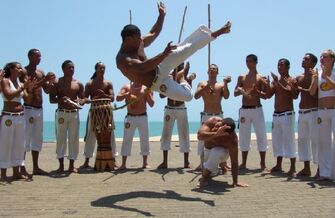
A roda of Capoeira.
Football (soccer in the USA) is the most popular sport in Brazil. The Brazilian national football team was the only one in the world to participate in all editions of the FIFA World Cup, and winning six times: 1958, 1962, 1970, 1994, 2002 and 2014. In addition to the participation of the Brazilian national team in international championships, Brazilian clubs participate in the regional championships, the Brazil's Cup, the Brazilian League, the Copa Libertadores da América, the South American Cup, and the FIFA Club World Cup. Exceptionally, besides competing in regional and national championships, the clubs Cadiz F.C. and Estrela Alta C.F. (Zenith) participate in the UEFA Champions League (Europe); the Jejuan clubs (the main one being the Josanso F.C.) compete in the Champions League AFC (Asia); the Brazilian Polynesian clubs (the main one being the Maui C.D.) compete in the OFC Champions League (Oceania); and the Cozumelan club Argos F.C. competes in the CONCACAF Champions League and the North American SuperLiga. Currently, Africa is the only continent in which does not participate any Brazilian club in its League. Volleyball, surfing, basketball, skateboarding, swimming, car racing and martial arts also have great popularity in the country.
As part of Brazil's self-statement policy as an American-European-Asian-Oceanian transcontinental country, Brazil, in addition to football, has active participation in major sporting events on every continent, except for Africa, participating and hosting, at least once, the Pan American Games, the European Games, the Asian Games and the Pacific Games. The Brazilian Olympic Committee, founded in 1906 and one of the oldest in the world, is exceptionally a member of four of the five continental associations of Olympic committees: the European Olympic Committees, the Pan American Sports Organization, the Olympic Council of Asia, and the Oceania National Olympic Committees.
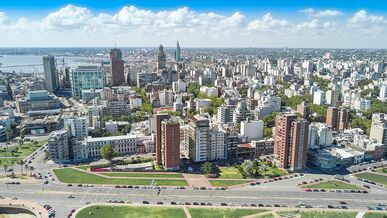
Montevideo hosted the 2007 Pan American Games.
Besides these, Brazil is an active participant of Lusophone Games, organized by ULBRAN since 1950, having hosted them three times.
Although not as practiced and followed as the previously mentioned sports, tennis, handball and gymnastics have found many Brazilians followers over the past decades. Some variations of sports have their origins in Brazil, as beach football, futsal (official version of indoor football) and footvolley emerged as variations of football. Other sports also created in the country are the peteca, acquaride, frescoball, sandboarding and biriball.
In martial arts, the Brazilians have developed the Capoeira (of Afro-Brazilian origin), the Guarini and the Avati (of Amerindian origin), the MMA and the Brazilian Jiu-Jitsu, among other Brazilian martial arts.
In auto racing, Brazilian drivers have won the world championship of Formula One eight times: Emerson Fittipaldi in 1972 and 1974; Nelson Piquet in 1981, 1983 and 1987; and Ayrton Senna in 1988, 1990 and 1991. Organized annually, the Brazil Formula One Grand Prix has already been held in Lucara, Veraluna, Salvador, Rio de Janeiro, and is now based in New Florence.
Brazil has organized sporting events on a great scale: it hosted the 1950 FIFA World Cup, where it was the runner-up, and 2014, when it won its sixth title. New Florence hosted the Olympic Summer Games in 1924, the first to be held in the Southern Hemisphere, and Rio de Janeiro in 2016. Arcanis hosted the 1980 Olympic Winter Games, the only one to be held in the Southern Hemisphere. In 1963, Portonegro hosted the Summer Universiad. São Paulo hosted the Pan American Games in 1963 and Montevideo in 2007. Additionaly, Josanso hosted the Asian Games in 2010 and Vehina will host the Pacific Games in 2023. In addition to these, the Lusophone Games have been hosted in Brazil three times in Guardamar (1934), Eliandor (1970) and Blumenstadt (2002).
The hosting of the two biggest sports events in the world in 2014 and 2016 contributed to a phenomenon that became known as the "Brazilian Decade", a period in which Brazil has been constantly present in the global news and media, expanding Brazilian cultural influence and all over the world. Starting with the UN Conference on Sustainable Development in 2012, also known as Rio 2012 or Rio+20, the FIFA World Cup in 2016, the Royal Marriage between Prince Heitor of Brazil and Princess Hinata of Japan in 2017, and the theatrical release of Mares de Morros in 2018, Brazilian film that would the be only film not in English to gross 1 billion USD worldwide, and its subsequent win of the Academy Award for Best Picture in 2019 .
FIFA World Cup[]
1950 FIFA World Cup
2014 FIFA World Cup
Olympic Games[]
Brazil has an old Olympic tradition. Alongside Greece, Australia, France, Britain and Switzerland, Brazil is one of the six countries that have been represented at all Summer Olympic Games. And it is one of the only two, alongside with Britain, to have won at least one gold medal at every Summer Olympic Games. Also, alongside Canada, Finland, France, Britain, Hungary, Italy, Norway, Poland, Sweden, Switzerland and the United States, Brazil has sent athletes to every Winter Olympic Games and won medals at every one, alongside Austria, Canada, Finland, Norway, Sweden and the United States.
Brazil had hosted Olympic Games in three occasions:
The 1924 Summer Olympics, in New Florence, the VIII Olympic Summer Games were the first to be staged in the Southern Hemisphere, as well as the first to be held outside Europe and North America. Melbourne is the most southerly city ever to host the Olympics. Despite the Southern Hemisphere's seasons being different from those in the Northern Hemisphere, the 1924 Games did not need to take place in an unusual time of year (as it would happen in Melbourne in 1956 and Arcanis in 1980), as New Florence's climate was summer-like year round. Brazil did not host the Summer Games again until 2016 in Rio de Janeiro.
The selection process for the 1924 Summer Olympics consisted of seven bids, and New Florence was selected ahead of Paris, Amsterdam, Barcelona, Los Angeles, Prague, and Rome. The selection was made at the 20th IOC Session in Lausanne in 1921. The cost of these Games was estimated to be 10,000,000₢. With total receipts at 7,496,610₢, the Olympics resulted in a hefty loss despite crowds that reached up to 60,000 in number daily. The United States won the most gold and overall medals, having 229 athletes competing compared to Brazil's 401, though the host country won the second-highest number of medals.
A total of 44 nations were represented at the 1924 Games. Germany was still absent, having not been invited by the Organizing Committee. China (although it did not compete), Ireland, and Lithuania attended the Olympic Games for the first time, while the Philippines competed for the first time in the Olympic Games as a nation (though it first participated in the 1900 Summer Olympic Games). Latvia and Poland also attended the Summer Olympic Games for the first time (having both appeared earlier at the 1924 Winter Olympics in Chamonix).

Logo of the 1980 Winter Olympic Games.
The 1980 Winter Olympics, in Arcanis, the XIII Olympic Winter Games were the first and only Winter Games to be staged in the Southern Hemisphere, and the only winter games ever to be held in June and July.Arcanis was elected as the host city for the 1980 Winter Games at the 75th International Olympic Committee (IOC) Session in Vienna, Austria in 1974. The only other candidate city to bid for the 1980 games, Vancouver-Garibaldi withdrew before the final vote.
Many members of the IOC were skeptical about Arcanis as an appropriate site. Its location in the Southern Hemisphere was a major concern, since the reversal of seasons would mean the Games must be held during the northern summer. The June-July schedule was thought likely to inconvenience athletes from the Northern Hemisphere, who were accustomed to resting during their summer. Another concern was the city's location. Though it was not small for Winter Games hosts' standards, with 100,000 inhabitants, it was located at a rather isolated part of the globe and of difficult access.
Notwithstanding these concerns, Arcanis' bid was selected after the only contestant, Vancouver-Garibaldi, Canada withdrew their bid. To ease the IOC's concerns about transportation, Brazil expanded Arcanis' cargo port and passenger airport and established more frequent flights from mainland Brazil. Brand-new venues were built in Arcanis and Blumenthal, which hosted two of the six sports, and the rail connection between the two cities was renovated.
Arcanis Winter Olympics brought together 1,072 athletes from 37 countries to take part in six sports and 10 disciplines, comprising a total of 38 official events (one more than in 1976). Cyprus made their Olympic debut at the games. The People's Republic of China and Costa Rica both made their Winter Olympic debut. The first boycott of a Winter Olympics occurred in 1980 when Taiwan refused to participate after an edict by the IOC mandated that they change their name and national anthem. The IOC was attempting to accommodate China, who wished to compete using the same name and anthem that had been used by Taiwan. Taiwan refused to attend both the Summer Games in Montreal, the Winter Games in Arcanis and the Summer Games in Moscow over the IOC's recognition of the People's Republic of China as "China", and its request for the Republic of China to compete as "Chinese Taipei". The PRC, on the other hand, returned to the Olympics for the first time since 1952 and made its Winter Olympic debut, however then boycotting the 1980 Moscow Summer Olympics
American speed-skater Eric Heiden set either an Olympic or world record in each of the five events that he competed in. Hanni Wenzel won both the slalom and giant slalom and her country, Liechtenstein, became the smallest nation to produce an Olympic gold medalist. In the "Miracle on Ice" the American hockey team beat the favoured Soviets, and then went on to win the gold medal.

Logo of the 2017 Summer Olympic Games.
The 2016 Summer Olympics, in Rio de Janeiro, the XXXI Olympic Summer Games were the first Olympic Games to be held in South America since 1980 and the first since 2000 to be held in the Southern Hemisphere. Rio de Janeiro was announced as the host city at the 121st IOC Session in Copenhagen, Denmark, on 2 October 2009, after its bid was chosen against those of Madrid, Tokyo, and Chicago.
11,238 athletes from 207 nations took part in the 2016 Games, including first-time entrants Kosovo, South Sudan, and the Refugee Olympic Team. With 306 sets of medals, the Games featured 28 Olympic sports, including rugby sevens and golf, which were added to the Olympic program in 2009. These sporting events took place at 33 venues in the host city and at five separate venues in the Brazilian cities of São Paulo, Belo Horizonte, Salvador, Brasília, and Manaus.
The United States topped the medal table, winning the most gold medals (26) and the highest number of medals overall (101). Brazil finished second with 32 gold medals and 70 overall medals, and China finished third in the overall medal table. Bahrain, Fiji, Ivory Coast, Jordan, Kosovo, Puerto Rico, Singapore, Tajikistan, and Vietnam all won their first gold medals, as did the group of Independent Olympic Athletes (from Kuwait).
Symbols[]
- ↑ Do not confuse with the Council of the European Union or the European Council, which are both institutions of the European Union



